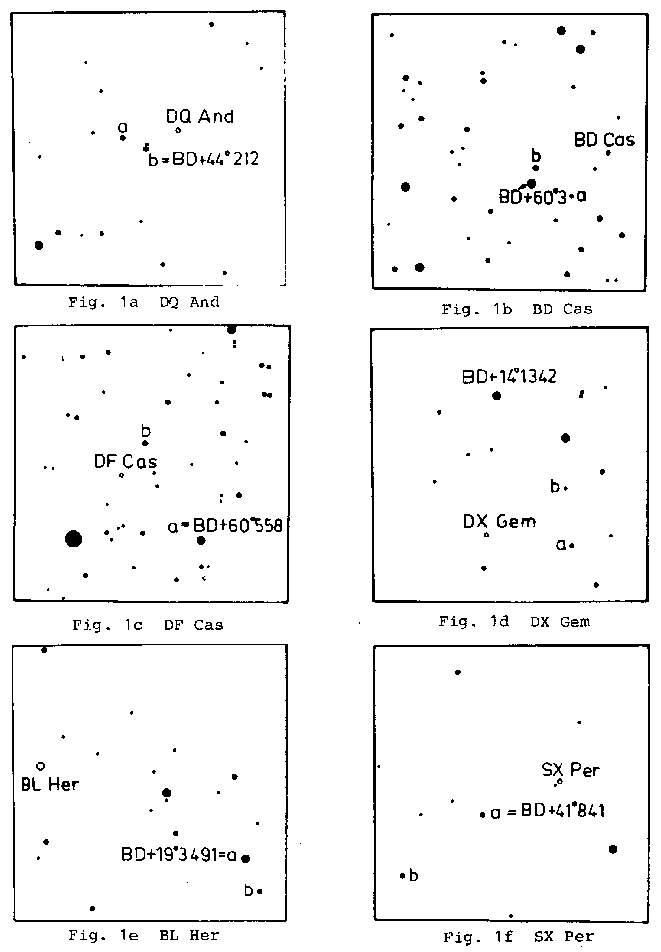 Figure 1a-f Identification charts
Table 3 The observations
DQ Andromedae
J.D.hel. V B-V U-B J.D.hel. V B-V U-B
2440000+ 2440000+
1567.523* 11.85 0.80 1918.531 * 11.46 0.58
1596.415* 11.87 0.80 1921.368 * 11.27 0.49
1597.450* 11.98 0.84 1921.518 * 11.34 0.55
1625.339* 11.91 0.86 1944.375 * 11.60 0.67
1650.248* 11.66 0.74 2008.560 * 11.63 0.72
1651.244* 11.97 0.85 2095.225 * 11.74 0.73
1651.382 * 11.99 0.84 2273.336 * 11.28 0.52
1688.242 * 11.56 0.61 2276.342 * 11.54 0.52:
1898.518 * 11.81 0.77 2276.474 * 11.32 0.54
1918.347 * 11.38 0.54 2426.210 * 12.03 0.81
FF Aquilae
J.D.hel. V B-V U-B J.D.hel. V B-V U-B
2440000+ 2440000+
1392.586 5.28 0.73 0.45 1459.544 5.34 0.68 0.48
1396.589 5.45 0.74 0.47 1466.435 5.47 0.83 0.50
1399.558 5.53 0.82 1467.498 5.53 0.77 0.53
1400.621 5.51 0.76 0.52 1472.478 5.46 0.77
1401.577 5.31 0.70 0.43 1487.468 5.29 0.69 0.46
1412.510 5.49 0.81 0.49 1489.534 5.55 0.79 0.56
1415.507 5.21 0.69 0.43 1501.409 5.38 0.75 0.52
1436.440 5.52 0.80 0.52 1529.389 5.56 0.78
1437.471 5.24 0.70 0.45 1554.312 5.25 0.66 0.46
1438.437 5.33 0.77 1758.629 5.44 0.76 0.52
1439.546 5.47 0.81 0.53
Observations in 1953
J.D.hel. deltav Deltab J.D.hel. Deltav Deltab
2430000+ 2430000+
4583.367 -0.520 -1.042 4588.408 -0.641 -1.086
4585.392 -0.378 -0.685 4590.451 -0.266 -0.562
Table 3 (cont.)
(FF Aql)
J.D.hel. DeltaV Deltab J.D.hel. DeltaV Deltab
2430000+ 2430000+
4591.404 -0.257 -0.620 4623.440 -0.348 -0.794
4596.368 -0.334 -0.772 4624.451 -0.562 -0.945
4597.406 -0.547 -1.030 4625.401 -0.328 -0.658
4598.406 -0.365 -0.755 4626.384 -0.201 -0.533
4600.397 -0.219 -0.529 4628.425 -0.425 -1.021
4602.458 -0.415 -0.822 4629.354 -0.435 -0.847
4608.381 -0.218 -0.498 4630.357 -0.280 -0.583
4609.520 -0.270 -0.605 4654.314 -0.285 -0.626
4614.435 -0.409 -0.759 4656.328 -0.381 -0.755
4619.366 -0.542 -0.975 4660.319 -0.493 -0.929
4621.427 -0.265 -0.547 4663.303 -0.286 -0.618
4622.410 -0.221 -0.452 4664.310 -0.578 -1.015
V 572 Aquilae
J.D.hel. V B-V U-B J.D.hel. V B-V U-B
2440000+ 2440000+
1567.365 11.05 0.86 1918.325 11.01 0.88
1568.291 11.08 0.85 1921.335 11.15 0.89
1896.479 11.20 0.98 1944.280 11.04 0.86
1897.371 11.40 1.08 2194.520 11.29 1.02
1898.422 11.23 0.97 2224.508 11.28 1.00
1917.365 11.23 0.92
Y Aurigae
J.D.hel. V B-V U-B J.D.hel. V B-V U-B
2440000+ 2440000+
1292.471 9.75 1.07 1401.352 9.99 1.04
1332.565 9.93 1.01 1402.362 9.67 0.87
1336.587 9.85 0.94 1679.540 9.97 1.06
1352.547 9.17 0.70 1682.524 9.82 1.04
1389.423 9.89 1.04 1694.462 9.93 1.04
1394.365 9.89 1.07 1696.485 9.28 0.79
Table 3 (cont.)
(Y Aur)
J.D.hel. V B-V U-B J.D.hel. V B-V U-B
2440000+ 2440000+
1939.471 9.23 0.71 1990.399 9.52 0.92
1961.494 9.94 1.09 1990.577 9.60 0.97
1981.458 9.39 0.74 2039.378 9.29 0.73
1982.492 9.43 0.90 2141.295 9.63 0.95
RT Aurigae
J.D.hel. V B-V U-B J.D.hel. V B-V U-B
2440000+ 2440000+
1292.586 5.54 0.71 1697.402 5.12 0.45 0.28
1331.520 5.74 0.73 0.41 1758.360 5.44 0.67 0.39
1332.539 5.10 0.49 0.29 1990.478 5.76 0.76 0.47
1336.610 5.20 0.59 1990.660 5.77 0.77 0.55
1352.519 5.63 0.75 0.43 2018.648 5.15 0.52 0.28
1610.636 5.77 0.79 0.53 2066.404 5.20 0.55 0.32
1682.551 5.07 0.43 0.26 2100.296 5.01 0.43 0.28
1695.468 5.61 0.73 0.48 2108.301 5.27 0.54 0.35
1696.507 5.82 0.77 0.49 2148.281 5.47 0.59 0.19:
1697.358 5.20 0.45 0.26 2159.303 5.65 0.67 0.38
SU Cassiopeiae
J.D.hel. V B-V U-B J.D.hel. V B-V U-B
2440000+ 2440000+
1301.349 5.93 0.75 1401.381 6.12 0.86 0.54
1352.578 6.15 0.80 1402.379 5.79 0.67 0.50
1389.450 6.09 0.83 0.49 1403.366 6.13 0.84 0.52
1390.447 5.80 0.68 0.44 1408.387 5.85 0.72
1391.386 6.10 0.81 0.54 1415.371 6.07 0.81 0.50
1392.404 5.76 0.71 0.45 1608.475 5.99 0.76 0.48
1393.385 6.11 0.83 0.49 1617.369 6.05 0.82 0.50
1394.388 5.77 0.69 0.45 1672.267 6.14 0.83 0.45
1396.420 5.76 0.65 0.49 1673.283 5.77 0.68 0.48
1399.363 6.11 0.82 1682.567 5.93 0.77 0.43
Table 3 (cont.)
(SU Cas)
J.D.hel. V B-V U-B J.D.hel. V B-V U-B
2440000+ 2440000+
1694.441 5.82 0.71 0.49 1758.379 6.11 0.81 0.46
1695.441 6.09 0.82 0.50 1988.658 5.94 0.72 0.44
1753.396 5.81 0.73 0.44 1989.389 5.91 0.74 0.46
1754.334 6.12 0.84 0.58 1989.534 5.98 0.77 0.50
SY Cassiopeiae
J.D.hel. V B-V U-B J.D.hel. V B-V U-B
2440000+ 2440000+
1302.383 10.16 1.12 1934.490 9.51 0.75
1586.499 10.05 1.11 1942.372 9.76 0.92
1589.518 9.76 1.01 1954.360 10.02 1.06
1594.472 9.96 1.06 1959.451 9.53 0.83
1596.463 9.58 0.85 1960.414 9.90 1.01
1597.462 9.66 0.92 1961.365 10.12 1.12
1606.455 9.91 1.09: 2008.506 9.61 0.90
1631.395 10.06 1.06: 2070.213 9.82 0.99
1634.345 9.75 0.95 2990.528 9.89 1.08:
1681.254 10.18 1.08 3045.535 9.96 0.94
1682.250 9.42 0.79 3048.541 10.16 1.06:
1689.227 10.17 1.16: 3050.525 9.59 0.84
1917.528 10.16 1.08 3078.380 9.55 0.80
1918.499 9.44 0.80
XY Cassiopeiae
J.D.hel. V B-V U-B J.D.hel. V B-V U-B
2440000+ 2440000+
1589.548 10.00 1.21 1651.351 9.66 1.01
1596.448 10.05 1.11 1688.223 9.86 1.14
1597.473 9.67 1.01 1689.242 10.04 1.25
1625.386 9.91 1.14 1898.530 9.69 1.01
1647.344 9.77 1.07 1918.519 10.03 1.18
1650.363 10.11 1.19 1948.292 9.62 0.98
Table (cont.)
(XY Cas)
J.D.hel. V B-V U-B J.D.hel. V B-V U-B
2440000+ 2440000+
2095.247 10.16 1.23 2276.492 9.83 1.05
2275.542 10.17 1.21 2424.343 10.19 1.20
2276.351 9.92 1.07
Observations in 1967-1968
J.D.hel. DeltaV Deltab J.D.hel. DeltaV Deltab
2430000+ 2430000+
9777.620 1.181 0.730 9806.350 0.864 0.351
9787.385 0.648 0.050 9807.660 1.068 0.576
9791.406 1.020 0.497 9808.502 1.255 0.859
9795.344 1.246 0.890 9810.287 0.666 0.023
9796.489 0.639 0.007 9821.351 1.174 0.829
9799.305 1.199 0.875 9864.284 0.689 0.052
BD Cassiopeiae
J.D.hel. V B-V U-B J.D.hel. V B-V U-B
2440000+ 2440000+
1566.517 10.88 1.52 1651.296 10.95 1.46
1567.445 10.96 1.54 1651.370 10.95 1.53
1568.410 11.15 1.61 1688.206 11.05 1.57
1596.323 10.87 1.48 1689.203 11.17 1.62
1596.400 10.91 1.48 1896.490 11.04 1.63
1596.510 10.93 1.52 1897.463 11.12 1.55:
1597.420 11.10 1.63 1898.374 10.95 1.61
1597.513 11.11 1.64 1949.304 10.99 1.58
1625.369 10.85 1.50 2008.462 10.84 1.50
1629.262 10.89 1.51 2299.441 11.05 1.62
1650.372 10.89 1.57 2299.595 11.04 1.57
BY Cassiopeiae
J.D.hel. V B-V U-B J.D.hel. V B-V U-B
2440000+. 2440000+
1586.530 10.31 1.23 1594.492 10.42 1.19
Table 3 (cont.)
(BY Cas)
J.D.hel. V B-V U-B J.D.hel. V B-V U-B
2440000+ 2440000+
1596.524 10.25 1.16 1682.267 10.46: 1.36:
1606.472 10.23: 1.14: 1933.445 10.56 1.30
1625.353 10.31 1.18 1935.378 10.14 1.15
1631.411 10.41 1.31 1935.535 10.16 1.19
1634.383 10.56 1.31 1949.413 10.47 1.28
1647.391 10.51 1.26 1961.511 10.23 1.18
1650.273 10.55 1.29 3045.560 10.59 1.28
1651.400 10.24 1.17 3048.552 10.53 1.26
1662.283 10.41 1.28 3050.537 10.18 1.13
1680.271 10.32: 1.11: 3078.316 10.56 1.30
1681.267 10.28 1.23 3140.259 10.34 1.19
Observations in 1967
J.D.hel. DeltaV Deltab J.D.hel. Deltav Deltab
2430000+ 2430000+
9763.519 -0.196 -0.216 9791.423 -0.265 -0.302
9769.494 -0.385 -0.437 9795.531 -0.289 +0.020
9770.458 -0.067 +0.008 9796.469 -0.002 -0.325
9776.494 -0.175 +0.151 9799.324 -0.113 +0.072
9777.528 +0.017 -0.144 9810.303 -0.106 -0.137
9787.363 +0.021 +0.120
DF Cassiopeiae
J.D.hel. V B-V U-B J.D.hel. V B-V U-B
2440000+ 2440000+
1330.355 10.97 1.25 1679.271 11.02 1.21
1594.518 10:90 1.15 1680.294 11.09 1.28
1596.546 10.85 1.15 1681.300 10.55 0.95
1634.430 11.14 1.19 1682.298 10.79 1.12
1650.308 10.71 1.07 1689.323 10.56 1.04
1650.453 10.60 0.99 1917.555 11.04 1.25
1651.323 10.66 1.09 1921.536 11.10 1.23
1651.427 10.68 1.10 1960.430 11.04 1.21
1662.323 10.53 1.00 1978.454 11.07 1.11
Table 3 (cont.)
(DF Cas)
J.D.hel. V B-V U-B J.D.hel. V B-V U-B
2440000+ 2440000+
1981.403 10.81 1.19 3140.278 11.14 1.27:
2101.330 11.08 1.11: 3162.384 11.07 1.12
3078.332 11.02 1.24 3202.315 10.89 1.08:
V 395 Cassiopeiae
J.D.hel. V B-V U-B J.D.hel. V B-V U-B
2440000+ 2440000+
1596.483 10.92 1.26 1917.541 10.46 1.07
1597.500 10.83 1.22 1918.567 10.74 1.22
1625.463 10.92 1.27 1921.377 10.40 1.05
1650.266 10.64 1.14 2008.572 10.95 1.26
1650.423 10.52 1.05 2276.502 10.39 1.00:
1651.309 10.55 1.10 2299.490 10.95 1.24
1651.411 10.57 1.11 2302.423 10.75 1.21
1688.293 10.71 1.20
IR Cephei
J.D.hel. V B-V U-B J.D.hel. V B-V U-B
2440000+ 2440000+
1407.620 7.85 0.75 1881.423 7.85 0.88 0.53
1415.557 7.62 0.71 0.43 1882.538 7.59 0.73 0.44
1436.527 7.61 0.68 0.42 1897.475 7.61 0.68 0.40
1495.507 7.68 0.75 0.39 1898.542 7.91 0.86
1554.447 7.92 0.80 0.44 1904.505 7.82 0.84 0.52
1579.341 7.91 0.90 0.52 1905.583 7.77 0.76 0.46
1584.343 7.68 0.73 0.45 1906.440 7.71 0.81 0.48
1586.390 7.71 0.73 0.43 1907.415 7.90 0.86 0.55
1617.300 7.94 0.89 0.55 1907.529 7.88 0.81 0.64
1629.277 7.68 0.76 0.43 1908.531 7.77 0.76 0.51
1651.252 7.99 0.87 1911.393 7.99 0.88 0.56
1803.520 7.96 0.89 1911.579 7.93 0.88 0.55
1807.563 7.90 0.89 0.61 1917.386 7.89 0.84
Table 3 (cont.)
(IR Cep)
J.D.hel. V B-V U-B J.D.hel. B-V U-B
2440000+ 2440000+
1917.489 7.92 0.86 0.47 1944.299 7.70 0.76 0.42
1917.588 7.96 0.85 1960.280 7.91 0.83 0.56
1918.309 7.75 0.76 0.38 1960.446 7.85 0.81 0.48
1918.541 7.61 0.67 0.40 1961.289 7.68 0.78 0.48
1921.354 7.79 0.80 0.44 1965.292 7.61 0.75
1921.472 7.85 0.83 1965.494 7.73 0.75 0.46
1921.569 7.89 0.83 1981.248 7.95 0.87 0.55
1932.510 7.97 0.87 0.60 1983.349 7.93 0.92 0.56
1933.333 7.59 0.67 0.44 2939.440 7.74 0.71 0.54
1933.422 7.59 0.68 0.50 3045.500 7.59 0.72 0.44
1934.373 7.90 0.85 0.64 3050.482 7.87 0.85 0.56
1934.470 7.93 0.87 0.53 3064.338 7.61 0.69 0.47
1935.497 7.55 0.76 0.38 3078.299 7.96 0.85 0.48
BD +56—2806 (Cep)
J.D.hel. V B-V U-B J.D.hel. V B-V U-B
2440000+ 2440000+
2634.479 9.28 0.79 2720.376 9.53 0.89
2635.405 9.52 0.85 2728.315 9.54 0.97
2636.519 9.41 0.81 2738.372 9.28 0.80
2639.355 9.38 0.86 2743.344 9.33 0.88
2640.358 9.30 0.83 2756.239 9.53 0.97
2642.393 9.30 0.84 2767.190 9.50 0.85
2645.477 9.26 0.79 2770.195 9.51 0.94
2646.379 9.48 0.80 2776.185 9.56 0.98
2669.406 9.55 0.94 2776.305 9.55 0.96
2675.413 9.49 0.94: 2777.271 9.27 0.83
2676.397 9.25 0.83 2782.204 9.55: 0.84:
2685.490 9.40 0.82 2787.202 9.56 0.87
2712.420 9.37 0.87 2939.453 9.47 0.91
2714.378 9.58 0.92 2971.374 9.27 0.80
2715.330 9.34 0.84 2990.444 9.28 0.81
2715.433 9.31 0.81 3075.416 9.37 0.84
Table 3 (cont.)
SU Cygni
J.D.hel. V B-V U-B J.D.hel. V B-V U-B
2440000+ 2440000+
1412.596 7.16 0.68 0.43: 1880.362 6.90 0.63 0.46
1415.610 7.07 0.68 0.49 1881.375 7.16 0.68 0.40:
1436.484 6.67 0.43 0.42 1908.423 7.17 0.68 0.43
1476.478 6.86 0.65 0.47 1915.433 7.05 0.68 0.49
1495.446 6.81 0.60 1932.299 7.00 0.57 0.49
1554.349 7.09 0.66 0.44 1937.405 6.72 0.50 0.43
1561.482 6.98 0.66 0.46 1967.282 6.49 0.43 0.34
1584.309 6.96 0.62 0.51 1998.217 6.45 0.40 0.40
1606.325 6.53 0.46 0.41 1998.282 6.45 0.42 0.32
1610.294 6.59 0.46 0.42 2143.591 7.13 0.63 0.54
1789.582 7.16 0.69 0.54
Observations in 1953
J.D.hel. DeltaV Deltab J.D.hel. DeltaV Dletab
2430000+ 2430000+
4584.492 0.097 0.383 4597.490 0.572 1.039
4585.496 0.428 0.906 4598.462 0.667 1.147
4590.530 0.614 1.184
VZ Cygni
J.D.hel. V B-V U-B J.D.hel. V B-V U-B
2440000+ 2440000+
1472.515 8.62 0.80 1898.354 9.16 1.03 0.77
1589.443 8.66 0.79 0.63: 1900.446 8.62 0.72 0.44
1594.448 8.74 0.77 0.51 1904.490 9.01 0.84 0.55
1596.370 9.15 1.02 0.78 1914.398 8.86 0.76 0.42
1597.381 9.24 1.03 0.75 1914.566 8.71 0.72 0.42
1629.236 8.88 0.93 0.71 1929.338 8.64 0.70 0.42
1651.204 9.18 0.99 0.60 1942.430 9.22 1.08 0.59:
1860.466 9.16 0.97 0.58 2939.470 9.25 1.03 0.61:
1887.452 9.01 0.94 0.58 3045.466 9.05 1.00
1896.550 8.83 0.91 0.68 3048.490 8.59 0.73 0.42
1897.344 8.99 1.01 0.71 3064.324 8.91 0.90 0.68
Table 3 (cont.)
(VZ Cyg)
J.D.hel. V B-V U-B J.D.hel. V B-V U-B
2440000+ 2440000+
3075.394 9.12 1.06 3140.209 8.88 0.77 0.50
3078.280 8.75 0.86 0.45:
DT Cygni
J.D.hel. V B-V U-B J.D.hel. V B-V U-B
2440000+ 2440000+
1467.511 5.73 0.45 0.25 1877.536 5.67 0.46 0.25
1472.494 5.70 0.46 0.25 1881.445 5.91 0.56 0.28
1476.512 5.87 0.54 0.29 1882.522 5.67 0.44 0.24
1487.537 5.68 0.45 0.24 1884.541 5.85 0.50 0.25
1495.466 5.63 0.42 0.23 1908.349 5.75 0.51 0.23
1544.442 5.88 0.55 0.26 1908.472 5.81 0.51 0.27
1554.506 5.86 0.51 0.24 1911.560 5.91 0.54 0.28
1562.337 5.75 0.47 0.23 2307.473 5.66 0.41 0.21
1562.520 5.70 0.43 0.21 2990.473 5.81 0.48 0.28
1583.274 5.73 0.46 0.21 3045.313 5.73 0.45 0.32:
1606.304 5.83 0.54 0.28 3046.333 5.92 0.51
1613.247 5.71 0.47 0.20 3048.439 5.93 0.54 0.30
1634.272 5.94 0.56 0.25 3064.292 5.75 0.48 0.21
1860.531 5.67 0.45 0.23
V 402 Cygni
J.D.hel. V B-V U-B J.D.hel. V B-V U-B
2440000+ 2440000+
1415.590 9.76 0.95 1629.195 9.62 0.96
1487.520 10.07 1.16 1803.506 9.56 0.93
1544.473 10.13 1.13 1874.437 9.82 1.06
1589.372 9.56 0.93 1900.369 9.78 1.03
1596.305 10.04 1.16 1901.521 10.00 1.18
1597.351 10.04 1.11 1902.439 10.17 1.16
1606.369 9.92 0.99 1949.282 9.97 1.15
1617.273 9.91 1.11 1981.231 10.20 1.05:
Table 3 (cont.)
V 532 Cygni
J.D.hel. V B-V U-B J.D.hel. V B-V U-B
2440000+ 2440000+
1436.556 9.05 1.10 1904.520 9.07 1.13
1437.556 8.87 1.09 1906.409 9.07 1.00
1439.564 9.16 1.16 1907.550 9.00 1.06
1476.494 8.92 1.05 1915.555 9.22 1.16
1487.503 9.11 1.08 1917.470 9.00 1.12
1541.390 9.15 1.12 1921.453 9.18 1.18
1545.407 8.99 1.00 1930.389 8.92 1.08
1589.424 9.09 1.14 1933.371 8.90 1.04
1606.391 9.22 1.19 1934.441 9.12 1.22
1803.561 9.19 1.21 1944.451 9.19 1.19
1807.541 9.13 1.08 1961.270 9.21 1.21
1808.565 8.85 1.08 1978.422 9.12 1.10:
1869.479 9.19 1.18 2928.439 8.93 1.06
1874.417 8.89 1.08 2990.490 8.92 1.03
1897.328 8.89 1.07 3030.363 9.00 0.99
1898.388 9.16 1.19 3045.355 9.10 1.17
1901.544 9.16 1.16 3064.310 9.23 1.19
1903.509 8.91 1.00 3075.381 8.99 1.07
V 1154 Cygni
J.D.hel. V B-V U-B J.D.hel. V B-V U-B
2440000+ 2440000+
1389.644 9.30 1.04 1412.488 9.20 1.02 0.89
1390.516 9.02 0.94 1415.459 8.95 0.89 0.52
1391.636 9.01 0.91 0.66 1436.403 9.03 0.95
1392.557 9.14 1.04 0.83 1436.578 9.13 0.97 0.71
1393.614 9.27 1.09 0.91 1437.439 9.12 1.06
1394.508 9.33 1.03 0.82 1437.587 9.19 1.09
1396.538 9.01 0.91 1438.391 9.35 1.07
1396.634 9.01 0.98 1439.396 9.17 0.99
1399.539 9.37 0.96: 1466.409 9.15 1.11 0.70
1400.609 8.97 0.87 1475.503 9.10 0.81: 0.70:
Table 3 (cont.)
(V 1154 Cyg)
J.D.hel. V B-V U-B J.D.hel. V B-V U-B
2440000+ 2440000+
1487.448 9.27 1.08 0.89 1765.601 8.88 0.86
1495.422 9.07 0.99 0.62 1808.549 9.25 0.97 0.70
1764.606 9.08 0.93 1900.426 9.15 1.12 0.79
V 1334 Cygni
J.D.hel. V B-V U-B J.D.hel. V B-V U-B
2440000+ 2440000+
1554.404 5.78 0.52 0.19 1904.326 5.79 0.52 0.18
1561.501 5.80 0.54 0.19 1906.360 5.93 0.57 0.20
1562.377 5.93 0.56 0.19 1906.596 5.91 0.54 0.24
1579.296 5.96 0.56 0.17 1908.365 5.80 0.55 0.17
1606.347 5.94 0.57 0.18 1908.497 5.86 0.54 0.16
1607.354 5.80 0.53 0.20 1931.278 5.79 0.54 0.22
1853.517 5.89 0.52 0.21 1935.300 5.82 0.55 0.19
1877.397 5.78 0.54 0.17 1938.461 5.85 0.56 0.18
1881.389 5.80 0.53 0.19 1939.450 5.92 0.59 0.16
1900.331 5.83 0.57 0.14 1962.277 5.92 0.56 0.23
1903.332 5.90 0.55 0.19 1965.277 5.86 0.57 0.18
AD Geminorum
J.D.hel. V B-V U-B J.D.hel. V B-V U-B
2440000+ 2440000+
1392.386 9.71 0.58 1954.643 10.11 0.81
1393.367 10.02 0.71: 1982.645 9.73 0.55
1394.334 10.20 0.77 1989.553 10.23 0.76
1679.496 9.87 0.58 1990.607 9.62 0.49
1680.490 9.78 0.63 2044.413 9.83 0.70
1681.481 10.03 0.77 2066.469 9.64 0.51
1682.489 10.16 0.80 2069.459 10.06 0.69
1764.338 9.94 0.76 2100.275 9.59 0.49
1766.319 10.20 0.72
Table 3 (cont.)
BB Geminorum
J.D.hel. V B-V U-B J.D.hel. V B-V U-B
2440000+ 2440000+
1608.599 11.56 0.89 1709.402 11.67 0.83
1610.614 11.73 0.79: 1954.631 11.74 0.80:
1634.552 11.00 0.64 1962.583 11.24 0.71
1662.469 11.26 0.67 1980.614 10.85 0.61:
1679.519 11.68 0.83 1982.629 11.34 0.62
1680.394 10.75 0.56 1987.643 10.97 0.63
1680.506 10.77 0.51 1988.592 11.57 0.80
1681.365 11.52 0.76 1989.618 10.93 0.61
1681.496 11.59 0.81 1990.524 11.37 0.81
1682.396 11.68 0.85 2066.286 11.20 0.60
1682.507 11.51 0.71 2069.298 11.52 0.85
DX Geminorum
J.D.hel. V B-V U-B J.D.hel. V B-V U-B
2440000+ 2440000+
1634.534 10.55 0.86 2018.468 10.83 0.91
1662.490 10.65 0.91: 2018.624 10.86 0.94
1679.400 10.72 0.95: 2039.548 10.55 0.88
1680.412 10.90 0.98: 2101.302 10.85 0.83
1681.402 10.57 0.89 3124.520 10.63 0.86
1682.415 10.67 0.92 3138.489 10.80 0.90
1709.389 10.72 0.85 3162.433 10.56 0.82
1980.628 10.78 0.85: 3192.353 10.84 1.03
1981.638 10.86 0.94: 3210.281 10.60 0.87
1990.592 10.89 0.93
BL Herculis
J.D.hel. V B-V U-B J.D.hel. V B-V U-B
2440000+ 2440000+
1366.648 9.79 0.25 1390.632 10.03 0.40
1390.618 10.03 0.40 1391.621 9.82 0.30
Table 3 (cont.)
(BL Her)
J.D.hel. V B-V U-B J.D.hel. V B-V U-B
2440000+ 2440000+
1392.537 10.64 0.50 1932.328 10.48 0.51
1396.566 10.43 0.46 1933.294 10.18 0.44
1412.467 9.83: 0.19: 2132.616 10.50 0.51
1415.486 10.03 0.44 2152.602 9.89 0.49
1438.422 10.43 0.43 2159.524 10.27 0.49
1753.603 10.04 0.35 2161.495 10.28 0.36
1772.598 10.33 0.49 2255.366 10.51 0.56
1887.372 9.98 0.39 2277.357 10.25: 0.63:
1900.354 9.95 0.44 2314.302 10.57 0.56
1932.278 10.39 0.58
V Lacertae
J.D.hel. V B-V U-B J.D.hel. V B-V U-B
2440000+ 2440000+
1467.531 9.30 1.11 0.83: 1658.191 8.65 0.83 0.44
1475.517 8.89 0.91 0.41: 1900.561 9.16 1.13 0.71
1476.529 9.14 1.02: 1901.566 9.28 1.14 0.84:
1544.414 8.55 0.67 0.43: 1903.563 8.65 0.90 0.46
1545.517 8.88 1.02 0.58 1904.571 8.96 1.03 0.68
1589.465 8.62 0.82 0.45 1907.566 8.43 0.71 0.45
1594.433 8.61 0.82 0.55 2278.535 9.00 1.06 0.69
1597.407 9.32 1.13 0.57: 2297.493 8.77 0.93 0.48
1606.413 9.15 1.11 0.68 2316.475 8.42 0.72 0.41
1625.311 8.93 0.98 0.50 2350.274 9.30 1.07 0.63:
1634.236 8.60 0.80 0.46 2350.442 9.23 1.02 0.71
Observations in 1967
J.D.hel. Deltav Deltab Deltau J.D.hel. Deltav Deltab Deltau
2430000+ 2430000+
9720.526 -0.582 -0.363 0.460 9739.533 -0.209 +0.128 0.911
9724.510 -0.106 +0.249 1.028 9753.379 +0.228 +0.770 1.771
9726.476 -0.249 +0.153 0.985 9763.576 +0.208 +0.738 1.785
9731.498 -0.217 +0.175 1.278 9795.263 -0.586 -0.261 0.445
9732.447 +0.029 +0.525 1.657
Table 3 (cont.)
Y Lacertae
J.D.hel. V B-V U-B J.D.hel. V B-V U-B
2440000+ 2440000+
1466.514 8.97 0.67 0.60 1902.402 8.75 0.52 0.52
1589.490 9.45 0.74: 0.76: 1903.491 9.06 0.72 0.69
1594.410 9.42 0.80 0.67 1905.558 9.44 0.85 0.64
1596.388 9.05 0.69 0.47: 1906.456 8.85 0.56 0.49
1597.394 9.30 0.79 0.50: 1907.375 8.90 0.64 0.63
1604.414 8.82 0.60 0.48 1930.434 9.30 0.80
1606.435 9.33 0.86 0.69 1931.332 9.40 0.86 0.62
1629.285 9.32 0.76 0.44: 1932.473 8.82 0.56 0.47
1651.219 9.05 0.59 0.45 1980.390 8.78 0.54 0.54
1860.501 9.13 0.73 0.66 2027.224 9.15 0.73 0.49
1882.443 9.21 0.78 0.61
BE Monocerotis
J.D.hel. V B-V U-B J.D.hel. V B-V U-B
2440000+ 2440000+
1329.470 10.67 1.24: 1982.599 10.66 1.08
1608.622 10.84 1.15 2018.550 10.36 1.00
1679.469 10.78 1.14 2044.369 10.79 1.19
1680.470 10.45 1.01 2069.483 10.34 0.97
1681.465 10.82 1.09 2070.358 10.53 1.04
1682.474 10.55 1.00 2101.404 10.77 1.09
1960.616 10.86 1.05: 2429.393 10.28 0.96
1961.598 10.32 0.95 2429.470 10.24 0.93
1981.625 10.71 1.24:
V 465 Monocerotis
J.D.hel. V B-V U-B J.D.hel. V B-V U-B
2440000+ 2440000+
1329.502 10.20 0.60 1679.441 10.23 0.59
1331.493 10.47 0.72 1680.451 10.42 0.69
1332.479 10.19 0.63 1681.445 10.54 0.70
Table 3 (cont.)
(V 465 Mon)
J.D.hel. V B-V U-B J.D.hel. V B-V U-B
2440000+ 2440000+
1682.456 10.20 0.62 2044.520 10.50 0.80
1961.611 10.23 0.60 2066.447 10.54 0.79
1962.602 10.42 0.69 3124.537 10.58 0.68:
1982.553 10.57 0.73 3138.474 10.44 0.80
1988.575 10.30 0.59 3162.403 10.57 0.74
1989.566 10.36 0.68 3209.293 10.38 0.68
1990.558 10.54 0.83 3210.293 10.25 0.68
2044.391 10.56 0.77
V 508 Monocerotis
J.D.hel. V B-V U-B J.D.hel. V B-V U-B
2440000+ 2440000+
1311.527 10.56 0.86 1982.567 10.74 0.94
1679.423 10.53 0.90 1989.633 10.56 0.89
1680.433 10.69 0.93 1990.643 10.65 1.01
1681.423 10.76 0.90 2066.341 10.55 0.84
1682.436 10.34 0.72 2066.514 10.44 0.81
1764.311 10.66 0.79: 2070.378 10.55 0.83
1765.308 10.32 0.78 2089.366 10.64 0.96
1980.598 10.40 0.81 2148.302 10.70 0.96
1981.570 10.55 0.95
AU Pegasi
J.D.hel. V B-V U-B J.D.hel. V B-V U-B
2440000+ 2440000+
1495.491 9.30 0.75 1613.227 9.33 0.78
1561.409 9.23 0.64 1617.226 9.20 0.62
1562.360 9.20 0.74 0.43: 1623.253 9.47 0.84 0.51:
1589.399 9.40 0.83 0.39: 1629.213 9.14 0.73 0.44
1596.341 9.32 0.83 0.51: 1853.536 9.38 0.75
1597.364 9.23 0.69 0.41: 1860.484 9.32 0.82
1610.306 9.12 0.77 1869.501 9.15 0.74 0.42:
Table 3 (cont.)
(AU Peg)
J.D.hel. V B-V U-B J.D.hel. V B-V U-B
2440000+ 2440000+
1874.453 9.19 0.79 0.56: 1938.444 9.09 0.73
1875.518 9.42 0.78 0.48: 1942.407 9.46 0.79
1897.360 9.31 0.76 0.43 1944.436 9.33 0.82 0.51
1898.336 9.14 0.78 1960.300 9.09: 0.65:
1900.468 9.15 0.65 0.39: 1961.379 9.32 0.87
1904.451 9.38 0.81 0.35: 1978.247 9.36 0.80
1906.396 9.45 0.78 1982.311 9.16 0.72
1907.449 9.13 0.66 1983.304 9.35 0.88
1917.457 9.12 0.74 0.48 2939.489 9.38 0.77
1921.440 9.27 0.70 0.39 2990.461 9.14 0.64
1928.441 9.42 0.77 3030.386 9.51 0.82
1930.451 9.39 0.80 3045.344 9.34 0.67
1931.353 9.18 0.64 0.29: 3048.425 9.12 0.68 0.37
1932.315 9.24 0.75 3075.368 9.20 0.80
1933.355 9.39 0.71 3078.266 9.41 0.81
1934.412 9.15 0.80
SX Persei
J.D.hel. V B-V U-B J.D.hel. V B-V U-B
2440000+ 2440000+
1304.349 11.02 1.19 1961.401 11.24 1.25
1596.581 11.18 1.35: 1980.457 11.19 1.20
1650.492 10.77 0.88 1980.586 11.05 1.10
1651.478 10.91 1.18: 1981.378 10.73 1.04
1679.294 11.38 1.35: 1982.384 11.03 1.27
1681.323 10.84 1.07 1988.607 11.45 1.32
1682.315 11.14 1.26 1989.586 10.69 0.91
1931.539 11.25 1.22 2039.336 11.39 1.27
1932.583 11.38 1.32 2069.222 11.38 1.22
1954.565 11.38 1.18 2101.351 10.68 1.07
1960.508 10.96 1.12
Table 3 (cont.)
AS Persei
J.D.hel. V B-V U-B J.D.hel. V B-V U-B
2440000+ 2440000+
1304.404 9.04 1.61 2001.459 9.92 1.56
1401.333 9.32 1.32 2066.272 9.85 1.50
1402.342 9.60 1.50 2066.488 9.62 1.38
1606.633 9.71 1.53 2070.399 10.02 1.57
1634.453 9.20 1.21 2141.277 9.35 1.32
1679.314 9.19 1.24 3078.406 9.75 1.47
1680.522 9.54 1.46 3124.504 9.93 1.60
1681.507 9.81 1.50: 3140.298 9.88 1.51
1694.476 9.28 1.27 3162.342 9.53 1.45
1772.308 10.01 1.57 3176.417 9.30 1.35
1931.596 10.00 1.55 3178.223 9.81 1.50
1935.460 9.80 1.55: 3191.239 9.22 1.37
1935.612 9.90 1.61 3209.253 9.98 1.59
1942.484 9.30 1.24 3210.313 9.51 1.28
1963.476 9.42 1.39
ST Tauri
J.D.hel. V B-V U-B J.D.hel. V B-V U-B
2440000+ 2440000+
1302.503 7.89 0.78 1696.286 8.53 1.06 0.62
1352.433 8.39 0.99 0.69 1697.334 7.81 0.69 0.50
1366.311 8.04 0.77 0.48 1712.247 8.54 1.01 0.76:
1392.359 8.27 0.96 0.51: 1761.314 8.41 0.95 0.63
1608.578 7.81 0.71 0.45 1960.526 8.09 0.86 0.52
1610.554 8.37 1.01 0.58 1980.470 7.97 0.82 0.51
1673.347 7.81 0.68 0.49 1981.497 8.29 1.00 0.70:
1680.351 8.53 1.03 0.63 2018.424 8.45 1.04 0.66
1682.362 8.11 0.93 0.54 2018.581 8.50 1.02 0.61:
1695.416 8.41 1.03 0.66 2039.570 8.54 1.04 0.67:
Table 3 (cont.)
SW Tauri
J.D.hel. V B-V U-B J.D.hel. V B-V U-B
2440000+ 2440000+
1303.532 9.87 0.70 1961.525 9.40 0.46 0.17
1352.378 9.81 0.52: 1961.570 9.41 0.44 0.20
1366.270 9.38 0.44 0.23 1961.631 9.40 0.45 0.19
1586.591 9.48 0.58 1981.476 10.02 0.72 0.60:
1589.589 9.34 0.49 1982.540 9.58 0.57 0.24:
1596.603 9.93 0.75: 0.46: 1982.617 9.70 0.64
1606.603 10.04 0.62 1984.534 9.94 0.69
1606.609 9.96 0.68 1989.650 10.11 0.74
1610.597 9.79 0.62 0.31 2018.446 9.52 0.47:
1617.437 10.08 0.80 2039.358 9.39 0.43 0.17
1680.318 9.82 0.63 2039.418 9.49 0.48 0.19
1681.343 9.41 0.44 2044.285 9.54 0.60 0.24
1682.348 10.10 0.77 2044.335 9.68 0.58 0.22
1689.346 9.37 0.45 0.39: 2044.439 9.77 0.62 0.45
1694.355 9.61 0.58 2066.381 9.46 0.50
1695.333 9.81 0.60 2070.257 10.09 0.74 0.27
1695.341 9.78 0.56 3124.487 9.75 0.75:
1929.592 10.17 0.70 0.30: 3162.323 9.60 0.56 0.36
1930.598 9.84 0.67 0.32: 3202.262 9.90 0.66
1954.617 10.05 0.75 0.41: 3209.265 9.56 0.58 0.09
SZ Tauri
J.D.hel. V B-V U-B J.D.hel. V B-V U-B
2440000+ 2440000+
1303.555 6.39 0.74 1694.369 6.41 0.80 0.43
1352.405 6.71 0.91 0.42: 1695.389 6.66 0.95 0.54
1366.293 6.34 0.77 0.42 1696.263 6.56 0.82 0.45
1608.646 6.39 0.75 0.41 1754.303 6.44 0.81 0.34:
1610.576 6.69 0.91 0.48 1954.594 6.50 0.81 0.41
1673.308 6.68 0.92 0.55 1966.565 6.68 0.91 0.43:
1680.334 6.60 0.84 0.43 1981.657 6.64 0.88 0.50
1682.331 6.59 0.89 0.49 1982.473 6.65 0.88 0.58:
Table 3 (cont.)
(SZ Tau)
J.D.hel. V B-V U-B J.D.hel. V B-V U-B
2440000+ 2440000+
1984.492 6.51 0.89 0.45 1990.626 6.51 0.83 0.40
1989.505 6.42 0.78 0.39 2018.509 6.39 0.77 0.41
0bservations in 1967
J.D.hel. Delta Deltab Deltau J.D.hel. Deltav Deltab Deltau
2430000+ 2430000+
9770.518 0.049 0.104 0.165 9806.424 0..351 0.521 0.734
9776.536 0.029 0.061 0.130 9810.561 0.174 0.227 0.293
9777.504 0.252 0.379 0.522 9815.603 0.314 0.509 0.698
9782.598 0.060 0.116 0.199 9825.652 0.375 0.562
3787.546 0.349 0.544 0.666 9838.491 0.274 0.389 0.469
9791.476 0.250 0.318 0.368 9845.373 0.088 0.120 0.222
9796.575 0.296 0.426 0.686
EU Tauri
J.D.hel. V B-V U-B J.D.hel. V B-V U-B
2440000+ 2440000+
1302.577 8.21 0.73 1962.546 8.29 0.74 0.58
1352.462 8.23 0.75 0.48 1966.584 8.27 0.76 0.53
1364.385 8.01 0.66 1980.658 8.08 0.68 0.54
1395.370 8.06 0.69 0.56 1981.553 8.29 0.72 0.56
1610.533 8.03 0.67 0.50 1982.660 8.04 0.67 0.53
1673.328 7.93 0.64 1984.568 8.02 0.62
1680.375 8.20 0.72 0.52 2018.527 8.10 0.69 0.52
1681.360 8.05 0.63 0.46: 2035.413 8.13 0.69
1682.377 8.19 0.71 0.54 2044.309 8.29 0.75 0.55
1694.425 7.98 0.62 0.47 2066.245 8.00 0.61 0.53:
1695.368 8.27 0.76 2066.427 7.96 0.62 0.48
1759.317 8.01 0.61 2069.316 8.23 0.73 0.54
1939.630 8.25 0.70 0.64: 2070.234 8.10 0.66 0.54
1961.552 8.02 0.65 0.50 2108.253 8.01 0.64
Table 3 (cont.)
T Vulpeculae
J.D.hel. V B-V U-B J.D.hel. V B-V U-B
2440000+ 2440000+
1472.536 5.98 0.77 0.46 1617.239 5.61 0.59 0.27
1475.537 5.66 0.65 0.26: 1868.431 5.97 0.74 0.36
1476.547 5.92 0.75 0.49 1877.382 5.96 0.65 0.24:
1477.538 6.04 0.79 0.45 1880.378 5.97 0.74 0.47
1495.525 6.05 0.77 0.48 1900.544 5.46 0.50 0.24
1496.472 5.44 0.51 0.26 1904.430 5.59 0.49 0.23
1554.374 5.42 0.49 0.23 1905.324 5.54 0.56 0.30
1561.463 6.00 0.79 0.41 1906.377 5.82 0.71 0.42
1579.318 6.03 0.76 0.47 1935.279 5.71 0.60 0.28
1584.406 6.08 0.72 0.41
Observations in 1953
J.D.hel. DeltaV Deltab J.D.hel. DeltaV Deltab
2430000+ 2430000+
4584.534 -0.470 +0.760 4597.559 -0.527 +0.550
4585.545 -0.684 +0.392 4608.546 -1.281 -0.492
4590.569 -1.187 -0.395 4609.540 -0.884 +0.010
that my observations were made at less than 1000 meters above sea level.
Table 3 contains the observations in alphabetical order of the constellations.
Some unpublished observations made by Prof. L. Detre in 1953 and by Dr. J. Abaffy in
1967-1968 are also listed in Table 3. Unfortunately, since the comparison stars used by
them are unknown in several cases these two sets of observations have not been transformed
to the standard system, and only the magnitude differences are given in the instrumental
system.
THE LIGHT CURVES AND PERIOD CHANGES OF THE INDIVIDUAL VARIABLES
This section contains the light curves, the tables and the graphs of the O-C values
and some remarks on the observed cepheids. The variables were arranged according to the
length of their period. Such a sequence is obvious because both the form of the light curve
and the rate of the period changes vary with the period itself.
The light and colour curves are constructed from the observations listed in Table 3
using the actual periods available after constructing the O-C diagrams. The value of the
actual period is indicated for each light curve.
All the available observational material on each cepheid has been gathered so that
the period changes can be studied. If the individual observations are available in
published form, they were plotted with an approximately correct value of the period and the
moment of the normal light maximum was determined. The moment of the median brightness on
the ascending branch could also be determined in several cases. The median brightness is
the brightness at half the amplitude. The moment of median brightness on the ascending
branch can be determined more precisely than can the moment of the maximum because of
steep rise in the brightness on the ascending branch. If, however, a light curve of good
quality is available the moment of median brightness can be determined accurately. In the
case of visual and photographic light curves with large scatter I determined the moments of
maxima by fitting the new photoelectric light curve. For the earlier photoelectric
observations the light curve in band B (or the band closest to B) was used for the
determination of moments of maximum and median brightnesses. The difference between the
moments of maxima in B and V lights can be ignored. Although there is a systematic
difference in the sense that the longer the wavelength the later the moment of the maximum
takes place, the scatter of the points on the O-C diagram is much larger than this
difference.
In the case of individual observations not having been published, the normal
maximum taken from the original reference was used for constructing the O-C diagram. If
more than one maximum in the same year is published, the yearly mean of the O-C values was
determined from these maxima.
The O-C values determined on the basis of visual, photographic and photoelectric
observations are marked with open circles, filled circles and triangles, respectively. The
size of these marks denotes the weight of the O-C values to be found in the figures of this
section.
The formulae by which the O-C residuals have been calculated are indicated at each
variable. These formulae usually refer to maximum light. If O-C diagrams for both maximum
and median brightnesses are presented the two different calculated ephemerides are marked
with C_{max} and C_{med} respectively. O-C diagrams for the median brightness are published
here only if they are fairly complete.
BL Herculis
This is a short period Population II cepheid. Its light curve is typical of the
class to which this star belongs. Unfortunately,
Figure 1a-f Identification charts
Table 3 The observations
DQ Andromedae
J.D.hel. V B-V U-B J.D.hel. V B-V U-B
2440000+ 2440000+
1567.523* 11.85 0.80 1918.531 * 11.46 0.58
1596.415* 11.87 0.80 1921.368 * 11.27 0.49
1597.450* 11.98 0.84 1921.518 * 11.34 0.55
1625.339* 11.91 0.86 1944.375 * 11.60 0.67
1650.248* 11.66 0.74 2008.560 * 11.63 0.72
1651.244* 11.97 0.85 2095.225 * 11.74 0.73
1651.382 * 11.99 0.84 2273.336 * 11.28 0.52
1688.242 * 11.56 0.61 2276.342 * 11.54 0.52:
1898.518 * 11.81 0.77 2276.474 * 11.32 0.54
1918.347 * 11.38 0.54 2426.210 * 12.03 0.81
FF Aquilae
J.D.hel. V B-V U-B J.D.hel. V B-V U-B
2440000+ 2440000+
1392.586 5.28 0.73 0.45 1459.544 5.34 0.68 0.48
1396.589 5.45 0.74 0.47 1466.435 5.47 0.83 0.50
1399.558 5.53 0.82 1467.498 5.53 0.77 0.53
1400.621 5.51 0.76 0.52 1472.478 5.46 0.77
1401.577 5.31 0.70 0.43 1487.468 5.29 0.69 0.46
1412.510 5.49 0.81 0.49 1489.534 5.55 0.79 0.56
1415.507 5.21 0.69 0.43 1501.409 5.38 0.75 0.52
1436.440 5.52 0.80 0.52 1529.389 5.56 0.78
1437.471 5.24 0.70 0.45 1554.312 5.25 0.66 0.46
1438.437 5.33 0.77 1758.629 5.44 0.76 0.52
1439.546 5.47 0.81 0.53
Observations in 1953
J.D.hel. deltav Deltab J.D.hel. Deltav Deltab
2430000+ 2430000+
4583.367 -0.520 -1.042 4588.408 -0.641 -1.086
4585.392 -0.378 -0.685 4590.451 -0.266 -0.562
Table 3 (cont.)
(FF Aql)
J.D.hel. DeltaV Deltab J.D.hel. DeltaV Deltab
2430000+ 2430000+
4591.404 -0.257 -0.620 4623.440 -0.348 -0.794
4596.368 -0.334 -0.772 4624.451 -0.562 -0.945
4597.406 -0.547 -1.030 4625.401 -0.328 -0.658
4598.406 -0.365 -0.755 4626.384 -0.201 -0.533
4600.397 -0.219 -0.529 4628.425 -0.425 -1.021
4602.458 -0.415 -0.822 4629.354 -0.435 -0.847
4608.381 -0.218 -0.498 4630.357 -0.280 -0.583
4609.520 -0.270 -0.605 4654.314 -0.285 -0.626
4614.435 -0.409 -0.759 4656.328 -0.381 -0.755
4619.366 -0.542 -0.975 4660.319 -0.493 -0.929
4621.427 -0.265 -0.547 4663.303 -0.286 -0.618
4622.410 -0.221 -0.452 4664.310 -0.578 -1.015
V 572 Aquilae
J.D.hel. V B-V U-B J.D.hel. V B-V U-B
2440000+ 2440000+
1567.365 11.05 0.86 1918.325 11.01 0.88
1568.291 11.08 0.85 1921.335 11.15 0.89
1896.479 11.20 0.98 1944.280 11.04 0.86
1897.371 11.40 1.08 2194.520 11.29 1.02
1898.422 11.23 0.97 2224.508 11.28 1.00
1917.365 11.23 0.92
Y Aurigae
J.D.hel. V B-V U-B J.D.hel. V B-V U-B
2440000+ 2440000+
1292.471 9.75 1.07 1401.352 9.99 1.04
1332.565 9.93 1.01 1402.362 9.67 0.87
1336.587 9.85 0.94 1679.540 9.97 1.06
1352.547 9.17 0.70 1682.524 9.82 1.04
1389.423 9.89 1.04 1694.462 9.93 1.04
1394.365 9.89 1.07 1696.485 9.28 0.79
Table 3 (cont.)
(Y Aur)
J.D.hel. V B-V U-B J.D.hel. V B-V U-B
2440000+ 2440000+
1939.471 9.23 0.71 1990.399 9.52 0.92
1961.494 9.94 1.09 1990.577 9.60 0.97
1981.458 9.39 0.74 2039.378 9.29 0.73
1982.492 9.43 0.90 2141.295 9.63 0.95
RT Aurigae
J.D.hel. V B-V U-B J.D.hel. V B-V U-B
2440000+ 2440000+
1292.586 5.54 0.71 1697.402 5.12 0.45 0.28
1331.520 5.74 0.73 0.41 1758.360 5.44 0.67 0.39
1332.539 5.10 0.49 0.29 1990.478 5.76 0.76 0.47
1336.610 5.20 0.59 1990.660 5.77 0.77 0.55
1352.519 5.63 0.75 0.43 2018.648 5.15 0.52 0.28
1610.636 5.77 0.79 0.53 2066.404 5.20 0.55 0.32
1682.551 5.07 0.43 0.26 2100.296 5.01 0.43 0.28
1695.468 5.61 0.73 0.48 2108.301 5.27 0.54 0.35
1696.507 5.82 0.77 0.49 2148.281 5.47 0.59 0.19:
1697.358 5.20 0.45 0.26 2159.303 5.65 0.67 0.38
SU Cassiopeiae
J.D.hel. V B-V U-B J.D.hel. V B-V U-B
2440000+ 2440000+
1301.349 5.93 0.75 1401.381 6.12 0.86 0.54
1352.578 6.15 0.80 1402.379 5.79 0.67 0.50
1389.450 6.09 0.83 0.49 1403.366 6.13 0.84 0.52
1390.447 5.80 0.68 0.44 1408.387 5.85 0.72
1391.386 6.10 0.81 0.54 1415.371 6.07 0.81 0.50
1392.404 5.76 0.71 0.45 1608.475 5.99 0.76 0.48
1393.385 6.11 0.83 0.49 1617.369 6.05 0.82 0.50
1394.388 5.77 0.69 0.45 1672.267 6.14 0.83 0.45
1396.420 5.76 0.65 0.49 1673.283 5.77 0.68 0.48
1399.363 6.11 0.82 1682.567 5.93 0.77 0.43
Table 3 (cont.)
(SU Cas)
J.D.hel. V B-V U-B J.D.hel. V B-V U-B
2440000+ 2440000+
1694.441 5.82 0.71 0.49 1758.379 6.11 0.81 0.46
1695.441 6.09 0.82 0.50 1988.658 5.94 0.72 0.44
1753.396 5.81 0.73 0.44 1989.389 5.91 0.74 0.46
1754.334 6.12 0.84 0.58 1989.534 5.98 0.77 0.50
SY Cassiopeiae
J.D.hel. V B-V U-B J.D.hel. V B-V U-B
2440000+ 2440000+
1302.383 10.16 1.12 1934.490 9.51 0.75
1586.499 10.05 1.11 1942.372 9.76 0.92
1589.518 9.76 1.01 1954.360 10.02 1.06
1594.472 9.96 1.06 1959.451 9.53 0.83
1596.463 9.58 0.85 1960.414 9.90 1.01
1597.462 9.66 0.92 1961.365 10.12 1.12
1606.455 9.91 1.09: 2008.506 9.61 0.90
1631.395 10.06 1.06: 2070.213 9.82 0.99
1634.345 9.75 0.95 2990.528 9.89 1.08:
1681.254 10.18 1.08 3045.535 9.96 0.94
1682.250 9.42 0.79 3048.541 10.16 1.06:
1689.227 10.17 1.16: 3050.525 9.59 0.84
1917.528 10.16 1.08 3078.380 9.55 0.80
1918.499 9.44 0.80
XY Cassiopeiae
J.D.hel. V B-V U-B J.D.hel. V B-V U-B
2440000+ 2440000+
1589.548 10.00 1.21 1651.351 9.66 1.01
1596.448 10.05 1.11 1688.223 9.86 1.14
1597.473 9.67 1.01 1689.242 10.04 1.25
1625.386 9.91 1.14 1898.530 9.69 1.01
1647.344 9.77 1.07 1918.519 10.03 1.18
1650.363 10.11 1.19 1948.292 9.62 0.98
Table (cont.)
(XY Cas)
J.D.hel. V B-V U-B J.D.hel. V B-V U-B
2440000+ 2440000+
2095.247 10.16 1.23 2276.492 9.83 1.05
2275.542 10.17 1.21 2424.343 10.19 1.20
2276.351 9.92 1.07
Observations in 1967-1968
J.D.hel. DeltaV Deltab J.D.hel. DeltaV Deltab
2430000+ 2430000+
9777.620 1.181 0.730 9806.350 0.864 0.351
9787.385 0.648 0.050 9807.660 1.068 0.576
9791.406 1.020 0.497 9808.502 1.255 0.859
9795.344 1.246 0.890 9810.287 0.666 0.023
9796.489 0.639 0.007 9821.351 1.174 0.829
9799.305 1.199 0.875 9864.284 0.689 0.052
BD Cassiopeiae
J.D.hel. V B-V U-B J.D.hel. V B-V U-B
2440000+ 2440000+
1566.517 10.88 1.52 1651.296 10.95 1.46
1567.445 10.96 1.54 1651.370 10.95 1.53
1568.410 11.15 1.61 1688.206 11.05 1.57
1596.323 10.87 1.48 1689.203 11.17 1.62
1596.400 10.91 1.48 1896.490 11.04 1.63
1596.510 10.93 1.52 1897.463 11.12 1.55:
1597.420 11.10 1.63 1898.374 10.95 1.61
1597.513 11.11 1.64 1949.304 10.99 1.58
1625.369 10.85 1.50 2008.462 10.84 1.50
1629.262 10.89 1.51 2299.441 11.05 1.62
1650.372 10.89 1.57 2299.595 11.04 1.57
BY Cassiopeiae
J.D.hel. V B-V U-B J.D.hel. V B-V U-B
2440000+. 2440000+
1586.530 10.31 1.23 1594.492 10.42 1.19
Table 3 (cont.)
(BY Cas)
J.D.hel. V B-V U-B J.D.hel. V B-V U-B
2440000+ 2440000+
1596.524 10.25 1.16 1682.267 10.46: 1.36:
1606.472 10.23: 1.14: 1933.445 10.56 1.30
1625.353 10.31 1.18 1935.378 10.14 1.15
1631.411 10.41 1.31 1935.535 10.16 1.19
1634.383 10.56 1.31 1949.413 10.47 1.28
1647.391 10.51 1.26 1961.511 10.23 1.18
1650.273 10.55 1.29 3045.560 10.59 1.28
1651.400 10.24 1.17 3048.552 10.53 1.26
1662.283 10.41 1.28 3050.537 10.18 1.13
1680.271 10.32: 1.11: 3078.316 10.56 1.30
1681.267 10.28 1.23 3140.259 10.34 1.19
Observations in 1967
J.D.hel. DeltaV Deltab J.D.hel. Deltav Deltab
2430000+ 2430000+
9763.519 -0.196 -0.216 9791.423 -0.265 -0.302
9769.494 -0.385 -0.437 9795.531 -0.289 +0.020
9770.458 -0.067 +0.008 9796.469 -0.002 -0.325
9776.494 -0.175 +0.151 9799.324 -0.113 +0.072
9777.528 +0.017 -0.144 9810.303 -0.106 -0.137
9787.363 +0.021 +0.120
DF Cassiopeiae
J.D.hel. V B-V U-B J.D.hel. V B-V U-B
2440000+ 2440000+
1330.355 10.97 1.25 1679.271 11.02 1.21
1594.518 10:90 1.15 1680.294 11.09 1.28
1596.546 10.85 1.15 1681.300 10.55 0.95
1634.430 11.14 1.19 1682.298 10.79 1.12
1650.308 10.71 1.07 1689.323 10.56 1.04
1650.453 10.60 0.99 1917.555 11.04 1.25
1651.323 10.66 1.09 1921.536 11.10 1.23
1651.427 10.68 1.10 1960.430 11.04 1.21
1662.323 10.53 1.00 1978.454 11.07 1.11
Table 3 (cont.)
(DF Cas)
J.D.hel. V B-V U-B J.D.hel. V B-V U-B
2440000+ 2440000+
1981.403 10.81 1.19 3140.278 11.14 1.27:
2101.330 11.08 1.11: 3162.384 11.07 1.12
3078.332 11.02 1.24 3202.315 10.89 1.08:
V 395 Cassiopeiae
J.D.hel. V B-V U-B J.D.hel. V B-V U-B
2440000+ 2440000+
1596.483 10.92 1.26 1917.541 10.46 1.07
1597.500 10.83 1.22 1918.567 10.74 1.22
1625.463 10.92 1.27 1921.377 10.40 1.05
1650.266 10.64 1.14 2008.572 10.95 1.26
1650.423 10.52 1.05 2276.502 10.39 1.00:
1651.309 10.55 1.10 2299.490 10.95 1.24
1651.411 10.57 1.11 2302.423 10.75 1.21
1688.293 10.71 1.20
IR Cephei
J.D.hel. V B-V U-B J.D.hel. V B-V U-B
2440000+ 2440000+
1407.620 7.85 0.75 1881.423 7.85 0.88 0.53
1415.557 7.62 0.71 0.43 1882.538 7.59 0.73 0.44
1436.527 7.61 0.68 0.42 1897.475 7.61 0.68 0.40
1495.507 7.68 0.75 0.39 1898.542 7.91 0.86
1554.447 7.92 0.80 0.44 1904.505 7.82 0.84 0.52
1579.341 7.91 0.90 0.52 1905.583 7.77 0.76 0.46
1584.343 7.68 0.73 0.45 1906.440 7.71 0.81 0.48
1586.390 7.71 0.73 0.43 1907.415 7.90 0.86 0.55
1617.300 7.94 0.89 0.55 1907.529 7.88 0.81 0.64
1629.277 7.68 0.76 0.43 1908.531 7.77 0.76 0.51
1651.252 7.99 0.87 1911.393 7.99 0.88 0.56
1803.520 7.96 0.89 1911.579 7.93 0.88 0.55
1807.563 7.90 0.89 0.61 1917.386 7.89 0.84
Table 3 (cont.)
(IR Cep)
J.D.hel. V B-V U-B J.D.hel. B-V U-B
2440000+ 2440000+
1917.489 7.92 0.86 0.47 1944.299 7.70 0.76 0.42
1917.588 7.96 0.85 1960.280 7.91 0.83 0.56
1918.309 7.75 0.76 0.38 1960.446 7.85 0.81 0.48
1918.541 7.61 0.67 0.40 1961.289 7.68 0.78 0.48
1921.354 7.79 0.80 0.44 1965.292 7.61 0.75
1921.472 7.85 0.83 1965.494 7.73 0.75 0.46
1921.569 7.89 0.83 1981.248 7.95 0.87 0.55
1932.510 7.97 0.87 0.60 1983.349 7.93 0.92 0.56
1933.333 7.59 0.67 0.44 2939.440 7.74 0.71 0.54
1933.422 7.59 0.68 0.50 3045.500 7.59 0.72 0.44
1934.373 7.90 0.85 0.64 3050.482 7.87 0.85 0.56
1934.470 7.93 0.87 0.53 3064.338 7.61 0.69 0.47
1935.497 7.55 0.76 0.38 3078.299 7.96 0.85 0.48
BD +56—2806 (Cep)
J.D.hel. V B-V U-B J.D.hel. V B-V U-B
2440000+ 2440000+
2634.479 9.28 0.79 2720.376 9.53 0.89
2635.405 9.52 0.85 2728.315 9.54 0.97
2636.519 9.41 0.81 2738.372 9.28 0.80
2639.355 9.38 0.86 2743.344 9.33 0.88
2640.358 9.30 0.83 2756.239 9.53 0.97
2642.393 9.30 0.84 2767.190 9.50 0.85
2645.477 9.26 0.79 2770.195 9.51 0.94
2646.379 9.48 0.80 2776.185 9.56 0.98
2669.406 9.55 0.94 2776.305 9.55 0.96
2675.413 9.49 0.94: 2777.271 9.27 0.83
2676.397 9.25 0.83 2782.204 9.55: 0.84:
2685.490 9.40 0.82 2787.202 9.56 0.87
2712.420 9.37 0.87 2939.453 9.47 0.91
2714.378 9.58 0.92 2971.374 9.27 0.80
2715.330 9.34 0.84 2990.444 9.28 0.81
2715.433 9.31 0.81 3075.416 9.37 0.84
Table 3 (cont.)
SU Cygni
J.D.hel. V B-V U-B J.D.hel. V B-V U-B
2440000+ 2440000+
1412.596 7.16 0.68 0.43: 1880.362 6.90 0.63 0.46
1415.610 7.07 0.68 0.49 1881.375 7.16 0.68 0.40:
1436.484 6.67 0.43 0.42 1908.423 7.17 0.68 0.43
1476.478 6.86 0.65 0.47 1915.433 7.05 0.68 0.49
1495.446 6.81 0.60 1932.299 7.00 0.57 0.49
1554.349 7.09 0.66 0.44 1937.405 6.72 0.50 0.43
1561.482 6.98 0.66 0.46 1967.282 6.49 0.43 0.34
1584.309 6.96 0.62 0.51 1998.217 6.45 0.40 0.40
1606.325 6.53 0.46 0.41 1998.282 6.45 0.42 0.32
1610.294 6.59 0.46 0.42 2143.591 7.13 0.63 0.54
1789.582 7.16 0.69 0.54
Observations in 1953
J.D.hel. DeltaV Deltab J.D.hel. DeltaV Dletab
2430000+ 2430000+
4584.492 0.097 0.383 4597.490 0.572 1.039
4585.496 0.428 0.906 4598.462 0.667 1.147
4590.530 0.614 1.184
VZ Cygni
J.D.hel. V B-V U-B J.D.hel. V B-V U-B
2440000+ 2440000+
1472.515 8.62 0.80 1898.354 9.16 1.03 0.77
1589.443 8.66 0.79 0.63: 1900.446 8.62 0.72 0.44
1594.448 8.74 0.77 0.51 1904.490 9.01 0.84 0.55
1596.370 9.15 1.02 0.78 1914.398 8.86 0.76 0.42
1597.381 9.24 1.03 0.75 1914.566 8.71 0.72 0.42
1629.236 8.88 0.93 0.71 1929.338 8.64 0.70 0.42
1651.204 9.18 0.99 0.60 1942.430 9.22 1.08 0.59:
1860.466 9.16 0.97 0.58 2939.470 9.25 1.03 0.61:
1887.452 9.01 0.94 0.58 3045.466 9.05 1.00
1896.550 8.83 0.91 0.68 3048.490 8.59 0.73 0.42
1897.344 8.99 1.01 0.71 3064.324 8.91 0.90 0.68
Table 3 (cont.)
(VZ Cyg)
J.D.hel. V B-V U-B J.D.hel. V B-V U-B
2440000+ 2440000+
3075.394 9.12 1.06 3140.209 8.88 0.77 0.50
3078.280 8.75 0.86 0.45:
DT Cygni
J.D.hel. V B-V U-B J.D.hel. V B-V U-B
2440000+ 2440000+
1467.511 5.73 0.45 0.25 1877.536 5.67 0.46 0.25
1472.494 5.70 0.46 0.25 1881.445 5.91 0.56 0.28
1476.512 5.87 0.54 0.29 1882.522 5.67 0.44 0.24
1487.537 5.68 0.45 0.24 1884.541 5.85 0.50 0.25
1495.466 5.63 0.42 0.23 1908.349 5.75 0.51 0.23
1544.442 5.88 0.55 0.26 1908.472 5.81 0.51 0.27
1554.506 5.86 0.51 0.24 1911.560 5.91 0.54 0.28
1562.337 5.75 0.47 0.23 2307.473 5.66 0.41 0.21
1562.520 5.70 0.43 0.21 2990.473 5.81 0.48 0.28
1583.274 5.73 0.46 0.21 3045.313 5.73 0.45 0.32:
1606.304 5.83 0.54 0.28 3046.333 5.92 0.51
1613.247 5.71 0.47 0.20 3048.439 5.93 0.54 0.30
1634.272 5.94 0.56 0.25 3064.292 5.75 0.48 0.21
1860.531 5.67 0.45 0.23
V 402 Cygni
J.D.hel. V B-V U-B J.D.hel. V B-V U-B
2440000+ 2440000+
1415.590 9.76 0.95 1629.195 9.62 0.96
1487.520 10.07 1.16 1803.506 9.56 0.93
1544.473 10.13 1.13 1874.437 9.82 1.06
1589.372 9.56 0.93 1900.369 9.78 1.03
1596.305 10.04 1.16 1901.521 10.00 1.18
1597.351 10.04 1.11 1902.439 10.17 1.16
1606.369 9.92 0.99 1949.282 9.97 1.15
1617.273 9.91 1.11 1981.231 10.20 1.05:
Table 3 (cont.)
V 532 Cygni
J.D.hel. V B-V U-B J.D.hel. V B-V U-B
2440000+ 2440000+
1436.556 9.05 1.10 1904.520 9.07 1.13
1437.556 8.87 1.09 1906.409 9.07 1.00
1439.564 9.16 1.16 1907.550 9.00 1.06
1476.494 8.92 1.05 1915.555 9.22 1.16
1487.503 9.11 1.08 1917.470 9.00 1.12
1541.390 9.15 1.12 1921.453 9.18 1.18
1545.407 8.99 1.00 1930.389 8.92 1.08
1589.424 9.09 1.14 1933.371 8.90 1.04
1606.391 9.22 1.19 1934.441 9.12 1.22
1803.561 9.19 1.21 1944.451 9.19 1.19
1807.541 9.13 1.08 1961.270 9.21 1.21
1808.565 8.85 1.08 1978.422 9.12 1.10:
1869.479 9.19 1.18 2928.439 8.93 1.06
1874.417 8.89 1.08 2990.490 8.92 1.03
1897.328 8.89 1.07 3030.363 9.00 0.99
1898.388 9.16 1.19 3045.355 9.10 1.17
1901.544 9.16 1.16 3064.310 9.23 1.19
1903.509 8.91 1.00 3075.381 8.99 1.07
V 1154 Cygni
J.D.hel. V B-V U-B J.D.hel. V B-V U-B
2440000+ 2440000+
1389.644 9.30 1.04 1412.488 9.20 1.02 0.89
1390.516 9.02 0.94 1415.459 8.95 0.89 0.52
1391.636 9.01 0.91 0.66 1436.403 9.03 0.95
1392.557 9.14 1.04 0.83 1436.578 9.13 0.97 0.71
1393.614 9.27 1.09 0.91 1437.439 9.12 1.06
1394.508 9.33 1.03 0.82 1437.587 9.19 1.09
1396.538 9.01 0.91 1438.391 9.35 1.07
1396.634 9.01 0.98 1439.396 9.17 0.99
1399.539 9.37 0.96: 1466.409 9.15 1.11 0.70
1400.609 8.97 0.87 1475.503 9.10 0.81: 0.70:
Table 3 (cont.)
(V 1154 Cyg)
J.D.hel. V B-V U-B J.D.hel. V B-V U-B
2440000+ 2440000+
1487.448 9.27 1.08 0.89 1765.601 8.88 0.86
1495.422 9.07 0.99 0.62 1808.549 9.25 0.97 0.70
1764.606 9.08 0.93 1900.426 9.15 1.12 0.79
V 1334 Cygni
J.D.hel. V B-V U-B J.D.hel. V B-V U-B
2440000+ 2440000+
1554.404 5.78 0.52 0.19 1904.326 5.79 0.52 0.18
1561.501 5.80 0.54 0.19 1906.360 5.93 0.57 0.20
1562.377 5.93 0.56 0.19 1906.596 5.91 0.54 0.24
1579.296 5.96 0.56 0.17 1908.365 5.80 0.55 0.17
1606.347 5.94 0.57 0.18 1908.497 5.86 0.54 0.16
1607.354 5.80 0.53 0.20 1931.278 5.79 0.54 0.22
1853.517 5.89 0.52 0.21 1935.300 5.82 0.55 0.19
1877.397 5.78 0.54 0.17 1938.461 5.85 0.56 0.18
1881.389 5.80 0.53 0.19 1939.450 5.92 0.59 0.16
1900.331 5.83 0.57 0.14 1962.277 5.92 0.56 0.23
1903.332 5.90 0.55 0.19 1965.277 5.86 0.57 0.18
AD Geminorum
J.D.hel. V B-V U-B J.D.hel. V B-V U-B
2440000+ 2440000+
1392.386 9.71 0.58 1954.643 10.11 0.81
1393.367 10.02 0.71: 1982.645 9.73 0.55
1394.334 10.20 0.77 1989.553 10.23 0.76
1679.496 9.87 0.58 1990.607 9.62 0.49
1680.490 9.78 0.63 2044.413 9.83 0.70
1681.481 10.03 0.77 2066.469 9.64 0.51
1682.489 10.16 0.80 2069.459 10.06 0.69
1764.338 9.94 0.76 2100.275 9.59 0.49
1766.319 10.20 0.72
Table 3 (cont.)
BB Geminorum
J.D.hel. V B-V U-B J.D.hel. V B-V U-B
2440000+ 2440000+
1608.599 11.56 0.89 1709.402 11.67 0.83
1610.614 11.73 0.79: 1954.631 11.74 0.80:
1634.552 11.00 0.64 1962.583 11.24 0.71
1662.469 11.26 0.67 1980.614 10.85 0.61:
1679.519 11.68 0.83 1982.629 11.34 0.62
1680.394 10.75 0.56 1987.643 10.97 0.63
1680.506 10.77 0.51 1988.592 11.57 0.80
1681.365 11.52 0.76 1989.618 10.93 0.61
1681.496 11.59 0.81 1990.524 11.37 0.81
1682.396 11.68 0.85 2066.286 11.20 0.60
1682.507 11.51 0.71 2069.298 11.52 0.85
DX Geminorum
J.D.hel. V B-V U-B J.D.hel. V B-V U-B
2440000+ 2440000+
1634.534 10.55 0.86 2018.468 10.83 0.91
1662.490 10.65 0.91: 2018.624 10.86 0.94
1679.400 10.72 0.95: 2039.548 10.55 0.88
1680.412 10.90 0.98: 2101.302 10.85 0.83
1681.402 10.57 0.89 3124.520 10.63 0.86
1682.415 10.67 0.92 3138.489 10.80 0.90
1709.389 10.72 0.85 3162.433 10.56 0.82
1980.628 10.78 0.85: 3192.353 10.84 1.03
1981.638 10.86 0.94: 3210.281 10.60 0.87
1990.592 10.89 0.93
BL Herculis
J.D.hel. V B-V U-B J.D.hel. V B-V U-B
2440000+ 2440000+
1366.648 9.79 0.25 1390.632 10.03 0.40
1390.618 10.03 0.40 1391.621 9.82 0.30
Table 3 (cont.)
(BL Her)
J.D.hel. V B-V U-B J.D.hel. V B-V U-B
2440000+ 2440000+
1392.537 10.64 0.50 1932.328 10.48 0.51
1396.566 10.43 0.46 1933.294 10.18 0.44
1412.467 9.83: 0.19: 2132.616 10.50 0.51
1415.486 10.03 0.44 2152.602 9.89 0.49
1438.422 10.43 0.43 2159.524 10.27 0.49
1753.603 10.04 0.35 2161.495 10.28 0.36
1772.598 10.33 0.49 2255.366 10.51 0.56
1887.372 9.98 0.39 2277.357 10.25: 0.63:
1900.354 9.95 0.44 2314.302 10.57 0.56
1932.278 10.39 0.58
V Lacertae
J.D.hel. V B-V U-B J.D.hel. V B-V U-B
2440000+ 2440000+
1467.531 9.30 1.11 0.83: 1658.191 8.65 0.83 0.44
1475.517 8.89 0.91 0.41: 1900.561 9.16 1.13 0.71
1476.529 9.14 1.02: 1901.566 9.28 1.14 0.84:
1544.414 8.55 0.67 0.43: 1903.563 8.65 0.90 0.46
1545.517 8.88 1.02 0.58 1904.571 8.96 1.03 0.68
1589.465 8.62 0.82 0.45 1907.566 8.43 0.71 0.45
1594.433 8.61 0.82 0.55 2278.535 9.00 1.06 0.69
1597.407 9.32 1.13 0.57: 2297.493 8.77 0.93 0.48
1606.413 9.15 1.11 0.68 2316.475 8.42 0.72 0.41
1625.311 8.93 0.98 0.50 2350.274 9.30 1.07 0.63:
1634.236 8.60 0.80 0.46 2350.442 9.23 1.02 0.71
Observations in 1967
J.D.hel. Deltav Deltab Deltau J.D.hel. Deltav Deltab Deltau
2430000+ 2430000+
9720.526 -0.582 -0.363 0.460 9739.533 -0.209 +0.128 0.911
9724.510 -0.106 +0.249 1.028 9753.379 +0.228 +0.770 1.771
9726.476 -0.249 +0.153 0.985 9763.576 +0.208 +0.738 1.785
9731.498 -0.217 +0.175 1.278 9795.263 -0.586 -0.261 0.445
9732.447 +0.029 +0.525 1.657
Table 3 (cont.)
Y Lacertae
J.D.hel. V B-V U-B J.D.hel. V B-V U-B
2440000+ 2440000+
1466.514 8.97 0.67 0.60 1902.402 8.75 0.52 0.52
1589.490 9.45 0.74: 0.76: 1903.491 9.06 0.72 0.69
1594.410 9.42 0.80 0.67 1905.558 9.44 0.85 0.64
1596.388 9.05 0.69 0.47: 1906.456 8.85 0.56 0.49
1597.394 9.30 0.79 0.50: 1907.375 8.90 0.64 0.63
1604.414 8.82 0.60 0.48 1930.434 9.30 0.80
1606.435 9.33 0.86 0.69 1931.332 9.40 0.86 0.62
1629.285 9.32 0.76 0.44: 1932.473 8.82 0.56 0.47
1651.219 9.05 0.59 0.45 1980.390 8.78 0.54 0.54
1860.501 9.13 0.73 0.66 2027.224 9.15 0.73 0.49
1882.443 9.21 0.78 0.61
BE Monocerotis
J.D.hel. V B-V U-B J.D.hel. V B-V U-B
2440000+ 2440000+
1329.470 10.67 1.24: 1982.599 10.66 1.08
1608.622 10.84 1.15 2018.550 10.36 1.00
1679.469 10.78 1.14 2044.369 10.79 1.19
1680.470 10.45 1.01 2069.483 10.34 0.97
1681.465 10.82 1.09 2070.358 10.53 1.04
1682.474 10.55 1.00 2101.404 10.77 1.09
1960.616 10.86 1.05: 2429.393 10.28 0.96
1961.598 10.32 0.95 2429.470 10.24 0.93
1981.625 10.71 1.24:
V 465 Monocerotis
J.D.hel. V B-V U-B J.D.hel. V B-V U-B
2440000+ 2440000+
1329.502 10.20 0.60 1679.441 10.23 0.59
1331.493 10.47 0.72 1680.451 10.42 0.69
1332.479 10.19 0.63 1681.445 10.54 0.70
Table 3 (cont.)
(V 465 Mon)
J.D.hel. V B-V U-B J.D.hel. V B-V U-B
2440000+ 2440000+
1682.456 10.20 0.62 2044.520 10.50 0.80
1961.611 10.23 0.60 2066.447 10.54 0.79
1962.602 10.42 0.69 3124.537 10.58 0.68:
1982.553 10.57 0.73 3138.474 10.44 0.80
1988.575 10.30 0.59 3162.403 10.57 0.74
1989.566 10.36 0.68 3209.293 10.38 0.68
1990.558 10.54 0.83 3210.293 10.25 0.68
2044.391 10.56 0.77
V 508 Monocerotis
J.D.hel. V B-V U-B J.D.hel. V B-V U-B
2440000+ 2440000+
1311.527 10.56 0.86 1982.567 10.74 0.94
1679.423 10.53 0.90 1989.633 10.56 0.89
1680.433 10.69 0.93 1990.643 10.65 1.01
1681.423 10.76 0.90 2066.341 10.55 0.84
1682.436 10.34 0.72 2066.514 10.44 0.81
1764.311 10.66 0.79: 2070.378 10.55 0.83
1765.308 10.32 0.78 2089.366 10.64 0.96
1980.598 10.40 0.81 2148.302 10.70 0.96
1981.570 10.55 0.95
AU Pegasi
J.D.hel. V B-V U-B J.D.hel. V B-V U-B
2440000+ 2440000+
1495.491 9.30 0.75 1613.227 9.33 0.78
1561.409 9.23 0.64 1617.226 9.20 0.62
1562.360 9.20 0.74 0.43: 1623.253 9.47 0.84 0.51:
1589.399 9.40 0.83 0.39: 1629.213 9.14 0.73 0.44
1596.341 9.32 0.83 0.51: 1853.536 9.38 0.75
1597.364 9.23 0.69 0.41: 1860.484 9.32 0.82
1610.306 9.12 0.77 1869.501 9.15 0.74 0.42:
Table 3 (cont.)
(AU Peg)
J.D.hel. V B-V U-B J.D.hel. V B-V U-B
2440000+ 2440000+
1874.453 9.19 0.79 0.56: 1938.444 9.09 0.73
1875.518 9.42 0.78 0.48: 1942.407 9.46 0.79
1897.360 9.31 0.76 0.43 1944.436 9.33 0.82 0.51
1898.336 9.14 0.78 1960.300 9.09: 0.65:
1900.468 9.15 0.65 0.39: 1961.379 9.32 0.87
1904.451 9.38 0.81 0.35: 1978.247 9.36 0.80
1906.396 9.45 0.78 1982.311 9.16 0.72
1907.449 9.13 0.66 1983.304 9.35 0.88
1917.457 9.12 0.74 0.48 2939.489 9.38 0.77
1921.440 9.27 0.70 0.39 2990.461 9.14 0.64
1928.441 9.42 0.77 3030.386 9.51 0.82
1930.451 9.39 0.80 3045.344 9.34 0.67
1931.353 9.18 0.64 0.29: 3048.425 9.12 0.68 0.37
1932.315 9.24 0.75 3075.368 9.20 0.80
1933.355 9.39 0.71 3078.266 9.41 0.81
1934.412 9.15 0.80
SX Persei
J.D.hel. V B-V U-B J.D.hel. V B-V U-B
2440000+ 2440000+
1304.349 11.02 1.19 1961.401 11.24 1.25
1596.581 11.18 1.35: 1980.457 11.19 1.20
1650.492 10.77 0.88 1980.586 11.05 1.10
1651.478 10.91 1.18: 1981.378 10.73 1.04
1679.294 11.38 1.35: 1982.384 11.03 1.27
1681.323 10.84 1.07 1988.607 11.45 1.32
1682.315 11.14 1.26 1989.586 10.69 0.91
1931.539 11.25 1.22 2039.336 11.39 1.27
1932.583 11.38 1.32 2069.222 11.38 1.22
1954.565 11.38 1.18 2101.351 10.68 1.07
1960.508 10.96 1.12
Table 3 (cont.)
AS Persei
J.D.hel. V B-V U-B J.D.hel. V B-V U-B
2440000+ 2440000+
1304.404 9.04 1.61 2001.459 9.92 1.56
1401.333 9.32 1.32 2066.272 9.85 1.50
1402.342 9.60 1.50 2066.488 9.62 1.38
1606.633 9.71 1.53 2070.399 10.02 1.57
1634.453 9.20 1.21 2141.277 9.35 1.32
1679.314 9.19 1.24 3078.406 9.75 1.47
1680.522 9.54 1.46 3124.504 9.93 1.60
1681.507 9.81 1.50: 3140.298 9.88 1.51
1694.476 9.28 1.27 3162.342 9.53 1.45
1772.308 10.01 1.57 3176.417 9.30 1.35
1931.596 10.00 1.55 3178.223 9.81 1.50
1935.460 9.80 1.55: 3191.239 9.22 1.37
1935.612 9.90 1.61 3209.253 9.98 1.59
1942.484 9.30 1.24 3210.313 9.51 1.28
1963.476 9.42 1.39
ST Tauri
J.D.hel. V B-V U-B J.D.hel. V B-V U-B
2440000+ 2440000+
1302.503 7.89 0.78 1696.286 8.53 1.06 0.62
1352.433 8.39 0.99 0.69 1697.334 7.81 0.69 0.50
1366.311 8.04 0.77 0.48 1712.247 8.54 1.01 0.76:
1392.359 8.27 0.96 0.51: 1761.314 8.41 0.95 0.63
1608.578 7.81 0.71 0.45 1960.526 8.09 0.86 0.52
1610.554 8.37 1.01 0.58 1980.470 7.97 0.82 0.51
1673.347 7.81 0.68 0.49 1981.497 8.29 1.00 0.70:
1680.351 8.53 1.03 0.63 2018.424 8.45 1.04 0.66
1682.362 8.11 0.93 0.54 2018.581 8.50 1.02 0.61:
1695.416 8.41 1.03 0.66 2039.570 8.54 1.04 0.67:
Table 3 (cont.)
SW Tauri
J.D.hel. V B-V U-B J.D.hel. V B-V U-B
2440000+ 2440000+
1303.532 9.87 0.70 1961.525 9.40 0.46 0.17
1352.378 9.81 0.52: 1961.570 9.41 0.44 0.20
1366.270 9.38 0.44 0.23 1961.631 9.40 0.45 0.19
1586.591 9.48 0.58 1981.476 10.02 0.72 0.60:
1589.589 9.34 0.49 1982.540 9.58 0.57 0.24:
1596.603 9.93 0.75: 0.46: 1982.617 9.70 0.64
1606.603 10.04 0.62 1984.534 9.94 0.69
1606.609 9.96 0.68 1989.650 10.11 0.74
1610.597 9.79 0.62 0.31 2018.446 9.52 0.47:
1617.437 10.08 0.80 2039.358 9.39 0.43 0.17
1680.318 9.82 0.63 2039.418 9.49 0.48 0.19
1681.343 9.41 0.44 2044.285 9.54 0.60 0.24
1682.348 10.10 0.77 2044.335 9.68 0.58 0.22
1689.346 9.37 0.45 0.39: 2044.439 9.77 0.62 0.45
1694.355 9.61 0.58 2066.381 9.46 0.50
1695.333 9.81 0.60 2070.257 10.09 0.74 0.27
1695.341 9.78 0.56 3124.487 9.75 0.75:
1929.592 10.17 0.70 0.30: 3162.323 9.60 0.56 0.36
1930.598 9.84 0.67 0.32: 3202.262 9.90 0.66
1954.617 10.05 0.75 0.41: 3209.265 9.56 0.58 0.09
SZ Tauri
J.D.hel. V B-V U-B J.D.hel. V B-V U-B
2440000+ 2440000+
1303.555 6.39 0.74 1694.369 6.41 0.80 0.43
1352.405 6.71 0.91 0.42: 1695.389 6.66 0.95 0.54
1366.293 6.34 0.77 0.42 1696.263 6.56 0.82 0.45
1608.646 6.39 0.75 0.41 1754.303 6.44 0.81 0.34:
1610.576 6.69 0.91 0.48 1954.594 6.50 0.81 0.41
1673.308 6.68 0.92 0.55 1966.565 6.68 0.91 0.43:
1680.334 6.60 0.84 0.43 1981.657 6.64 0.88 0.50
1682.331 6.59 0.89 0.49 1982.473 6.65 0.88 0.58:
Table 3 (cont.)
(SZ Tau)
J.D.hel. V B-V U-B J.D.hel. V B-V U-B
2440000+ 2440000+
1984.492 6.51 0.89 0.45 1990.626 6.51 0.83 0.40
1989.505 6.42 0.78 0.39 2018.509 6.39 0.77 0.41
0bservations in 1967
J.D.hel. Delta Deltab Deltau J.D.hel. Deltav Deltab Deltau
2430000+ 2430000+
9770.518 0.049 0.104 0.165 9806.424 0..351 0.521 0.734
9776.536 0.029 0.061 0.130 9810.561 0.174 0.227 0.293
9777.504 0.252 0.379 0.522 9815.603 0.314 0.509 0.698
9782.598 0.060 0.116 0.199 9825.652 0.375 0.562
3787.546 0.349 0.544 0.666 9838.491 0.274 0.389 0.469
9791.476 0.250 0.318 0.368 9845.373 0.088 0.120 0.222
9796.575 0.296 0.426 0.686
EU Tauri
J.D.hel. V B-V U-B J.D.hel. V B-V U-B
2440000+ 2440000+
1302.577 8.21 0.73 1962.546 8.29 0.74 0.58
1352.462 8.23 0.75 0.48 1966.584 8.27 0.76 0.53
1364.385 8.01 0.66 1980.658 8.08 0.68 0.54
1395.370 8.06 0.69 0.56 1981.553 8.29 0.72 0.56
1610.533 8.03 0.67 0.50 1982.660 8.04 0.67 0.53
1673.328 7.93 0.64 1984.568 8.02 0.62
1680.375 8.20 0.72 0.52 2018.527 8.10 0.69 0.52
1681.360 8.05 0.63 0.46: 2035.413 8.13 0.69
1682.377 8.19 0.71 0.54 2044.309 8.29 0.75 0.55
1694.425 7.98 0.62 0.47 2066.245 8.00 0.61 0.53:
1695.368 8.27 0.76 2066.427 7.96 0.62 0.48
1759.317 8.01 0.61 2069.316 8.23 0.73 0.54
1939.630 8.25 0.70 0.64: 2070.234 8.10 0.66 0.54
1961.552 8.02 0.65 0.50 2108.253 8.01 0.64
Table 3 (cont.)
T Vulpeculae
J.D.hel. V B-V U-B J.D.hel. V B-V U-B
2440000+ 2440000+
1472.536 5.98 0.77 0.46 1617.239 5.61 0.59 0.27
1475.537 5.66 0.65 0.26: 1868.431 5.97 0.74 0.36
1476.547 5.92 0.75 0.49 1877.382 5.96 0.65 0.24:
1477.538 6.04 0.79 0.45 1880.378 5.97 0.74 0.47
1495.525 6.05 0.77 0.48 1900.544 5.46 0.50 0.24
1496.472 5.44 0.51 0.26 1904.430 5.59 0.49 0.23
1554.374 5.42 0.49 0.23 1905.324 5.54 0.56 0.30
1561.463 6.00 0.79 0.41 1906.377 5.82 0.71 0.42
1579.318 6.03 0.76 0.47 1935.279 5.71 0.60 0.28
1584.406 6.08 0.72 0.41
Observations in 1953
J.D.hel. DeltaV Deltab J.D.hel. DeltaV Deltab
2430000+ 2430000+
4584.534 -0.470 +0.760 4597.559 -0.527 +0.550
4585.545 -0.684 +0.392 4608.546 -1.281 -0.492
4590.569 -1.187 -0.395 4609.540 -0.884 +0.010
that my observations were made at less than 1000 meters above sea level.
Table 3 contains the observations in alphabetical order of the constellations.
Some unpublished observations made by Prof. L. Detre in 1953 and by Dr. J. Abaffy in
1967-1968 are also listed in Table 3. Unfortunately, since the comparison stars used by
them are unknown in several cases these two sets of observations have not been transformed
to the standard system, and only the magnitude differences are given in the instrumental
system.
THE LIGHT CURVES AND PERIOD CHANGES OF THE INDIVIDUAL VARIABLES
This section contains the light curves, the tables and the graphs of the O-C values
and some remarks on the observed cepheids. The variables were arranged according to the
length of their period. Such a sequence is obvious because both the form of the light curve
and the rate of the period changes vary with the period itself.
The light and colour curves are constructed from the observations listed in Table 3
using the actual periods available after constructing the O-C diagrams. The value of the
actual period is indicated for each light curve.
All the available observational material on each cepheid has been gathered so that
the period changes can be studied. If the individual observations are available in
published form, they were plotted with an approximately correct value of the period and the
moment of the normal light maximum was determined. The moment of the median brightness on
the ascending branch could also be determined in several cases. The median brightness is
the brightness at half the amplitude. The moment of median brightness on the ascending
branch can be determined more precisely than can the moment of the maximum because of
steep rise in the brightness on the ascending branch. If, however, a light curve of good
quality is available the moment of median brightness can be determined accurately. In the
case of visual and photographic light curves with large scatter I determined the moments of
maxima by fitting the new photoelectric light curve. For the earlier photoelectric
observations the light curve in band B (or the band closest to B) was used for the
determination of moments of maximum and median brightnesses. The difference between the
moments of maxima in B and V lights can be ignored. Although there is a systematic
difference in the sense that the longer the wavelength the later the moment of the maximum
takes place, the scatter of the points on the O-C diagram is much larger than this
difference.
In the case of individual observations not having been published, the normal
maximum taken from the original reference was used for constructing the O-C diagram. If
more than one maximum in the same year is published, the yearly mean of the O-C values was
determined from these maxima.
The O-C values determined on the basis of visual, photographic and photoelectric
observations are marked with open circles, filled circles and triangles, respectively. The
size of these marks denotes the weight of the O-C values to be found in the figures of this
section.
The formulae by which the O-C residuals have been calculated are indicated at each
variable. These formulae usually refer to maximum light. If O-C diagrams for both maximum
and median brightnesses are presented the two different calculated ephemerides are marked
with C_{max} and C_{med} respectively. O-C diagrams for the median brightness are published
here only if they are fairly complete.
BL Herculis
This is a short period Population II cepheid. Its light curve is typical of the
class to which this star belongs. Unfortunately,
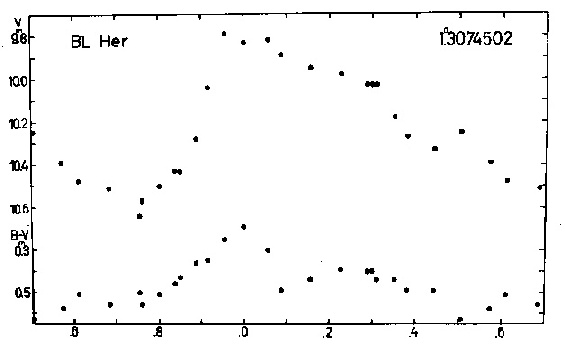 Figure 2 V and B-V curves of BL Her
the comparison star BD +19—3491 seems to be slightly variable in V light therefore the
V light curve shows larger scatter than might otherwise have been expected due to the
observational errors (see Fig. 2). The B light curve shows no mark of variability of the
comparison star. According to Madore (1977), BL Her has a blue photometric companion.
The O-C residuals have been computed by the formulae:
C_{max} = 2441841.289 + 1.3074502d*E ;
Table 4 O-C residuals for BL Her
Obs.Max.J.D. Obs.Med.J.D. E O-C O-C Type w Source
max med
2415196.499 -20379 -0.262d phg 0.5 Jacchia (1940)
2420005.423 -16701 -0.140 phg 1 Parenago (1939a)
2426222.400 -11946 -0.089 vis 1 Esch (1933)
2426503.16 -11731 -0.43 vis 0 Jacchia (1931)
2428384.974 -10292 -0.038 phg 2 Wachmann (1940)
2428734.030 -10025 -0.071 phg 1 Parenago (1939a)
2428955.025 2428954.874 -9856 -0.035 -0.070d phg 2 Wachmann (1940)
2429481.898 2429481.805 -9453 -0.064 -0.042 phg 2 Binnendijk (1950)
2430353.989 2430353.874 -8786 -0.043 -0.043 phg 2 Binnendijk (1950)
2431994.845 2431994.743 -7531 -0.037 -0.023 phg 2 Binnendijk (1950)
2433661.858 -6256 -0.023 phg 1 Solov'yov (1957)
2433661.872 -6256 -0.009 phg 1 Borzdyko (1965)
2433816.153 -6138 -0.007 phel 3 Eggen et al. (1957)
2433860.612 -6104 -0.001 vis 0.5 Koval' (1957)
2433861.986 -6103 +0.066 phg 0.5 Tschuprina (1954)
2433948.198 -6037 -0.014 phg 0.5 Vasil'yanovsk. et al.^1(1970)
2434200.543 -5844 -0.007 phg 0.5 Mandel' (1970)
2434200.547 -5844 -0.003 vis 0.5 Koval' (1957)
2434584.916 -5550 -0.024 phg 0.5 Mandel' (1970)
2434903.950 2434903.844 -5306 -0.008 +0.001 phel 3 Abt, Hardie (1959)
2435457.028 -4883 +0.018 phg 0.5 Vasil'yanovsk. et al^1.(1970)
2435488.388 -4859 0.000 phg 0.5 Mandel' (1970)
2435667.508 -4722 -0.001 phel 3 Abt, Hardie (1959)
Table 4 (cont.)
Obs.Max.J.D. Obs.Med.J.D. E O-C O-C Type w Source
max med
2435871.472 -4566 +0.001d phg 1 Borzdyko (1965)
2436023.157 -4450 +0.021 phg 0.5 Vasil'yanovsk. et al. (1970)
2436083.265 -4404 -0.013 phg 0.5 Mandel' (1970)
2436387.912 -4171 -0.002 phg 0.5 Mandel' (1970)
2436416.659 -4149 -0.019 phg 0.5 Mandel' (1970)
2436771.011 -3878 +0.014 phg 0.5 Mandel' (1970)
2436780.171 -3871 +0.022 phg 1 Borzdyko (1965)
2436832.457 -3831 +0.010 phg 0.5 Huth (1963c)
2437080.876 -3641 +0.013 phg 0.5 Mandel' 1970)
2437143.625 -3593 +0.005 phg 0.5 Mandel' (1970)
2437287.457 -3483 +0.017 phg 0.5 Vasil'yanovsk. et al.^1(1970)
2437454.801 -3355 +0.007 phel 2 Mitchell et al. (1964)
2437501.843 -3319 -0.019 phg 0.5 Mandel' (1970)
2437565.911 -3270 -0.016 phg 0.5 Borzdyko (1965)
2437871.855 2437871.746 -3036 -0.015 -0.009d phel 3 Michalowska-Smak, Smak (1965)
2437871.861 -3036 -0.009 phg 0.5 Mandel' (1970)
2438390.918 -2639 -0.010 phg 0.5 Mandel' (1970)
2438392.227 -2638 -0.008 phg 0.5 Mandel' (1970)
2438434.072 -2606 -0.002 phg 0.5 Vasil'yanovsk. et al.^1 (1970)
2438967.514 -2198 +0.001 phg 0.5 Mandel' (1970)
2439328.253 -1922 -0.002 phel 2 Preston, Kilston (1967)
2441841.293 2441841.180 0 +0.004 +0.006 phel 3 present paper
Remark: 1 Observer: Shakhovskaya.
C_{med} - 2441841.174 + 1.3074502d*E .
The O-C diagram (Fig. 3) for the maximum light can be interpreted in two different ways.
It may consist of two straight lines, or can be represented by a negative parabola. This
uncertainty results from the smallness of the period variation. Assuming the
Figure 2 V and B-V curves of BL Her
the comparison star BD +19—3491 seems to be slightly variable in V light therefore the
V light curve shows larger scatter than might otherwise have been expected due to the
observational errors (see Fig. 2). The B light curve shows no mark of variability of the
comparison star. According to Madore (1977), BL Her has a blue photometric companion.
The O-C residuals have been computed by the formulae:
C_{max} = 2441841.289 + 1.3074502d*E ;
Table 4 O-C residuals for BL Her
Obs.Max.J.D. Obs.Med.J.D. E O-C O-C Type w Source
max med
2415196.499 -20379 -0.262d phg 0.5 Jacchia (1940)
2420005.423 -16701 -0.140 phg 1 Parenago (1939a)
2426222.400 -11946 -0.089 vis 1 Esch (1933)
2426503.16 -11731 -0.43 vis 0 Jacchia (1931)
2428384.974 -10292 -0.038 phg 2 Wachmann (1940)
2428734.030 -10025 -0.071 phg 1 Parenago (1939a)
2428955.025 2428954.874 -9856 -0.035 -0.070d phg 2 Wachmann (1940)
2429481.898 2429481.805 -9453 -0.064 -0.042 phg 2 Binnendijk (1950)
2430353.989 2430353.874 -8786 -0.043 -0.043 phg 2 Binnendijk (1950)
2431994.845 2431994.743 -7531 -0.037 -0.023 phg 2 Binnendijk (1950)
2433661.858 -6256 -0.023 phg 1 Solov'yov (1957)
2433661.872 -6256 -0.009 phg 1 Borzdyko (1965)
2433816.153 -6138 -0.007 phel 3 Eggen et al. (1957)
2433860.612 -6104 -0.001 vis 0.5 Koval' (1957)
2433861.986 -6103 +0.066 phg 0.5 Tschuprina (1954)
2433948.198 -6037 -0.014 phg 0.5 Vasil'yanovsk. et al.^1(1970)
2434200.543 -5844 -0.007 phg 0.5 Mandel' (1970)
2434200.547 -5844 -0.003 vis 0.5 Koval' (1957)
2434584.916 -5550 -0.024 phg 0.5 Mandel' (1970)
2434903.950 2434903.844 -5306 -0.008 +0.001 phel 3 Abt, Hardie (1959)
2435457.028 -4883 +0.018 phg 0.5 Vasil'yanovsk. et al^1.(1970)
2435488.388 -4859 0.000 phg 0.5 Mandel' (1970)
2435667.508 -4722 -0.001 phel 3 Abt, Hardie (1959)
Table 4 (cont.)
Obs.Max.J.D. Obs.Med.J.D. E O-C O-C Type w Source
max med
2435871.472 -4566 +0.001d phg 1 Borzdyko (1965)
2436023.157 -4450 +0.021 phg 0.5 Vasil'yanovsk. et al. (1970)
2436083.265 -4404 -0.013 phg 0.5 Mandel' (1970)
2436387.912 -4171 -0.002 phg 0.5 Mandel' (1970)
2436416.659 -4149 -0.019 phg 0.5 Mandel' (1970)
2436771.011 -3878 +0.014 phg 0.5 Mandel' (1970)
2436780.171 -3871 +0.022 phg 1 Borzdyko (1965)
2436832.457 -3831 +0.010 phg 0.5 Huth (1963c)
2437080.876 -3641 +0.013 phg 0.5 Mandel' 1970)
2437143.625 -3593 +0.005 phg 0.5 Mandel' (1970)
2437287.457 -3483 +0.017 phg 0.5 Vasil'yanovsk. et al.^1(1970)
2437454.801 -3355 +0.007 phel 2 Mitchell et al. (1964)
2437501.843 -3319 -0.019 phg 0.5 Mandel' (1970)
2437565.911 -3270 -0.016 phg 0.5 Borzdyko (1965)
2437871.855 2437871.746 -3036 -0.015 -0.009d phel 3 Michalowska-Smak, Smak (1965)
2437871.861 -3036 -0.009 phg 0.5 Mandel' (1970)
2438390.918 -2639 -0.010 phg 0.5 Mandel' (1970)
2438392.227 -2638 -0.008 phg 0.5 Mandel' (1970)
2438434.072 -2606 -0.002 phg 0.5 Vasil'yanovsk. et al.^1 (1970)
2438967.514 -2198 +0.001 phg 0.5 Mandel' (1970)
2439328.253 -1922 -0.002 phel 2 Preston, Kilston (1967)
2441841.293 2441841.180 0 +0.004 +0.006 phel 3 present paper
Remark: 1 Observer: Shakhovskaya.
C_{med} - 2441841.174 + 1.3074502d*E .
The O-C diagram (Fig. 3) for the maximum light can be interpreted in two different ways.
It may consist of two straight lines, or can be represented by a negative parabola. This
uncertainty results from the smallness of the period variation. Assuming the
 Figure 3 O-C diagram of BL Her
case of sudden period change the values of the period were 1.3074604d before J.D. 2435000
and 1.3074502d after J.D. 2435000. The approximation of the O-C diagram with a parabola is
as follows:
C^'_{max} = 2434999.402 + 1.307457d*E - 3.9d*10^{-10}*E^2.
SW Tauri
This star is a short period Population II cepheid. This classification is supported
by the shape of the light curves and the phase shift between the minimum value of U-B
colour index and the light maximum in V (see Fig. 4). According to Mandel's (1970)
photographic observations there is a small bump on the light curve of SW Tau near its
minimum brightness. Unfortunately, neither the photoelectric observations made by Milone
(1970) nor the present observations provides enough data about the minimum, to prove the
presence of this bump. Nevertheless, the photoelectric observations show a stable light
curve though Latyshev (1963) listed SW Tau among double mode cepheids. SW Tau is a
representative of short period flat-topped cepheids. The star reaches its light maximum
after a very slow increase of brightness. The point of maximum is at the right end of the
flat top. Earlier the maximum was thought to be at the mid-phase of the top, therefore a
small correction has been applied in determining O-C residuals should the original
observations not be pub-
Figure 3 O-C diagram of BL Her
case of sudden period change the values of the period were 1.3074604d before J.D. 2435000
and 1.3074502d after J.D. 2435000. The approximation of the O-C diagram with a parabola is
as follows:
C^'_{max} = 2434999.402 + 1.307457d*E - 3.9d*10^{-10}*E^2.
SW Tauri
This star is a short period Population II cepheid. This classification is supported
by the shape of the light curves and the phase shift between the minimum value of U-B
colour index and the light maximum in V (see Fig. 4). According to Mandel's (1970)
photographic observations there is a small bump on the light curve of SW Tau near its
minimum brightness. Unfortunately, neither the photoelectric observations made by Milone
(1970) nor the present observations provides enough data about the minimum, to prove the
presence of this bump. Nevertheless, the photoelectric observations show a stable light
curve though Latyshev (1963) listed SW Tau among double mode cepheids. SW Tau is a
representative of short period flat-topped cepheids. The star reaches its light maximum
after a very slow increase of brightness. The point of maximum is at the right end of the
flat top. Earlier the maximum was thought to be at the mid-phase of the top, therefore a
small correction has been applied in determining O-C residuals should the original
observations not be pub-
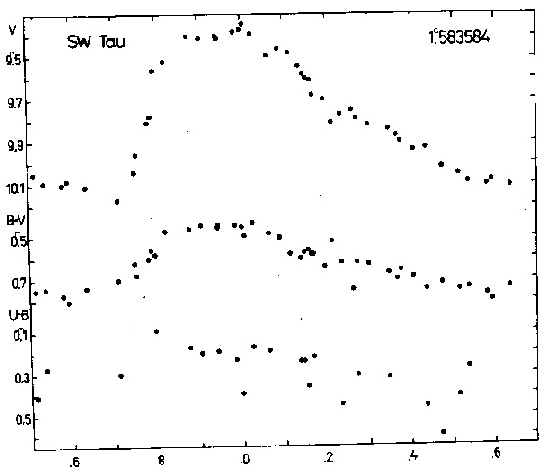 Figure 4 V, B-V and U-B curves of SW Tau
Figure 4 V, B-V and U-B curves of SW Tau
 Figure 5 O-C diagram of SW Tau
Table 5 O-C residuals for SW Tau
Obs.Max.J.D. E O-C Type w Source
2418240.787 -14806 -0.38d vis 0.5 Munch (1909)
2419730.929 -13865 -0.449 phg 0.5 Robinson (1930)
2420440.44 -13417 -0.38 vis 0.5 Hoffmeister (1919)
2420842.84 -13163 -0.21 vis 0 Hoffmeister (1919)
2421200.62 -12937 -0.32 vis 0.5 Hoffmeister (1919)
2430434.692 -7106 -0.130 phg 1 Solov'yov (1957)
2432354.063 -5894 -0.063 phg 1 Borzdyko (1965)
2433473.67 -5187 -0.05 phg 0.5 Vasil'yan, et al. (1970)
2433638.348 -5083 -0.065 phel 2 Eggen et al. (1957)
2434377.922 -4616 -0.024 phg 1 Borzdyko (1965)
Table 5 (cont.)
Obs.Max.J.D. E O-C Type w Source
2435000.23 -4223 -0.06d phg 0.5 Vasil'yan. et al. (1970)
2435502.195 -3906 -0.096 phg 0.5 Stilijanow (1966)
2435774.64 -3734 -0.03 phg 0.5 Vasil'yan. et al. (1970)
2435879.196 -3668 +0.012 phg 1 Borzdyko (1965)
2436197.508 -3467 +0.024 phg 0.5 Stilijanow (1966)
2436555.339 -3241 -0.035 phg 0.5 Mandel' (1970)
2436846.699 -3057 -0.055 phg 0.5 Stilijanow (1966)
2437003.558 -2958 +0.029 phg 0.5 Borzdyko (1965)
2437147.64 -2867 +0.01 phg 0.5 Vasil'yan. et al. (1970)
2437465.884 -2666 -0.051 phg 1 Mandel' (1970)
2437584.694 -2591 -0.010 phg 0.5 Stilijanow (1966)
2437907.713 -2387 -0.042 phg 0.5 Stilijanow (1966)
2438083.498 -2276 -0.035 phg 0.5 Stilijanow (1966)
2438376.52 -2091 +0.02 phg 0.5 Vasil'yan. et al. (1970)
2438441.416 -2050 -0.007 phg 0.5 Stilijanow (1966)
2438894.340 -1764 +0.012 phg 0.5 Mandel' (1970)
2439059.029 -1660 +0.008 phel 3 Milone (1970)
2439063.790 -1657 +0.019 phg 0.5 Stilijanow (1966)
2439078.025 -1648 +0.001 phel 3 Wamsteker (1972)
2441687.773 0 +0.003 phel 3 present paper
2443176.335 +940 -0.004 phel 2 present paper
lished. The true maximum in B is 0.1d later than the mid-phase of the top.
The O-C residuals have been computed with the formula:
C = 2441687.770 + 1.583584d*E .
Figure 5 shows a period change at J.D. 2436000. Before this change the value of the period
was 1.583623, after J.D. 2436000 the period is 1.583584.
SU Cassiopeiae
Figure 5 O-C diagram of SW Tau
Table 5 O-C residuals for SW Tau
Obs.Max.J.D. E O-C Type w Source
2418240.787 -14806 -0.38d vis 0.5 Munch (1909)
2419730.929 -13865 -0.449 phg 0.5 Robinson (1930)
2420440.44 -13417 -0.38 vis 0.5 Hoffmeister (1919)
2420842.84 -13163 -0.21 vis 0 Hoffmeister (1919)
2421200.62 -12937 -0.32 vis 0.5 Hoffmeister (1919)
2430434.692 -7106 -0.130 phg 1 Solov'yov (1957)
2432354.063 -5894 -0.063 phg 1 Borzdyko (1965)
2433473.67 -5187 -0.05 phg 0.5 Vasil'yan, et al. (1970)
2433638.348 -5083 -0.065 phel 2 Eggen et al. (1957)
2434377.922 -4616 -0.024 phg 1 Borzdyko (1965)
Table 5 (cont.)
Obs.Max.J.D. E O-C Type w Source
2435000.23 -4223 -0.06d phg 0.5 Vasil'yan. et al. (1970)
2435502.195 -3906 -0.096 phg 0.5 Stilijanow (1966)
2435774.64 -3734 -0.03 phg 0.5 Vasil'yan. et al. (1970)
2435879.196 -3668 +0.012 phg 1 Borzdyko (1965)
2436197.508 -3467 +0.024 phg 0.5 Stilijanow (1966)
2436555.339 -3241 -0.035 phg 0.5 Mandel' (1970)
2436846.699 -3057 -0.055 phg 0.5 Stilijanow (1966)
2437003.558 -2958 +0.029 phg 0.5 Borzdyko (1965)
2437147.64 -2867 +0.01 phg 0.5 Vasil'yan. et al. (1970)
2437465.884 -2666 -0.051 phg 1 Mandel' (1970)
2437584.694 -2591 -0.010 phg 0.5 Stilijanow (1966)
2437907.713 -2387 -0.042 phg 0.5 Stilijanow (1966)
2438083.498 -2276 -0.035 phg 0.5 Stilijanow (1966)
2438376.52 -2091 +0.02 phg 0.5 Vasil'yan. et al. (1970)
2438441.416 -2050 -0.007 phg 0.5 Stilijanow (1966)
2438894.340 -1764 +0.012 phg 0.5 Mandel' (1970)
2439059.029 -1660 +0.008 phel 3 Milone (1970)
2439063.790 -1657 +0.019 phg 0.5 Stilijanow (1966)
2439078.025 -1648 +0.001 phel 3 Wamsteker (1972)
2441687.773 0 +0.003 phel 3 present paper
2443176.335 +940 -0.004 phel 2 present paper
lished. The true maximum in B is 0.1d later than the mid-phase of the top.
The O-C residuals have been computed with the formula:
C = 2441687.770 + 1.583584d*E .
Figure 5 shows a period change at J.D. 2436000. Before this change the value of the period
was 1.583623, after J.D. 2436000 the period is 1.583584.
SU Cassiopeiae
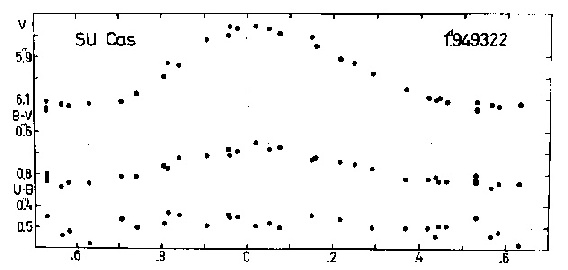 Figure 6 V, B-V and U-B curves of SU Cas
Table 6 O-C residuals for SU Cas
Obs.Max.J.D. Obs.Med.J.D. E O-C O-C Type w Source
max med
2417287.164 2417286.809 -12496 -0.28d +0.005d vis 1 Muller, Kempf (1907)
2417347.775 -12465 +0.164 vis 0 Munch (1910)
2417482.181 -12396 +0.067 vis 0.5 Muller, Kempf^1 (1907)
2417770.629 2417770.223 -12248 +0.015 -0.013 phg 2 Parkhurst (1908)
2417794.090 -12236 +0.084 vis 0.5 Zeipel (1908)
2418055.209 -12102 -0.006 vis 0.5 Nijland (1923)
2418873.924 -11682 -0.006 vis 0.5 Nijland (1923)
2420025.890 -11091 -0.090 vis 0.5 Hoffmeister (1915)
2421394.42 -10389 +0.02 vis 1 Vogelenzang (1922)
2422285.552 -9932 +0.308 vis 0 Ellsworth (1928)
2423115.771 -9506 +0.116 vis 0 Ellsworth (1928)
2423386.570 -9367 -0.041 vis 0.5 Hellerich (1926a)
2423677.080 -9218 +0.020 vis 0.5 Hopmann (1926a)
2424148.790 2424148.410 -8976 -0.006 -0.008 vis 1 Parenago (1938)
2424840.855 2424840.524 -8621 +0.050 +0.097 vis 0.5 Kukarkin (1940)
2425051.298 2425050.955 -8513 -0.034 +0.001 phg 1 Hellerich (1935)
2425096.155 2425095.820 -8490 -0.011 +0.032 vis 1 Parenago (1938)
2425283.360 2425282.981 -8394 +0.059 +0.058 vis 1 Kukarkin (1940)
2425630.257 2425629.916 -8216 -0.023 +0.014 vis 1 Zverev (1936)
2425698.552 2425698.248 -8181 +0.043 +0.119 vis 0.5 Kukarkin (1940)
2425747.254 2425746.862 -8156 +0.014 0.000 vis 1 Parenago (1938)
2425969.403 -8042 -0.059 vis 0.5 Florya, Kukarkina (1953)
2426086.404 2426086.094 -7982 -0.018 +0.050 vis 1 Zverev (1936)
2426560.123 -7739 +0.016 vis 0.5 Kukarkin (1940)
2426755.064 2426754.688 -7639 +0.025 +0.027 phg 1 Kox (1935)
2426766.766 2426766.362 -7633 +0.031 +0.005 vis 1 Florya, Kukarkina (1953)
2426895.330 2426894.938 -7567 -0.060 -0.074 phg 1 Hasenstein (1954)
2427127.283 2427126.900 -7448 -0.077 -0.082 vis 1 Parenago (1938)
2427881.760 -7061 +0.013 vis 1 Krebs (1937a)
2428144.865 -6926 -0.041 vis 1 Krebs (1937a)
Table 6 (cont.)
Obs.Max.J.D. Obs.Med.J.D. E O-C O-C Type w Source
max med
2429181.912 -6394 -0.033d phg 1 Mandrykina (1949)
2430404.167 2430403.793 -5767 -0.003 +0.001 phel 3 Walter (1943)
2430905.119 2430904.784 -5510 -0.027 +0.016 phel 3 Groeneveld (1944)
2432639.97 -4620 -0.07 vis 0.5 Pohl^2 (1950)
2435755.041 2435754.663 -3022 -0.018 -0.018 phel 3 Prokof'yeva (1961)
2436199.516 -2794 +0.012 phel 2 Svolopoulos (1960)
2436836.942 -2467 +0.009 phel 2 Bahner et al. (1962)
2437439.297 2437438.927 -2158 +0.024 +0.032 phel 3 Mitchell et al. (1964)
2437987.089 -1877 +0.054 vis 0.5 Kunicki (1972)
2438384.671 2438384.291 -1673 -0.023 -0.025 phel 3 Wisniewski, Johnson (1968)
2439055.269 2439054.887 -1329 +0.008 +0.004 phel 3 Milone (1970)
2439361.299 2439360.919 -1172 -0.006 -0.008 phel 3 Takase (1969)
2439447.074 2439446.719 -1128 -0.001 +0.022 phel 3 Wamsteker (1972)
2439751.198 2439750.759 -972 +0.029 -0.032 phel 2 Sudzius (1969)
2439864.198 2439863.859 -914 -0.032 +0.007 phel 3 Reed (1968)
2441645.925 2441645.537 0 +0.015 +0.005 phel 3 present paper
2441930.480 +146 -0.021 phel 3 Gieren (1976)
Remarks:
1. Observer: Graff
2. Observer: Pocher
Figure 6 V, B-V and U-B curves of SU Cas
Table 6 O-C residuals for SU Cas
Obs.Max.J.D. Obs.Med.J.D. E O-C O-C Type w Source
max med
2417287.164 2417286.809 -12496 -0.28d +0.005d vis 1 Muller, Kempf (1907)
2417347.775 -12465 +0.164 vis 0 Munch (1910)
2417482.181 -12396 +0.067 vis 0.5 Muller, Kempf^1 (1907)
2417770.629 2417770.223 -12248 +0.015 -0.013 phg 2 Parkhurst (1908)
2417794.090 -12236 +0.084 vis 0.5 Zeipel (1908)
2418055.209 -12102 -0.006 vis 0.5 Nijland (1923)
2418873.924 -11682 -0.006 vis 0.5 Nijland (1923)
2420025.890 -11091 -0.090 vis 0.5 Hoffmeister (1915)
2421394.42 -10389 +0.02 vis 1 Vogelenzang (1922)
2422285.552 -9932 +0.308 vis 0 Ellsworth (1928)
2423115.771 -9506 +0.116 vis 0 Ellsworth (1928)
2423386.570 -9367 -0.041 vis 0.5 Hellerich (1926a)
2423677.080 -9218 +0.020 vis 0.5 Hopmann (1926a)
2424148.790 2424148.410 -8976 -0.006 -0.008 vis 1 Parenago (1938)
2424840.855 2424840.524 -8621 +0.050 +0.097 vis 0.5 Kukarkin (1940)
2425051.298 2425050.955 -8513 -0.034 +0.001 phg 1 Hellerich (1935)
2425096.155 2425095.820 -8490 -0.011 +0.032 vis 1 Parenago (1938)
2425283.360 2425282.981 -8394 +0.059 +0.058 vis 1 Kukarkin (1940)
2425630.257 2425629.916 -8216 -0.023 +0.014 vis 1 Zverev (1936)
2425698.552 2425698.248 -8181 +0.043 +0.119 vis 0.5 Kukarkin (1940)
2425747.254 2425746.862 -8156 +0.014 0.000 vis 1 Parenago (1938)
2425969.403 -8042 -0.059 vis 0.5 Florya, Kukarkina (1953)
2426086.404 2426086.094 -7982 -0.018 +0.050 vis 1 Zverev (1936)
2426560.123 -7739 +0.016 vis 0.5 Kukarkin (1940)
2426755.064 2426754.688 -7639 +0.025 +0.027 phg 1 Kox (1935)
2426766.766 2426766.362 -7633 +0.031 +0.005 vis 1 Florya, Kukarkina (1953)
2426895.330 2426894.938 -7567 -0.060 -0.074 phg 1 Hasenstein (1954)
2427127.283 2427126.900 -7448 -0.077 -0.082 vis 1 Parenago (1938)
2427881.760 -7061 +0.013 vis 1 Krebs (1937a)
2428144.865 -6926 -0.041 vis 1 Krebs (1937a)
Table 6 (cont.)
Obs.Max.J.D. Obs.Med.J.D. E O-C O-C Type w Source
max med
2429181.912 -6394 -0.033d phg 1 Mandrykina (1949)
2430404.167 2430403.793 -5767 -0.003 +0.001 phel 3 Walter (1943)
2430905.119 2430904.784 -5510 -0.027 +0.016 phel 3 Groeneveld (1944)
2432639.97 -4620 -0.07 vis 0.5 Pohl^2 (1950)
2435755.041 2435754.663 -3022 -0.018 -0.018 phel 3 Prokof'yeva (1961)
2436199.516 -2794 +0.012 phel 2 Svolopoulos (1960)
2436836.942 -2467 +0.009 phel 2 Bahner et al. (1962)
2437439.297 2437438.927 -2158 +0.024 +0.032 phel 3 Mitchell et al. (1964)
2437987.089 -1877 +0.054 vis 0.5 Kunicki (1972)
2438384.671 2438384.291 -1673 -0.023 -0.025 phel 3 Wisniewski, Johnson (1968)
2439055.269 2439054.887 -1329 +0.008 +0.004 phel 3 Milone (1970)
2439361.299 2439360.919 -1172 -0.006 -0.008 phel 3 Takase (1969)
2439447.074 2439446.719 -1128 -0.001 +0.022 phel 3 Wamsteker (1972)
2439751.198 2439750.759 -972 +0.029 -0.032 phel 2 Sudzius (1969)
2439864.198 2439863.859 -914 -0.032 +0.007 phel 3 Reed (1968)
2441645.925 2441645.537 0 +0.015 +0.005 phel 3 present paper
2441930.480 +146 -0.021 phel 3 Gieren (1976)
Remarks:
1. Observer: Graff
2. Observer: Pocher
 Figure 7 O-C diagram of SU Cas
This is a cepheid with small amplitude (see Fig. 6). According to Kukarkin et al.
(1971) its period probably varies. However, neither the O-C diagram of the maximum
brightness, nor that of the median brightness shows any changes in the period. The O-C
residuals plotted in Fig. 7 have been computed with the formulae:
C_{max} = 2441645.910 + 1.949322d*E ;
C_{med} = 2441645.532 + 1.949322d*E .
The period of SU Cas has been constant since the discovery of its light variation.
EU Tauri
EU Tau is a cepheid with small amplitude (see Fig. 8). There are only four
valuable sets of observations within a short time interval therefore the O-C residuals
given in Table 7 are not plotted in a separate figure. The residuals have been derived
using the formula:
C = 2441704.785 + 2.10248d*E .
Figure 7 O-C diagram of SU Cas
This is a cepheid with small amplitude (see Fig. 6). According to Kukarkin et al.
(1971) its period probably varies. However, neither the O-C diagram of the maximum
brightness, nor that of the median brightness shows any changes in the period. The O-C
residuals plotted in Fig. 7 have been computed with the formulae:
C_{max} = 2441645.910 + 1.949322d*E ;
C_{med} = 2441645.532 + 1.949322d*E .
The period of SU Cas has been constant since the discovery of its light variation.
EU Tauri
EU Tau is a cepheid with small amplitude (see Fig. 8). There are only four
valuable sets of observations within a short time interval therefore the O-C residuals
given in Table 7 are not plotted in a separate figure. The residuals have been derived
using the formula:
C = 2441704.785 + 2.10248d*E .
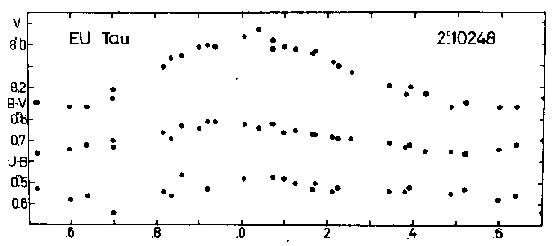 Figure 8 V, B-V and U-B curves of EU Tau
Table 7 O-C residuals for EU Tau
Obs.Max.J.D. E O-C Type w Source
2438973.668 -1299 +0.005d phel 3 Guinan (1972)
2440998.346 -336 -0.006 phel 3 Wachmann (1976)
2441334.746 -176 -0.003 phel 3 Sanwal et al. (1974)
2441704.788 0 +0.003 phel 3 present paper
IR Cephei
The newly discovered cepheid variable IR Cep = HBV 476 belongs to the group of
small amplitude cepheids (see Fig. 9). However,
Figure 8 V, B-V and U-B curves of EU Tau
Table 7 O-C residuals for EU Tau
Obs.Max.J.D. E O-C Type w Source
2438973.668 -1299 +0.005d phel 3 Guinan (1972)
2440998.346 -336 -0.006 phel 3 Wachmann (1976)
2441334.746 -176 -0.003 phel 3 Sanwal et al. (1974)
2441704.788 0 +0.003 phel 3 present paper
IR Cephei
The newly discovered cepheid variable IR Cep = HBV 476 belongs to the group of
small amplitude cepheids (see Fig. 9). However,
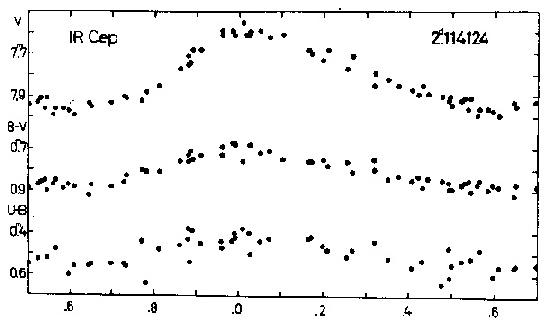 Figure 9 V, B-V and U-B curves of IR Cep
the light curve is not symmetrical (or "sinusoidal"), i.e. it differs markedly from the
other small amplitude cepheids in the shape of the light curve. There are two possible
explanations for resolving this difference:
1/ the variable star has a companion that reduces the amplitude of the light variation;
2/ the group of cepheids with small amplitude is not homogeneous, it includes cepheids
with nearly symmetrical as well as non-symmetrical light curves.
In order to decide whether the first explanation is valid, spectroscopic observations are
highly desirable.
The O-C residuals have been computed with the formula:
C = 2441696.582 + 2.114124d*E .
These residuals are plotted in Fig. 10. The period of IR Cep
Figure 9 V, B-V and U-B curves of IR Cep
the light curve is not symmetrical (or "sinusoidal"), i.e. it differs markedly from the
other small amplitude cepheids in the shape of the light curve. There are two possible
explanations for resolving this difference:
1/ the variable star has a companion that reduces the amplitude of the light variation;
2/ the group of cepheids with small amplitude is not homogeneous, it includes cepheids
with nearly symmetrical as well as non-symmetrical light curves.
In order to decide whether the first explanation is valid, spectroscopic observations are
highly desirable.
The O-C residuals have been computed with the formula:
C = 2441696.582 + 2.114124d*E .
These residuals are plotted in Fig. 10. The period of IR Cep
 Figure 10 O-C diagram of IR Cep
Table 8 O-C residuals for IR Cep
Obs.Max.J.D. E O-C Type w Source
2428335.914 -6320 +O.596d phg 1 Klawitter (1971)
2429515.512 -5762 +0.512 phg 1 Klawitter (1971)
2430373.783 -5356 +0.449 phg 1 Klawitter (1971)
2430517.605 -5288 +0.511 phg 1 Klawitter (1971)
2430703.620 -5200 +0.483 phg 1 Klawitter (1971)
2431033.395 -5044 +0.454 phg 1 Klawitter (1971)
2440965.096 -346 +0.001 phel 3 Wachmann (1976)
2441696.580 0 -0.002 phel 3 present paper
2443045.394 +638 +0.001 phel 2 present paper
shows one strong change. Before J.D. 2440900 the period was 2.114027d or even smaller,
after J.D. 2440900 the period is 2.114124d.
BB Geminorum
Figure 10 O-C diagram of IR Cep
Table 8 O-C residuals for IR Cep
Obs.Max.J.D. E O-C Type w Source
2428335.914 -6320 +O.596d phg 1 Klawitter (1971)
2429515.512 -5762 +0.512 phg 1 Klawitter (1971)
2430373.783 -5356 +0.449 phg 1 Klawitter (1971)
2430517.605 -5288 +0.511 phg 1 Klawitter (1971)
2430703.620 -5200 +0.483 phg 1 Klawitter (1971)
2431033.395 -5044 +0.454 phg 1 Klawitter (1971)
2440965.096 -346 +0.001 phel 3 Wachmann (1976)
2441696.580 0 -0.002 phel 3 present paper
2443045.394 +638 +0.001 phel 2 present paper
shows one strong change. Before J.D. 2440900 the period was 2.114027d or even smaller,
after J.D. 2440900 the period is 2.114124d.
BB Geminorum
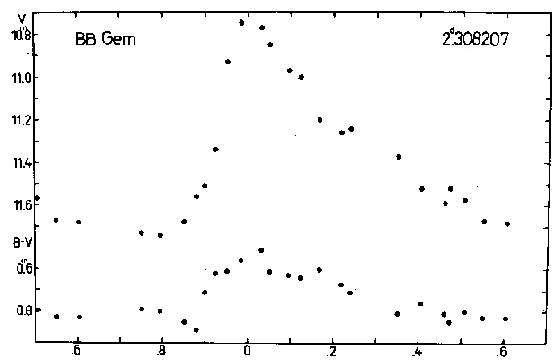 Figure 11 V and B-V curves of BB Gem
The star BB Gem is a Population II cepheid. According to Efremov (1968b) the
maximum value of the light amplitude of classical cepheids in the blue band is about 0.85m
at log P = 0.36. BB Gem has an amplitude of 1.27m in band B (see Fig. 11). This extremely
large amplitude supports the above-mentioned new classification for this cepheid.
The O-C residuals for this star have been obtained by the formula:
C = 2441839.695 + 2.308207d*E
These residuals are plotted in Fig. 12. The period of BB Gem has remained constant for
more than 7000 epochs.
Figure 11 V and B-V curves of BB Gem
The star BB Gem is a Population II cepheid. According to Efremov (1968b) the
maximum value of the light amplitude of classical cepheids in the blue band is about 0.85m
at log P = 0.36. BB Gem has an amplitude of 1.27m in band B (see Fig. 11). This extremely
large amplitude supports the above-mentioned new classification for this cepheid.
The O-C residuals for this star have been obtained by the formula:
C = 2441839.695 + 2.308207d*E
These residuals are plotted in Fig. 12. The period of BB Gem has remained constant for
more than 7000 epochs.
 Figure 12 O-C diagram of BB Gem
Table 9 O-C residuals for BB Gem
Obs.Max.J.D. E O-C Type w Source
2425296.787 -7167 +0.012d phg 2 Zonn (1935)
2427482.659 -6220 +0.012 phg 2 Zonn (1935)
2428454.365 -5799 -0.038 vis 0.5 Solov'yov (1940)
2431425.091 -4512 +0.026 phg 1 Teplitskaya (1951)
2433315.399 -3693 -0.088 phg 0.5 Satyvaldiev (1970)
2433317.80 -3692 +0.01 phg 0.5 Solov'yov (1951)
2433421.608 -3647 -0.056 phg 0.5 Borzdyko (1964)
2434975.100 -2974 +0.013 phg 0.5 Borzdyko (1964)
2435157.412 -2895 -0.024 phg 0.5 Satyvaldiev (1970)
2436784.690 -2190 -0.032 phg 0.5 Borzdyko (1964)
2436800.905 -2183 +0.026 phg 0.5 Satyvaldiev (1970)
2436849.315 -2162 -0.036 phel 2 Oosterhoff (1960)
2437606.48 -1834 +0.04 phg 0.5 Ahnert (1963)
2438201.986 -1576 +0.025 phg 0.5 Satyvaldiev (1970)
2441839.711 0 +0.016 phel 3 present paper
AU Pegasi
This is usually classified as a Population II cepheid (Kukarkin et al. 1969-1970,
Opolski 1968, Petit 1960). Several authors (Gascoigne and Eggen 1957, Kolesnik and Kheilo
1970) classified it among classical cepheids. The phase shift between the maxima of its
light and colour curves as the only population criterion at the small amplitude cepheids
based on optical observations unambiguously shows that AU Peg belongs to Population II
(see
Figure 12 O-C diagram of BB Gem
Table 9 O-C residuals for BB Gem
Obs.Max.J.D. E O-C Type w Source
2425296.787 -7167 +0.012d phg 2 Zonn (1935)
2427482.659 -6220 +0.012 phg 2 Zonn (1935)
2428454.365 -5799 -0.038 vis 0.5 Solov'yov (1940)
2431425.091 -4512 +0.026 phg 1 Teplitskaya (1951)
2433315.399 -3693 -0.088 phg 0.5 Satyvaldiev (1970)
2433317.80 -3692 +0.01 phg 0.5 Solov'yov (1951)
2433421.608 -3647 -0.056 phg 0.5 Borzdyko (1964)
2434975.100 -2974 +0.013 phg 0.5 Borzdyko (1964)
2435157.412 -2895 -0.024 phg 0.5 Satyvaldiev (1970)
2436784.690 -2190 -0.032 phg 0.5 Borzdyko (1964)
2436800.905 -2183 +0.026 phg 0.5 Satyvaldiev (1970)
2436849.315 -2162 -0.036 phel 2 Oosterhoff (1960)
2437606.48 -1834 +0.04 phg 0.5 Ahnert (1963)
2438201.986 -1576 +0.025 phg 0.5 Satyvaldiev (1970)
2441839.711 0 +0.016 phel 3 present paper
AU Pegasi
This is usually classified as a Population II cepheid (Kukarkin et al. 1969-1970,
Opolski 1968, Petit 1960). Several authors (Gascoigne and Eggen 1957, Kolesnik and Kheilo
1970) classified it among classical cepheids. The phase shift between the maxima of its
light and colour curves as the only population criterion at the small amplitude cepheids
based on optical observations unambiguously shows that AU Peg belongs to Population II
(see
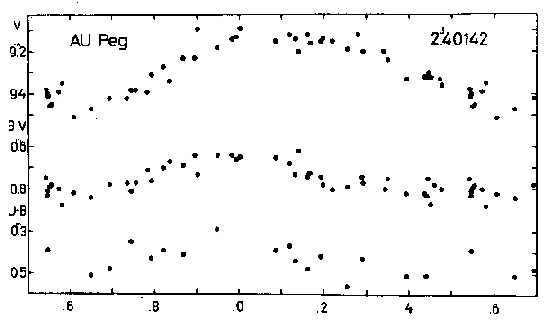 Figure 13 V, B-V and U-B curves of AU Peg
Fig. 13). Moreover, the strong changes in the period of AU Peg (see Fig. 14) also support
this classification. The short period classical cepheids do not show such strong period
changes.
The O-C diagram shows an interesting structure. It was computed with the ephemeris:
C = 2435801.832 + 2.390048d*E .
I was unable to find a unique representation of the O-C diagram. At earlier epochs two
different O-C residuals are listed and plotted for each maximum. It is hard to decide
which curve is the real one. However, the light curves plotted from the observations
serving as a basis for computing O-C values show less scatter when using the smaller value
of the period, i.e. the upper curve is more suitable. This curve shows a continuous
increase of the period, but it cannot be approximated with a parabola. The minimum value
of the period was about 2.3844d at J.D. 2427000, the maximum value at present is 2.40142d.
The total change of the period is about 1%. There are no other short period cepheids
showing such a large period variation. For example, V1 in M15 has a quasi-parabolic O-C
graph with considerable period change but the total change in its period is about 0.01%
during 23000 days (Barlai 1977).
The central part of the O-C diagram in Fig. 14 is in accordance with the O-C
diagram published by Kwee (1967).
Figure 13 V, B-V and U-B curves of AU Peg
Fig. 13). Moreover, the strong changes in the period of AU Peg (see Fig. 14) also support
this classification. The short period classical cepheids do not show such strong period
changes.
The O-C diagram shows an interesting structure. It was computed with the ephemeris:
C = 2435801.832 + 2.390048d*E .
I was unable to find a unique representation of the O-C diagram. At earlier epochs two
different O-C residuals are listed and plotted for each maximum. It is hard to decide
which curve is the real one. However, the light curves plotted from the observations
serving as a basis for computing O-C values show less scatter when using the smaller value
of the period, i.e. the upper curve is more suitable. This curve shows a continuous
increase of the period, but it cannot be approximated with a parabola. The minimum value
of the period was about 2.3844d at J.D. 2427000, the maximum value at present is 2.40142d.
The total change of the period is about 1%. There are no other short period cepheids
showing such a large period variation. For example, V1 in M15 has a quasi-parabolic O-C
graph with considerable period change but the total change in its period is about 0.01%
during 23000 days (Barlai 1977).
The central part of the O-C diagram in Fig. 14 is in accordance with the O-C
diagram published by Kwee (1967).
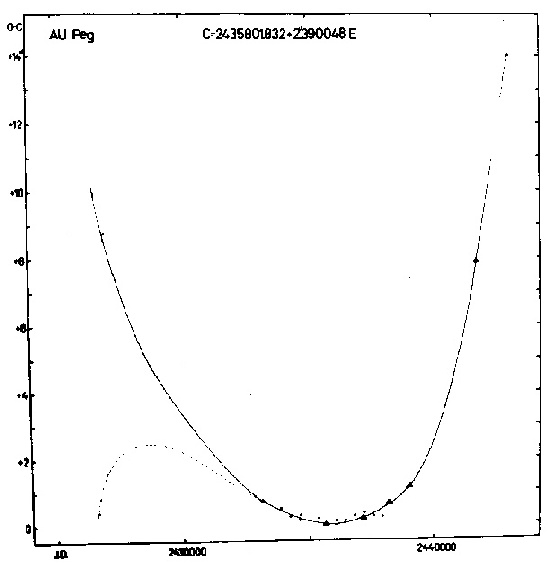 Figure 14 O-C diagram of AU Peg
Table 10 O-C residuals for AU Peg
Obs.Max.J.D. E O-C Type w Source
2419080.201 ? ? phg 0.5 Parenago (1934)
2426578.959 -3863 +9.882d vis 0.5 Florya (1933)
-3859 +0.322
2426636.40 -3839 +9.96 vis 0.5 Lause (1932)
-3835 +0.40
2426952.911 -3706 +8.597 vis 0.5 Florya (1933)
-3703 +1.427
2427000.90 -3686 +8.78 vis 0.5 Lause (1933)
-3683 +1.61
2428729.76 -2961 +4.86 vis 0.5 Kukarkin (1938)
-2960 +2.47
2433151.976 -1109 +0.709 phel 2 Eggen et al. (1957)
2433156.727 -1107 +0.678 phg 0.5 Vasil'yan. et al.^1 (1970)
2433875.952 -806 +0.499 phg 0.5 Vasil'yan. et al.^1 (1970)
Table 10 (cont.)
Obs.Max.J.D. E O-C Type w Source
2434258.118 -646 +0.257d phg 0.5 Vasil'yan. et al.^1 (1970)
2434614.133 -497 +0.155 phg 0.5 Vasil'yan. et al.^1 (1970)
2434654.90 -480 +0.29 phg 0.5 Gunther (1955)
2435383.768 -175 +0.194 phg 0.5 Vasil'yan. et al.^1 (1970)
2435667.965 - 56 -0.024 phel 3 Walraven et al. (1958)
2435751.615 - 21 -0.026 phg 0.5 Vasil'yan. et al.^1 (1970)
2436076.678 +115 -0.010 phg 0.5 Vasil'yan, et al.^1 (1970)
2436093.540 +122 +0.122 phg 0.5 Korovkina (1958)
2436442.493 +268 +0.128 phg 0.5 Vasil'yan. et al.^1 (1970)
2436829.821 +430 +0.268 phg 0.5 Vasil'yan. et al.^1 (1970)
2437185.841 +579 +0.171 phel 3 Mitchell et al. (1964)
2437207.539 +588 +0.359 phg 0.5 Vasil'yan. et al.^1 (1970)
2437580.286 +744 +0.258 phg 0.5 Vasil'yan. et al.^1 (1970)
2437941.154 +895 +0.229 phg 0.5 Vasil'yan. et al.^1 (1970)
2438228.339 +1015 +0.608 phel 3 Kwee and Braun (1967)
2438300.062 +1045 +0.630 phg 0.5 Vasil'yan. et al.^1 (1970)
2438654.026 +1193 +0.867 phg 0.5 Vasil'yan. et al.^1 (1970)
2439039.083 +1354 +1.126 phel 3 Wamsteker (1972)
2441739.439 +2481 +7.898 phel 3 present paper
2443031.402 +3019 +14.015 phel 2 present paper
Remark: 1 Observer: Shakhovskaya
DT Cygni
This variable is a cepheid with small amplitude. The light and colour curves (Fig.
15) have no excess scatter in spite of the fact that the comparison star BD +29—4324 is
included in the GCVS as the variable V 389 Cygni. For this reason the check star
BD +30—4322 was observed at each observation of DT Cygni. The magnitude differences
between the comparison and check stars indicate that one or other of the two stars varies.
If the light curve of DT Cyg is constructed by using the magnitude differences between DT
Cyg and the check star the scatter on the curve is much larger. Consequently, the check
star BD +30—4322 is a suspected variable and V 339 Cyg has a constant light. The
constancy of the comparison star V 389 Cyg was also checked by observing DT Cyg at almost
the same phases on different nights. In order to determine the nature of light variation
of this new suspected variable further observations of BD +30—4322 are planned.
As to the O-C diagram of DT Cyg, a new interpretation of period changes of this
cepheid is proposed (see Fig. 16). During long intervals (2000-4000 days) the period is
constant and has the same value, whereas during the intermediate intervals the
Table 11 O-C residuals for DT Cyg
Obs.Max.J.D. Obs.Med.J.D. E O-C O-C Type w Source
max med
2424375.583 2424374.998 -6947 -1.087d -1.117d phel 3 Huffer (1928b)
2424695.538 -6819 -1.015 phel 2 Huffer (1928b)
2424785.340 -6783 -1.180 phg 1 Barabashev^1 (1928)
2425427.670 -6526 -1.114 vis 0.5 Kukarkin (1940)
2425802.466 -6376 -1.180 vis 0.5 Kukarkin (1940)
2425805.055 -6375 -1.090 vis 0.5 Zverev (1936)
2426047.562 -6278 -0.994 vis 0.5 Mustel' (1934)
2426344.978 -6159 -0.969 vis 0.5 Zverev (1936)
2426434.756 _ -6123 -1.156 vis 0.5 Kukarkin (1940)
2426922.178 -5928 -1.057 vis 0.5 Zverev (1936)
2427547.008 2427546.385 -5678 -0.997 -1.065 phel 2 Schneller (1936)
2427676.776 -5626 -1.182 vis 0.5 Krebs (1935)
2427976.728 -5506 -1.120 vis 0.5 Dziewulski (1962)
2428046.826 -5478 -0.996 vis 0.5 Krebs (19371)
2428466.617 -5310 -1.051 vis 1 Kepinski (1937)
2432975.319 24329.74.759 -3506 -0.693 -0.698 phel 2 Eggen (1951)
2433295.022 -3378 -0.872 vis 0 Dziewulski (1962)
2435259.67 -2592 -0.50 vis 1 Marks (1959)
2436099.527 -2256 -0.437 phel 2 Svolopoulos (1960)
2437176.700 2437176.118 -1825 -0.268 -0.295 phel 3 Mitchell et al. (1964)
2437579.091 2437578.504 -1664 -0.210 -0.162 phel 3 Johansen (1971)
2438496.241 2438495.722 -1297 -0.243 -0.207 phel 3 Johansen (1971)
2438871.112 2438870.575 -1147 -0.234 -0.216 phel 3 Wisniewski, Johnson (1968)
2441737.798 2441737.238 0 +0.005 0.000 phel 3 present paper
2443044.805 +523 -0.008 phel 2 present paper
Remark: 1 Observer: Shemejkin.
Figure 14 O-C diagram of AU Peg
Table 10 O-C residuals for AU Peg
Obs.Max.J.D. E O-C Type w Source
2419080.201 ? ? phg 0.5 Parenago (1934)
2426578.959 -3863 +9.882d vis 0.5 Florya (1933)
-3859 +0.322
2426636.40 -3839 +9.96 vis 0.5 Lause (1932)
-3835 +0.40
2426952.911 -3706 +8.597 vis 0.5 Florya (1933)
-3703 +1.427
2427000.90 -3686 +8.78 vis 0.5 Lause (1933)
-3683 +1.61
2428729.76 -2961 +4.86 vis 0.5 Kukarkin (1938)
-2960 +2.47
2433151.976 -1109 +0.709 phel 2 Eggen et al. (1957)
2433156.727 -1107 +0.678 phg 0.5 Vasil'yan. et al.^1 (1970)
2433875.952 -806 +0.499 phg 0.5 Vasil'yan. et al.^1 (1970)
Table 10 (cont.)
Obs.Max.J.D. E O-C Type w Source
2434258.118 -646 +0.257d phg 0.5 Vasil'yan. et al.^1 (1970)
2434614.133 -497 +0.155 phg 0.5 Vasil'yan. et al.^1 (1970)
2434654.90 -480 +0.29 phg 0.5 Gunther (1955)
2435383.768 -175 +0.194 phg 0.5 Vasil'yan. et al.^1 (1970)
2435667.965 - 56 -0.024 phel 3 Walraven et al. (1958)
2435751.615 - 21 -0.026 phg 0.5 Vasil'yan. et al.^1 (1970)
2436076.678 +115 -0.010 phg 0.5 Vasil'yan, et al.^1 (1970)
2436093.540 +122 +0.122 phg 0.5 Korovkina (1958)
2436442.493 +268 +0.128 phg 0.5 Vasil'yan. et al.^1 (1970)
2436829.821 +430 +0.268 phg 0.5 Vasil'yan. et al.^1 (1970)
2437185.841 +579 +0.171 phel 3 Mitchell et al. (1964)
2437207.539 +588 +0.359 phg 0.5 Vasil'yan. et al.^1 (1970)
2437580.286 +744 +0.258 phg 0.5 Vasil'yan. et al.^1 (1970)
2437941.154 +895 +0.229 phg 0.5 Vasil'yan. et al.^1 (1970)
2438228.339 +1015 +0.608 phel 3 Kwee and Braun (1967)
2438300.062 +1045 +0.630 phg 0.5 Vasil'yan. et al.^1 (1970)
2438654.026 +1193 +0.867 phg 0.5 Vasil'yan. et al.^1 (1970)
2439039.083 +1354 +1.126 phel 3 Wamsteker (1972)
2441739.439 +2481 +7.898 phel 3 present paper
2443031.402 +3019 +14.015 phel 2 present paper
Remark: 1 Observer: Shakhovskaya
DT Cygni
This variable is a cepheid with small amplitude. The light and colour curves (Fig.
15) have no excess scatter in spite of the fact that the comparison star BD +29—4324 is
included in the GCVS as the variable V 389 Cygni. For this reason the check star
BD +30—4322 was observed at each observation of DT Cygni. The magnitude differences
between the comparison and check stars indicate that one or other of the two stars varies.
If the light curve of DT Cyg is constructed by using the magnitude differences between DT
Cyg and the check star the scatter on the curve is much larger. Consequently, the check
star BD +30—4322 is a suspected variable and V 339 Cyg has a constant light. The
constancy of the comparison star V 389 Cyg was also checked by observing DT Cyg at almost
the same phases on different nights. In order to determine the nature of light variation
of this new suspected variable further observations of BD +30—4322 are planned.
As to the O-C diagram of DT Cyg, a new interpretation of period changes of this
cepheid is proposed (see Fig. 16). During long intervals (2000-4000 days) the period is
constant and has the same value, whereas during the intermediate intervals the
Table 11 O-C residuals for DT Cyg
Obs.Max.J.D. Obs.Med.J.D. E O-C O-C Type w Source
max med
2424375.583 2424374.998 -6947 -1.087d -1.117d phel 3 Huffer (1928b)
2424695.538 -6819 -1.015 phel 2 Huffer (1928b)
2424785.340 -6783 -1.180 phg 1 Barabashev^1 (1928)
2425427.670 -6526 -1.114 vis 0.5 Kukarkin (1940)
2425802.466 -6376 -1.180 vis 0.5 Kukarkin (1940)
2425805.055 -6375 -1.090 vis 0.5 Zverev (1936)
2426047.562 -6278 -0.994 vis 0.5 Mustel' (1934)
2426344.978 -6159 -0.969 vis 0.5 Zverev (1936)
2426434.756 _ -6123 -1.156 vis 0.5 Kukarkin (1940)
2426922.178 -5928 -1.057 vis 0.5 Zverev (1936)
2427547.008 2427546.385 -5678 -0.997 -1.065 phel 2 Schneller (1936)
2427676.776 -5626 -1.182 vis 0.5 Krebs (1935)
2427976.728 -5506 -1.120 vis 0.5 Dziewulski (1962)
2428046.826 -5478 -0.996 vis 0.5 Krebs (19371)
2428466.617 -5310 -1.051 vis 1 Kepinski (1937)
2432975.319 24329.74.759 -3506 -0.693 -0.698 phel 2 Eggen (1951)
2433295.022 -3378 -0.872 vis 0 Dziewulski (1962)
2435259.67 -2592 -0.50 vis 1 Marks (1959)
2436099.527 -2256 -0.437 phel 2 Svolopoulos (1960)
2437176.700 2437176.118 -1825 -0.268 -0.295 phel 3 Mitchell et al. (1964)
2437579.091 2437578.504 -1664 -0.210 -0.162 phel 3 Johansen (1971)
2438496.241 2438495.722 -1297 -0.243 -0.207 phel 3 Johansen (1971)
2438871.112 2438870.575 -1147 -0.234 -0.216 phel 3 Wisniewski, Johnson (1968)
2441737.798 2441737.238 0 +0.005 0.000 phel 3 present paper
2443044.805 +523 -0.008 phel 2 present paper
Remark: 1 Observer: Shemejkin.
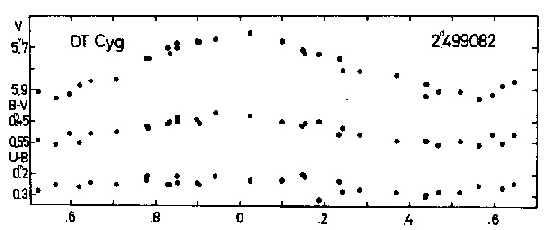 Figure 15 V, B-V and U-B curves of DT Cyg
Figure 15 V, B-V and U-B curves of DT Cyg
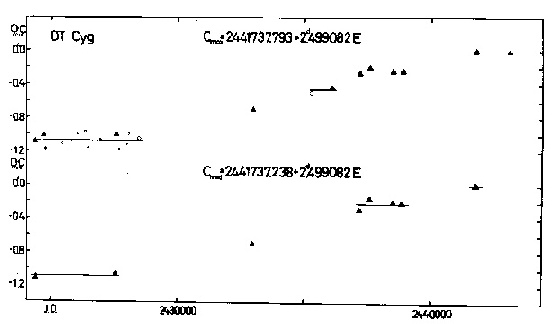 Figure 16 O-C diagram of DT Cyg
moments of maxima are submitted to phase shifts. The values of these shifts are 0.21d - 0.23d
or their multiple. This gradual period change is very interesting and it is intended to
continue observations on DT Cygni.
The O-C residuals given in Table 11 have been computed with the formulae:
C_{max} = 2441737.793 + 2.499082d*E ;
C_{med} = 2441737.238 + 2.499082d*E .
It is worthy of note that a change of -3 km/s in normal radial velocity occurred between
J.D. 2432000 and J.D. 2433000 (Evans 1968), i.e. during the time of a phase lag of the maximum.
BE Monocerotis
Its light and colour curves are shown in Fig. 17. The O-C residuals have been
computed with the formula:
C = 2441880.240 + 2.705510d*E .
These residuals are plotted in Fig. 18. The period of BE Mon is constant.
Figure 16 O-C diagram of DT Cyg
moments of maxima are submitted to phase shifts. The values of these shifts are 0.21d - 0.23d
or their multiple. This gradual period change is very interesting and it is intended to
continue observations on DT Cygni.
The O-C residuals given in Table 11 have been computed with the formulae:
C_{max} = 2441737.793 + 2.499082d*E ;
C_{med} = 2441737.238 + 2.499082d*E .
It is worthy of note that a change of -3 km/s in normal radial velocity occurred between
J.D. 2432000 and J.D. 2433000 (Evans 1968), i.e. during the time of a phase lag of the maximum.
BE Monocerotis
Its light and colour curves are shown in Fig. 17. The O-C residuals have been
computed with the formula:
C = 2441880.240 + 2.705510d*E .
These residuals are plotted in Fig. 18. The period of BE Mon is constant.
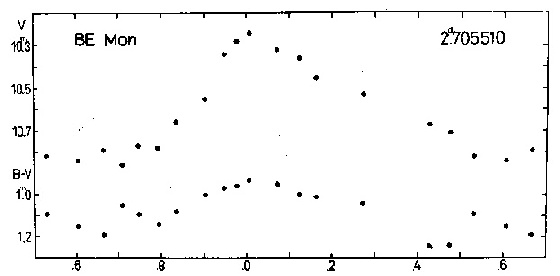 Figure 17 V and B-V curves of BE Mon
Figure 17 V and B-V curves of BE Mon
 Figure 18 O-C diagram of BE Mon
Table 12 O-C residuals for BE Mon
Obs.Max.J.D. E O-C Type w Source
2425506.624 -6052 +0.131d phg 0.5 Busch, Haussler (1963)
2425644.35 -6001 -0.12 phg 0.5 Ahnert^1 (1960)
2425974.73 -5879 -0.11 phg 0.5 Ahnert^1 (1960)
2426407.29 -5719 -0.14 phg 0.5 Ahnert^1 (1960)
2427124.38 -5454 -0.01 phg 0.5 Ahnert^1 (1960)
2427397.56 -5353 -0.08 phg 0.5 Ahnert^1 (1960)
2427516.83 -5309 +0.14 phg 0.5 Ahnert^2 (1960)
2427849.47 -5186 0.00 phg 0.5 Ahnert^3 (1960)
2427863.20 -5181 +0.21 vis 0.5 Kukarkin (1960)
2427892.751 -5170 -0.002 vis 1 Solov'yov (1952a)
2427914.34 -5162 -0.06 phg 0.5 Ahnert^2 (1960)
2428206.89 -5054 +0.30 phg 0 Ahnert^1 (1960)
Table 12 (cont.)
Obs.Max.J.D. E O-C Type w Source
2428260.667 -5034 -0.036 vis 1 Solov'yov (1952a)
2428547.40 -4928 -0.09 phg 0.5 Ahnert^1 (1960)
2429229.46 -4676 +0.18 phg 0.5 Ahnert^1 (1960)
2429313.305 -4645 +0.159 phg 0.5 Busch, Haussler (1963)
2429629.72 -4528 +0.03 phg 0.5 Ahnert^1 (1960)
2429667.572 -4514 +0.004 phg 1 Kapko (1963)
2429943.60 -4412 +0.07 phg 0.5 Ahnert^1 (1960)
2429989.503 -4395 -0.021 phg 1 Kapko (1963)
2430346.61 -4263 -0.04 phg 0.5 Ahnert^1 (1960)
2430698.52 -4133 +0.15 phg 0.5 Ahnert^1 (1960)
2430790.37 -4099 +0.02 phg 0.5 Ahnert^2 (1960)
2431050.14 -4003 +0.06 phg 0. Ahnert^3 (1960)
2431466.75 -3849 +0.02 phg 0. Ahnert^1 (1960)
2431986.169 -3657 -0.021 phg 1 Kapko (1963)
2432188.96 -3582 -0.14 phg 0.5 Ahnert^1 (1960)
2433306.47 -3169 -0.01 phg 0.5 Ahnert^2 (1960)
2433658.25 -3039 +0.05 phg 0.5 Ahnert^4 (1960)
2433934.10 -2937 -0.06 phg 0.5 Ahnert^5 (1960)
2434307.59 -2799 +0.07 phg 0.5 Ahnert^5 (1960)
2434778.38 -2625 +0.10 phg 0.5 Ahnert^5 (1960)
2435062.38 -2520 +0.03 phg 0.5 Ahnert^5 (1960)
2435143.551 -2490 +0.031 phg 1 Kapko (1963)
2435146.20 -2489 -0.03 phg 0.5 Ahnert^5 (1960)
2435395.06 -2397 -0.07 phg 0.5 Ahnert^2 (1960)
2435454.46 -2375 -0.19 phg 0.5 Ahnert (1960)
2435841.45 -2232 -0.09 phg 0.5 Ahnert^2 (1960)
2435860.367 -2225 -0.113 phg 0.5 Busch, Haussler (1963)
2436144.45 -2120 -0.11 phg 0.5 Ahnert^3 (1960)
2436612.62 -1947 +0.01 vis 1 Ahnert (1960)
2436615.44 -1946 +0.12 phg 0.5 Ahnert^1 (1960)
2436731.692 -1903 +0.038 phg 1 Kapko (1963)
2436899.56 -1841 +0.16 phg 0.5 Ahnert^2 (1960)
2436929.104 -1830 -0.053 phel 3 Detre, Chang (1960)
2437578.454 -1590 -0.025 phg 1 Ahnert (1963)
2438741.808 -1160 -0.040 phel 3 Buchancowa et al. (1972)
2441880.253 0 +0.013 phel 3 present paper
Remarks: 1 Observer: Busch;
2 Obs.: Lochel;
3 Obs.: Busch and Lochel;
4 Obs.: Busch and Gotz;
5 Obs.: Busch, Gotz and Lochel;
6 Obs.: Gotz and Lochel;
7 Obs.: Gotz.
V 465 Monocerotis
This star is a cepheid with small amplitude (see Fig. 19). The O-C residuals have
been calculated with the formula:
C = 2441698.687 + 2.713176d*E .
The O-C diagram plotted in Fig. 20 shows two period changes. Before J.D. 2432000 the value
of the period was uncertain; between J.D. 2432000 and J.D. 2441600 , P = 2.713668d ; after
J.D. 2441600 , P = 2.713176d.
Figure 18 O-C diagram of BE Mon
Table 12 O-C residuals for BE Mon
Obs.Max.J.D. E O-C Type w Source
2425506.624 -6052 +0.131d phg 0.5 Busch, Haussler (1963)
2425644.35 -6001 -0.12 phg 0.5 Ahnert^1 (1960)
2425974.73 -5879 -0.11 phg 0.5 Ahnert^1 (1960)
2426407.29 -5719 -0.14 phg 0.5 Ahnert^1 (1960)
2427124.38 -5454 -0.01 phg 0.5 Ahnert^1 (1960)
2427397.56 -5353 -0.08 phg 0.5 Ahnert^1 (1960)
2427516.83 -5309 +0.14 phg 0.5 Ahnert^2 (1960)
2427849.47 -5186 0.00 phg 0.5 Ahnert^3 (1960)
2427863.20 -5181 +0.21 vis 0.5 Kukarkin (1960)
2427892.751 -5170 -0.002 vis 1 Solov'yov (1952a)
2427914.34 -5162 -0.06 phg 0.5 Ahnert^2 (1960)
2428206.89 -5054 +0.30 phg 0 Ahnert^1 (1960)
Table 12 (cont.)
Obs.Max.J.D. E O-C Type w Source
2428260.667 -5034 -0.036 vis 1 Solov'yov (1952a)
2428547.40 -4928 -0.09 phg 0.5 Ahnert^1 (1960)
2429229.46 -4676 +0.18 phg 0.5 Ahnert^1 (1960)
2429313.305 -4645 +0.159 phg 0.5 Busch, Haussler (1963)
2429629.72 -4528 +0.03 phg 0.5 Ahnert^1 (1960)
2429667.572 -4514 +0.004 phg 1 Kapko (1963)
2429943.60 -4412 +0.07 phg 0.5 Ahnert^1 (1960)
2429989.503 -4395 -0.021 phg 1 Kapko (1963)
2430346.61 -4263 -0.04 phg 0.5 Ahnert^1 (1960)
2430698.52 -4133 +0.15 phg 0.5 Ahnert^1 (1960)
2430790.37 -4099 +0.02 phg 0.5 Ahnert^2 (1960)
2431050.14 -4003 +0.06 phg 0. Ahnert^3 (1960)
2431466.75 -3849 +0.02 phg 0. Ahnert^1 (1960)
2431986.169 -3657 -0.021 phg 1 Kapko (1963)
2432188.96 -3582 -0.14 phg 0.5 Ahnert^1 (1960)
2433306.47 -3169 -0.01 phg 0.5 Ahnert^2 (1960)
2433658.25 -3039 +0.05 phg 0.5 Ahnert^4 (1960)
2433934.10 -2937 -0.06 phg 0.5 Ahnert^5 (1960)
2434307.59 -2799 +0.07 phg 0.5 Ahnert^5 (1960)
2434778.38 -2625 +0.10 phg 0.5 Ahnert^5 (1960)
2435062.38 -2520 +0.03 phg 0.5 Ahnert^5 (1960)
2435143.551 -2490 +0.031 phg 1 Kapko (1963)
2435146.20 -2489 -0.03 phg 0.5 Ahnert^5 (1960)
2435395.06 -2397 -0.07 phg 0.5 Ahnert^2 (1960)
2435454.46 -2375 -0.19 phg 0.5 Ahnert (1960)
2435841.45 -2232 -0.09 phg 0.5 Ahnert^2 (1960)
2435860.367 -2225 -0.113 phg 0.5 Busch, Haussler (1963)
2436144.45 -2120 -0.11 phg 0.5 Ahnert^3 (1960)
2436612.62 -1947 +0.01 vis 1 Ahnert (1960)
2436615.44 -1946 +0.12 phg 0.5 Ahnert^1 (1960)
2436731.692 -1903 +0.038 phg 1 Kapko (1963)
2436899.56 -1841 +0.16 phg 0.5 Ahnert^2 (1960)
2436929.104 -1830 -0.053 phel 3 Detre, Chang (1960)
2437578.454 -1590 -0.025 phg 1 Ahnert (1963)
2438741.808 -1160 -0.040 phel 3 Buchancowa et al. (1972)
2441880.253 0 +0.013 phel 3 present paper
Remarks: 1 Observer: Busch;
2 Obs.: Lochel;
3 Obs.: Busch and Lochel;
4 Obs.: Busch and Gotz;
5 Obs.: Busch, Gotz and Lochel;
6 Obs.: Gotz and Lochel;
7 Obs.: Gotz.
V 465 Monocerotis
This star is a cepheid with small amplitude (see Fig. 19). The O-C residuals have
been calculated with the formula:
C = 2441698.687 + 2.713176d*E .
The O-C diagram plotted in Fig. 20 shows two period changes. Before J.D. 2432000 the value
of the period was uncertain; between J.D. 2432000 and J.D. 2441600 , P = 2.713668d ; after
J.D. 2441600 , P = 2.713176d.
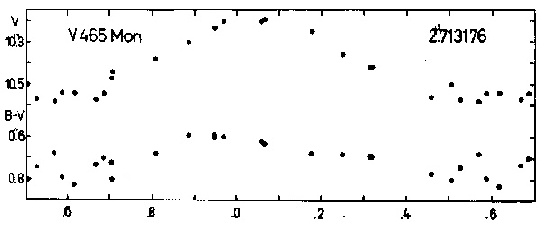 Figure 19 V and B-V curves of V 465 Mon
Figure 19 V and B-V curves of V 465 Mon
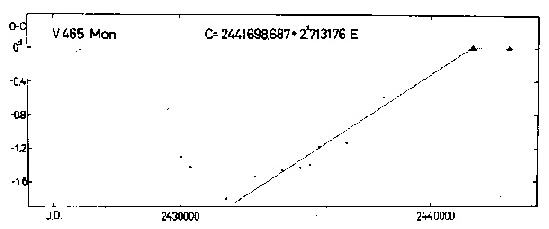 Figure 20 O-C diagram of V 465 Mon
Table 13 O-C residuals for V 465 Mon
Obs.Max.J.D. E O-C Type w Source
2430025.3 -4302 -1.3d phg 0.5 Wachmann (1964)
2430421.308 -4156 -1.420 phg 0.5 Satyvaldiev (1970)
2431845.3 -3631 -1.8 phg 0.5 Wachmann (1964)
2432968.864 -3217 -1.536 phg 0.5 Satyvaldiev (1970)
2434040.646 -2822 -1.458 phg 0.5 Satyvaldiev (1970)
2434773.23 -2552 -1.43 phg 0.5 Wachmann (1964)
2435169.4 -2406 -1.4 phg 0.5 Wachmann (1964)
2435541.315 -2269 -1.176 phg 0.5 Satyvaldiev (1970)
2436632.053 -1867 -1.134 phg 0.5 Satyvaldiev (1970)
2438067.872 -1338 -0.586 phg 0.5 Satyvaldiev (1970)
2441698.687 0 0.000 phel 3 present paper
2443166.515 +541 0.000 phel 2 present paper
BD +56—2806
Its variability was discovered by Fernie and Hube (1971); the first determination
of its period was published by Szabados (1976b). The bump after the minimum light mentioned
at the same
Figure 20 O-C diagram of V 465 Mon
Table 13 O-C residuals for V 465 Mon
Obs.Max.J.D. E O-C Type w Source
2430025.3 -4302 -1.3d phg 0.5 Wachmann (1964)
2430421.308 -4156 -1.420 phg 0.5 Satyvaldiev (1970)
2431845.3 -3631 -1.8 phg 0.5 Wachmann (1964)
2432968.864 -3217 -1.536 phg 0.5 Satyvaldiev (1970)
2434040.646 -2822 -1.458 phg 0.5 Satyvaldiev (1970)
2434773.23 -2552 -1.43 phg 0.5 Wachmann (1964)
2435169.4 -2406 -1.4 phg 0.5 Wachmann (1964)
2435541.315 -2269 -1.176 phg 0.5 Satyvaldiev (1970)
2436632.053 -1867 -1.134 phg 0.5 Satyvaldiev (1970)
2438067.872 -1338 -0.586 phg 0.5 Satyvaldiev (1970)
2441698.687 0 0.000 phel 3 present paper
2443166.515 +541 0.000 phel 2 present paper
BD +56—2806
Its variability was discovered by Fernie and Hube (1971); the first determination
of its period was published by Szabados (1976b). The bump after the minimum light mentioned
at the same
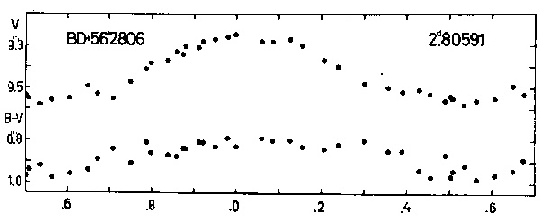 Figure 21 V and B-V curves of BD +56—2806
paper may be not real. The light curve of BD +56—2806 is presented in Fig. 21. The O-C
curve cannot be constructed for lack of earlier observations. The observations made by
Percy (1975) were used to improve the value of the period determined from the present
observations. The O-C residuals have been computed with the formula:
C = 2442676.397 + 2.80591d*E .
Table 14 O-C residuals for BD +56— 2806
Obs.Max.J.D. E O-C Type w Source
2442031.038 -230 0.000d phel 2 Percy (1975)
2442676.397 0 0.000 phel 3 present paper
DX Geminorum
This is a cepheid with small amplitude (see Fig. 22). The O-C residuals have been
computed with the formula:
C = 2441866.664 + 3.137486d*E .
Figure 21 V and B-V curves of BD +56—2806
paper may be not real. The light curve of BD +56—2806 is presented in Fig. 21. The O-C
curve cannot be constructed for lack of earlier observations. The observations made by
Percy (1975) were used to improve the value of the period determined from the present
observations. The O-C residuals have been computed with the formula:
C = 2442676.397 + 2.80591d*E .
Table 14 O-C residuals for BD +56— 2806
Obs.Max.J.D. E O-C Type w Source
2442031.038 -230 0.000d phel 2 Percy (1975)
2442676.397 0 0.000 phel 3 present paper
DX Geminorum
This is a cepheid with small amplitude (see Fig. 22). The O-C residuals have been
computed with the formula:
C = 2441866.664 + 3.137486d*E .
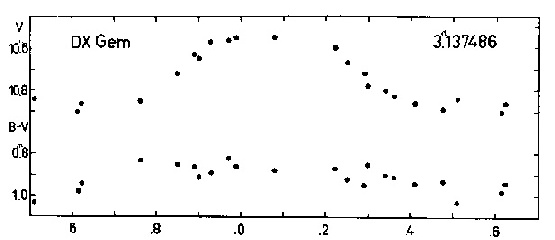 Figure 22 V and B-V curves of DX Gem
Figure 22 V and B-V curves of DX Gem
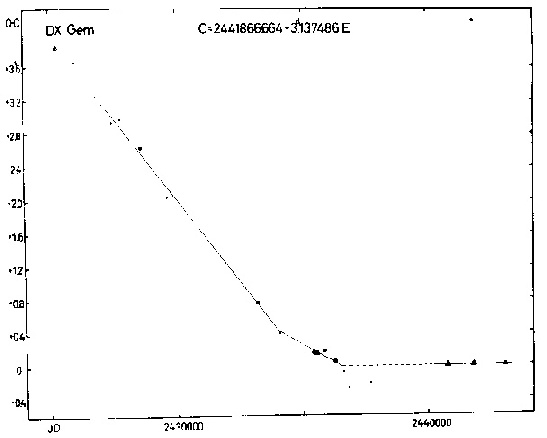 Figure 23 O-C diagram of DX Gem
Table 15 O-C residuals for DX Gem
Obs.Max.J.D. E O-C Type w Source
2425295.158 -5283 +3.833d phg 1 Bartkus et al. (1961)
2426038.579 -5046 +3.669 phg 0.5 Bartkus et al. (1961)
2427449.718 -4596 +2.940 phg 0.5 Bartkus et al. (1961)
2427782.331 -4490 +2.979 phg 0.5 Bartkus et al. (1961)
2428594.596 -4231 +2.635 phg 1 Meshkova (1940)
2429638.790 -3898 +2.046 phg 0.5 Teplitskaya (1950)
2433182.876 -2768 +0.773 phg 1 Satyvaldiev (1970)
2434067.275 -2486 +0.401 phg 0.5 Satyvaldiev (1970)
2435413.021 -2057 +0.166 phg 1 Satyvaldiev (1970)
2435554.199 -2012 +0.157 phel 1 Walraven et al. (1958)
2435896.212 -1903 +0.184 phg 1 Bartkus et al. (1961)
2436275.716 -1782 +0.052 phg 1 Bartkus et al. (1961)
2436623.856 -1671 -0.069 phg 0.5 Satyvaldiev (1970)
2436815.042 -1610 -0.270 phg 0.5 Bartkus et al. (1961)
2437687.330 -1332 -0.203 phg 0.5 Satyvaldiev (1970)
2438744.322 -995 -0.543 phg 0 Satyvaldiev (1970)
2440793.641 -342 -0.003 phel 3 Pel (1976)
2441866.668 0 +0.004 phel 3 present paper
2443165.579 +414 -0.004 phel 2 present paper
The O-C diagram (Fig. 23) shows two changes in the period. The first period change was also
suspected by Bartkus and Puchinskas (1961). The following values of the period are valid
for different time intervals:
before J.D. 2434000, P = 3.136226d ;
between J.D. 2434000 and J.D. 2436500, P = 3.136955d ;
after J.D. 2436500, P = 3.137486d .
SZ Tauri
According to Kukarkin et al. (1974) SZ Tau is a possible member of the cluster
NGC 1647. The phase relations of the colour curves (see Fig. 24) also support its
belonging to Population I. However, several authors classified SZ Tau as a Population II
variable (Walraven et al. 1958, Petit 1960, Mianes 1963, Kheilo 1969). According to Madore
(1977), SZ Tau has a blue photometric companion.
Figure 23 O-C diagram of DX Gem
Table 15 O-C residuals for DX Gem
Obs.Max.J.D. E O-C Type w Source
2425295.158 -5283 +3.833d phg 1 Bartkus et al. (1961)
2426038.579 -5046 +3.669 phg 0.5 Bartkus et al. (1961)
2427449.718 -4596 +2.940 phg 0.5 Bartkus et al. (1961)
2427782.331 -4490 +2.979 phg 0.5 Bartkus et al. (1961)
2428594.596 -4231 +2.635 phg 1 Meshkova (1940)
2429638.790 -3898 +2.046 phg 0.5 Teplitskaya (1950)
2433182.876 -2768 +0.773 phg 1 Satyvaldiev (1970)
2434067.275 -2486 +0.401 phg 0.5 Satyvaldiev (1970)
2435413.021 -2057 +0.166 phg 1 Satyvaldiev (1970)
2435554.199 -2012 +0.157 phel 1 Walraven et al. (1958)
2435896.212 -1903 +0.184 phg 1 Bartkus et al. (1961)
2436275.716 -1782 +0.052 phg 1 Bartkus et al. (1961)
2436623.856 -1671 -0.069 phg 0.5 Satyvaldiev (1970)
2436815.042 -1610 -0.270 phg 0.5 Bartkus et al. (1961)
2437687.330 -1332 -0.203 phg 0.5 Satyvaldiev (1970)
2438744.322 -995 -0.543 phg 0 Satyvaldiev (1970)
2440793.641 -342 -0.003 phel 3 Pel (1976)
2441866.668 0 +0.004 phel 3 present paper
2443165.579 +414 -0.004 phel 2 present paper
The O-C diagram (Fig. 23) shows two changes in the period. The first period change was also
suspected by Bartkus and Puchinskas (1961). The following values of the period are valid
for different time intervals:
before J.D. 2434000, P = 3.136226d ;
between J.D. 2434000 and J.D. 2436500, P = 3.136955d ;
after J.D. 2436500, P = 3.137486d .
SZ Tauri
According to Kukarkin et al. (1974) SZ Tau is a possible member of the cluster
NGC 1647. The phase relations of the colour curves (see Fig. 24) also support its
belonging to Population I. However, several authors classified SZ Tau as a Population II
variable (Walraven et al. 1958, Petit 1960, Mianes 1963, Kheilo 1969). According to Madore
(1977), SZ Tau has a blue photometric companion.
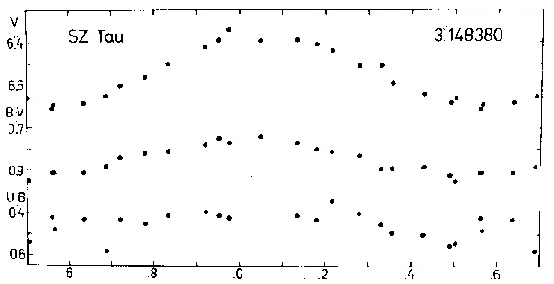 Figure 24 V, B-V and U-B curves of SZ Tau
The O-C residuals have been derived using the formula:
C = 2441659.194 + 3.14838d*E .
The O-C diagram (Fig. 25) shows three changes in the period of SZ Tauri:
before J.D. 2418500, P = 3.14839d ;
between J.D. 2418500 and J.D. 2425500, P = 3.149235d ;
between J.D. 2425500 and J.D. 2436300, P = 3.149057d ;
after J.D. 2436300, P = 3.148380d .
This O-C diagram shows an interesting phenomenon: at present the period of pulsation of
SZ Tau is nearly identical with the value of the period which was valid several decades
ago. Such a return
Figure 24 V, B-V and U-B curves of SZ Tau
The O-C residuals have been derived using the formula:
C = 2441659.194 + 3.14838d*E .
The O-C diagram (Fig. 25) shows three changes in the period of SZ Tauri:
before J.D. 2418500, P = 3.14839d ;
between J.D. 2418500 and J.D. 2425500, P = 3.149235d ;
between J.D. 2425500 and J.D. 2436300, P = 3.149057d ;
after J.D. 2436300, P = 3.148380d .
This O-C diagram shows an interesting phenomenon: at present the period of pulsation of
SZ Tau is nearly identical with the value of the period which was valid several decades
ago. Such a return
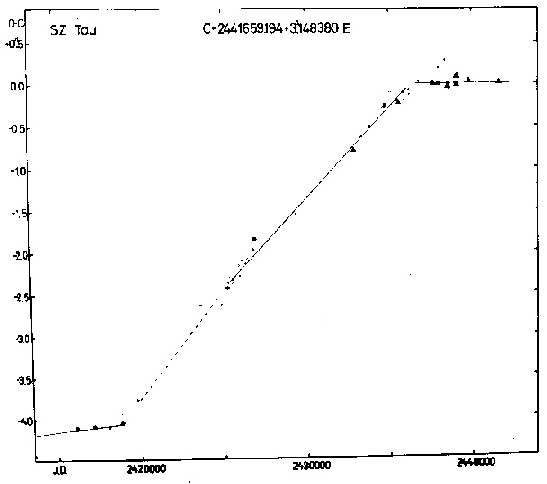 Figure 25 O-C diagram of SZ Tau
to an earlier period has been found for DT Cyg and other cepheids. A more detailed
discussion of this phenomenon will be given in the next section.
Table 16 O-C residuals for SZ Tau
Obs.Max.J.D. E O-C Type w Source
2413671.947 -8888 -4.446d phg 0.5 Pickering (1914)
2416118.575 -8111 -4.109 phg 1 Pickering (1914)
2417179.596 -7774 -4.092 phg 1 Pickering (1914)
2418086.326 -7486 -4.095 phg 0.5 Pickering (1914)
2418713.005 -7287 -3.944 vis 1 Schwarzschild (1911)
2418829.399 -7250 -4.040 phg 1 Pickering (1914)
2419267.519 -7111 -3.545 phg 0 Robinson (1930)
2419758.445 -6955 -3.766 phg 0.5 Pickering (1914)
2423619.49 -5729 -2.63 vis 0.5 Nielsen (1941)
2424878.851 -5329 -2.626 vis 0.5 Kukarkin (1940)
2425225.378 -5219 -2.421 phg 1 Hellerich (1935)
2425231.729 -5217 -2.367 vis 0.5 Kukarkin (1940)
2425301.067 -5195 -2.293 vis 0.5 Collmann (1930)
2425530.856 -5122 -2.336 vis 0.5 Kukarkin (1940)
Table 16 (cont.)
Obs.Max.J.D. E O-C Type w Source
2425587.492 -5104 -2.370d vis 0.5 Zverev (1936)
2425934.028 -4994 -2.156 vis 0.5 Zverev (1936)
2425959.093 -4986 -2.278 vis 0.5 Terkan (1935)
2426119.843 -4935 -2.096 vis 0.5 Kukarkin (1940)
2426324.450 -4870 -2.133 vis 0.5 Zverev (1936)
2426440.993 -4833 -2.080 vis 0.5 Terkan (1935)
2426705.583 -4749 -1.954 vis 0.5 Kukarkin (1940)
2426781.131 -4725 -1.967 vis 0.5 Zverev (1936)
2426894.594 -4689 -1.846 phg 1 Kox (1935)
2429363.229 -3905 -1.541 phg 0.5 Koshkina (1963)
2432852.379 -2797 -0.796 phel 2 Eggen (1951)
2432858.695 -2795 -0.777 phg 0.5 Satyvaldiev (1970)
2433283.87 -2660 -0.63 vis 0.5 Pohl^1 (1950)
2433819.217 -2490 -0.511 phg 0.5 Koshkina (1963)
2434628.57 -2233 -0.29 vis 0.5 Marks^2 (1959)
2434776.562 -2186 -0.267 phg 1 Satyvaldiev (1970)
2435082.12 -2089 -0.11 vis 0.5 Marks (1959)
2435478.719 -1963 -0.205 vis 0.5 Azarnova (1957)
2435541.659 -1943 -0.233 phel 1 Walraven et al. (1958)
2435840.877 -1848 -0.111 vis 0.5 Azarnova (1960)
2435878.569 -1836 -0.199 phg 0.5 Satyvaldiev (1970)
2436162.052 -1746 -0.071 vis 0.5 Latyshev (1969)
2436206.061 -1732 -0.139 vis 0.5 Azarnova (1960)
2436574.589 -1615 +0.029 vis 0.5 Azarnova (1960)
2436766.632 -1554 +0.021 phg 0.5 Satyvaldiev (1970)
2437619.809 -1283 -0.013 phel 3 Mitchell et al. (1964)
2437962.988 -1174 -0.008 phel 1 Williams (1966)
2437969.481 -1172 +0.188 phg 0.5 Satyvaldiev (1970)
2438378.857 -1042 +0.275 phg 0.5 Satyvaldiev (1970)
2438529.659 -994 -0.045 phel 3 Wisniewski et al. (1968)
2439055.461 -827 -0.023 phel 3 Milone (1970)
2439077.600 -820 +0.078 phel 3 Wamsteker (1972)
2439807.965 -588 +0.018 phel 3 present paper^3
2441659.204 0 +0.010 phel 3 present paper
Remarks: 1 Observer: Mielke;
2 Obs.: Wroblewski;
3 Obs.: Abaffy.
DQ Andromedae
This cepheid has not previously been observed photoelectrically. The presence of a
bump on the descending branch 0.3p after the maximum can be suspected on the first
photoelectric light curve (see Fig. 26). Classical cepheids with such a short period do
not show bumps on their light curves. Moreover, the galactic latitude of DQ And is -18—.
These two facts give reason to classify this cepheid as a Population II variable.
The O-C residuals have been computed with the formula:
C = 2441994.943 + 3.200557d*E .
DQ And has a constant period during 8000 cycles (see Fig. 27).
Figure 25 O-C diagram of SZ Tau
to an earlier period has been found for DT Cyg and other cepheids. A more detailed
discussion of this phenomenon will be given in the next section.
Table 16 O-C residuals for SZ Tau
Obs.Max.J.D. E O-C Type w Source
2413671.947 -8888 -4.446d phg 0.5 Pickering (1914)
2416118.575 -8111 -4.109 phg 1 Pickering (1914)
2417179.596 -7774 -4.092 phg 1 Pickering (1914)
2418086.326 -7486 -4.095 phg 0.5 Pickering (1914)
2418713.005 -7287 -3.944 vis 1 Schwarzschild (1911)
2418829.399 -7250 -4.040 phg 1 Pickering (1914)
2419267.519 -7111 -3.545 phg 0 Robinson (1930)
2419758.445 -6955 -3.766 phg 0.5 Pickering (1914)
2423619.49 -5729 -2.63 vis 0.5 Nielsen (1941)
2424878.851 -5329 -2.626 vis 0.5 Kukarkin (1940)
2425225.378 -5219 -2.421 phg 1 Hellerich (1935)
2425231.729 -5217 -2.367 vis 0.5 Kukarkin (1940)
2425301.067 -5195 -2.293 vis 0.5 Collmann (1930)
2425530.856 -5122 -2.336 vis 0.5 Kukarkin (1940)
Table 16 (cont.)
Obs.Max.J.D. E O-C Type w Source
2425587.492 -5104 -2.370d vis 0.5 Zverev (1936)
2425934.028 -4994 -2.156 vis 0.5 Zverev (1936)
2425959.093 -4986 -2.278 vis 0.5 Terkan (1935)
2426119.843 -4935 -2.096 vis 0.5 Kukarkin (1940)
2426324.450 -4870 -2.133 vis 0.5 Zverev (1936)
2426440.993 -4833 -2.080 vis 0.5 Terkan (1935)
2426705.583 -4749 -1.954 vis 0.5 Kukarkin (1940)
2426781.131 -4725 -1.967 vis 0.5 Zverev (1936)
2426894.594 -4689 -1.846 phg 1 Kox (1935)
2429363.229 -3905 -1.541 phg 0.5 Koshkina (1963)
2432852.379 -2797 -0.796 phel 2 Eggen (1951)
2432858.695 -2795 -0.777 phg 0.5 Satyvaldiev (1970)
2433283.87 -2660 -0.63 vis 0.5 Pohl^1 (1950)
2433819.217 -2490 -0.511 phg 0.5 Koshkina (1963)
2434628.57 -2233 -0.29 vis 0.5 Marks^2 (1959)
2434776.562 -2186 -0.267 phg 1 Satyvaldiev (1970)
2435082.12 -2089 -0.11 vis 0.5 Marks (1959)
2435478.719 -1963 -0.205 vis 0.5 Azarnova (1957)
2435541.659 -1943 -0.233 phel 1 Walraven et al. (1958)
2435840.877 -1848 -0.111 vis 0.5 Azarnova (1960)
2435878.569 -1836 -0.199 phg 0.5 Satyvaldiev (1970)
2436162.052 -1746 -0.071 vis 0.5 Latyshev (1969)
2436206.061 -1732 -0.139 vis 0.5 Azarnova (1960)
2436574.589 -1615 +0.029 vis 0.5 Azarnova (1960)
2436766.632 -1554 +0.021 phg 0.5 Satyvaldiev (1970)
2437619.809 -1283 -0.013 phel 3 Mitchell et al. (1964)
2437962.988 -1174 -0.008 phel 1 Williams (1966)
2437969.481 -1172 +0.188 phg 0.5 Satyvaldiev (1970)
2438378.857 -1042 +0.275 phg 0.5 Satyvaldiev (1970)
2438529.659 -994 -0.045 phel 3 Wisniewski et al. (1968)
2439055.461 -827 -0.023 phel 3 Milone (1970)
2439077.600 -820 +0.078 phel 3 Wamsteker (1972)
2439807.965 -588 +0.018 phel 3 present paper^3
2441659.204 0 +0.010 phel 3 present paper
Remarks: 1 Observer: Mielke;
2 Obs.: Wroblewski;
3 Obs.: Abaffy.
DQ Andromedae
This cepheid has not previously been observed photoelectrically. The presence of a
bump on the descending branch 0.3p after the maximum can be suspected on the first
photoelectric light curve (see Fig. 26). Classical cepheids with such a short period do
not show bumps on their light curves. Moreover, the galactic latitude of DQ And is -18—.
These two facts give reason to classify this cepheid as a Population II variable.
The O-C residuals have been computed with the formula:
C = 2441994.943 + 3.200557d*E .
DQ And has a constant period during 8000 cycles (see Fig. 27).
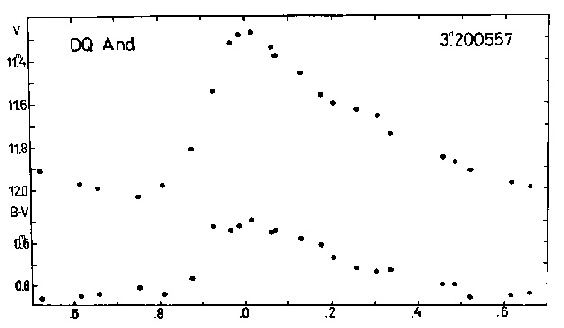 Figure 26 V and B-V curves of DQ And
Figure 26 V and B-V curves of DQ And
 Figure 27 O-C diagram of DQ And
Table 17 O-C residuals for DQ And
Obs.Max.J.D. E O-C Type w Source
2416038.600 -8110 +0.174d phg 0.5 Strohmeier et al. (1968)
2416438.681 -7985 +0.186 phg 0.5 Strohmeier et al. (1968)
2416761.865 -7884 +0.113 phg 0.5 Strohmeier et al. (1968)
2417104.340 -7777 +0.129 phg 0.5 Strohmeier et al. (1968)
2417910.609 -7525 -0.143 phg 0.5 Strohmeier et al. (1968)
2418214.807 -7430 +0.003 phg 0.5 Strohmeier et al. (1968)
2418691.542 -7281 -0.145 phg 0.5 Strohmeier et al. (1968)
2419053.468 -7168 +0.118 phg 0.5 Strohmeier et al. (1968)
2419306.261 -7089 +0.067 phg 0.5 Strohmeier et al. (1968)
2419987.914 -6876 +0.001 phg 0.5 Strohmeier et al. (1968)
2420468.147 -6726 +0.150 phg 0.5 Strohmeier et al. (1968)
2422257.255 -6167 +0.147 phg 0.5 Strohmeier et al. (1968)
2422666.599 -6039 -0.180 phg 0.5 Strohmeier et al. (1968)
2423044.580 -5921 +0.135 phg 0.5 Strohmeier et al. (1968)
2423322.750 -5834 -0.143 phg 0.5 Strohmeier et al. (1968)
Table 17 (cont.)
Obs.Max.J.D. E O-C Type w Source
2423758.055 -5698 -0.114 phg 0.5 Strohmeier et al. (1968)
2424788.747 -5376 -0.002 phg 0.5 Strohmeier et al. (1968)
2425825.770 -5052 +0.041 phg 0.5 Strohmeier et al. (1968)
2426651.375 -4794 -0.098 phg 0.5 Strohmeier et al. (1963)
2426654.712 -4793 +0.039 phg 0.5 Strohmeier et al. (1968)
2426987.516 -4689 -0.015 phg 0.5 Strohmeier et al. (1963)
2427397.279 -4561 +0.076 phg 0.5 Strohmeier et al. (1963)
2427665.853 -4477 -0.196 phg 0.5 Strohmeier et al. (1968)
2428043.819 -4359 +0.104 phg 0.5 Strohmeier et al. (1968)
2428069.427 -4351 +0.108 phg 0.5 Strohmeier et al. (1963)
2428408.537 -4245 -0.042 phg 0.5 Strohmeier et al. (1963)
2428818.289 -4117 +0.039 phg 0.5 Strohmeier et al. (1968)
2429240.546 -3985 -0.177 phg 0.5 Strohmeier et al. (1968)
2429567.324 -3883 +0.144 phg 0.5 Strohmeier et al. (1968)
2429912.686 -3775 -0.154 phg 0.5 Strohmeier et al. (1968)
2430641.964 -3547 -0.603 vis 0 Tsessevitsch (1957)
2431055.586 -3418 +0.147 phg 0.5 Strohmeier et al. (1968)
2431439.406 -3298 -0.100 phg 0.5 Strohmeier et al. (1968)
2432092.556 -3094 +0.136 phg 0.5 Strohmeier et al. (1963)
2433177.339 -2755 -0.069 phg 2 Satyvaldiev (1970)
2433183.656 -2753 -0.154 phg 0.5 Strohmeier et al. (1968)
2433532.810 -2644 +0.140 phg 0.5 Strohmeier et al. (1968)
2433865.814 -2540 +0.286 phg 0.5 Strohmeier et al. (1968)
2433926.387 -2521 +0.038 phg 0.5 Strohmeier et al. (1963)
2434252.475 -2419 -0.321 phg 0.5 Strohmeier et al. (1963)
2434707.274 -2277 -0.001 phg 0.5 Strohmeier et al. (1963)
2435766.931 -1946 +0.272 phg 0.5 Wenzel, Ziegler (1965)
2435779.332 -1942 -0.129 phg 0.5 Strohmeier et al. (1963)
2436320.362 -1773 +0.007 phg 2 Satyvaldiev (1970)
2436509.252 -1714 +0.064 phg 0.5 Wenzel, Ziegler (1965)
2436825.965 -1615 -0.078 phg 0.5 Wenzel, Ziegler (1965)
243T232.522 -1488 +0.008 phg 0.5 Wenzel, Ziegler (1965)
2437245.363 -1484 +0.047 phg 0.5 Strohmeier et al. (1963)
2437610.445 -1370 +0.265 phg 0.5 Wenzel, Ziegler (1965)
2437933.503 -1269 +0.067 phg 0.5 Wenzel, Ziegler (1965)
2438295.081 -1156 -0.018 phg 2 Satyvaldiev (1970)
2438295.102 -1156 +0.003 phg, 0.5 Wenzel, Ziegler (1965)
2438432.689 -1113 -0.034 phg 0.5 Wenzel, Ziegler (1965)
2441994.950 0 +0.007 phel 3 present paper
BY Cassiopeiae
BY Cas is a cepheid with small amplitude (see Fig. 28). Its period shows large
variations. As can be seen from Fig. 29, the period of BY Cas has had the following values: between J.D. 2417000 and J.D. 2426900 there was a change in the period, but both the time of the change and the value of the period in this interval are unknown;
between J.D. 2426900 and J.D. 2434300, P = 3.221297d ;
between J.D. 2434300 and J.D. 2439400, P = 3.222588d ;
after J.D. 2439400, P = 3.223316d .
Figure 27 O-C diagram of DQ And
Table 17 O-C residuals for DQ And
Obs.Max.J.D. E O-C Type w Source
2416038.600 -8110 +0.174d phg 0.5 Strohmeier et al. (1968)
2416438.681 -7985 +0.186 phg 0.5 Strohmeier et al. (1968)
2416761.865 -7884 +0.113 phg 0.5 Strohmeier et al. (1968)
2417104.340 -7777 +0.129 phg 0.5 Strohmeier et al. (1968)
2417910.609 -7525 -0.143 phg 0.5 Strohmeier et al. (1968)
2418214.807 -7430 +0.003 phg 0.5 Strohmeier et al. (1968)
2418691.542 -7281 -0.145 phg 0.5 Strohmeier et al. (1968)
2419053.468 -7168 +0.118 phg 0.5 Strohmeier et al. (1968)
2419306.261 -7089 +0.067 phg 0.5 Strohmeier et al. (1968)
2419987.914 -6876 +0.001 phg 0.5 Strohmeier et al. (1968)
2420468.147 -6726 +0.150 phg 0.5 Strohmeier et al. (1968)
2422257.255 -6167 +0.147 phg 0.5 Strohmeier et al. (1968)
2422666.599 -6039 -0.180 phg 0.5 Strohmeier et al. (1968)
2423044.580 -5921 +0.135 phg 0.5 Strohmeier et al. (1968)
2423322.750 -5834 -0.143 phg 0.5 Strohmeier et al. (1968)
Table 17 (cont.)
Obs.Max.J.D. E O-C Type w Source
2423758.055 -5698 -0.114 phg 0.5 Strohmeier et al. (1968)
2424788.747 -5376 -0.002 phg 0.5 Strohmeier et al. (1968)
2425825.770 -5052 +0.041 phg 0.5 Strohmeier et al. (1968)
2426651.375 -4794 -0.098 phg 0.5 Strohmeier et al. (1963)
2426654.712 -4793 +0.039 phg 0.5 Strohmeier et al. (1968)
2426987.516 -4689 -0.015 phg 0.5 Strohmeier et al. (1963)
2427397.279 -4561 +0.076 phg 0.5 Strohmeier et al. (1963)
2427665.853 -4477 -0.196 phg 0.5 Strohmeier et al. (1968)
2428043.819 -4359 +0.104 phg 0.5 Strohmeier et al. (1968)
2428069.427 -4351 +0.108 phg 0.5 Strohmeier et al. (1963)
2428408.537 -4245 -0.042 phg 0.5 Strohmeier et al. (1963)
2428818.289 -4117 +0.039 phg 0.5 Strohmeier et al. (1968)
2429240.546 -3985 -0.177 phg 0.5 Strohmeier et al. (1968)
2429567.324 -3883 +0.144 phg 0.5 Strohmeier et al. (1968)
2429912.686 -3775 -0.154 phg 0.5 Strohmeier et al. (1968)
2430641.964 -3547 -0.603 vis 0 Tsessevitsch (1957)
2431055.586 -3418 +0.147 phg 0.5 Strohmeier et al. (1968)
2431439.406 -3298 -0.100 phg 0.5 Strohmeier et al. (1968)
2432092.556 -3094 +0.136 phg 0.5 Strohmeier et al. (1963)
2433177.339 -2755 -0.069 phg 2 Satyvaldiev (1970)
2433183.656 -2753 -0.154 phg 0.5 Strohmeier et al. (1968)
2433532.810 -2644 +0.140 phg 0.5 Strohmeier et al. (1968)
2433865.814 -2540 +0.286 phg 0.5 Strohmeier et al. (1968)
2433926.387 -2521 +0.038 phg 0.5 Strohmeier et al. (1963)
2434252.475 -2419 -0.321 phg 0.5 Strohmeier et al. (1963)
2434707.274 -2277 -0.001 phg 0.5 Strohmeier et al. (1963)
2435766.931 -1946 +0.272 phg 0.5 Wenzel, Ziegler (1965)
2435779.332 -1942 -0.129 phg 0.5 Strohmeier et al. (1963)
2436320.362 -1773 +0.007 phg 2 Satyvaldiev (1970)
2436509.252 -1714 +0.064 phg 0.5 Wenzel, Ziegler (1965)
2436825.965 -1615 -0.078 phg 0.5 Wenzel, Ziegler (1965)
243T232.522 -1488 +0.008 phg 0.5 Wenzel, Ziegler (1965)
2437245.363 -1484 +0.047 phg 0.5 Strohmeier et al. (1963)
2437610.445 -1370 +0.265 phg 0.5 Wenzel, Ziegler (1965)
2437933.503 -1269 +0.067 phg 0.5 Wenzel, Ziegler (1965)
2438295.081 -1156 -0.018 phg 2 Satyvaldiev (1970)
2438295.102 -1156 +0.003 phg, 0.5 Wenzel, Ziegler (1965)
2438432.689 -1113 -0.034 phg 0.5 Wenzel, Ziegler (1965)
2441994.950 0 +0.007 phel 3 present paper
BY Cassiopeiae
BY Cas is a cepheid with small amplitude (see Fig. 28). Its period shows large
variations. As can be seen from Fig. 29, the period of BY Cas has had the following values: between J.D. 2417000 and J.D. 2426900 there was a change in the period, but both the time of the change and the value of the period in this interval are unknown;
between J.D. 2426900 and J.D. 2434300, P = 3.221297d ;
between J.D. 2434300 and J.D. 2439400, P = 3.222588d ;
after J.D. 2439400, P = 3.223316d .
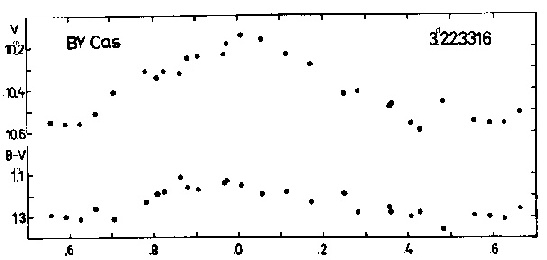 Figure 28 V and B-V curves of BY Cas
Figure 28 V and B-V curves of BY Cas
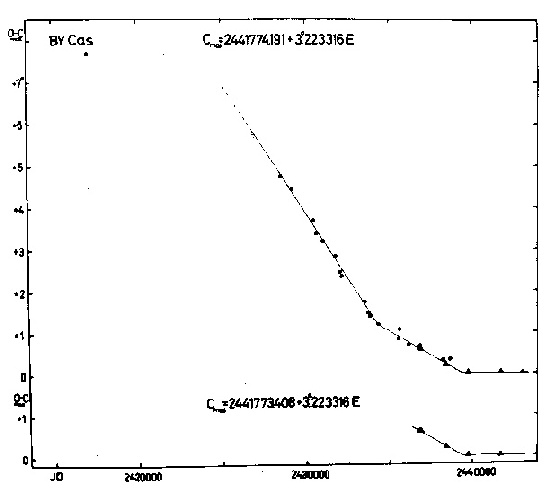 Figure 29 O-C diagram of BY Cas
The O-C residuals have been computed with the formulae:
C_{max} = 2441774.191 + 3.223316d*E ;
C_{med} = 2441773.408 + 3.223316d*E .
Table 18 O-C residuals for BY Cas
Obs.Max.J.D. Obs.Med.J.D. E O-C O-S Type w Source
max med
2417068.714 -7667 +7.687d phg 1 Kukarkina (1954a)
2426933.30 -4606 +5.70 vis 1 Lange (1933)
2428563.344 -4100 +4.749 phg 1 Parenago (1939b)
2429223.824 -3895 +4.449 phg 1 Kukarkina (1954a)
2430480.163 -3505 +3.695 phg 1 Satyvaldiev (1970)
2430650.693 -3452 +3.389 phg 1 Dirks, Vaucouleurs (1949)
2431014.735 -3339 +3.196 phg 1 Satyvaldiev (1970)
2431781.53 -3101 +2.84 phg 1 Ashbrook (1954)
2432048.696 -3018 +2.473 phg 1 Dirks, Vaucouleurs (1949)
2432132.390 -2992 +2.360 phg 1 Satyvaldiev (1970)
2433524.24 -2560 +1.74 phg 1 Satyvaldiev (1970)
2433736.708 -2494 +1.467 phg 1 Kukarkina (1954a)
2433878.46 -2450 +1.39 phg 1 Ashbrook (1954)
2434361.768 -2300 +1.204 phg 1 Kheilo (1962)
2435557.258 -1929 +0.844 phg 1 Kheilo (1962)
2435615.515 -1911 +1.081 phg 1 Satyvaldiev (1970)
2436143.784 -1747 +0.716 phg 1 Kheilo (1962)
2436820.545 2436819.781 -1537 +0.591 +0.610 phel 3 Oosterhoff (1960)
2436827.004 2436826.233 -1535 +0.603 +0.615 phel 3 Weaver et al. (1960)
2436843.175 -1530 +0.657 phg 1 Kheilo (1962)
2436910.801 2436910.027 -1509 +0.594 +0.603 phel 3 Bahner et al. (1962)
2438248.220 -1094 +0.337 phg 1 Satyvaldiev (1970)
2438409.256 2438408.479 -1044 +0.207 +0.213 phel 3 Malik (1965)
2438660.818 -966 +0.350 phg 1 Satyvaldiev (1970)
2439785.406 2439784.636 -617 +0.001 +0.014 phel 3 present paper^1
2441774.189 2441773.395 0 -0.002 -0.013 phel 3 present paper
2443079.635 +405 +0.001 phel 2 present paper
Remark: 1 Observer: Abaffy
V 532 Cygni
This small amplitude cepheid is suspected as having a blue photometric companion
(Madore 1977). Its light and colour curves and O-C diagram are shown in Figs. 30 and 31,
respectively. The
Figure 29 O-C diagram of BY Cas
The O-C residuals have been computed with the formulae:
C_{max} = 2441774.191 + 3.223316d*E ;
C_{med} = 2441773.408 + 3.223316d*E .
Table 18 O-C residuals for BY Cas
Obs.Max.J.D. Obs.Med.J.D. E O-C O-S Type w Source
max med
2417068.714 -7667 +7.687d phg 1 Kukarkina (1954a)
2426933.30 -4606 +5.70 vis 1 Lange (1933)
2428563.344 -4100 +4.749 phg 1 Parenago (1939b)
2429223.824 -3895 +4.449 phg 1 Kukarkina (1954a)
2430480.163 -3505 +3.695 phg 1 Satyvaldiev (1970)
2430650.693 -3452 +3.389 phg 1 Dirks, Vaucouleurs (1949)
2431014.735 -3339 +3.196 phg 1 Satyvaldiev (1970)
2431781.53 -3101 +2.84 phg 1 Ashbrook (1954)
2432048.696 -3018 +2.473 phg 1 Dirks, Vaucouleurs (1949)
2432132.390 -2992 +2.360 phg 1 Satyvaldiev (1970)
2433524.24 -2560 +1.74 phg 1 Satyvaldiev (1970)
2433736.708 -2494 +1.467 phg 1 Kukarkina (1954a)
2433878.46 -2450 +1.39 phg 1 Ashbrook (1954)
2434361.768 -2300 +1.204 phg 1 Kheilo (1962)
2435557.258 -1929 +0.844 phg 1 Kheilo (1962)
2435615.515 -1911 +1.081 phg 1 Satyvaldiev (1970)
2436143.784 -1747 +0.716 phg 1 Kheilo (1962)
2436820.545 2436819.781 -1537 +0.591 +0.610 phel 3 Oosterhoff (1960)
2436827.004 2436826.233 -1535 +0.603 +0.615 phel 3 Weaver et al. (1960)
2436843.175 -1530 +0.657 phg 1 Kheilo (1962)
2436910.801 2436910.027 -1509 +0.594 +0.603 phel 3 Bahner et al. (1962)
2438248.220 -1094 +0.337 phg 1 Satyvaldiev (1970)
2438409.256 2438408.479 -1044 +0.207 +0.213 phel 3 Malik (1965)
2438660.818 -966 +0.350 phg 1 Satyvaldiev (1970)
2439785.406 2439784.636 -617 +0.001 +0.014 phel 3 present paper^1
2441774.189 2441773.395 0 -0.002 -0.013 phel 3 present paper
2443079.635 +405 +0.001 phel 2 present paper
Remark: 1 Observer: Abaffy
V 532 Cygni
This small amplitude cepheid is suspected as having a blue photometric companion
(Madore 1977). Its light and colour curves and O-C diagram are shown in Figs. 30 and 31,
respectively. The
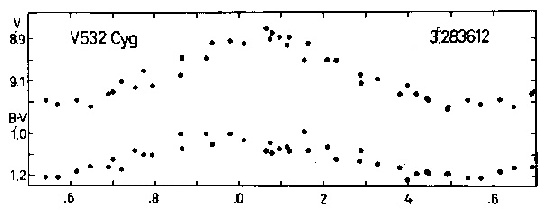 Figure 30 V and B-V curves of V 532 Cyg
Figure 30 V and B-V curves of V 532 Cyg
 Figure 31 O-C diagram of V 532 Cyg
O-C residuals have been calculated with the elements:
C = 2441706.559 + 3.283612d*E .
The following values of the period are valid in the different time intervals:
between J.D. 2428000 and J.D. 2435000, P = 3.283651d ;
between J.D. 2435000 and J.D. 2438700, P = 3.282792d ;
after J.D. 2438700, P = 3.283612d .
The structure of this O-C diagram resembles that of SZ Tauri, i.e. the period has
returned to its earlier value.
Table 19 O-C residuals for V 532 Cyg
Obs.Max.J.D. E O-C Type w Source
2428343.3 -4070 +1.0d phg 0.5 Ahnert (1949)
2428779.8 -3937 +0.8 phg 0.5 Ahnert (1949)
2428832.342 -3921 +0.826 phg 0.5 Ishchenko (1950)
Table 19 (cont.)
Obs.Max.J.D. E O-C Type w Source
2429058.993 -3852 +0.907d phg 0.5 Ishchenko (1950)
2429140.9 -3827 +0.7 phg 0.5 Ahnert (1949)
2429452.989 -3732 +0.870 phg 0.5 Ishchenko (1950)
2429571.2 -3696 +0.9 phg 0.5 Ahnert (1949)
2429860.182 -3608 +0.895 phg 0.5 Ishchenko (1950)
2429984.9 -3570 +0.8 phg 0.5 Ahnert (1949)
2430260.8 -3486 +0.9 phg 0.5 Ahnert (1949)
2430447.883 -3429 +0.830 phg 0.5 Filin (1951)
2430956.887 -3274 +0.874 phg 0.5 Filin (1951)
2431265.733 -3180 +1.060 phg 0.5 Filin (1951)
2431643.365 -3065 +1.077 phg 0.5 Filin (1951)
2431991.211 -2959 +0.860 phg 0.5 Filin (1951)
2432710.549 -2740 +1.087 phg 0.5 Filin (1951)
2433889.147 -2381 +0.868 phg 1 Shteiman (1958)
2434434.284 -2215 +0.926 phg 1 Shteiman (1958)
2435642.491 -18.47 +0.763 phg 1 Shteiman (1958)
2436092.219 -1710 +0.637 phg 0.5 Korovkina (1958)
2436443.59 -1603 +0.66 phg 0.5 Korovkina (1959)
2436817.703 -1489 +0.442 phel 3 Oosterhoff (1960)
2438229.332 -1059 +0.118 phel 3 Kwee and Braun (1967)
2441706.559 0 0.000 phel 3 present paper
2443026.571 +402 0.000 phel 2 present paper
V 1334 Cygni
This cepheid is a component of a visual binary (Millis 1969). The nonvariable
component of this binary system reduces the observable amplitude of the cepheid. Figure 32
shows that the light and colour amplitudes of V 1334 Cyg are extremely low for a cepheid
variable. The O-C residuals have been computed with the formula:
C = 2441760.900 + 3.333020d*E
These residuals are not plotted in a diagram.
Figure 31 O-C diagram of V 532 Cyg
O-C residuals have been calculated with the elements:
C = 2441706.559 + 3.283612d*E .
The following values of the period are valid in the different time intervals:
between J.D. 2428000 and J.D. 2435000, P = 3.283651d ;
between J.D. 2435000 and J.D. 2438700, P = 3.282792d ;
after J.D. 2438700, P = 3.283612d .
The structure of this O-C diagram resembles that of SZ Tauri, i.e. the period has
returned to its earlier value.
Table 19 O-C residuals for V 532 Cyg
Obs.Max.J.D. E O-C Type w Source
2428343.3 -4070 +1.0d phg 0.5 Ahnert (1949)
2428779.8 -3937 +0.8 phg 0.5 Ahnert (1949)
2428832.342 -3921 +0.826 phg 0.5 Ishchenko (1950)
Table 19 (cont.)
Obs.Max.J.D. E O-C Type w Source
2429058.993 -3852 +0.907d phg 0.5 Ishchenko (1950)
2429140.9 -3827 +0.7 phg 0.5 Ahnert (1949)
2429452.989 -3732 +0.870 phg 0.5 Ishchenko (1950)
2429571.2 -3696 +0.9 phg 0.5 Ahnert (1949)
2429860.182 -3608 +0.895 phg 0.5 Ishchenko (1950)
2429984.9 -3570 +0.8 phg 0.5 Ahnert (1949)
2430260.8 -3486 +0.9 phg 0.5 Ahnert (1949)
2430447.883 -3429 +0.830 phg 0.5 Filin (1951)
2430956.887 -3274 +0.874 phg 0.5 Filin (1951)
2431265.733 -3180 +1.060 phg 0.5 Filin (1951)
2431643.365 -3065 +1.077 phg 0.5 Filin (1951)
2431991.211 -2959 +0.860 phg 0.5 Filin (1951)
2432710.549 -2740 +1.087 phg 0.5 Filin (1951)
2433889.147 -2381 +0.868 phg 1 Shteiman (1958)
2434434.284 -2215 +0.926 phg 1 Shteiman (1958)
2435642.491 -18.47 +0.763 phg 1 Shteiman (1958)
2436092.219 -1710 +0.637 phg 0.5 Korovkina (1958)
2436443.59 -1603 +0.66 phg 0.5 Korovkina (1959)
2436817.703 -1489 +0.442 phel 3 Oosterhoff (1960)
2438229.332 -1059 +0.118 phel 3 Kwee and Braun (1967)
2441706.559 0 0.000 phel 3 present paper
2443026.571 +402 0.000 phel 2 present paper
V 1334 Cygni
This cepheid is a component of a visual binary (Millis 1969). The nonvariable
component of this binary system reduces the observable amplitude of the cepheid. Figure 32
shows that the light and colour amplitudes of V 1334 Cyg are extremely low for a cepheid
variable. The O-C residuals have been computed with the formula:
C = 2441760.900 + 3.333020d*E
These residuals are not plotted in a diagram.
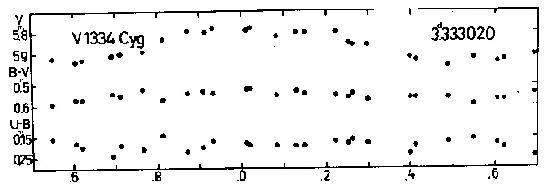 Figure 32 V, B-V and U-B curves of V 1334 Cyg
Table 20 O-C residuals for V 1334 Cyg
Obs.Max.J.D. E O-C Type w Source
2440117.721 -493 0.000d phel 3 Millis (1969)
2441760.900 0 0.000 phel 3 present paper
BD Cassiopeiae
BD Cas is a cepheid with small amplitude. There is a bump on its light curve just
after the minimum (see Fig. 33). Therefore it has been classified as a Population II
variable.
Figure 32 V, B-V and U-B curves of V 1334 Cyg
Table 20 O-C residuals for V 1334 Cyg
Obs.Max.J.D. E O-C Type w Source
2440117.721 -493 0.000d phel 3 Millis (1969)
2441760.900 0 0.000 phel 3 present paper
BD Cassiopeiae
BD Cas is a cepheid with small amplitude. There is a bump on its light curve just
after the minimum (see Fig. 33). Therefore it has been classified as a Population II
variable.
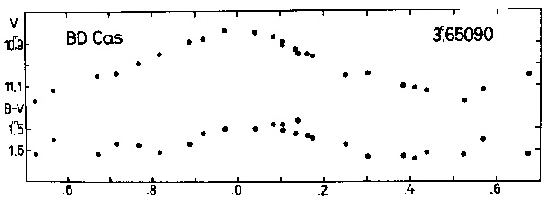 Figure 33 V and B-V curves of BD Cas
Figure 33 V and B-V curves of BD Cas
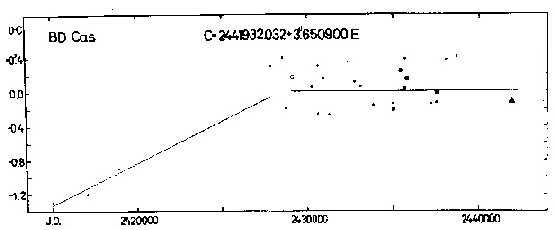 Figure 34 O-C diagram of BD Cas
The O-C residuals have been calculated with the formula:
C = 2441932.032 + 3.650900d*E .
The O-C curve (Fig. 34) consists of two straight lines. The values of the period are as
follows:
before J.D. 2429000, P = 3.65126 ;
after J .D. 2429000, P = 3.650900 .
Table 21 O-C residuals for BD Cas
Obs.Max.J.D. E O-C Type w Source
2415038.2 -7366 -1.3d phg 0.5 Parenago (1947)
2417064.6 -6811 -1.2 phg 0.5 Parenago (1947)
2418926.8 -6301 -0.9 phg 0.5 Parenago (1947)
2427883.7 -3848 +0.3 phg 0.5 Parenago (1947)
2428573.8 -3659 +0.4 phg 0.5 Parenago (1947)
2428759.4 -3608 -0.2 vis 0.5 Zverev (1938)
2429124.84 -3508 +0.17 vis 1 Zverev (1938)
2429285.3 -3464 0.0 phg 0.5 Parenago (1947)
2429548.2 -3392 0.0 phg 0.5 Parenago (1947)
2430260.16 -3197 +0.06 phg 0.5 Vasil'yan. et al. (1970)
2430614.5 -3100 +0.3 phg 0.5 Parenago (1947)
2430643.19 -3092 -0.26 phg 0.5 Vasil'yan. et al. (1970)
2430939.33 -3011 +0.16 phg 0.5 Vasil'yan. et al. (1970)
2431300.34 -2912 -0.27 phg 0.5 Vasil'yan. et al. (1970)
2432768.38 -2510 +0.11 phg 0.5 Vasil'yan. et al. (1970)
2433118.82 -2414 +0.06 phg 0.5 Vasil'yan. et al. (1970)
2433863.38 -2210 -0.16 phg 0.5 Vasil'yan. et al. (1970)
2434962.32 -1909 -0.14 phg 0.5 Vasil'yan. et al. (1970)
2435042.57 -1887 -0.21 phg 1 Romano (1959)
2435430.02 -1781 +0.24 phg 1 Romano (1959)
2435670.77 -1715 +0.03 phg 1 Romano (1959)
2435700.33 -1707 +0.38 phg 0.5 Vasil'yan. et al. (1970)
2435835.18 -1670 +0.15 phg 1 Zonn, Semeniuk (1959)
2437211.28 -1293 -0.14 phg 0.5 Vasil'yan. et al. (1970)
2437525.27 -1207 -0.13 phg 0.5 Vasil'yan. et al. (1970)
2437572.843 -1194 -0.014 phel 1 Mitchell et al. (1964)
2438055.15 -1062 +0.37 phg 0.5 Vasil'yan. et al. (1970)
2438650.28 -899 +0.41 phg 0.5 Vasil'yan. et al. (1970)
2441931.916 0 -0.116 phel 3 present paper
RT Aurigae
Very many photoelectric observational series have been carried out on this star.
The sets of photoelectric observations made in the UBV system do not verify the statement
of the 3rd Supplement to the GCVS (Kukarkin et al. 1976), according to which the amplitude
in V varies between 0.73m and 0.85m . As Table 22 shows, A_V varies between 0.76m and 0.83m,
whereas A_B between 1.10m and 1.19m. However, these amplitude variations are not real. The
light curves with extreme values of the amplitude are rather uncertain around the maximum.
For example, the maximum amplitude is based upon a single observation of the light curve
observed by Winzer (1973). The well observed light curves (Wisniewski and Johnson 1968,
and the present paper) have almost the same values for the amplitudes. Moreover, the
variation in the amplitudes does not show any systematic trend.
Table 23 O-C residuals for RT Aur
Obs.Max.J.D. Obs.Med.J.D. E O-C O-C Type w Source
max med
2414000.60 -7436 -0.25d vis 1 Muller, Kempf (1899)
2416938.466 -6648 -0.202 vis. 0.5 Astbury (1905)
2416942.3 -6647 -0.1 vis 0.5 Williams (1905a)
2417643.048 -6459 -0.248 vis 0.5 Zeipel (1908)
2417788.484 2417788.100 -6420 -0.211 -0.167 vis 1 Wendell (1913)
2417889.20 -6393 -0.16 vis 1 Kukarkin^1 (1931a)
2418015.92 -6359 -0.19 vis 1 Kukarkin^1 (1931a)
2418344.03 -6271 -0.17 vis 1 Kukarkin^1 (1931a)
2418739.18 -6165 -0.20 vis 1 Kukarkin^1 (1931a)
2418921.974 -6116 -0.091 phg 0.5 Robinson (1930)
2419044.99 -6083 -0.105 vis 0.5 Kukarkin^1 (1931a)
2419421.48 -5982 -0.16 vis 1 Hornig (1915)
2419451.27 -5974 -0.20 vis 1 Kukarkin^1 (1931a)
2419689.908 2419689.502 -5910 -0.164 -0.142 vis 1 Lacchini (1921)
2419813.015 2419812.627 -5877 -0.087 -0.047 vis 0.5 Nijland (1923)
2419824.13 -5874 -0.16 vis 1 Kukarkin^1 (1931a)
2419902.26 -5853 -0.32 vis 0.5 Kaiser (1922)
2420129.921 2420129.425 -5792 -0.078 -0.146 vis 1 Nijland (1923)
2420133.623 -5791 -0.104 vis 0.5 Hoffmeister (1915)
2420375.871 2420375.528 -5726 -0.188 -0.103 phg 2 Kiess (1915)
2420495.43 -5694 +0.07 vis 0 Kukarkin^1 (1931a)
2420502.691 2420502.266 -5692 -0.127 -0.124 vis 1 Nijland (1923)
2420972.434 2420972.042 -5566 -0.135 -0.100 vis 1 Nijland (1923)
2420991.000 2420990.680 -5561 -0.210 -0.102 vis 1 Luyten (1922)
2421475.879 2421475.417 -5431 +0.004 -0.030 vis 0.5 Lacchini (1921)
2421565.231 2421564.925 -5407 -0.121 +0.001 vis 1 Luyten (1922)
2422728.38 -5095 -0.17 vis 0.5 Viaro (1921)
2422739.73 -5092 0.00 vis 0.5 Kukarkin^2 (1931a)
2423112.38 -4992 -0.17 vis 0.5 Kukarkin^1 (1931a)
2423239.209 -4958 -0.100 vis 0.5 Stromgren^3 (1928)
2423272.767 2423272.331 -4949 -0.096 -0.104 vis 1 Hellerich (1934)
2423351.18 -4928 +0.03 vis 1 Kukarkin^4 (1931a)
2423791.110 -4810 +0.029 vis 0.5 Hopmann (1926b)
2423999.770 2423999.360 -4754 -0.090 -0.072 vis 1 Hellerich (1934)
Table 23 (cont.)
Obs.Max.J.D. Obs.Med.J.D. E O-C O-C Type w Source
max med
2424361.434 2424360.957 -4657 -0.060d -0.109d phg 1 Kowalczewsky (1931)
2424741.657 2424741.243 -4555 -0.113 -0.099 vis 1 Kukarkin (1940)
2425155.509 2425155.114 -4444 -0.090 -0.057 phg 2 Hellerich (1935)
2425293.462 2425293.000 -4407 -0.080 -0.114 vis 1 Kukarkin (1940)
2425535.844 2425535.475 -4342 -0.030 +0.029 vis 1 Zverev (1936)
2425744.619 2425744.198 -4286 -0.034 -0.027 vis 1 Kukarkin^5 (1940)
2425990.618 -4220 -0.095 vis 0.5 Kukarkin (1934)
2426232.946 2426232.551 -4155 -0.100 -0.067 vis 1 Zverev (1936)
2426400.773 -4110 -0.041 vis 1 Mergentaler (1941)
2426467.859 -4092 -0.063 vis 1 Nielsen (1939)
2426475.364 -4090 -0.014 vis 1 Kowalczewsky^6 (1931)
2426520.023 2426519.542 -4078 -0.093 -0.146 vis 0.5 Kukarkin (1940)
2426587.221 2426586.818 -4060 -0.004 +0.022 vis 1 Dufay (1947b)
2426911.538 2426911.169 -3973 -0.038 +0.021 phg 2 Grouillier (1947)
2427325.424 2427325.017 -3862 +0.019 +0.040 vis 1 Dufay (1947b)
2427452.125 2427451.752 -3828 -0.039 +0.016 phg 2 Grouillier (1947)
2427687.013 2427686.633 -3765 -0.027 +0.021 vis 1 Krebs (1937b)
2428358.074 2428357.686 -3585 -0.040 0.000 vis 1 Krebs (1937b)
2429070.198 2429069.769 -3394 0.000 -0.001 phg 2 Opolski (1948)
2429267.393 -3341 +0.029 phel 3 Bennett (1941)
2429603.272 -3251 -0.057 phel 3 Bennett (1941)
2433141.392 2433140.952 -2302 +0.010 -0.002 phel 3 Eggen et al. (1957)
2434539.42 -1927 -0.03 vis 0.5 Marks^7 (1959)
2435057.79 -1788 +0.12 vis 0.5 Marks (1959)
2435799.601 2435799.198 -1589 +0.020 +0.045 phel 3 Prokof'eva (1961)
2437339.350 -1176 +0.026 phel 3 Mitchell et al. (1964)
2437872.454 -1033 -0.001 vis 0.5 Tsai (1972)
2437995.423 -1000 -0.062 phel 2 Williams (1966)
2438920.047 2438919.618 -752 -0.029 -0.030 phel 3 Wisniewski, Johnson (1968)
2439359.960 2439359.505 -634 -0.043 -0.070 phel 3 Takase (1969)
2441429.115 2441428.757 -79 -0.033 +0.037 phel 3 Winzer (1973)
2441723.711 2441723.282 0 +0.036 +0.035 phel 3 present paper
2441761.14 +10 +0.18 vis 0.5 Small (1973)
Remarks: 1 Observer: Sharbe; 2 Obs.: Tsarevsky, Tsessevitsch, Selivanov; 3 Obs.: Johansen;
4 Obs.: Tsessevitsch; 5 Obs.: Zverev; 6 Obs.: Dziewulski, Iwanowska; 7 Obs.: Wroblewski.
Figure 34 O-C diagram of BD Cas
The O-C residuals have been calculated with the formula:
C = 2441932.032 + 3.650900d*E .
The O-C curve (Fig. 34) consists of two straight lines. The values of the period are as
follows:
before J.D. 2429000, P = 3.65126 ;
after J .D. 2429000, P = 3.650900 .
Table 21 O-C residuals for BD Cas
Obs.Max.J.D. E O-C Type w Source
2415038.2 -7366 -1.3d phg 0.5 Parenago (1947)
2417064.6 -6811 -1.2 phg 0.5 Parenago (1947)
2418926.8 -6301 -0.9 phg 0.5 Parenago (1947)
2427883.7 -3848 +0.3 phg 0.5 Parenago (1947)
2428573.8 -3659 +0.4 phg 0.5 Parenago (1947)
2428759.4 -3608 -0.2 vis 0.5 Zverev (1938)
2429124.84 -3508 +0.17 vis 1 Zverev (1938)
2429285.3 -3464 0.0 phg 0.5 Parenago (1947)
2429548.2 -3392 0.0 phg 0.5 Parenago (1947)
2430260.16 -3197 +0.06 phg 0.5 Vasil'yan. et al. (1970)
2430614.5 -3100 +0.3 phg 0.5 Parenago (1947)
2430643.19 -3092 -0.26 phg 0.5 Vasil'yan. et al. (1970)
2430939.33 -3011 +0.16 phg 0.5 Vasil'yan. et al. (1970)
2431300.34 -2912 -0.27 phg 0.5 Vasil'yan. et al. (1970)
2432768.38 -2510 +0.11 phg 0.5 Vasil'yan. et al. (1970)
2433118.82 -2414 +0.06 phg 0.5 Vasil'yan. et al. (1970)
2433863.38 -2210 -0.16 phg 0.5 Vasil'yan. et al. (1970)
2434962.32 -1909 -0.14 phg 0.5 Vasil'yan. et al. (1970)
2435042.57 -1887 -0.21 phg 1 Romano (1959)
2435430.02 -1781 +0.24 phg 1 Romano (1959)
2435670.77 -1715 +0.03 phg 1 Romano (1959)
2435700.33 -1707 +0.38 phg 0.5 Vasil'yan. et al. (1970)
2435835.18 -1670 +0.15 phg 1 Zonn, Semeniuk (1959)
2437211.28 -1293 -0.14 phg 0.5 Vasil'yan. et al. (1970)
2437525.27 -1207 -0.13 phg 0.5 Vasil'yan. et al. (1970)
2437572.843 -1194 -0.014 phel 1 Mitchell et al. (1964)
2438055.15 -1062 +0.37 phg 0.5 Vasil'yan. et al. (1970)
2438650.28 -899 +0.41 phg 0.5 Vasil'yan. et al. (1970)
2441931.916 0 -0.116 phel 3 present paper
RT Aurigae
Very many photoelectric observational series have been carried out on this star.
The sets of photoelectric observations made in the UBV system do not verify the statement
of the 3rd Supplement to the GCVS (Kukarkin et al. 1976), according to which the amplitude
in V varies between 0.73m and 0.85m . As Table 22 shows, A_V varies between 0.76m and 0.83m,
whereas A_B between 1.10m and 1.19m. However, these amplitude variations are not real. The
light curves with extreme values of the amplitude are rather uncertain around the maximum.
For example, the maximum amplitude is based upon a single observation of the light curve
observed by Winzer (1973). The well observed light curves (Wisniewski and Johnson 1968,
and the present paper) have almost the same values for the amplitudes. Moreover, the
variation in the amplitudes does not show any systematic trend.
Table 23 O-C residuals for RT Aur
Obs.Max.J.D. Obs.Med.J.D. E O-C O-C Type w Source
max med
2414000.60 -7436 -0.25d vis 1 Muller, Kempf (1899)
2416938.466 -6648 -0.202 vis. 0.5 Astbury (1905)
2416942.3 -6647 -0.1 vis 0.5 Williams (1905a)
2417643.048 -6459 -0.248 vis 0.5 Zeipel (1908)
2417788.484 2417788.100 -6420 -0.211 -0.167 vis 1 Wendell (1913)
2417889.20 -6393 -0.16 vis 1 Kukarkin^1 (1931a)
2418015.92 -6359 -0.19 vis 1 Kukarkin^1 (1931a)
2418344.03 -6271 -0.17 vis 1 Kukarkin^1 (1931a)
2418739.18 -6165 -0.20 vis 1 Kukarkin^1 (1931a)
2418921.974 -6116 -0.091 phg 0.5 Robinson (1930)
2419044.99 -6083 -0.105 vis 0.5 Kukarkin^1 (1931a)
2419421.48 -5982 -0.16 vis 1 Hornig (1915)
2419451.27 -5974 -0.20 vis 1 Kukarkin^1 (1931a)
2419689.908 2419689.502 -5910 -0.164 -0.142 vis 1 Lacchini (1921)
2419813.015 2419812.627 -5877 -0.087 -0.047 vis 0.5 Nijland (1923)
2419824.13 -5874 -0.16 vis 1 Kukarkin^1 (1931a)
2419902.26 -5853 -0.32 vis 0.5 Kaiser (1922)
2420129.921 2420129.425 -5792 -0.078 -0.146 vis 1 Nijland (1923)
2420133.623 -5791 -0.104 vis 0.5 Hoffmeister (1915)
2420375.871 2420375.528 -5726 -0.188 -0.103 phg 2 Kiess (1915)
2420495.43 -5694 +0.07 vis 0 Kukarkin^1 (1931a)
2420502.691 2420502.266 -5692 -0.127 -0.124 vis 1 Nijland (1923)
2420972.434 2420972.042 -5566 -0.135 -0.100 vis 1 Nijland (1923)
2420991.000 2420990.680 -5561 -0.210 -0.102 vis 1 Luyten (1922)
2421475.879 2421475.417 -5431 +0.004 -0.030 vis 0.5 Lacchini (1921)
2421565.231 2421564.925 -5407 -0.121 +0.001 vis 1 Luyten (1922)
2422728.38 -5095 -0.17 vis 0.5 Viaro (1921)
2422739.73 -5092 0.00 vis 0.5 Kukarkin^2 (1931a)
2423112.38 -4992 -0.17 vis 0.5 Kukarkin^1 (1931a)
2423239.209 -4958 -0.100 vis 0.5 Stromgren^3 (1928)
2423272.767 2423272.331 -4949 -0.096 -0.104 vis 1 Hellerich (1934)
2423351.18 -4928 +0.03 vis 1 Kukarkin^4 (1931a)
2423791.110 -4810 +0.029 vis 0.5 Hopmann (1926b)
2423999.770 2423999.360 -4754 -0.090 -0.072 vis 1 Hellerich (1934)
Table 23 (cont.)
Obs.Max.J.D. Obs.Med.J.D. E O-C O-C Type w Source
max med
2424361.434 2424360.957 -4657 -0.060d -0.109d phg 1 Kowalczewsky (1931)
2424741.657 2424741.243 -4555 -0.113 -0.099 vis 1 Kukarkin (1940)
2425155.509 2425155.114 -4444 -0.090 -0.057 phg 2 Hellerich (1935)
2425293.462 2425293.000 -4407 -0.080 -0.114 vis 1 Kukarkin (1940)
2425535.844 2425535.475 -4342 -0.030 +0.029 vis 1 Zverev (1936)
2425744.619 2425744.198 -4286 -0.034 -0.027 vis 1 Kukarkin^5 (1940)
2425990.618 -4220 -0.095 vis 0.5 Kukarkin (1934)
2426232.946 2426232.551 -4155 -0.100 -0.067 vis 1 Zverev (1936)
2426400.773 -4110 -0.041 vis 1 Mergentaler (1941)
2426467.859 -4092 -0.063 vis 1 Nielsen (1939)
2426475.364 -4090 -0.014 vis 1 Kowalczewsky^6 (1931)
2426520.023 2426519.542 -4078 -0.093 -0.146 vis 0.5 Kukarkin (1940)
2426587.221 2426586.818 -4060 -0.004 +0.022 vis 1 Dufay (1947b)
2426911.538 2426911.169 -3973 -0.038 +0.021 phg 2 Grouillier (1947)
2427325.424 2427325.017 -3862 +0.019 +0.040 vis 1 Dufay (1947b)
2427452.125 2427451.752 -3828 -0.039 +0.016 phg 2 Grouillier (1947)
2427687.013 2427686.633 -3765 -0.027 +0.021 vis 1 Krebs (1937b)
2428358.074 2428357.686 -3585 -0.040 0.000 vis 1 Krebs (1937b)
2429070.198 2429069.769 -3394 0.000 -0.001 phg 2 Opolski (1948)
2429267.393 -3341 +0.029 phel 3 Bennett (1941)
2429603.272 -3251 -0.057 phel 3 Bennett (1941)
2433141.392 2433140.952 -2302 +0.010 -0.002 phel 3 Eggen et al. (1957)
2434539.42 -1927 -0.03 vis 0.5 Marks^7 (1959)
2435057.79 -1788 +0.12 vis 0.5 Marks (1959)
2435799.601 2435799.198 -1589 +0.020 +0.045 phel 3 Prokof'eva (1961)
2437339.350 -1176 +0.026 phel 3 Mitchell et al. (1964)
2437872.454 -1033 -0.001 vis 0.5 Tsai (1972)
2437995.423 -1000 -0.062 phel 2 Williams (1966)
2438920.047 2438919.618 -752 -0.029 -0.030 phel 3 Wisniewski, Johnson (1968)
2439359.960 2439359.505 -634 -0.043 -0.070 phel 3 Takase (1969)
2441429.115 2441428.757 -79 -0.033 +0.037 phel 3 Winzer (1973)
2441723.711 2441723.282 0 +0.036 +0.035 phel 3 present paper
2441761.14 +10 +0.18 vis 0.5 Small (1973)
Remarks: 1 Observer: Sharbe; 2 Obs.: Tsarevsky, Tsessevitsch, Selivanov; 3 Obs.: Johansen;
4 Obs.: Tsessevitsch; 5 Obs.: Zverev; 6 Obs.: Dziewulski, Iwanowska; 7 Obs.: Wroblewski.
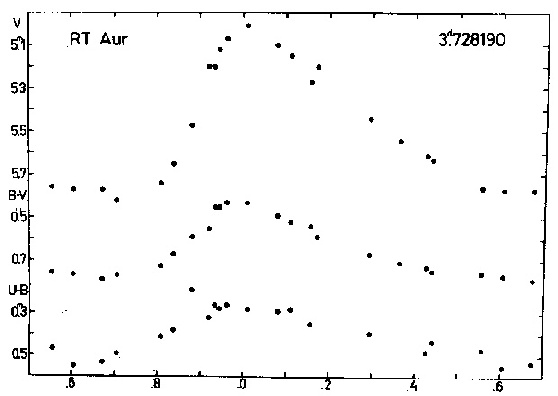 Figure 35 V, B-V and U-B curves of RT Aur
Table 22
Year A_V A_B Source
1961 0.77m: 1m13: Mitchell et al. (1964)
1965 0.80 1.18 Wisniewski, Johnson (1968)
1966 0.76: 1.10: Takase (1969)
1972 0.83: 1.19: Winzer (1973)
1973 0.81 1.17 present paper
The light and colour curves based on the new observations are shown in Fig. 35.
The small bump before the minimum light seems to be unreal. It appears in V light only,
and the earlier photoelectric observations do not show such a bump at that phase. However,
according to Winzer (1973), small fluctuations with amplitude of 0.02m - 0.04m may occur
on the light curve.
The O-C residuals have been computed with the formulae:
C_{max} = 2441723.675 + 3.728190d*E ;
C_{med} = 2441723.247 + 3.728190d*E .
As the O-C diagram (Fig. 36) shows, the period has changed on one occasion:
before J.D. 2430000, P = 3.728243d ;
after J.D. 2430000, P = 3.728190d .
Figure 35 V, B-V and U-B curves of RT Aur
Table 22
Year A_V A_B Source
1961 0.77m: 1m13: Mitchell et al. (1964)
1965 0.80 1.18 Wisniewski, Johnson (1968)
1966 0.76: 1.10: Takase (1969)
1972 0.83: 1.19: Winzer (1973)
1973 0.81 1.17 present paper
The light and colour curves based on the new observations are shown in Fig. 35.
The small bump before the minimum light seems to be unreal. It appears in V light only,
and the earlier photoelectric observations do not show such a bump at that phase. However,
according to Winzer (1973), small fluctuations with amplitude of 0.02m - 0.04m may occur
on the light curve.
The O-C residuals have been computed with the formulae:
C_{max} = 2441723.675 + 3.728190d*E ;
C_{med} = 2441723.247 + 3.728190d*E .
As the O-C diagram (Fig. 36) shows, the period has changed on one occasion:
before J.D. 2430000, P = 3.728243d ;
after J.D. 2430000, P = 3.728190d .
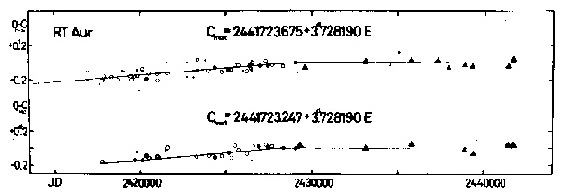 Figure 36 O-C diagram of RT Aur
V 572 Aquilae
According to the 2nd Supplement to the GCVS (Kukarkin et al. 1974) its period and
form of the light curve vary. However, the present observations have shown (see Fig. 37)
that the light curve is stable and very similar to earlier published ones if the
observations are plotted with the correct period. Though the present observations were
made in two colours, the U-B colour curve of V 572 Aql is available from the observations
made by Oosterhoff (1960). The phase relation between the minimum values of U-B and B-V
colour indices and the relatively large distance of this variable from the galactic plane
(b = -15.5—) give reason to classify V 572 Aql as a Population II cepheid.
Figure 36 O-C diagram of RT Aur
V 572 Aquilae
According to the 2nd Supplement to the GCVS (Kukarkin et al. 1974) its period and
form of the light curve vary. However, the present observations have shown (see Fig. 37)
that the light curve is stable and very similar to earlier published ones if the
observations are plotted with the correct period. Though the present observations were
made in two colours, the U-B colour curve of V 572 Aql is available from the observations
made by Oosterhoff (1960). The phase relation between the minimum values of U-B and B-V
colour indices and the relatively large distance of this variable from the galactic plane
(b = -15.5—) give reason to classify V 572 Aql as a Population II cepheid.
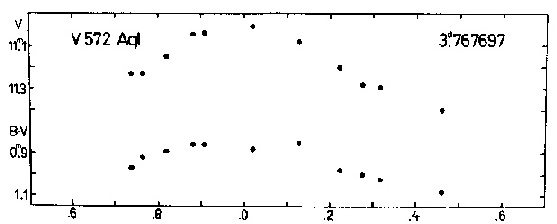 Figure 37 V and B-V curves of V 572 Aql
Figure 37 V and B-V curves of V 572 Aql
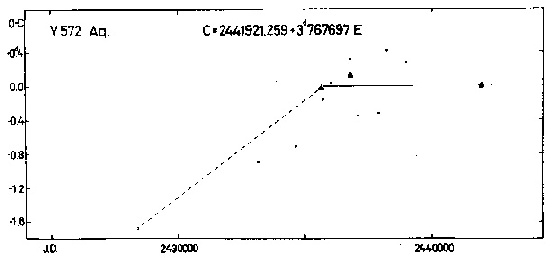 Figure 38 O-C diagram of V 572 Aql
The O-C residuals have been calculated with the formula:
C = 2441921.259 + 3.767697d*E .
For the time before J.D.2435500 the value of the period is rather uncertain (about 3.7686d).
After J.D. 2435500 the period is 3.767697d (see Fig. 38).
Table 24 O-C residuals for V 572 Aql
Obs.Max.J.D. E O-C Type w Source
2428397.31 -3589 -1.68d vis 0.5 Solov'yov (1.944)
2433171.77 -2322 -0.90 phg 0.5 Vasil'yan. et al.^1 (1970)
2433911.20 -2126 +0.06 phg 0.5 Vasil'yan. et al.^1 (1970)
2434660.20 -1927 -0.71 phg 0.5 Vasil'yan. et al.^1 (1970)
2435666.856 -1660 -0.026 phel 3 Walraven et al. (1958)
2435723.24 -1645 -0.16 phg 0.5 Vasil'yan. et al.^1 (1970)
2436036.15 -1562 +0.03 phg 0.5 Vasil'yan. et al.^1 (1970)
2436398.33 -1466 +0.51 phg 0 Vasil'yan. et al.^1 (1970)
2436789.776 -1362 +0.120 phel 3 Oosterhoff (1960)
2436801.28 -1359 +0.32 phg 0.5 Vasil'yan. et al.^1 (1970)
2437079.42 -1285 -0.35 phg 0.5 Vasil'yan. et al.^1 (1970)
2437908.34 -1065 -0.32 phg 0.5 Vasil'yan. et al.^1 (1970)
2438229.34 -980 +0.42 phg 0.5 Vasil'yan. et al.^1 (1970)
2438971.43 -783 +0.28 phg 0.5 Vasil'yan. et al.^1 (1970)
2441921.259 0 0.000 phel 3 present paper
Remark: Observer: Satyvaldiev
AD Geminorum
The light and colour curves of this variable are shown in
Fig. 39. The O-C residuals have been calculated with the formula:
C = 2441694.911 + 3.787980d*E .
The period has remained constant since the discovery of the light variation of AD Gem (see
Fig. 40).
Figure 38 O-C diagram of V 572 Aql
The O-C residuals have been calculated with the formula:
C = 2441921.259 + 3.767697d*E .
For the time before J.D.2435500 the value of the period is rather uncertain (about 3.7686d).
After J.D. 2435500 the period is 3.767697d (see Fig. 38).
Table 24 O-C residuals for V 572 Aql
Obs.Max.J.D. E O-C Type w Source
2428397.31 -3589 -1.68d vis 0.5 Solov'yov (1.944)
2433171.77 -2322 -0.90 phg 0.5 Vasil'yan. et al.^1 (1970)
2433911.20 -2126 +0.06 phg 0.5 Vasil'yan. et al.^1 (1970)
2434660.20 -1927 -0.71 phg 0.5 Vasil'yan. et al.^1 (1970)
2435666.856 -1660 -0.026 phel 3 Walraven et al. (1958)
2435723.24 -1645 -0.16 phg 0.5 Vasil'yan. et al.^1 (1970)
2436036.15 -1562 +0.03 phg 0.5 Vasil'yan. et al.^1 (1970)
2436398.33 -1466 +0.51 phg 0 Vasil'yan. et al.^1 (1970)
2436789.776 -1362 +0.120 phel 3 Oosterhoff (1960)
2436801.28 -1359 +0.32 phg 0.5 Vasil'yan. et al.^1 (1970)
2437079.42 -1285 -0.35 phg 0.5 Vasil'yan. et al.^1 (1970)
2437908.34 -1065 -0.32 phg 0.5 Vasil'yan. et al.^1 (1970)
2438229.34 -980 +0.42 phg 0.5 Vasil'yan. et al.^1 (1970)
2438971.43 -783 +0.28 phg 0.5 Vasil'yan. et al.^1 (1970)
2441921.259 0 0.000 phel 3 present paper
Remark: Observer: Satyvaldiev
AD Geminorum
The light and colour curves of this variable are shown in
Fig. 39. The O-C residuals have been calculated with the formula:
C = 2441694.911 + 3.787980d*E .
The period has remained constant since the discovery of the light variation of AD Gem (see
Fig. 40).
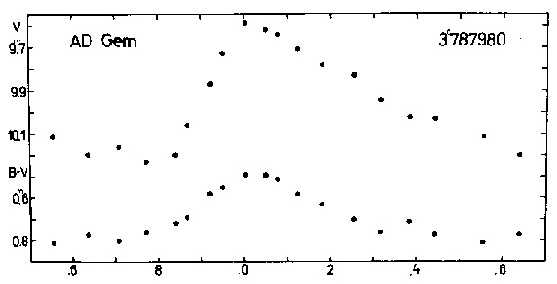 Figure 39 V and B-V curves of AD Gem
Figure 39 V and B-V curves of AD Gem
 Figure 40 O-C diagram of AD Gem
Table 25 O-C residuals for AD Gem
Obs.Max.J.D. E O-C Type w Source
2420410.450 -5619 +0.199d phg 0.5 Kukarkin (1930b)
2422031.507 -5191 0.000 phg 1 Kukarkina (1954b)
2424963.453 -4417 +0.050 phg 1 Prager (1929)
2426065.669 -4126 -0.037 vis 1 Beyer (1934a)
2427084.676 -3857 +0.004 vis 1 Beyer (1934a)
2428065.750 -3598 -0.009 vis 0.5 Martynov (1951)
2428558.196 -3468 0.000 vis 0.5 Martynov (1951)
2428899.045 -3378 -0.070 vis 0.5 Martynov (1951)
2429274.075 -3279 -0.050 vis 0.5 Martynov (1951)
2429611.295 -3190 +0.040 vis 0.5 Martynov (1951)
2429993.989 -3089 +0.148 vis 0.5 Martynov (1951)
2430395.357 -2983 -0.010 vis 0.5 Martynov (1951)
2430853.685 -2862 -0.027 vis 0.5 Martynov (1951)
2432081.011 -2538 -0.007 phg 1 Kukarkina (1954b)
Table 25 (cont.)
Obs.Max.J.D. E O-C Type w Source
2436778.167 -1298 +0.054d phg 0.5 Huth (1963a)
2436834.942 -1283 +0.009 phel 2 Weaver et al. (1960)
2437524.267 -1101 -0.078 phg 1 Fridel' (1971)
2437630.387 -1073 -0.021 phel 3 Mitchell et al. (1964)
2438475.042 -850 -0.086 phg 1 Fridel' (1971)
2439202.459 -658 +0.039 phel 3 Takase (1969)
2441694.948 0 +0.037 phel 3 present paper
DF Cassiopeiae
The light and colour curves of DF Cas are shown in Fig. 41. The O-C residuals have
been computed with the formula:
C = 2441719.622 + 3.832472d*E .
The O-C diagram (Fig. 42) can be represented by a straight line, i.e. the period is
constant.
Figure 40 O-C diagram of AD Gem
Table 25 O-C residuals for AD Gem
Obs.Max.J.D. E O-C Type w Source
2420410.450 -5619 +0.199d phg 0.5 Kukarkin (1930b)
2422031.507 -5191 0.000 phg 1 Kukarkina (1954b)
2424963.453 -4417 +0.050 phg 1 Prager (1929)
2426065.669 -4126 -0.037 vis 1 Beyer (1934a)
2427084.676 -3857 +0.004 vis 1 Beyer (1934a)
2428065.750 -3598 -0.009 vis 0.5 Martynov (1951)
2428558.196 -3468 0.000 vis 0.5 Martynov (1951)
2428899.045 -3378 -0.070 vis 0.5 Martynov (1951)
2429274.075 -3279 -0.050 vis 0.5 Martynov (1951)
2429611.295 -3190 +0.040 vis 0.5 Martynov (1951)
2429993.989 -3089 +0.148 vis 0.5 Martynov (1951)
2430395.357 -2983 -0.010 vis 0.5 Martynov (1951)
2430853.685 -2862 -0.027 vis 0.5 Martynov (1951)
2432081.011 -2538 -0.007 phg 1 Kukarkina (1954b)
Table 25 (cont.)
Obs.Max.J.D. E O-C Type w Source
2436778.167 -1298 +0.054d phg 0.5 Huth (1963a)
2436834.942 -1283 +0.009 phel 2 Weaver et al. (1960)
2437524.267 -1101 -0.078 phg 1 Fridel' (1971)
2437630.387 -1073 -0.021 phel 3 Mitchell et al. (1964)
2438475.042 -850 -0.086 phg 1 Fridel' (1971)
2439202.459 -658 +0.039 phel 3 Takase (1969)
2441694.948 0 +0.037 phel 3 present paper
DF Cassiopeiae
The light and colour curves of DF Cas are shown in Fig. 41. The O-C residuals have
been computed with the formula:
C = 2441719.622 + 3.832472d*E .
The O-C diagram (Fig. 42) can be represented by a straight line, i.e. the period is
constant.
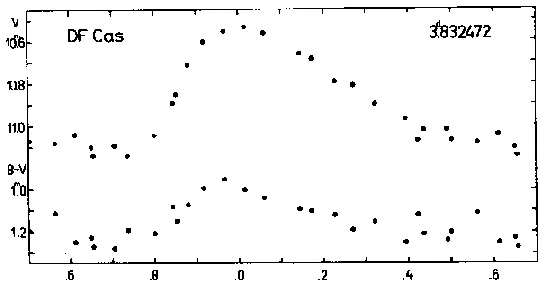 Figure 41 V and B-V curves of DF Cas
Table 26 O-C residuals for DF Cas
Obs.Max.J.D. E O-C Type w Source
2417648.066 -6281 +0.201d phg 1 Perova (1954)
2428562.672 -3433 -0.074 phg 1 Meshkova (1940)
2428873.207 -3352 +0.031 phg 1 Perova (1954)
2432019.605 -2531 -0.030 phg 1 Perova (1954)
2433774.741 -2073 -0.167 phg 1 Perova (1954)
2434299.952 -1936 -0.004 phg 1 Perova (1954)
2436905.985 -1256 -0.052 phel 3 Bahner et al. (1962)
2437630.389 -1067 +0.015 phel 2 Mitchell et al. (1964)
2441719.659 0 +0.037 phel 3 present paper
2443149.118 +373 -0.016 phel 2 present paper
Figure 41 V and B-V curves of DF Cas
Table 26 O-C residuals for DF Cas
Obs.Max.J.D. E O-C Type w Source
2417648.066 -6281 +0.201d phg 1 Perova (1954)
2428562.672 -3433 -0.074 phg 1 Meshkova (1940)
2428873.207 -3352 +0.031 phg 1 Perova (1954)
2432019.605 -2531 -0.030 phg 1 Perova (1954)
2433774.741 -2073 -0.167 phg 1 Perova (1954)
2434299.952 -1936 -0.004 phg 1 Perova (1954)
2436905.985 -1256 -0.052 phel 3 Bahner et al. (1962)
2437630.389 -1067 +0.015 phel 2 Mitchell et al. (1964)
2441719.659 0 +0.037 phel 3 present paper
2443149.118 +373 -0.016 phel 2 present paper
 Figure 42 O-C diagram of DF Cas
SU Cygni
Its light and colour curves are typical of classical cepheids (see Fig. 43),
nevertheless Kolesnik and Kheilo (1970) doubted this classification. According to Madore
(1977), SU Cyg has a blue photometric companion.
Figure 42 O-C diagram of DF Cas
SU Cygni
Its light and colour curves are typical of classical cepheids (see Fig. 43),
nevertheless Kolesnik and Kheilo (1970) doubted this classification. According to Madore
(1977), SU Cyg has a blue photometric companion.
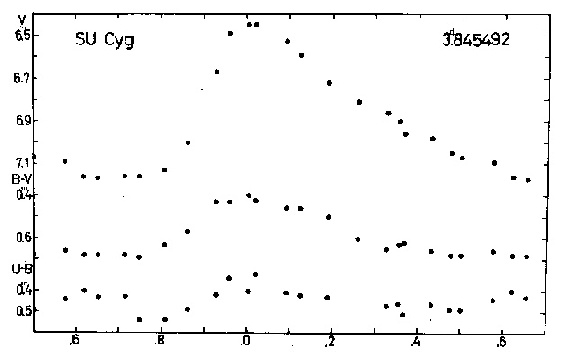 Figure 43 V, B-V and U-B curves of SU Cyg
The O-C residuals have been computed with the formulae:
C_{max} = 2441778.935 + 3.845492d*E ;
C_{med} = 2441778.589 + 3.845492d*E .
As Fig. 44 shows, a sudden period change took place at about J.D. 2430000 . After a short
time the value of the period returned to its original. This phenomenon is similar to that
mentioned for DT Cyg, SZ Tau and V 532 Cyg. This "rejumping" period is even more
interesting because the O-C diagram for the median brightness could be also constructed.
This latter O-C diagram
Table 27 O-C residuals for SU Cyg
Obs.Max.J.D. Obs.Med.J.D. E O-C O-C Type w Source
max med
2414256.621 -7157 -0.128d vis 1 Muller, Kempf (1897)
2414441.3 -7109 0.0 vis 0.5 Muller, Hartwig^1 (1920)
2414491.161 -7096 -0.163 vis 1 Zinner^1 (1932)
2414564.221 -7077 -0.167 vis 1 Luizet (1899)
2414591.118 2414590.722 -7070 -0.189 -0.239d vis 1 Wendell (1913)
2414864.138 -6999 -0.198 vis 1 Prittwitz (1901)
2414906.20 -6988 -0.44 vis 0 Yendell (1900)
2414986.89 -6967 -0.50 vis 0 Yendell^2 (1902b)
2415079.481 -6943 -0.203 vis 1 Zinner^1 (1932)
2415236.85 -6902 -0.50 vis 0 Yendell (1902a)
2415606.573 -6806 +0.057 vis 0 Luizet (1907)
2415663.71 -6791 -0.39 vis 0 Yendell (1902a)
2415748.613 -6769 -0.187 vis 0.5 Zinner^1 (1932)
2415940.97 -6719 -0.10 vis 0.5 Yendell (1905)
2415956.4 -6715 -0.10 vis 0.5 Muller, Hartwig^1 (1920)
2415968.020 -6712 +0.027 vis 0.5 Luizet (1907)
2416337.155 -6616 -0.005 vis 0.5 Luizet (1907)
2416690.815 -6524 -0.130 vis 0.5 Luizet (1907)
2416848.454 -6483 -0.156 vis 1 Prittwitz (1907)
2417052.191 2417051.794 -6430 -0.230 -0.281 phg 2 Wilkens (1906)
2417079.313 -6423 -0.027 vis 0.5 Luizet (1907)
2417086.3 -6421 -0.7 vis 0 Maddrill (1906)
2417367.769 -6348 +0.017 vis 0.5 Luizet (1907)
2417829.048 2417828.641 -6228 -0.163 -0.224 vis 1 Zeipel (1908)
2417882.822 -6214 -0.226 vis 1 Van der Bilt (1925)
2418175.117 -6138 -0.188 vis 1 Van der Bilt (1925)
2418528.908 -6046 -0.182 vis 1 Van der Bilt (1925)
2419271.104 -5853 -0.166 vis 1 Van der Bilt (1925)
2421086.203 -5381 -0.140 vis 1 Luyten (1922)
2421278.435 -5331 -0.182 phg 0.5 Robinson (1931b)
2421443.751 -5288 -0.222 vis 1 Luyten (1922)
2421943.616 -5158 -0.271 vis 1 Luyten (1922)
2422582.072 -4992 -0.167 vis 0.5 Doberck (1925)
2423308.866 -4803 -0.171 vis 0.5 Doberck (1925)
Table 27 (cont.)
Obs.Max.J.D. Obs.Med.J.D. E O-C O-C Type w Source
max med
2423320.515 -4800 -0.058d vis 1 Hellerich (1925)
2423658.842 -4712 -0.135 vis 0.5 Doberck (1925)
2423662.684 -4711 -0.138 vis 1 Hellerich (1925)
2424012.510 -4620 -0.252 vis 0.5 Parenago (1938)
2424028.020 -4616 -0.124 vis 1 Hellerich (1925)
2424738.969 -4431 -0.245d vis 1 Moncibowitz^3 (1938)
2424816.453 -4411 -0.017 vis 0.5 Kukarkin (1940)
2425100.868 2425100.518 -4337 -0.168 -0.171 phg 2 Hellerich (1935)
2425131.234 -4329 -0.220 vis 1 Moncibowitz^3 (1938)
2425147.039 -4325 -0.143 vis 0.5 Kukarkin (1940)
2425243.24 -4300 -0.08 vis 0.5 Lause (1938)
2425323.499 -4279 -0.230 vis 1 Moncibowitz^3 (1938)
2425462.388 -4243 -0.124 vis 0.5 Kukarkin (1940)
2425696.940 2425696.552 -4182 -0.147 -0.189 vis 1 Zverev (1936)
2425804.661 -4154 -0.100 vis 0.5 Kukarkin (1940)
2425835.346 -4146 -0.179 vis 0.5 Parenago (1938)
2425904.749 -4128 +0.005 phg 0.5 Nassau, Townson (1932)
2426342.945 -4014 -0.185 vis 0.5 Kukarkin (1940)
2426423.739 -3993 -0.146 vis 1 Zverev (1936)
2426619.822 -3942 -0.184 vis 0.5 Kukarkin (1940)
2426908.262 -3867 -0.155 vis 0.5 Dziewulski et al. (1946)
2426923.669 -3863 -0.130 vis 1 Florya, Kukarkina (1953)
2427277.410 2427277.010 -3771 -0.175 -0.229 vis 1 Florya, Kukarkina (1953)
2427677.322 2427676.857 -3667 -0.194 -0.313 vis 1 Krebs (1935)
2427754.297 -3647 -0.129 vis 0.5 Dziewulski et al. (1946)
2427861.865 -3619 -0.234 vis 0.5 Miczaika (1937)
2428050.410 -3570 -0.119 vis 1 Krebs (1937a)
2428758.046 -3386 -0.053 phg 0.5 Dziewulski et al. (1946)
2429057.958 -3308 -0.089 phg 0.5 Kholopov (1947)
2429523.285 -3187 -0.067 vis 0.5 Remenchiz (1946)
2430238.647 -3001 +0.033 vis 0.5 Lochel^4 (1964)
2430588.687 -2910 +0.134 vis 0.5 Lochel^4 (1964)
2432861.300 -2319 +0.061 phg 0.5 Wachmann (1966)
2433126.659 -2250 +0.081 phel 3 Eggen (1951)
2433472.65 -2160 -0.02 vis 0.5 Domke, Pohl^5 (1952)
Table 27 (cont.)
Obs.Max.J.D. Obs.Med.J.D. E O-C O-C Type w Source
max med
2433538.118 -2143 +0.72d phg 0.5 Wachmann (1966)
2433680.364 -2106 +0.035 phg 1 Tschuprina (1952)
2434328.02 -1938 +1.65 phg 0 Fu (1964)
2434368.640 -1927 -0.032 phg 1 Shteiman (1958)
2434591.666 -1869 -0.044 phel 2 present paper^6
2434603.406 -1866 +0.159 phg 0.5 Wachmann (1966)
2434922.43 -1783 +0.01 vis 0.5 Marks (1959)
2435172.32 -1718 -0.06 vis 0.5 Marks^7 (1959)
2435303.355 -1684 +0.229 phg 0 Wachmann (1966)
2435338.146 -1675 +0.410 phg 0 Tschuprina (1957)
2435356.949 -1670 -0.014 phel 2 Walraven et al. (1958)
2435380.180 -1664 +0.144 vis 0.5 Azarnova (1957)
2435645.305 -1595 -0.070 phg 1 Shteiman (1958)
2435922.056 -1523 -0.194 vis 0.5 Azarnova (1958)
2436087.339 -1480 -0.268 vis 0 Vinnik^8 (1958)
2436099.119 -1477 +0.024 phel 2 Svolopoulos (1960)
2436214.589 -1447 +0.081 vis 0.5 Latyshev (1969)
2436448.952 -1386 -0.131 vis 0.5 Azarnova (1958)
2436903.132 -1268 +0.281 phg 0 Wachmann (1966)
2436926.058 -1262 +0.134 vis 0.5 Azarnova (1962)
2437198.867 -1191 -0.087 vis 0.5 Kiperman (1963)
2437287.383 -1168 -0.017 phel 3 Mitchell et al. (1964)
2437494.980 -1114 -0.077 vis 0.5 Kiperman (1963)
2437941.117 -998 -0.017 phel 2 Williams (1966)
2438179.565 -936 +0.011 vis 0.5 Ross, Hartmann (1972)
2438971.724 -730 0.000 vis 0.5 Borisov^9 (1972)
2438987.18 -726 +0.07 vis 0.5 Braune, Hubscher (1967)
2438994.833 2438994.418 -724 +0.034 -0.033d vis 1 Borisov (1972)
2439014.054 -719 +0.028 phel 3 Wisniewski, Johnson (1968)
2439344.655 -633 -0.083 vis 1 Borisov (1972)
2439740.868 -530 +0.044 vis 1 Borisov (1972)
2440482.991 -337 -0.013 vis 1 Borisov (1972)
2441778.985 2441778.619 0 +0.050 +0.030 phel 3 present paper
Remarks: 1 Observer: Hartwig ; 2 Obs.: Flanery; 3 Obs.: Rybka; 4 Obs.: Model; 5 Obs.: Mielke;
6 Obs.: Detre; 7 Obs.: Wroblewski; 8 Obs.: Sazanova; 9 Obs.: Pantschuk.
Figure 43 V, B-V and U-B curves of SU Cyg
The O-C residuals have been computed with the formulae:
C_{max} = 2441778.935 + 3.845492d*E ;
C_{med} = 2441778.589 + 3.845492d*E .
As Fig. 44 shows, a sudden period change took place at about J.D. 2430000 . After a short
time the value of the period returned to its original. This phenomenon is similar to that
mentioned for DT Cyg, SZ Tau and V 532 Cyg. This "rejumping" period is even more
interesting because the O-C diagram for the median brightness could be also constructed.
This latter O-C diagram
Table 27 O-C residuals for SU Cyg
Obs.Max.J.D. Obs.Med.J.D. E O-C O-C Type w Source
max med
2414256.621 -7157 -0.128d vis 1 Muller, Kempf (1897)
2414441.3 -7109 0.0 vis 0.5 Muller, Hartwig^1 (1920)
2414491.161 -7096 -0.163 vis 1 Zinner^1 (1932)
2414564.221 -7077 -0.167 vis 1 Luizet (1899)
2414591.118 2414590.722 -7070 -0.189 -0.239d vis 1 Wendell (1913)
2414864.138 -6999 -0.198 vis 1 Prittwitz (1901)
2414906.20 -6988 -0.44 vis 0 Yendell (1900)
2414986.89 -6967 -0.50 vis 0 Yendell^2 (1902b)
2415079.481 -6943 -0.203 vis 1 Zinner^1 (1932)
2415236.85 -6902 -0.50 vis 0 Yendell (1902a)
2415606.573 -6806 +0.057 vis 0 Luizet (1907)
2415663.71 -6791 -0.39 vis 0 Yendell (1902a)
2415748.613 -6769 -0.187 vis 0.5 Zinner^1 (1932)
2415940.97 -6719 -0.10 vis 0.5 Yendell (1905)
2415956.4 -6715 -0.10 vis 0.5 Muller, Hartwig^1 (1920)
2415968.020 -6712 +0.027 vis 0.5 Luizet (1907)
2416337.155 -6616 -0.005 vis 0.5 Luizet (1907)
2416690.815 -6524 -0.130 vis 0.5 Luizet (1907)
2416848.454 -6483 -0.156 vis 1 Prittwitz (1907)
2417052.191 2417051.794 -6430 -0.230 -0.281 phg 2 Wilkens (1906)
2417079.313 -6423 -0.027 vis 0.5 Luizet (1907)
2417086.3 -6421 -0.7 vis 0 Maddrill (1906)
2417367.769 -6348 +0.017 vis 0.5 Luizet (1907)
2417829.048 2417828.641 -6228 -0.163 -0.224 vis 1 Zeipel (1908)
2417882.822 -6214 -0.226 vis 1 Van der Bilt (1925)
2418175.117 -6138 -0.188 vis 1 Van der Bilt (1925)
2418528.908 -6046 -0.182 vis 1 Van der Bilt (1925)
2419271.104 -5853 -0.166 vis 1 Van der Bilt (1925)
2421086.203 -5381 -0.140 vis 1 Luyten (1922)
2421278.435 -5331 -0.182 phg 0.5 Robinson (1931b)
2421443.751 -5288 -0.222 vis 1 Luyten (1922)
2421943.616 -5158 -0.271 vis 1 Luyten (1922)
2422582.072 -4992 -0.167 vis 0.5 Doberck (1925)
2423308.866 -4803 -0.171 vis 0.5 Doberck (1925)
Table 27 (cont.)
Obs.Max.J.D. Obs.Med.J.D. E O-C O-C Type w Source
max med
2423320.515 -4800 -0.058d vis 1 Hellerich (1925)
2423658.842 -4712 -0.135 vis 0.5 Doberck (1925)
2423662.684 -4711 -0.138 vis 1 Hellerich (1925)
2424012.510 -4620 -0.252 vis 0.5 Parenago (1938)
2424028.020 -4616 -0.124 vis 1 Hellerich (1925)
2424738.969 -4431 -0.245d vis 1 Moncibowitz^3 (1938)
2424816.453 -4411 -0.017 vis 0.5 Kukarkin (1940)
2425100.868 2425100.518 -4337 -0.168 -0.171 phg 2 Hellerich (1935)
2425131.234 -4329 -0.220 vis 1 Moncibowitz^3 (1938)
2425147.039 -4325 -0.143 vis 0.5 Kukarkin (1940)
2425243.24 -4300 -0.08 vis 0.5 Lause (1938)
2425323.499 -4279 -0.230 vis 1 Moncibowitz^3 (1938)
2425462.388 -4243 -0.124 vis 0.5 Kukarkin (1940)
2425696.940 2425696.552 -4182 -0.147 -0.189 vis 1 Zverev (1936)
2425804.661 -4154 -0.100 vis 0.5 Kukarkin (1940)
2425835.346 -4146 -0.179 vis 0.5 Parenago (1938)
2425904.749 -4128 +0.005 phg 0.5 Nassau, Townson (1932)
2426342.945 -4014 -0.185 vis 0.5 Kukarkin (1940)
2426423.739 -3993 -0.146 vis 1 Zverev (1936)
2426619.822 -3942 -0.184 vis 0.5 Kukarkin (1940)
2426908.262 -3867 -0.155 vis 0.5 Dziewulski et al. (1946)
2426923.669 -3863 -0.130 vis 1 Florya, Kukarkina (1953)
2427277.410 2427277.010 -3771 -0.175 -0.229 vis 1 Florya, Kukarkina (1953)
2427677.322 2427676.857 -3667 -0.194 -0.313 vis 1 Krebs (1935)
2427754.297 -3647 -0.129 vis 0.5 Dziewulski et al. (1946)
2427861.865 -3619 -0.234 vis 0.5 Miczaika (1937)
2428050.410 -3570 -0.119 vis 1 Krebs (1937a)
2428758.046 -3386 -0.053 phg 0.5 Dziewulski et al. (1946)
2429057.958 -3308 -0.089 phg 0.5 Kholopov (1947)
2429523.285 -3187 -0.067 vis 0.5 Remenchiz (1946)
2430238.647 -3001 +0.033 vis 0.5 Lochel^4 (1964)
2430588.687 -2910 +0.134 vis 0.5 Lochel^4 (1964)
2432861.300 -2319 +0.061 phg 0.5 Wachmann (1966)
2433126.659 -2250 +0.081 phel 3 Eggen (1951)
2433472.65 -2160 -0.02 vis 0.5 Domke, Pohl^5 (1952)
Table 27 (cont.)
Obs.Max.J.D. Obs.Med.J.D. E O-C O-C Type w Source
max med
2433538.118 -2143 +0.72d phg 0.5 Wachmann (1966)
2433680.364 -2106 +0.035 phg 1 Tschuprina (1952)
2434328.02 -1938 +1.65 phg 0 Fu (1964)
2434368.640 -1927 -0.032 phg 1 Shteiman (1958)
2434591.666 -1869 -0.044 phel 2 present paper^6
2434603.406 -1866 +0.159 phg 0.5 Wachmann (1966)
2434922.43 -1783 +0.01 vis 0.5 Marks (1959)
2435172.32 -1718 -0.06 vis 0.5 Marks^7 (1959)
2435303.355 -1684 +0.229 phg 0 Wachmann (1966)
2435338.146 -1675 +0.410 phg 0 Tschuprina (1957)
2435356.949 -1670 -0.014 phel 2 Walraven et al. (1958)
2435380.180 -1664 +0.144 vis 0.5 Azarnova (1957)
2435645.305 -1595 -0.070 phg 1 Shteiman (1958)
2435922.056 -1523 -0.194 vis 0.5 Azarnova (1958)
2436087.339 -1480 -0.268 vis 0 Vinnik^8 (1958)
2436099.119 -1477 +0.024 phel 2 Svolopoulos (1960)
2436214.589 -1447 +0.081 vis 0.5 Latyshev (1969)
2436448.952 -1386 -0.131 vis 0.5 Azarnova (1958)
2436903.132 -1268 +0.281 phg 0 Wachmann (1966)
2436926.058 -1262 +0.134 vis 0.5 Azarnova (1962)
2437198.867 -1191 -0.087 vis 0.5 Kiperman (1963)
2437287.383 -1168 -0.017 phel 3 Mitchell et al. (1964)
2437494.980 -1114 -0.077 vis 0.5 Kiperman (1963)
2437941.117 -998 -0.017 phel 2 Williams (1966)
2438179.565 -936 +0.011 vis 0.5 Ross, Hartmann (1972)
2438971.724 -730 0.000 vis 0.5 Borisov^9 (1972)
2438987.18 -726 +0.07 vis 0.5 Braune, Hubscher (1967)
2438994.833 2438994.418 -724 +0.034 -0.033d vis 1 Borisov (1972)
2439014.054 -719 +0.028 phel 3 Wisniewski, Johnson (1968)
2439344.655 -633 -0.083 vis 1 Borisov (1972)
2439740.868 -530 +0.044 vis 1 Borisov (1972)
2440482.991 -337 -0.013 vis 1 Borisov (1972)
2441778.985 2441778.619 0 +0.050 +0.030 phel 3 present paper
Remarks: 1 Observer: Hartwig ; 2 Obs.: Flanery; 3 Obs.: Rybka; 4 Obs.: Model; 5 Obs.: Mielke;
6 Obs.: Detre; 7 Obs.: Wroblewski; 8 Obs.: Sazanova; 9 Obs.: Pantschuk.
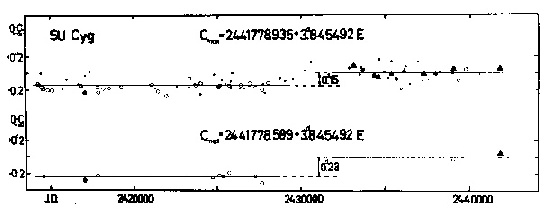 Figure 44 O-C diagram of SU Cyg
shows the jump of the period as well, but the variations in the O-C values are not
equal. The difference in the O-C values is equal to 0.15d in the case of the maximum,
whereas it is equal to 0.23d for the median brightness. This means that the light curve
has become steeper after the rejump. The time difference between the moments of a
maximum and the preceding moment of median brightness on the ascending branch is nearly
0.35m . Considering that the median point has moved nearer the maximum, the increase
in the steepness is about 20%.
Y Aurigae
Figure 44 O-C diagram of SU Cyg
shows the jump of the period as well, but the variations in the O-C values are not
equal. The difference in the O-C values is equal to 0.15d in the case of the maximum,
whereas it is equal to 0.23d for the median brightness. This means that the light curve
has become steeper after the rejump. The time difference between the moments of a
maximum and the preceding moment of median brightness on the ascending branch is nearly
0.35m . Considering that the median point has moved nearer the maximum, the increase
in the steepness is about 20%.
Y Aurigae
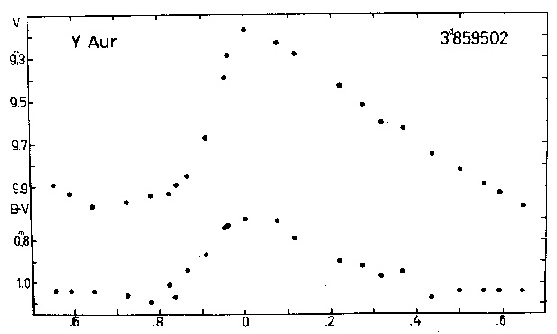 Figure 45 V and B-V curves of Y Aur
Table 28. O-C residuals for Y Aur
Obs.Max.J.D. Obs.Med.J.D. E O-C O-C Type w Source
max med
2415474.705 -6799 +0.95d vis 1 Williams (1905b)
2415737.096 -6731 +0.040 vis 1 Williams (1905b)
2416215.714 -6607 +0.080 phg 1 Kukarkin (1931c)
2416254.236 -6597 +0.007 vis 1 Williams (1905b)
2416466.565 -6542 +0.063 vis 0.5 Lau (1904)
2417277.43 -6332 +0.43 vis 0 Luizet (1917)
2417639.779 2417639.505 -6238 -0.012 +0.68d vis 1 Zeipel (1908)
2417663.23 -6232 +0.28 vis 0 Luizet (1917)
2417944.675 2417944.320 -6159 -0.016 -0.017 vis 1 Van der Bilt (1924)
2418446.412 2418446.045 -6029 -0.014 -0.027 vis 1 Van der Bilt (1924)
2418755.56 -5949 +0.37 vis 0 Luizet (1917)
2419133.69 -5851 +0.27 vis 0 Luizet (1917)
2419322.538 2419322.187 -5802 +0.005 +0.008 vis 1 Van der Bilt (1924)
2419488.74 -5759 +0.25 vis 0 Luizet (1917)
2419805.36 -5677 +0.39 vis 0 Luizet (1917)
2419866.903 -5661 +0.180 phg 0.5 Robinson (1929)
2420600.12 -5471 +0.09 vis 0.5 Luizet (1917)
2420982.11 -5372 -0.01 vis 0.5 Luizet (1917)
2421140.394 -5331 +0.035 vis 1 Doberck (1924c)
2421167.333 2421166.924 -5324 -0.042 -0.097 phg 2 Jordan (1929)
Table 28 (cont.)
Obs.Max.J.D. Obs.Med.J.D. E O-C O-C Type w Source
max med
2422163.161 2422162.756 -5066 +0.34d -0.17d vis 1 Nijland (1923)
2422170.849 2422170.525 -5064 +0.003 +0.033 phg 2 Martin, Plummer (1921)
2422564.478 -4962 -0.037 vis 1 Doberck (1924c)
2422676.465 2422676.102 -4933 +0.024 +0.015 vis 1 Nijland (1923)
2422761.3 -4911 -0.05 vis 0.5 Hacar (1921)
2423043.097 2423042.773 -4838 +0.004 +0.034 vis 1 Nijland (1923)
2423355.680 -4757 -0.033 vis 1 Nijland (1923)
2423502.536 -4719 +0.162 phg 1 Kukarkin (1931c)
2423594.853 -4695 -0.149 vis 1 Doberck (1924c)
2425972.82 -4079 +0.36 vis 0 Kukarkin (1930a)
2426165.401 2426165.034 -4029 -0.029 -0.042 phg 1 Kukarkin (1931c)
2426234.922 -4011 +0.021 vis 1 Kukarkin (1940)
2428150.02 -3515 +0.81 vis 0 Fu (1964)
2430244.803 -2972 -0.121 vis 0.5 Lagrula (1941,1942)
2430785.41 -2832 +0.16 vis 0.5 Stein (1944)
2436833.102 -1265 +0.008 phel 3 Weaver et al. (1960)
2436844.654 -1262 -0.018 phel 2 Oosterhoff (1960)
2439361.069 2439360.687 -610 +0.001 -0.027 phel 3 Takase (1969)
2441715.370 2441715.027 0 +0.006 +0.017 phel 3 present paper
Figure 45 V and B-V curves of Y Aur
Table 28. O-C residuals for Y Aur
Obs.Max.J.D. Obs.Med.J.D. E O-C O-C Type w Source
max med
2415474.705 -6799 +0.95d vis 1 Williams (1905b)
2415737.096 -6731 +0.040 vis 1 Williams (1905b)
2416215.714 -6607 +0.080 phg 1 Kukarkin (1931c)
2416254.236 -6597 +0.007 vis 1 Williams (1905b)
2416466.565 -6542 +0.063 vis 0.5 Lau (1904)
2417277.43 -6332 +0.43 vis 0 Luizet (1917)
2417639.779 2417639.505 -6238 -0.012 +0.68d vis 1 Zeipel (1908)
2417663.23 -6232 +0.28 vis 0 Luizet (1917)
2417944.675 2417944.320 -6159 -0.016 -0.017 vis 1 Van der Bilt (1924)
2418446.412 2418446.045 -6029 -0.014 -0.027 vis 1 Van der Bilt (1924)
2418755.56 -5949 +0.37 vis 0 Luizet (1917)
2419133.69 -5851 +0.27 vis 0 Luizet (1917)
2419322.538 2419322.187 -5802 +0.005 +0.008 vis 1 Van der Bilt (1924)
2419488.74 -5759 +0.25 vis 0 Luizet (1917)
2419805.36 -5677 +0.39 vis 0 Luizet (1917)
2419866.903 -5661 +0.180 phg 0.5 Robinson (1929)
2420600.12 -5471 +0.09 vis 0.5 Luizet (1917)
2420982.11 -5372 -0.01 vis 0.5 Luizet (1917)
2421140.394 -5331 +0.035 vis 1 Doberck (1924c)
2421167.333 2421166.924 -5324 -0.042 -0.097 phg 2 Jordan (1929)
Table 28 (cont.)
Obs.Max.J.D. Obs.Med.J.D. E O-C O-C Type w Source
max med
2422163.161 2422162.756 -5066 +0.34d -0.17d vis 1 Nijland (1923)
2422170.849 2422170.525 -5064 +0.003 +0.033 phg 2 Martin, Plummer (1921)
2422564.478 -4962 -0.037 vis 1 Doberck (1924c)
2422676.465 2422676.102 -4933 +0.024 +0.015 vis 1 Nijland (1923)
2422761.3 -4911 -0.05 vis 0.5 Hacar (1921)
2423043.097 2423042.773 -4838 +0.004 +0.034 vis 1 Nijland (1923)
2423355.680 -4757 -0.033 vis 1 Nijland (1923)
2423502.536 -4719 +0.162 phg 1 Kukarkin (1931c)
2423594.853 -4695 -0.149 vis 1 Doberck (1924c)
2425972.82 -4079 +0.36 vis 0 Kukarkin (1930a)
2426165.401 2426165.034 -4029 -0.029 -0.042 phg 1 Kukarkin (1931c)
2426234.922 -4011 +0.021 vis 1 Kukarkin (1940)
2428150.02 -3515 +0.81 vis 0 Fu (1964)
2430244.803 -2972 -0.121 vis 0.5 Lagrula (1941,1942)
2430785.41 -2832 +0.16 vis 0.5 Stein (1944)
2436833.102 -1265 +0.008 phel 3 Weaver et al. (1960)
2436844.654 -1262 -0.018 phel 2 Oosterhoff (1960)
2439361.069 2439360.687 -610 +0.001 -0.027 phel 3 Takase (1969)
2441715.370 2441715.027 0 +0.006 +0.017 phel 3 present paper
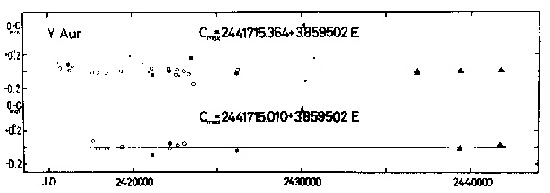 Figure 46 O-C diagram of Y Aur
The light and colour curves of this variable are shown in Fig. 45. The O-C
residuals have been computed with the formulae:
C_{max} = 2441715.364 + 3.859502d*E ;
C_{med} = 2441715.010 + 3.859502d*E .
Both O-C diagrams (Fig. 46) show constant period and give the same value for the period.
ST Tauri
According to Michalowska-Smak and Smak (1965) this star is a Population II
variable. This statement can be refuted with the aid of the light and colour curves
shown in Fig. 47. These
Figure 46 O-C diagram of Y Aur
The light and colour curves of this variable are shown in Fig. 45. The O-C
residuals have been computed with the formulae:
C_{max} = 2441715.364 + 3.859502d*E ;
C_{med} = 2441715.010 + 3.859502d*E .
Both O-C diagrams (Fig. 46) show constant period and give the same value for the period.
ST Tauri
According to Michalowska-Smak and Smak (1965) this star is a Population II
variable. This statement can be refuted with the aid of the light and colour curves
shown in Fig. 47. These
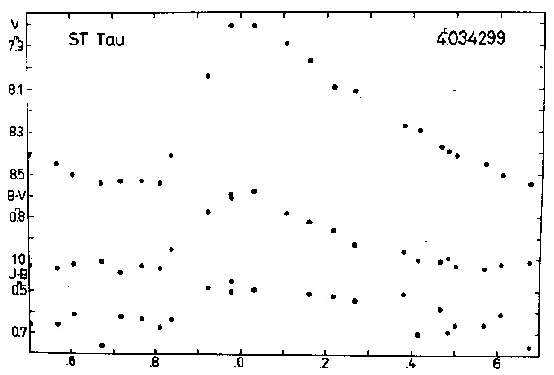 Figure 47 V, B-V and U-B curves of ST Tau
curves are typical of the classical cepheids.
The O-C residuals have been computed with the formula:
C = 2441761.963 + 4.034299d*E .
The 2nd Supplement to the GCVS (Kukarkin et al. 1974) reports on the period variation
of ST Tau. The O-C diagram (Fig. 48) does not show any period variation.
Figure 47 V, B-V and U-B curves of ST Tau
curves are typical of the classical cepheids.
The O-C residuals have been computed with the formula:
C = 2441761.963 + 4.034299d*E .
The 2nd Supplement to the GCVS (Kukarkin et al. 1974) reports on the period variation
of ST Tau. The O-C diagram (Fig. 48) does not show any period variation.
 Figure 48 O-C diagram of ST Tau
Table 29 O-C residuals for ST Tau
Obs.Max.J.D. E O-C Type w Source
2419718.565 -5464 +0.012d phg 0.5 Robinson (1930)
2420480.73 -5275 -0.31 vis 0.5 Hoffmeister (1919)
2420864.45 -5180 +0.16 vis 0.5 Hoffmeister (1919)
2421199.35 -5097 +0.21 vis 0.5 Hoffmeister (1919)
2423559.172 -4512 -0.034 vis 0.5 Doberck (1924c)
2424132.283 -4370 +0.207 phg 0.5 Kukarkina (1954b)
2428856.195 -3199 -0.045 phg 1 Koshkina (1963)
2429251.566 -3101 -0.036 phg 1 Koshkina (1963)
2430421.585 -2811 +0.036 vis 0.5 Model, Lochel (1964)
2433185.016 -2126 -0.027 phg 1 Borzdyko (1962)
2433806.267 -1972 -0.058 phg 0.5 Koshkina (1963)
2434024.192 -1918 +0.014 phg 0.5 Borzdyko (1962)
2434298.499 -1850 -0.011 phg 1 Koshkina (1963)
2435177.981 -1632 -0.006 phel 2 Walraven et al. (1958)
2435182.080 -1631 +0.059 phel 2 Irwin (1961)
2435323.165 -1596 -0.057 phg 1 Borzdyko (1962)
2436243.010 -1368 -0.032 phg 1 Borzdyko (1962)
2436993.473 -1182 +0.051 vis 0.5 Huth (1963b)
2437106.343 -1154 -0.039 phg 1 Borzdyko (1962)
2437622.781 -1026 +0.009 phel 3 Mitchell et al. (1964)
2437699.435 -1007 +0.011 phel 2 Michalowska et al. (1965)
2437989.839 -935 -0.054 phel 1 Williams (1966)
2441761.984 0 +0.021 phel 3 present paper
V 395 Cassiopeiae
This star has not previously been observed photoelectrically. The light and
colour curves of V 395 Cas are presented in Fig. 49. Since the O-C diagram consists of
two points only, these have not been plotted in a figure. The O-C residuals have been
calculated with the formula:
C = 2441949.427 + 4.37728d*E .
Figure 48 O-C diagram of ST Tau
Table 29 O-C residuals for ST Tau
Obs.Max.J.D. E O-C Type w Source
2419718.565 -5464 +0.012d phg 0.5 Robinson (1930)
2420480.73 -5275 -0.31 vis 0.5 Hoffmeister (1919)
2420864.45 -5180 +0.16 vis 0.5 Hoffmeister (1919)
2421199.35 -5097 +0.21 vis 0.5 Hoffmeister (1919)
2423559.172 -4512 -0.034 vis 0.5 Doberck (1924c)
2424132.283 -4370 +0.207 phg 0.5 Kukarkina (1954b)
2428856.195 -3199 -0.045 phg 1 Koshkina (1963)
2429251.566 -3101 -0.036 phg 1 Koshkina (1963)
2430421.585 -2811 +0.036 vis 0.5 Model, Lochel (1964)
2433185.016 -2126 -0.027 phg 1 Borzdyko (1962)
2433806.267 -1972 -0.058 phg 0.5 Koshkina (1963)
2434024.192 -1918 +0.014 phg 0.5 Borzdyko (1962)
2434298.499 -1850 -0.011 phg 1 Koshkina (1963)
2435177.981 -1632 -0.006 phel 2 Walraven et al. (1958)
2435182.080 -1631 +0.059 phel 2 Irwin (1961)
2435323.165 -1596 -0.057 phg 1 Borzdyko (1962)
2436243.010 -1368 -0.032 phg 1 Borzdyko (1962)
2436993.473 -1182 +0.051 vis 0.5 Huth (1963b)
2437106.343 -1154 -0.039 phg 1 Borzdyko (1962)
2437622.781 -1026 +0.009 phel 3 Mitchell et al. (1964)
2437699.435 -1007 +0.011 phel 2 Michalowska et al. (1965)
2437989.839 -935 -0.054 phel 1 Williams (1966)
2441761.984 0 +0.021 phel 3 present paper
V 395 Cassiopeiae
This star has not previously been observed photoelectrically. The light and
colour curves of V 395 Cas are presented in Fig. 49. Since the O-C diagram consists of
two points only, these have not been plotted in a figure. The O-C residuals have been
calculated with the formula:
C = 2441949.427 + 4.37728d*E .
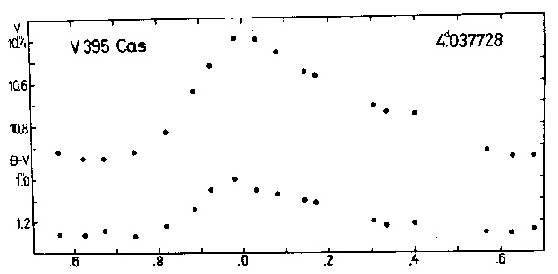 Figure 49 V and B-V curves of V 395 Cas
Table 30 O-C residuals for V 395 Cas
Obs.Max.J.D. E O-C Type w Source
2435343.705 -1636 +0.001d phg 2 Kholopov et al. (1968)
2441949.427 0 0.000 phel 3 present paper
SY Cassiopeiae
Figure 49 V and B-V curves of V 395 Cas
Table 30 O-C residuals for V 395 Cas
Obs.Max.J.D. E O-C Type w Source
2435343.705 -1636 +0.001d phg 2 Kholopov et al. (1968)
2441949.427 0 0.000 phel 3 present paper
SY Cassiopeiae
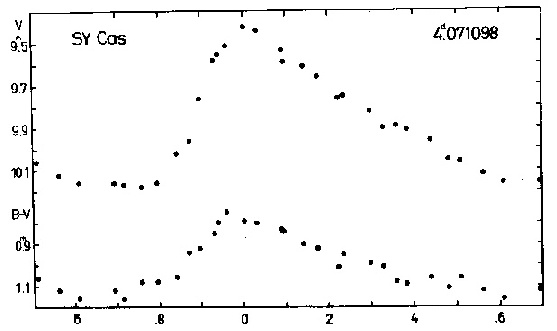 Figure 50 V and B-V curves of SY Cas
There is a faint companion SW at the variable within the diaphragm. The light and colour
curves on SY Cas are presented in Fig. 50. The O-C residuals have been computed with the formula:
C = 2441682.230 + 4.071098d*E .
Figure 50 V and B-V curves of SY Cas
There is a faint companion SW at the variable within the diaphragm. The light and colour
curves on SY Cas are presented in Fig. 50. The O-C residuals have been computed with the formula:
C = 2441682.230 + 4.071098d*E .
 Figure 51 O-C diagram of SY Cas
The O-C diagram (Fig. 51) shows a sudden period change at J.D. 2434000. The
corresponding periods are as follows:
before J.D. 2434000, P = 4.070969d ;
after J.D. 2434000, P = 4.071098d .
Table 31 O-C residuals for SY Cas
Obs.Max.J.D. E O-C Type w Source
2414605.8 -6651 +0.4d phg 0.5 Blazhko (1907b)
2416376.8 -6216 +0.5 phg 0.5 Blazhko (1907b)
2417121.9 -6033 +0.6 phg 0.5 Blazhko (1907b)
2417793.55 -5868 +0.52 phg 0.5 Blazhko (1907b)
2417911.2 -5839 +0.1 phg 0 Blazhko (1907b)
2417952.374 -5829 +0.574 vis 0.5 Luizet (1908)
2418229.18 -5761 +0.55 vis 0.5 Luizet (1913)
2418595.42 -5671 +0.39 vis 0.5 Luizet (1913)
2419047.38 -5560 +0.45 vis 0.5 Luizet (1913)
2419234.76 -5514 +0.56 vis 0.5 Luizet (1913)
2419336.475 -5489 +0.502 phg 1 Robinson (1931a)
2419466.81 -5457 +0.56 vis 0.5 Luizet (1913)
2419743.57 -5389 +0.49 vis 0.5 Luizet (1913)
2421131.676 -5048 +0.349 phg 2 Jordan (1929)
2425964.01 -3861 +0.29 phg 1 Oosterhoff (1935)
2426851.52 -3643 +0.30 phg 1 Oosterhoff (1935)
2427335.74 -3524 +0.06 phg 0.5 Oosterhoff (1935)
2428431.13 -3255 +0.32 phg 0.5 Fu (1964)
2430181.504 -2825 +0.126 vis 1 Conceicao-Silva (1950b)
2430433.905 -2763 +0.119 phg 1 Vasil'yanovskaya (1948)
2430629.53 -2715 +0.33 phg 0 Romano (1959)
2430678.192 -2703 +0.140 vis 0.5 Conceicao-Silva (1950b)
2430836.932 -2664 +0.107 phg 1 Solov'yov (1954)
2430979.55 -2629 +0.24 phg 0.5 Romano (1959)
2431146.305 -2588 +0.077 phg 2 Vasil'yanovskaya (1948)
2431687.72 -2455 +0.04 phg 0.5 Romano (1959)
2432041.82 -2368 -0.05 phg 0.5 Romano (1959)
2432127.439 -2347 +0.076 vis 0.5 Conceicao-Silva (1950b)
2432208.850 -2327 +0.065 phg 1 Vasil'yanovskaya (1948)
2432738.37 -2197 +0.34 phg 0 Romano (1959)
2432970.172 -2140 +0.092 phg 1 Solov'yov (1954)
2433121.25 -2103 +0.54 phg 0 Romano (1959)
Table 31 (cont.)
Obs.Max.J.D. E O-C Type w Source
2435083.29 -1621 +0.31d phg 0 Romano (1959)
2435413.05 -1540 +0.31 phg 0 Romano (1959)
2435721.87 -1464 -0.27 phg 0 Romano (1959)
2436809.135 -1197 -0.009 phel 3 Oosterhoff (1960)
2436833.544 -1191 +0.008 phel 3 Weaver et al. (1960)
2436906.850 -1173 +0.018 phel 3 Bahner et al. (1962)
2437045.355 -1139 +0.106 vis 0.5 Haussler (1973)
2437399.402 -1052 -0.033 vis 0.5 Haussler (1973)
2438144.399 -869 -0.047 vis 0.5 Haussler (1973)
2439056.378 -645 +0.006 vis 0.5 Haussler (1973)
2440151.424 -376 -0.073 vis 0.5 Haussler (1973)
2441682.236 0 +0.006 phel 3 present paper
2443041.968 +334 -0.009 phel 2 present paper
V 508 Monocerotis
This star has not previously been observed photoelectrically. The amplitude of
its light variation is small (see Fig. 52) but non-sinusoidal (resembling IR Cep). As
was discussed in the case of IR Cep, this phenomenon may be due to the presence of a
companion star or to the non-homogeneity of the group of cepheids with small amplitude.
As the ratio of amplitudes in yellow and blue lights for both IR Cep and V 508 Mon is close
to the value of the ratio derived for single cepheids (i.e. the possible companion star
would be of the same spectral type as the cepheid in both cases), the latter explanation
is more probable.
Figure 51 O-C diagram of SY Cas
The O-C diagram (Fig. 51) shows a sudden period change at J.D. 2434000. The
corresponding periods are as follows:
before J.D. 2434000, P = 4.070969d ;
after J.D. 2434000, P = 4.071098d .
Table 31 O-C residuals for SY Cas
Obs.Max.J.D. E O-C Type w Source
2414605.8 -6651 +0.4d phg 0.5 Blazhko (1907b)
2416376.8 -6216 +0.5 phg 0.5 Blazhko (1907b)
2417121.9 -6033 +0.6 phg 0.5 Blazhko (1907b)
2417793.55 -5868 +0.52 phg 0.5 Blazhko (1907b)
2417911.2 -5839 +0.1 phg 0 Blazhko (1907b)
2417952.374 -5829 +0.574 vis 0.5 Luizet (1908)
2418229.18 -5761 +0.55 vis 0.5 Luizet (1913)
2418595.42 -5671 +0.39 vis 0.5 Luizet (1913)
2419047.38 -5560 +0.45 vis 0.5 Luizet (1913)
2419234.76 -5514 +0.56 vis 0.5 Luizet (1913)
2419336.475 -5489 +0.502 phg 1 Robinson (1931a)
2419466.81 -5457 +0.56 vis 0.5 Luizet (1913)
2419743.57 -5389 +0.49 vis 0.5 Luizet (1913)
2421131.676 -5048 +0.349 phg 2 Jordan (1929)
2425964.01 -3861 +0.29 phg 1 Oosterhoff (1935)
2426851.52 -3643 +0.30 phg 1 Oosterhoff (1935)
2427335.74 -3524 +0.06 phg 0.5 Oosterhoff (1935)
2428431.13 -3255 +0.32 phg 0.5 Fu (1964)
2430181.504 -2825 +0.126 vis 1 Conceicao-Silva (1950b)
2430433.905 -2763 +0.119 phg 1 Vasil'yanovskaya (1948)
2430629.53 -2715 +0.33 phg 0 Romano (1959)
2430678.192 -2703 +0.140 vis 0.5 Conceicao-Silva (1950b)
2430836.932 -2664 +0.107 phg 1 Solov'yov (1954)
2430979.55 -2629 +0.24 phg 0.5 Romano (1959)
2431146.305 -2588 +0.077 phg 2 Vasil'yanovskaya (1948)
2431687.72 -2455 +0.04 phg 0.5 Romano (1959)
2432041.82 -2368 -0.05 phg 0.5 Romano (1959)
2432127.439 -2347 +0.076 vis 0.5 Conceicao-Silva (1950b)
2432208.850 -2327 +0.065 phg 1 Vasil'yanovskaya (1948)
2432738.37 -2197 +0.34 phg 0 Romano (1959)
2432970.172 -2140 +0.092 phg 1 Solov'yov (1954)
2433121.25 -2103 +0.54 phg 0 Romano (1959)
Table 31 (cont.)
Obs.Max.J.D. E O-C Type w Source
2435083.29 -1621 +0.31d phg 0 Romano (1959)
2435413.05 -1540 +0.31 phg 0 Romano (1959)
2435721.87 -1464 -0.27 phg 0 Romano (1959)
2436809.135 -1197 -0.009 phel 3 Oosterhoff (1960)
2436833.544 -1191 +0.008 phel 3 Weaver et al. (1960)
2436906.850 -1173 +0.018 phel 3 Bahner et al. (1962)
2437045.355 -1139 +0.106 vis 0.5 Haussler (1973)
2437399.402 -1052 -0.033 vis 0.5 Haussler (1973)
2438144.399 -869 -0.047 vis 0.5 Haussler (1973)
2439056.378 -645 +0.006 vis 0.5 Haussler (1973)
2440151.424 -376 -0.073 vis 0.5 Haussler (1973)
2441682.236 0 +0.006 phel 3 present paper
2443041.968 +334 -0.009 phel 2 present paper
V 508 Monocerotis
This star has not previously been observed photoelectrically. The amplitude of
its light variation is small (see Fig. 52) but non-sinusoidal (resembling IR Cep). As
was discussed in the case of IR Cep, this phenomenon may be due to the presence of a
companion star or to the non-homogeneity of the group of cepheids with small amplitude.
As the ratio of amplitudes in yellow and blue lights for both IR Cep and V 508 Mon is close
to the value of the ratio derived for single cepheids (i.e. the possible companion star
would be of the same spectral type as the cepheid in both cases), the latter explanation
is more probable.
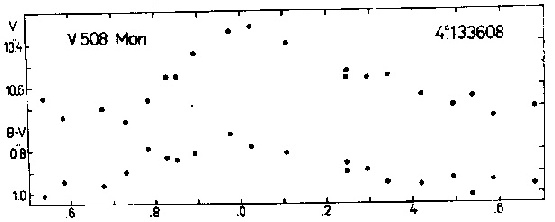 Figure 52 V and B-V curves of V 508 Mon
The O-C residuals have been computed with the formula:
C = 2441732.070 + 4.133608d*E .
As Fig. 53 shows, the period of V 508 Mon has remained constant since the discovery of
its light variation.
Figure 52 V and B-V curves of V 508 Mon
The O-C residuals have been computed with the formula:
C = 2441732.070 + 4.133608d*E .
As Fig. 53 shows, the period of V 508 Mon has remained constant since the discovery of
its light variation.
 Figure 53 O-C diagram of V 508 Mon
Table 32 O-C residuals for V 508 Mon
Obs.Max.J.D. E O-C Type w Source
2429343.80 -2997 +0.15d phg 0.5 Wachmann (1964)
2429670.23 -2918 +0.03 phg 0.5 Wachmann (1964)
2430021.53 -2833 -0.03 phg 0.5 Wachmann (1964)
2430699.44 -2669 -0.03 phg 0.5 Wachmann (1964)
2431116.93 -2568 -0.03 phg 0.5 Wachmann (1964)
2431852.67 -2390 -0.08 phg 0.5 Wachmann (1964)
2432233.03 -2298 -0.01 phg 0.5 Wachmann (1964)
2432948.14 -2125 -0.01 phg 0.5 Wachmann (1964)
2433332.53 -2032 -0.05 phg 0.5 Wachmann (1964)
2434068.40 -1854 +0.04 phg 0.5 Wachmann (1964)
2434444.56 -1763 +0.04 phg 0.5 Wachmann (1964)
2434775.15 -1683 -0.06 phg 0.5 Wachmann (1964)
2435163.80 -1589 +0.03 phg 0.5 Wachmann (1964)
2435453.15 -1519 +0.03 phg 0.5 Wachmann (1964)
2437693.63 -977 +0.10 phg 0.5 Wachmann (1964)
2441732.043 0 -0.027 phel 3 present paper
SX Persei
Figure 53 O-C diagram of V 508 Mon
Table 32 O-C residuals for V 508 Mon
Obs.Max.J.D. E O-C Type w Source
2429343.80 -2997 +0.15d phg 0.5 Wachmann (1964)
2429670.23 -2918 +0.03 phg 0.5 Wachmann (1964)
2430021.53 -2833 -0.03 phg 0.5 Wachmann (1964)
2430699.44 -2669 -0.03 phg 0.5 Wachmann (1964)
2431116.93 -2568 -0.03 phg 0.5 Wachmann (1964)
2431852.67 -2390 -0.08 phg 0.5 Wachmann (1964)
2432233.03 -2298 -0.01 phg 0.5 Wachmann (1964)
2432948.14 -2125 -0.01 phg 0.5 Wachmann (1964)
2433332.53 -2032 -0.05 phg 0.5 Wachmann (1964)
2434068.40 -1854 +0.04 phg 0.5 Wachmann (1964)
2434444.56 -1763 +0.04 phg 0.5 Wachmann (1964)
2434775.15 -1683 -0.06 phg 0.5 Wachmann (1964)
2435163.80 -1589 +0.03 phg 0.5 Wachmann (1964)
2435453.15 -1519 +0.03 phg 0.5 Wachmann (1964)
2437693.63 -977 +0.10 phg 0.5 Wachmann (1964)
2441732.043 0 -0.027 phel 3 present paper
SX Persei
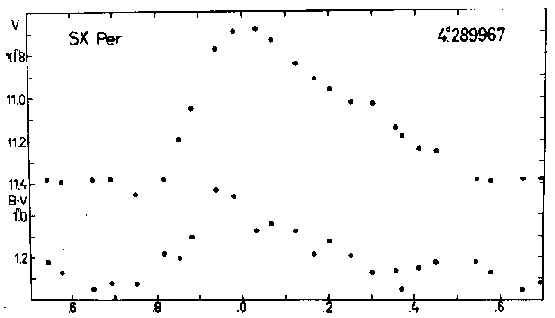 Figure 54 V and B-V curves of SX Per
The light and colour curves for this variable are shown in Fig. 54. The O-C
residuals are computed with the formula:
C = 2441847.979 + 4.1289967d*E .
As Fig. 55 shows, the period of SX Per has remained constant since the beginning of
this century.
Figure 54 V and B-V curves of SX Per
The light and colour curves for this variable are shown in Fig. 54. The O-C
residuals are computed with the formula:
C = 2441847.979 + 4.1289967d*E .
As Fig. 55 shows, the period of SX Per has remained constant since the beginning of
this century.
 Figure 55 O-C diagram of SX Per
Table 33 O-C residuals for SX Per
Obs.Max.J.D. E O-C Type w Source
2418210.070 -5510 -0.191d phg 0.5 Kukarkin (1931b)
2418390.436 -5468 -0.003 vis 0.5 Enebo (1911)
2418647.85 -5408 +0.01 phg 0.5 Oosterhoff (1935)
2419810.411 -5137 -0.008 vis 0.5 Nijland (1923)
2420127.795 -5063 -0.081 vis 0.5 Nijland (1923)
2420475.343 -4982 -0.020 vis 0.5 Nijland (1923)
2420857.163 -4893 -0.007 vis 1 Nijland (1923)
2421161.80 -4822 +0.04 phg 0.5 Oosterhoff (1935)
2421187.512 -4816 +0.014 vis 1 Nijland (1923)
2421638.07 -4711 +0.13 phg 0.5 Oosterhoff (1935)
2425692.20 -3766 +0.24 phg 0.5 Oosterhoff (1935)
2425966.69 -3702 +0.17 phg 0.5 Oosterhoff (1935)
2427064.69 -3446 -0.06 phg 0.5 Oosterhoff (1935)
2429145.60 -2961 +0.21 phg 0.5 Kurochkin (1950)
2436815.866 -1173 +0.018 phel 3 Weaver et al. (1960)
2436845.854 -1166 -0.023 phel 2 Oosterhoff (1960)
2441847.956 0 -0.023 phel 3 present paper
Y Lacertae
Table 34 O-C residuals for Y Lac
Obs.Max.J.D. E O-C Type w Source
2417615.86 -5581 +0.11d phg 0.5 Blazhko (1907a)
2417715.193 -5558 -0.005 vis 0.5 Ichinohe (1909)
2417944.323 -5505 -0.035 vis 0.5 Zeipel (1908)
2418216.813 -5442 +0.057 vis 0.5 Ichinohe (1909)
2418424.295 -5394 -0.002 phg 0.5 Robinson (1930)
2421658.488 -4646 +0.006 phg 2 Jordan (1929)
2421818.386 -4609 -0.075 phg 2 Martin, Plummer (1919)
2424758.640 -3929 +0.011 vis 0.5 Schneller (1928)
2426228.749 -3589 +0.036 phg 0.5 Nekrasova (1938)
2429102.45 -2924 -1.57 phg 0 Shakhovskoj (1949)
2433125.147 -1994 +0.011 phel 3 Eggen (1951)
2433609.468 -1882 +0.069 phg 1 Solov'yov (1952b)
Table 34 (cont.)
Obs.Max.J.D. E O-C Type w Source
2436834.936 -1136 +01001 phel 3 Bahner et al. (1962)
2437366.745 -1013 -0.015 phel 3 Mitchell et al. (1964)
2441746.720 0 -0.025 phel 3 present paper
The light and colour curves for this variable are shown in Fig. 56. According
to Madore (1977), Y Lac has a blue photometric companion. The O-C residuals have been
calculated with the formula:
C = 2441746.745 + 4.323776d*E .
Figure 55 O-C diagram of SX Per
Table 33 O-C residuals for SX Per
Obs.Max.J.D. E O-C Type w Source
2418210.070 -5510 -0.191d phg 0.5 Kukarkin (1931b)
2418390.436 -5468 -0.003 vis 0.5 Enebo (1911)
2418647.85 -5408 +0.01 phg 0.5 Oosterhoff (1935)
2419810.411 -5137 -0.008 vis 0.5 Nijland (1923)
2420127.795 -5063 -0.081 vis 0.5 Nijland (1923)
2420475.343 -4982 -0.020 vis 0.5 Nijland (1923)
2420857.163 -4893 -0.007 vis 1 Nijland (1923)
2421161.80 -4822 +0.04 phg 0.5 Oosterhoff (1935)
2421187.512 -4816 +0.014 vis 1 Nijland (1923)
2421638.07 -4711 +0.13 phg 0.5 Oosterhoff (1935)
2425692.20 -3766 +0.24 phg 0.5 Oosterhoff (1935)
2425966.69 -3702 +0.17 phg 0.5 Oosterhoff (1935)
2427064.69 -3446 -0.06 phg 0.5 Oosterhoff (1935)
2429145.60 -2961 +0.21 phg 0.5 Kurochkin (1950)
2436815.866 -1173 +0.018 phel 3 Weaver et al. (1960)
2436845.854 -1166 -0.023 phel 2 Oosterhoff (1960)
2441847.956 0 -0.023 phel 3 present paper
Y Lacertae
Table 34 O-C residuals for Y Lac
Obs.Max.J.D. E O-C Type w Source
2417615.86 -5581 +0.11d phg 0.5 Blazhko (1907a)
2417715.193 -5558 -0.005 vis 0.5 Ichinohe (1909)
2417944.323 -5505 -0.035 vis 0.5 Zeipel (1908)
2418216.813 -5442 +0.057 vis 0.5 Ichinohe (1909)
2418424.295 -5394 -0.002 phg 0.5 Robinson (1930)
2421658.488 -4646 +0.006 phg 2 Jordan (1929)
2421818.386 -4609 -0.075 phg 2 Martin, Plummer (1919)
2424758.640 -3929 +0.011 vis 0.5 Schneller (1928)
2426228.749 -3589 +0.036 phg 0.5 Nekrasova (1938)
2429102.45 -2924 -1.57 phg 0 Shakhovskoj (1949)
2433125.147 -1994 +0.011 phel 3 Eggen (1951)
2433609.468 -1882 +0.069 phg 1 Solov'yov (1952b)
Table 34 (cont.)
Obs.Max.J.D. E O-C Type w Source
2436834.936 -1136 +01001 phel 3 Bahner et al. (1962)
2437366.745 -1013 -0.015 phel 3 Mitchell et al. (1964)
2441746.720 0 -0.025 phel 3 present paper
The light and colour curves for this variable are shown in Fig. 56. According
to Madore (1977), Y Lac has a blue photometric companion. The O-C residuals have been
calculated with the formula:
C = 2441746.745 + 4.323776d*E .
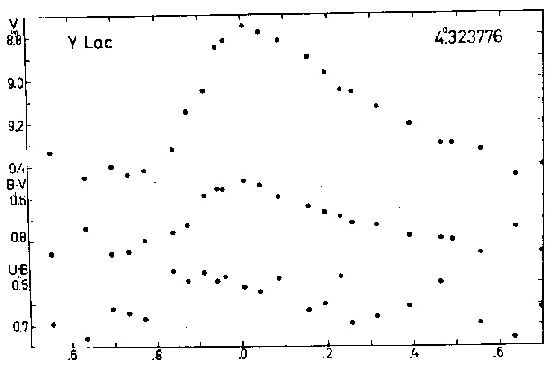 Figure 56 V, B-V and U-B curves of Y Lac
Figure 56 V, B-V and U-B curves of Y Lac
 Figure 57 O-C diagram of Y Lac
The O-C diagram (Fig. 57) is a straight line, i.e. the period is constant.
V 402 Cygni
The light and colour curves of this variable are shown in Fig. 58. The O-C
residuals have been computed with the formula:
C = 2441698.635 + 4.364836d*E .
These residuals which are plotted in Fig. 59 show constant period.
Figure 57 O-C diagram of Y Lac
The O-C diagram (Fig. 57) is a straight line, i.e. the period is constant.
V 402 Cygni
The light and colour curves of this variable are shown in Fig. 58. The O-C
residuals have been computed with the formula:
C = 2441698.635 + 4.364836d*E .
These residuals which are plotted in Fig. 59 show constant period.
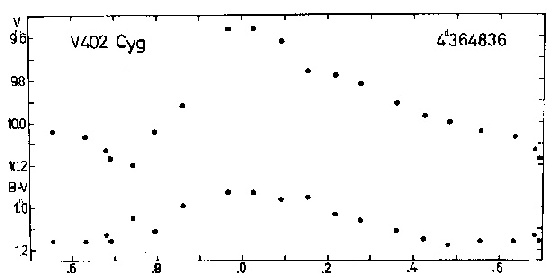 Figure 58 V and B-V curves of V 402 Cyg
Figure 58 V and B-V curves of V 402 Cyg
 Figure 59 O-C diagram of V 402 Cyg
Table 35 O-C residuals for V 402 Cyg
Obs.Max.J.D. E O-C Type w Source
2413841.80 -6382 -0145 phg 0 Ikauniex (1946)
2414606.10 -6207 0.00 phg 0.5 Ikauniex (1946)
2415287.05 -6051 +0.04 phg 0.5 Ikauniex (1946)
2417613.45 -5518 -0.02 phg 0.5 Ikauniex (1946)
2418586.80 -5295 -0.03 phg 0.5 Ikauniex (1946)
2428717.71 -2974 +0.10 phg 0.5 Ikauniex (1946)
2428748.30 -2967 +0.13 phg 0.5 Suzuki, Huruhata (1938)
2430166.83 -2642 +0.09 phg 0.5 Ashbrook (1941)
2430446.124 -2578 +0.036 phg 0.5 Solov'yov (1946)
2430651.211 -2531 -0.024 phg 0.5 Filatov (1957)
2430956.765 -2461 -0.009 phg 1 Solov'yov (1946)
2430961.19 -2460 +0.05 phg 0.5 Ikauniex (1946)
2431410.654 -2357 -0.063 phg 0.5 Solov'yov (1946)
2431655.134 -2301 -0.013 phg 0.5 Filatov (1957)
Table 35 (cont.)
Obs.Max.J.D. E O-C Type w Source
2432794.380 -2040 +0.010d phg 0.5 Filatov (1957)
2433121.697 -1965 -0.035 phg 0.5 Filatov (1957)
2433649.937 -1844 +0.060 phg 1 Filatov (1957)
2433890.004 -1789 +0.061 phg 0.5 Shteiman (1958)
2434400.571 -1672 -0.058 phg 1 Filatov (1957)
2434448.650 -1661 +0.008 phg 0.5 Shteiman (1958)
2435334.826 -1458 +0.122 phg 0.5 Filatov (1957)
2435692.675 -1376 +0.054 phg 1 Shteiman (1958)
2436761.948 -1131 -0.057 phel 3 Oosterhoff (1960)
2437307.560 -1006 -0.050 phel 3 Mitchell et al. (1964)
2439743.193 -448 +0.005 phel 3 Takase (1969)
2441698.620 0 -0.015 phel 3 present paper
T Vulpeculae
The light and colour curves for this cepheid are shown in Fig. 60. The O-C
residuals have been calculated with the formula:
C = 2441705.121 + 4.435462d*E .
Figure 59 O-C diagram of V 402 Cyg
Table 35 O-C residuals for V 402 Cyg
Obs.Max.J.D. E O-C Type w Source
2413841.80 -6382 -0145 phg 0 Ikauniex (1946)
2414606.10 -6207 0.00 phg 0.5 Ikauniex (1946)
2415287.05 -6051 +0.04 phg 0.5 Ikauniex (1946)
2417613.45 -5518 -0.02 phg 0.5 Ikauniex (1946)
2418586.80 -5295 -0.03 phg 0.5 Ikauniex (1946)
2428717.71 -2974 +0.10 phg 0.5 Ikauniex (1946)
2428748.30 -2967 +0.13 phg 0.5 Suzuki, Huruhata (1938)
2430166.83 -2642 +0.09 phg 0.5 Ashbrook (1941)
2430446.124 -2578 +0.036 phg 0.5 Solov'yov (1946)
2430651.211 -2531 -0.024 phg 0.5 Filatov (1957)
2430956.765 -2461 -0.009 phg 1 Solov'yov (1946)
2430961.19 -2460 +0.05 phg 0.5 Ikauniex (1946)
2431410.654 -2357 -0.063 phg 0.5 Solov'yov (1946)
2431655.134 -2301 -0.013 phg 0.5 Filatov (1957)
Table 35 (cont.)
Obs.Max.J.D. E O-C Type w Source
2432794.380 -2040 +0.010d phg 0.5 Filatov (1957)
2433121.697 -1965 -0.035 phg 0.5 Filatov (1957)
2433649.937 -1844 +0.060 phg 1 Filatov (1957)
2433890.004 -1789 +0.061 phg 0.5 Shteiman (1958)
2434400.571 -1672 -0.058 phg 1 Filatov (1957)
2434448.650 -1661 +0.008 phg 0.5 Shteiman (1958)
2435334.826 -1458 +0.122 phg 0.5 Filatov (1957)
2435692.675 -1376 +0.054 phg 1 Shteiman (1958)
2436761.948 -1131 -0.057 phel 3 Oosterhoff (1960)
2437307.560 -1006 -0.050 phel 3 Mitchell et al. (1964)
2439743.193 -448 +0.005 phel 3 Takase (1969)
2441698.620 0 -0.015 phel 3 present paper
T Vulpeculae
The light and colour curves for this cepheid are shown in Fig. 60. The O-C
residuals have been calculated with the formula:
C = 2441705.121 + 4.435462d*E .
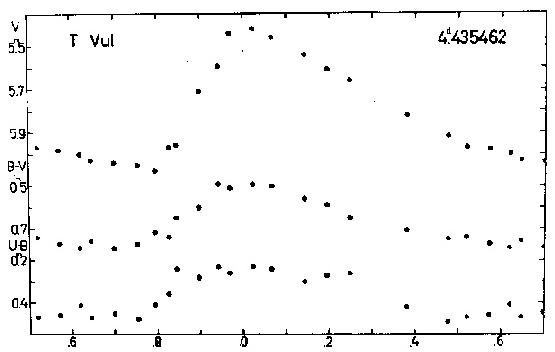 Figure 60 V, B-V and U-B curves of T Vul
The O-C diagram in Fig. 61 shows a small change in the period of T Vul at J.D. 2434000.
The value of the period before J.D. 2417000 is rather uncertain. The other values of
the period are as follows:
between J.D. 2417000 and J.D. 2434000, P = 4.435589d ;
after J.D. 2434000. P = 4.435462d .
Figure 60 V, B-V and U-B curves of T Vul
The O-C diagram in Fig. 61 shows a small change in the period of T Vul at J.D. 2434000.
The value of the period before J.D. 2417000 is rather uncertain. The other values of
the period are as follows:
between J.D. 2417000 and J.D. 2434000, P = 4.435589d ;
after J.D. 2434000. P = 4.435462d .
 Figure 61 O-C diagram of T Vul
Table 36 O-C residuals for T Vul
Obs.Max.J.D. E O-C Type w Source
2409884.531 -7174 -0.586d vis 0.5 Sawyer (1889)
2409897.709 -7171 -0.714 vis 0.5 Chandler (1886)
2410101.830 -7125 -0.624 vis 0.5 Chandler (1886)
2410199.373 -7103 -0.661 vis 0.5 Sawyer (1889)
2410212.91 -7100 -0.43 vis 0.5 Prager^1 (1936)
2410545.403 -7025 -0.557 vis 0.5 Sawyer (1896)
2410904.747 -6944 -0.526 vis 0.5 Sawyer (1896)
2410922.543 -6940 -0.472 vis 0.5 Yendell (1889)
2411272.927 -6861 -0.489 vis 0.5 Sawyer (1896)
2411313.392 -6852 +0.057 vis 0 Yendell (1890)
2411605.959 -6786 -0.117 vis 0.5 Yendell (1891)
2411991.774 -6699 -0.187 vis 0.5 Yendell (1893)
2412351.012 -6618 -0.221 vis 0.5 Yendell (1894)
2412404.048 -6606 -0.411 vis 0.5 Sawyer (1896)
2412670.178 -6546 -0.409 vis 0.5 Yendell (1895a)
2412736.725 -6531 -0.394 vis 0.5 Sawyer (1896)
2413056.175 -6459 -0.297 vis 0.5 Yendell (1895b)
2413096.011 -6450 -0.380 vis 0.5 Sawyer (1896)
2413761.565 -6300 -0.145 vis 0.5 Yendell (1897)
2414098.541 -6224 -0.265 vis 0.5 Yendell (1901)
2414213.467 -6198 -0.661 vis 0.5 Pickering (1907)
2414546.374 -6123 -0.413 vis 0.5 Luizet (1912)
2414870.265 -6050 -0.311 vis 0.5 Yendell (1901)
2414892.283 -6045 -0.470 vis 0.5 Luizet (1912)
2415211.636 -5973 -0.470 vis 0.5 Luizet (1912)
2415570.948 -5892 -0.431 vis 0.5 Luizet (1912)
2415801.604 -5840 -0.419 vis 0.5 Tass (1909)
2415925.05 -5812 -1.17 vis 0 Yendell (1905)
2415987.800 -5798 -0.512 vis 0.5 Luizet (1912)
2416120.895 -5768 -0.481 vis 0.5 Tass (1904)
2416324.921 -5722 -0.488 vis 0.5 Luizet (1912)
2416710.960 -5635 -0.333 vis 0.5 Terkan (1905)
2416715.297 -5634 -0.431 vis 0.5 Luizet (1912)
2417065.499 -5555 -0.631 vis 0.5 Luizet (1912)
2417069.989 -5554 -0.576 phg 0.5 Wilkens (1906)
2417433.887 -5472 -0.386 vis 0.5 Luizet (1912)
2417757.672 -5399 -0.390 vis 0.5 Zeipel (1908)
2417806.307 -5388 -0.545 vis 0.5 Luizet (1912)
2417872.917 -5373 -0.467 vis 1 Nijland (1923)
2418192.402 -5301 -0.335 vis 0.5 Luizet (1912)
Table 36 (cont.)
Obs.Max.J.D. E O-C Type w Source
2418196.696 -5300 -0.476d vis 1 Nijland (1923)
2418516.031 -5228 -0.495 vis 1 Nijland (1923)
2418551.555 -5220 -0.454 vis 0.5 Luizet (1912)
2418937.503 -5133 -0.392 vis 0.5 Luizet (1912)
2419283.487 -5055 -0.374 vis 0.5 Luizet (1912)
2419656.159 -4971 -0.280 phg 0.5 Robinson (1931a)
2419833.616 -4931 -0.242 vis 0.5 Dziewulski (1925)
2420001.954 -4893 -0.451 phg 1 Hertzsprung (1919)
2420747.163 -4725 -0.400 phg 1 Hertzsprung (1919)
2420813.763 -4710 -0.332 vis 0.5 Luyten (1922)
2421110.716 -4643 -0.555 vis 0.5 Luyten (1922)
2421439.068 -4569 -0.427 vis 0.5 Luyten (1922)
2421922.671 -4460 -0.289 vis 0.5 Luyten (1922)
2422641.203 -4298 -0.302 vis 0.5 Doberck (1924a)
2423333.034 -4149 -0.355 vis 0.5 Hellerich (1928b)
2423670.279 -4066 -0.254 vis 0.5 Hellerich (1928b)
2423674.582 -4065 -0.386 vis 0.5 Hopmann (1924)
2424029.526 -3985 -0.279 vis 0.5 Hellerich (1928b)
2424375.465 -3907 -0.306 phel 3 Huffer (1928a)
2424384.452 -3905 -0.190 vis 0.5 Hellerich (1928b)
2424721.445 -3829 -0.292 phel 3 Huffer (1928a)
2424770.258 -3818 -0.269 vis 0.5 Kukarkin (1940)
2425067.340 -3751 -0.363 vis 0.5 Kukarkin (1940)
2425116.349 -3740 -0.144 phg 2 Hellerich (1935)
2425218.28 -3717 -0.23 vis 0.5 Lause (1938)
2425426.662 -3670 -0.313 vis 0.5 Kukarkin (1940)
2425448.942 -3665 -0.211 vis 1 Zverev (1936)
2425701.800 -3608 -0.174 vis 0.5 Dziewulski et al. (1932)
2425781.623 -3590 -0.189 vis 1 Zverev (1936)
2425826.001 -3580 -0.166 vis 0.5 Kukarkin (1940)
2426531.289 -3421 -0.116 vis 0.5 Kukarkin (1940)
2426540.081 -3419 -0.195 vis 1 Zverev (1936)
2426859.380 -3347 -0.250 phg 2 Kox (1935)
2427289.6 -3250 -0.3 vis 0.5 Miczaika (1934)
2427875.176 -3118 -0.174 vis 0.5 Miczaika (1937)
2428451.646 -2988 -0.315 vis 1 Kepinski (1937)
2429631.665 -2722 -0.128 vis 0.5 Mandre (1950,1951)
2430004.44 -2638 +0.07 vis 0.5 Conceicao-Silva (1948)
2432967.224 -1970 -0.037 phel 3 Eggen (1951)
2434595.171 -1603 +0.096 phel 1 present paper
2434701.51 -1579 -0.02 vis 0.5 MarkS^3 (1959)
2435216.19 -1463 +0.15 vis 0.5 Marks (1959)
2435362.383 -1430 -0.027 phel 1 Walraven et al. (1958)
2435380.378 -1426 +0.226 vis 0.5 Azarnova (1957)
2435757.163 -1341 -0.003 phel 3 Prokof'eva (1961)
2436098.622 -1264 -0.075 phel 2 Svolopoulos (1960)
2436214.045 -1238 +0.026 vis 0.5 Latyshev (1969)
2437212.010 -1013 +0.012 phel 2 Mitchell et al. (1964)
2437562.372 -934 -0.027 phel 3 Johansen (1971)
2437939.516 -849 +0.102 phel 1 Williams (1966)
2438649.080 -689 -0.008 phel 3 Johansen (1971)
2438733.347 -670 -0.014 phel 2 Wisniewski et al. (1968)
2441705.118 0 -0.003 phel 3 present paper
Remarks: 1 Observer: Gore; 2 Obs.: Detre; 3 Obs.: Wroblewski.
FF Aquilae
This cepheid is a component of a spectroscopic binary system with an orbital
period of 1435 days (Abt 1959). Its light and colour curves are presented in Fig. 62.
The small bump before the minimum brightness seems to be real because it appears in all
three colours and its presence can be suspected from some earlier photoelectric light
curves, as well. The appearance of a bump at this phase is a unique phenomenon among
the cepheids with such a short period.
Figure 61 O-C diagram of T Vul
Table 36 O-C residuals for T Vul
Obs.Max.J.D. E O-C Type w Source
2409884.531 -7174 -0.586d vis 0.5 Sawyer (1889)
2409897.709 -7171 -0.714 vis 0.5 Chandler (1886)
2410101.830 -7125 -0.624 vis 0.5 Chandler (1886)
2410199.373 -7103 -0.661 vis 0.5 Sawyer (1889)
2410212.91 -7100 -0.43 vis 0.5 Prager^1 (1936)
2410545.403 -7025 -0.557 vis 0.5 Sawyer (1896)
2410904.747 -6944 -0.526 vis 0.5 Sawyer (1896)
2410922.543 -6940 -0.472 vis 0.5 Yendell (1889)
2411272.927 -6861 -0.489 vis 0.5 Sawyer (1896)
2411313.392 -6852 +0.057 vis 0 Yendell (1890)
2411605.959 -6786 -0.117 vis 0.5 Yendell (1891)
2411991.774 -6699 -0.187 vis 0.5 Yendell (1893)
2412351.012 -6618 -0.221 vis 0.5 Yendell (1894)
2412404.048 -6606 -0.411 vis 0.5 Sawyer (1896)
2412670.178 -6546 -0.409 vis 0.5 Yendell (1895a)
2412736.725 -6531 -0.394 vis 0.5 Sawyer (1896)
2413056.175 -6459 -0.297 vis 0.5 Yendell (1895b)
2413096.011 -6450 -0.380 vis 0.5 Sawyer (1896)
2413761.565 -6300 -0.145 vis 0.5 Yendell (1897)
2414098.541 -6224 -0.265 vis 0.5 Yendell (1901)
2414213.467 -6198 -0.661 vis 0.5 Pickering (1907)
2414546.374 -6123 -0.413 vis 0.5 Luizet (1912)
2414870.265 -6050 -0.311 vis 0.5 Yendell (1901)
2414892.283 -6045 -0.470 vis 0.5 Luizet (1912)
2415211.636 -5973 -0.470 vis 0.5 Luizet (1912)
2415570.948 -5892 -0.431 vis 0.5 Luizet (1912)
2415801.604 -5840 -0.419 vis 0.5 Tass (1909)
2415925.05 -5812 -1.17 vis 0 Yendell (1905)
2415987.800 -5798 -0.512 vis 0.5 Luizet (1912)
2416120.895 -5768 -0.481 vis 0.5 Tass (1904)
2416324.921 -5722 -0.488 vis 0.5 Luizet (1912)
2416710.960 -5635 -0.333 vis 0.5 Terkan (1905)
2416715.297 -5634 -0.431 vis 0.5 Luizet (1912)
2417065.499 -5555 -0.631 vis 0.5 Luizet (1912)
2417069.989 -5554 -0.576 phg 0.5 Wilkens (1906)
2417433.887 -5472 -0.386 vis 0.5 Luizet (1912)
2417757.672 -5399 -0.390 vis 0.5 Zeipel (1908)
2417806.307 -5388 -0.545 vis 0.5 Luizet (1912)
2417872.917 -5373 -0.467 vis 1 Nijland (1923)
2418192.402 -5301 -0.335 vis 0.5 Luizet (1912)
Table 36 (cont.)
Obs.Max.J.D. E O-C Type w Source
2418196.696 -5300 -0.476d vis 1 Nijland (1923)
2418516.031 -5228 -0.495 vis 1 Nijland (1923)
2418551.555 -5220 -0.454 vis 0.5 Luizet (1912)
2418937.503 -5133 -0.392 vis 0.5 Luizet (1912)
2419283.487 -5055 -0.374 vis 0.5 Luizet (1912)
2419656.159 -4971 -0.280 phg 0.5 Robinson (1931a)
2419833.616 -4931 -0.242 vis 0.5 Dziewulski (1925)
2420001.954 -4893 -0.451 phg 1 Hertzsprung (1919)
2420747.163 -4725 -0.400 phg 1 Hertzsprung (1919)
2420813.763 -4710 -0.332 vis 0.5 Luyten (1922)
2421110.716 -4643 -0.555 vis 0.5 Luyten (1922)
2421439.068 -4569 -0.427 vis 0.5 Luyten (1922)
2421922.671 -4460 -0.289 vis 0.5 Luyten (1922)
2422641.203 -4298 -0.302 vis 0.5 Doberck (1924a)
2423333.034 -4149 -0.355 vis 0.5 Hellerich (1928b)
2423670.279 -4066 -0.254 vis 0.5 Hellerich (1928b)
2423674.582 -4065 -0.386 vis 0.5 Hopmann (1924)
2424029.526 -3985 -0.279 vis 0.5 Hellerich (1928b)
2424375.465 -3907 -0.306 phel 3 Huffer (1928a)
2424384.452 -3905 -0.190 vis 0.5 Hellerich (1928b)
2424721.445 -3829 -0.292 phel 3 Huffer (1928a)
2424770.258 -3818 -0.269 vis 0.5 Kukarkin (1940)
2425067.340 -3751 -0.363 vis 0.5 Kukarkin (1940)
2425116.349 -3740 -0.144 phg 2 Hellerich (1935)
2425218.28 -3717 -0.23 vis 0.5 Lause (1938)
2425426.662 -3670 -0.313 vis 0.5 Kukarkin (1940)
2425448.942 -3665 -0.211 vis 1 Zverev (1936)
2425701.800 -3608 -0.174 vis 0.5 Dziewulski et al. (1932)
2425781.623 -3590 -0.189 vis 1 Zverev (1936)
2425826.001 -3580 -0.166 vis 0.5 Kukarkin (1940)
2426531.289 -3421 -0.116 vis 0.5 Kukarkin (1940)
2426540.081 -3419 -0.195 vis 1 Zverev (1936)
2426859.380 -3347 -0.250 phg 2 Kox (1935)
2427289.6 -3250 -0.3 vis 0.5 Miczaika (1934)
2427875.176 -3118 -0.174 vis 0.5 Miczaika (1937)
2428451.646 -2988 -0.315 vis 1 Kepinski (1937)
2429631.665 -2722 -0.128 vis 0.5 Mandre (1950,1951)
2430004.44 -2638 +0.07 vis 0.5 Conceicao-Silva (1948)
2432967.224 -1970 -0.037 phel 3 Eggen (1951)
2434595.171 -1603 +0.096 phel 1 present paper
2434701.51 -1579 -0.02 vis 0.5 MarkS^3 (1959)
2435216.19 -1463 +0.15 vis 0.5 Marks (1959)
2435362.383 -1430 -0.027 phel 1 Walraven et al. (1958)
2435380.378 -1426 +0.226 vis 0.5 Azarnova (1957)
2435757.163 -1341 -0.003 phel 3 Prokof'eva (1961)
2436098.622 -1264 -0.075 phel 2 Svolopoulos (1960)
2436214.045 -1238 +0.026 vis 0.5 Latyshev (1969)
2437212.010 -1013 +0.012 phel 2 Mitchell et al. (1964)
2437562.372 -934 -0.027 phel 3 Johansen (1971)
2437939.516 -849 +0.102 phel 1 Williams (1966)
2438649.080 -689 -0.008 phel 3 Johansen (1971)
2438733.347 -670 -0.014 phel 2 Wisniewski et al. (1968)
2441705.118 0 -0.003 phel 3 present paper
Remarks: 1 Observer: Gore; 2 Obs.: Detre; 3 Obs.: Wroblewski.
FF Aquilae
This cepheid is a component of a spectroscopic binary system with an orbital
period of 1435 days (Abt 1959). Its light and colour curves are presented in Fig. 62.
The small bump before the minimum brightness seems to be real because it appears in all
three colours and its presence can be suspected from some earlier photoelectric light
curves, as well. The appearance of a bump at this phase is a unique phenomenon among
the cepheids with such a short period.
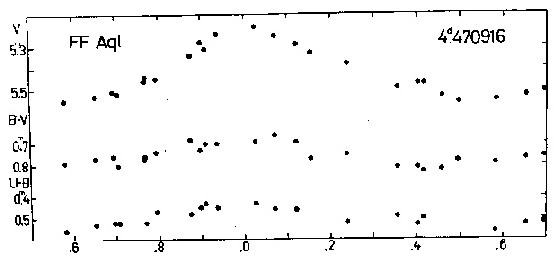 Figure 62 V, B-V and U-B curves of FF Aql
Figure 62 V, B-V and U-B curves of FF Aql
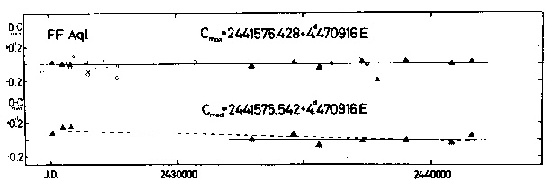 Figure 63 O-C diagram of FF Aql
The O-C residuals have been computed with the formulae;
C_{max} = 2441576.428 + 4.470916d*E ;
C_{med} = 2441575.542 + 4.470916d*E .
These residuals are shown in Fig. 63 . It can be seen from this figure that either the
period determined from the O-C diagram of the median brightness (P = 4.470886d) differs
from the period valid
Table 37 O-C residuals for FF Aql
Obs.Max.J.D. Obs.Med.J.D. E O-C O-C Type w Source
max med
2424703.102 -3774 -0.089d vis 1 Kukarkin (1931b)
2425096.650 2425095.823 -3686 +0.018 +0.077d phel 3 Huffer (1931)
2425490.067 2425489.334 -3598 -0.005 +0.148 phel 3 Huffer (1931)
2425735.99 -3543 +0.02 vis 1 Kukarkin (1929)
2425803.008 -3528 -0.028 vis 1 Kukarkin (1940)
2425811.968 2425811.248 -3526 -0.010 +0.156 phel 3 Huffer (1931)
2425973.030 -3490 +0.099 vis 0.5 Zverev (1936)
2426433.462 -3387 +0.026 vis 1 Kukarkin (1940)
2426495.904 -3373 -0.124 vis 1 Selivanov (1935)
2426504.899 -3371 -0.071 vis 1 Loreta (1933)
2426540.654 -3363 -0.083 vis 1 Zverev (1936)
2426594.117 -3351 -0.271 vis 0 Dufay (1947b)
2426867.069 -3290 -0.045 vis 1 Loreta (1933)
2427068.35 -3245 +0.04 vis 1 Selivanov (1934)
2427202.382 -3215 -0.051 vis 1 Selivanov (1935)
2427627.007 -3120 -0.163 vis 1 Selivanov (1935)
2427658.447 -3113 -0.019 vis 1 Krebs (1935)
2430703.186 -2432 +0.026 vis 1 Dziewulski (1962)
2432960.946 2432960.088 -1927 -0.027 +0.001 phel 3 Eggen (1951)
2434611.17 -1558 +0.43 vis 0 Marks^1 (1959)
2434628.641 2434627.796 -1554 +0.016 +0.057 phel 3 present paper^2
2435625.598 2435624.685 -1331 -0.041 -0.068 phel 3 Walraven et al. (1958)
2436099.567 -1225 +0.011 phel 2 Svolopoulos (1960)
2437199.443 -979 +0.042 vis 1 Makarenko^3 (1968)
2437320.127 2437319.215 -952 +0.011 -0.015 phel 3 Mitchell et al. (1964)
2437494.473 -913 -0.009 vis 1 Makarenko^3 (1968)
2437878.791 -827 -0.189 phel 1 Williams (1966)
2439019.100 2439018.170 -572 +0.036 -0.008 phel 3 Wisniewski, Johnson (1968)
2440811.901 2440810.980 -171 0.000 -0.035 phel 3 Pel (1976)
2441576.448 2441575.590 0 +0.020 +0.048 phel 3 present paper
Remarks: 1 Observer: Wroblewski; 2 Observer: Detre; 3 Observer: Kiperman
for the maximum brightness or a phase jump took place at the median brightness.
This phenomenon has already been discussed in the case of SU Cygni.
A worthy subject for further investigations would be to determine whether there
is some kind of connection between the mentioned peculiarities (variable steepness of
the rising branch, bump on the light curve) and the presence of a magnetic field at
this star (Babcock 1958). The points in the O-C diagrams in Fig. 63 derived from
photoelectric observations show larger scatter than expected. This scatter is a result
of the orbital motion of FF Aql around the centre of mass of the binary system. Let us
examine the deviations of the O-C residuals (derived from photoelectric observations)
from the expected value of O-C (solid line at the upper O-C diagram in Fig. 63). These
deviations and the related orbital phases are listed in Table 38. The orbital phases
are computed with the formula:
Epoch + phase = (J.D. - 2420000) * 0.0006969 .
Table 38
Max. Obs. Delta(O-C) Phase Max. Obs. delta(O-C) Phase
2425096.650 +0.018d .55 2435625.598 -0.041d .89
2425490.081 -0.005 .83 2437320.127 +0.011 .07
2425811.968 -0.010 .05 2439019.100 +0.036 .25
2432960.946 -0.027 .03 2440811.901 0.000 .50
2434628.641 +0.016 .19 2441576.448 +0.020 .04
Figure 63 O-C diagram of FF Aql
The O-C residuals have been computed with the formulae;
C_{max} = 2441576.428 + 4.470916d*E ;
C_{med} = 2441575.542 + 4.470916d*E .
These residuals are shown in Fig. 63 . It can be seen from this figure that either the
period determined from the O-C diagram of the median brightness (P = 4.470886d) differs
from the period valid
Table 37 O-C residuals for FF Aql
Obs.Max.J.D. Obs.Med.J.D. E O-C O-C Type w Source
max med
2424703.102 -3774 -0.089d vis 1 Kukarkin (1931b)
2425096.650 2425095.823 -3686 +0.018 +0.077d phel 3 Huffer (1931)
2425490.067 2425489.334 -3598 -0.005 +0.148 phel 3 Huffer (1931)
2425735.99 -3543 +0.02 vis 1 Kukarkin (1929)
2425803.008 -3528 -0.028 vis 1 Kukarkin (1940)
2425811.968 2425811.248 -3526 -0.010 +0.156 phel 3 Huffer (1931)
2425973.030 -3490 +0.099 vis 0.5 Zverev (1936)
2426433.462 -3387 +0.026 vis 1 Kukarkin (1940)
2426495.904 -3373 -0.124 vis 1 Selivanov (1935)
2426504.899 -3371 -0.071 vis 1 Loreta (1933)
2426540.654 -3363 -0.083 vis 1 Zverev (1936)
2426594.117 -3351 -0.271 vis 0 Dufay (1947b)
2426867.069 -3290 -0.045 vis 1 Loreta (1933)
2427068.35 -3245 +0.04 vis 1 Selivanov (1934)
2427202.382 -3215 -0.051 vis 1 Selivanov (1935)
2427627.007 -3120 -0.163 vis 1 Selivanov (1935)
2427658.447 -3113 -0.019 vis 1 Krebs (1935)
2430703.186 -2432 +0.026 vis 1 Dziewulski (1962)
2432960.946 2432960.088 -1927 -0.027 +0.001 phel 3 Eggen (1951)
2434611.17 -1558 +0.43 vis 0 Marks^1 (1959)
2434628.641 2434627.796 -1554 +0.016 +0.057 phel 3 present paper^2
2435625.598 2435624.685 -1331 -0.041 -0.068 phel 3 Walraven et al. (1958)
2436099.567 -1225 +0.011 phel 2 Svolopoulos (1960)
2437199.443 -979 +0.042 vis 1 Makarenko^3 (1968)
2437320.127 2437319.215 -952 +0.011 -0.015 phel 3 Mitchell et al. (1964)
2437494.473 -913 -0.009 vis 1 Makarenko^3 (1968)
2437878.791 -827 -0.189 phel 1 Williams (1966)
2439019.100 2439018.170 -572 +0.036 -0.008 phel 3 Wisniewski, Johnson (1968)
2440811.901 2440810.980 -171 0.000 -0.035 phel 3 Pel (1976)
2441576.448 2441575.590 0 +0.020 +0.048 phel 3 present paper
Remarks: 1 Observer: Wroblewski; 2 Observer: Detre; 3 Observer: Kiperman
for the maximum brightness or a phase jump took place at the median brightness.
This phenomenon has already been discussed in the case of SU Cygni.
A worthy subject for further investigations would be to determine whether there
is some kind of connection between the mentioned peculiarities (variable steepness of
the rising branch, bump on the light curve) and the presence of a magnetic field at
this star (Babcock 1958). The points in the O-C diagrams in Fig. 63 derived from
photoelectric observations show larger scatter than expected. This scatter is a result
of the orbital motion of FF Aql around the centre of mass of the binary system. Let us
examine the deviations of the O-C residuals (derived from photoelectric observations)
from the expected value of O-C (solid line at the upper O-C diagram in Fig. 63). These
deviations and the related orbital phases are listed in Table 38. The orbital phases
are computed with the formula:
Epoch + phase = (J.D. - 2420000) * 0.0006969 .
Table 38
Max. Obs. Delta(O-C) Phase Max. Obs. delta(O-C) Phase
2425096.650 +0.018d .55 2435625.598 -0.041d .89
2425490.081 -0.005 .83 2437320.127 +0.011 .07
2425811.968 -0.010 .05 2439019.100 +0.036 .25
2432960.946 -0.027 .03 2440811.901 0.000 .50
2434628.641 +0.016 .19 2441576.448 +0.020 .04
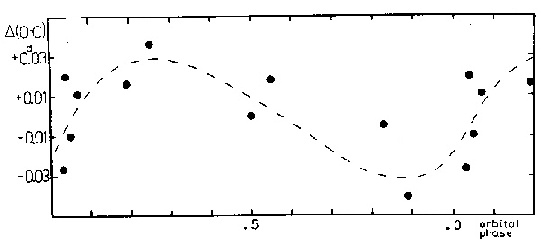 Figure 64 O-C variations due to the orbital motion
The data derived from the curve of O-C variations versus the orbital phase (Fig. 64)
are in good agreement with those derived by Abt (1959). The value of a*sin i can be
determined from the amplitude of the O-C variation curve. The result is:
a*sin i = 78.10^6 km (˜15.10^6 km).
Abt obtained 68.3*10^6 km for this value from spectroscopic observations. Thus the
spectroscopically and optically determined values of a*sin i are very similar.
Moreover, the moment of the point with largest positive deviation of O-C must coincide
with the moment when the cepheid is the furthest from the observer during its orbital
motion (i.e. at 0.23d from periastron according to Abt). This coincidence is very good,
but the time of the nearest point does not coincide so well with the largest negative
deviation of O-C.
On the basis of the data given in Table 38 I suggest a slightly smaller value
for the orbital period. The deviations of O-C plotted with a period of 1400d results
in a curve with smaller scatter. Moreover, the curve constructed from Abt's data on
the mean velocity with the period of 1400 days shows less scatter than in the case of
larger period (only two points with very low weight deviate considerably). Thus the
suggested new value of the orbital period is P_{orb} = 1400d ˜ 15d.
XY Cassiopeiae
The light and colour curves for this variable are shown in Fig. 65. The O-C
residuals have been computed with the formula:
C = 2442006.786 + 4.501697d*E .
Figure 64 O-C variations due to the orbital motion
The data derived from the curve of O-C variations versus the orbital phase (Fig. 64)
are in good agreement with those derived by Abt (1959). The value of a*sin i can be
determined from the amplitude of the O-C variation curve. The result is:
a*sin i = 78.10^6 km (˜15.10^6 km).
Abt obtained 68.3*10^6 km for this value from spectroscopic observations. Thus the
spectroscopically and optically determined values of a*sin i are very similar.
Moreover, the moment of the point with largest positive deviation of O-C must coincide
with the moment when the cepheid is the furthest from the observer during its orbital
motion (i.e. at 0.23d from periastron according to Abt). This coincidence is very good,
but the time of the nearest point does not coincide so well with the largest negative
deviation of O-C.
On the basis of the data given in Table 38 I suggest a slightly smaller value
for the orbital period. The deviations of O-C plotted with a period of 1400d results
in a curve with smaller scatter. Moreover, the curve constructed from Abt's data on
the mean velocity with the period of 1400 days shows less scatter than in the case of
larger period (only two points with very low weight deviate considerably). Thus the
suggested new value of the orbital period is P_{orb} = 1400d ˜ 15d.
XY Cassiopeiae
The light and colour curves for this variable are shown in Fig. 65. The O-C
residuals have been computed with the formula:
C = 2442006.786 + 4.501697d*E .
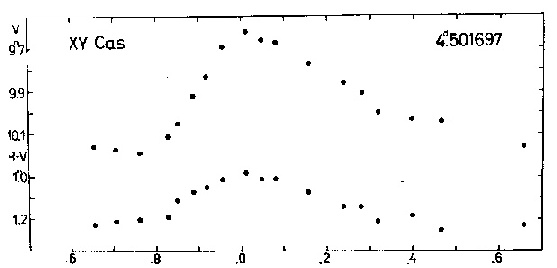 Figure 65 V and B-V curves of XY Cas
Figure 66 shows that the period has remained constant since the discovery of the light
variation of XY Cas. The period change reported by Solov'yov (1954) cannot be confirmed.
Figure 65 V and B-V curves of XY Cas
Figure 66 shows that the period has remained constant since the discovery of the light
variation of XY Cas. The period change reported by Solov'yov (1954) cannot be confirmed.
 Figure 66 O-C diagram of XY Cas
Table 39 O-C residuals for XY Cas
Obs.Max.J.D. E O-C Type w Source
2419403.784 -5021 +0.019d phg 0.5 Robinson (1929)
2422541.383 -4324 -0.065 phg 1 Lehmann-Balan. (1924)
2423919.026 -4018 +0.059 vis 0.5 Selivanov (1928)
2424859.820 -3809 -0.002 vis 0.5 Selivanov (1928)
2425845.76 -3590 +0.07 phg 0.5 Oosterhoff (1935)
2426287.00 -3492 -0.14 phg 0 Oosterhoff (1935)
2426705.737 -3399 +0.219 vis 0 Kukarkin (1940)
2426709.946 -3398 -0.074 vis 1 Dunst (1932)
2426714.49 -3397 -0.03 phg 0.5 Oosterhoff (1935)
2426948.71 -3345 +0.10 phg 0.5 Oosterhoff (1935)
2427335.74 -3259 -0.02 phg 0.5 Oosterhoff (1935)
2428466.03 -3008 +0.35 phg 0 Fu (1964)
2430761.585 -2498 +0.038 phg 1 Solov'yov (1954)
2433147.420 -1968 -0.026 phg 1 Solov'yov (1954)
2434340.403 -1703 +0.007 phg 1 Tsarevsky (1960)
2435456.868 -1455 +0.051 phg 1 Tsarevsky (1960)
2436136.605 -1304 +0.032 phg 1 Tsarevsky (1960)
2436474.306 -1229 +0.106 phg 1 Tsarevsky (1960)
2436820.826 -1152 -0.005 phel 3 Oosterhoff (1960)
2436829.852 -1150 +0.018 phel 3 Weaver et al. (1960)
2436901.796 -1134 -0.066 phel 3 Bahner et al. (1962)
2437365.373 -1031 -0.163 vis 0.5 Berthold (1973)
2439031.023 -661 -0.141 vis 0.5 Berthold (1973)
2439818.991 -486 +0.030 phel 3 present paper^1
2442006.751 0 -0.035 phel 3 present paper
2442097.08 +20 +0.26 vis 0 Small (1974)
Remark: 1 Observer: Abaffy.
VZ Cygni
The light and colour curves of this variable are shown in Fig. 67. The O-C
residuals have been computed with the formula:
C = 2441705.702 + 4.864453d*E .
The O-C diagram presented in Fig. 68 shows a period change:
before J.D. 2434000, P = 4.864583d ;
after J.D. 2434000, P = 4.864453d .
Figure 66 O-C diagram of XY Cas
Table 39 O-C residuals for XY Cas
Obs.Max.J.D. E O-C Type w Source
2419403.784 -5021 +0.019d phg 0.5 Robinson (1929)
2422541.383 -4324 -0.065 phg 1 Lehmann-Balan. (1924)
2423919.026 -4018 +0.059 vis 0.5 Selivanov (1928)
2424859.820 -3809 -0.002 vis 0.5 Selivanov (1928)
2425845.76 -3590 +0.07 phg 0.5 Oosterhoff (1935)
2426287.00 -3492 -0.14 phg 0 Oosterhoff (1935)
2426705.737 -3399 +0.219 vis 0 Kukarkin (1940)
2426709.946 -3398 -0.074 vis 1 Dunst (1932)
2426714.49 -3397 -0.03 phg 0.5 Oosterhoff (1935)
2426948.71 -3345 +0.10 phg 0.5 Oosterhoff (1935)
2427335.74 -3259 -0.02 phg 0.5 Oosterhoff (1935)
2428466.03 -3008 +0.35 phg 0 Fu (1964)
2430761.585 -2498 +0.038 phg 1 Solov'yov (1954)
2433147.420 -1968 -0.026 phg 1 Solov'yov (1954)
2434340.403 -1703 +0.007 phg 1 Tsarevsky (1960)
2435456.868 -1455 +0.051 phg 1 Tsarevsky (1960)
2436136.605 -1304 +0.032 phg 1 Tsarevsky (1960)
2436474.306 -1229 +0.106 phg 1 Tsarevsky (1960)
2436820.826 -1152 -0.005 phel 3 Oosterhoff (1960)
2436829.852 -1150 +0.018 phel 3 Weaver et al. (1960)
2436901.796 -1134 -0.066 phel 3 Bahner et al. (1962)
2437365.373 -1031 -0.163 vis 0.5 Berthold (1973)
2439031.023 -661 -0.141 vis 0.5 Berthold (1973)
2439818.991 -486 +0.030 phel 3 present paper^1
2442006.751 0 -0.035 phel 3 present paper
2442097.08 +20 +0.26 vis 0 Small (1974)
Remark: 1 Observer: Abaffy.
VZ Cygni
The light and colour curves of this variable are shown in Fig. 67. The O-C
residuals have been computed with the formula:
C = 2441705.702 + 4.864453d*E .
The O-C diagram presented in Fig. 68 shows a period change:
before J.D. 2434000, P = 4.864583d ;
after J.D. 2434000, P = 4.864453d .
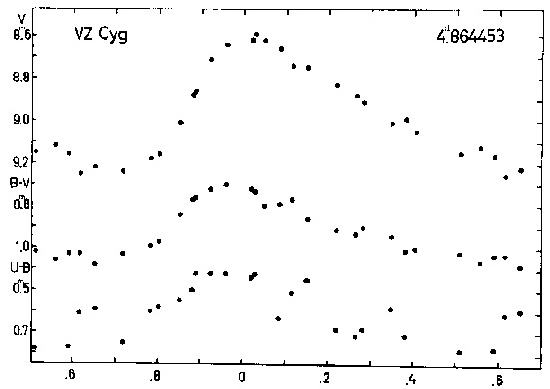 Figure 67 V, B-V and U-B curves of VZ Cyg
Figure 67 V, B-V and U-B curves of VZ Cyg
 Figure 68 O-C diagram of VZ Cyg
Table 40 O-C residuals for VZ Cyg
Obs.Max.J.D. E O-C Type w Source
2416658.035 -5149 -0.599d vis 0.5 Graff (1914)
2416799.165 -5120 -0.538 vis 0.5 Zinner^1 (1932)
2417062.0 -5066 -0.4 vis 0.5 Seares (1907a)
2417066.4 -5065 -0.8 vis 0 Blazhko (1906)
2417207.798 -5036 -0.519 vis 0.5 Zinner^1 (1932)
2417485.2 -4979 -0.4 vis 0.5 Seares (1907a)
2417499.783 -4976 -0.401 vis 0.5 Zinner^1 (1932)
2417762.528 -4922 -0.336 vis 0.5 Zeipel (1908)
2417815.980 -4911 -0.393 vis 0.5 Zinner^1 (1932)
2417820.912 -4910 -0.326 vis 0.5 Luizet (1909)
2418195.396 -4833 -0.405 vis 0.5 Zinner^1 (1932)
2418224.569 -4827 -0.418 vis 0.5 Luizet (1909)
2418560.219 -4758 -0.416 vis 0.5 Zinner^1 (1932)
2419158.686 -4635 -0.276 vis 0.5 Zinner^1 (1932)
Table 40 (cont.)
Obs.Max.J.D. E O-C Type w Source
2419859.095 -4491 -0.349d vis 0.5 Zinner^1 (1932)
2420379.476 -4384 -0.464 vis 0.5 Zinner^1 (1932)
2420627.598 -4333 -0.405 vis 1 Doberck (1920a)
2420642.129 -4330 -0.493 phg 0.5 Robinson (1930)
2420768.758 -4304 -0.338 vis 0.5 Zinner^1 (1932)
2421084.891 -4239 -0.395 vis 0.5 Zinner^1 (1932)
2421114.079 -4233 -0.393 phg 2 Jordan (1929)
2421386.567 -4177 -0.315 vis 0.5 Zinner^1 (1932)
2421498.432 -4154 -0.332 vis 1 Doberck (1920a)
2421722.207 -4108 -0.322 vis 0.5 Zinner^1 (1932)
2422165.164 -4017 -0.030 vis 0 Zinner^1 (1932)
2422179.388 -4014 -0.400 vis 1 Doberck (1920a)
2422588.133 -3930 -0.269 vis 0.5 Zinner^1 (1932)
2422656.134 -3916 -0.370 phg 1 Jordan (1929)
2423040.508 -3837 -0.288 vis 0.5 Zinner^1 (1932)
2423327.580 -3778 -0.219 vis 0.5 Doberck (1924b)
2423507.509 -3741 -0.274 vis 1 Nielsen (1954)
2423692.305 -3703 -0.328 vis 0.5 Doberck (1924b)
2424996.109 -3435 -0.197 phg 1 Wachmann (1935)
2426163.550 -3195 -0.225 phg 1 Wachmann (1935)
2426513.862 -3123 -0.153 phg 1 Wachmann (1935)
2426898.035 -3044 -0.272 phg 1 Wachmann (1935)
2427029.614 -3017 -0.033 vis 0.5 Dziewulski et al. (1938)
2427321.296 -2957 -0.218 phg 2 Gesundheit (1938)
2427360.339 -2949 -0.091 vis 0.5 Dziewulski et al. (1938)
2427739.687 -2871 -0.170 phg 2 Gesundheit (1938)
2428848.680 -2643 -0.273 phg 1 Abidov (1963)
2429096.894 -2592 -0.146 phg 1 Abidov (1963)
2429452.007 -2519 -0.138 phg 1 Abidov (1963)
2429812.004 -2445 -0.110 phg 1 Abidov (1963)
2429933.686 -2420 -0.040 vis 0.5 Conceicao-Silva (1950a)
2430269.317 -2351 -0.056 vis 0.5 Conceicao-Silva (1950a)
2430571.42 -2289 +0.45 vis 0 Stein (1944)
2430624.483 -2278 +0.005 vis 0.5 Conceicao-Silva (1950a)
2430921.153 -2217 -0.057 vis 0.5 Conceicao-Silva (1950a)
2432755.06 -1840 -0.05 phg 1 Novikov (1951)
2433387.402 -1710 -0.085 phg 1 Abidov (1963)
2433903.002 -1604 -0.117 phg 0.5 Abidov (1963)
2434219.193 -1539 -0.116 phg 1 Abidov (1963)
2434589.022 -1463 +0.015 phg 1 Abidov (1963)
2434953.849 -1388 +0.008 phg 0.5 Abidov (1963)
2435323.677 -1312 +0.137 phg 0.5 Abidov (1963)
2435362.501 -1304 +0.046 phg 1 Vyskupaitis (1961)
2436773.146 -1014 -0.001 phel 3 Weaver et al. (1960)
2436802.348 -1008 +0.015 phel 3 Oosterhoff (1960)
2437352.009 -895 -0.008 phel 3 Mitchell et al. (1964)
2437556.280 -853 -0.044 vis 0.5 Schreier (1962)
2441705.698 0 -0.004 phel 3 present paper
2443062.886 +279 +0.002 phel 2 present paper
Remark: 1 Observer: Hartwig
V 1154 Cygni
The cepheid V 1154 Cygni has a faint companion about 20" S. The light and
colour curves for this variable are shown in Fig. 69. Unfortunately, the U-B colour
curve is not complete.
The O-C residuals have been calculated with the formula:
C = 2441494.442 + 4.925460d*E .
According to Fig. 70 this star has a constant period.
Figure 68 O-C diagram of VZ Cyg
Table 40 O-C residuals for VZ Cyg
Obs.Max.J.D. E O-C Type w Source
2416658.035 -5149 -0.599d vis 0.5 Graff (1914)
2416799.165 -5120 -0.538 vis 0.5 Zinner^1 (1932)
2417062.0 -5066 -0.4 vis 0.5 Seares (1907a)
2417066.4 -5065 -0.8 vis 0 Blazhko (1906)
2417207.798 -5036 -0.519 vis 0.5 Zinner^1 (1932)
2417485.2 -4979 -0.4 vis 0.5 Seares (1907a)
2417499.783 -4976 -0.401 vis 0.5 Zinner^1 (1932)
2417762.528 -4922 -0.336 vis 0.5 Zeipel (1908)
2417815.980 -4911 -0.393 vis 0.5 Zinner^1 (1932)
2417820.912 -4910 -0.326 vis 0.5 Luizet (1909)
2418195.396 -4833 -0.405 vis 0.5 Zinner^1 (1932)
2418224.569 -4827 -0.418 vis 0.5 Luizet (1909)
2418560.219 -4758 -0.416 vis 0.5 Zinner^1 (1932)
2419158.686 -4635 -0.276 vis 0.5 Zinner^1 (1932)
Table 40 (cont.)
Obs.Max.J.D. E O-C Type w Source
2419859.095 -4491 -0.349d vis 0.5 Zinner^1 (1932)
2420379.476 -4384 -0.464 vis 0.5 Zinner^1 (1932)
2420627.598 -4333 -0.405 vis 1 Doberck (1920a)
2420642.129 -4330 -0.493 phg 0.5 Robinson (1930)
2420768.758 -4304 -0.338 vis 0.5 Zinner^1 (1932)
2421084.891 -4239 -0.395 vis 0.5 Zinner^1 (1932)
2421114.079 -4233 -0.393 phg 2 Jordan (1929)
2421386.567 -4177 -0.315 vis 0.5 Zinner^1 (1932)
2421498.432 -4154 -0.332 vis 1 Doberck (1920a)
2421722.207 -4108 -0.322 vis 0.5 Zinner^1 (1932)
2422165.164 -4017 -0.030 vis 0 Zinner^1 (1932)
2422179.388 -4014 -0.400 vis 1 Doberck (1920a)
2422588.133 -3930 -0.269 vis 0.5 Zinner^1 (1932)
2422656.134 -3916 -0.370 phg 1 Jordan (1929)
2423040.508 -3837 -0.288 vis 0.5 Zinner^1 (1932)
2423327.580 -3778 -0.219 vis 0.5 Doberck (1924b)
2423507.509 -3741 -0.274 vis 1 Nielsen (1954)
2423692.305 -3703 -0.328 vis 0.5 Doberck (1924b)
2424996.109 -3435 -0.197 phg 1 Wachmann (1935)
2426163.550 -3195 -0.225 phg 1 Wachmann (1935)
2426513.862 -3123 -0.153 phg 1 Wachmann (1935)
2426898.035 -3044 -0.272 phg 1 Wachmann (1935)
2427029.614 -3017 -0.033 vis 0.5 Dziewulski et al. (1938)
2427321.296 -2957 -0.218 phg 2 Gesundheit (1938)
2427360.339 -2949 -0.091 vis 0.5 Dziewulski et al. (1938)
2427739.687 -2871 -0.170 phg 2 Gesundheit (1938)
2428848.680 -2643 -0.273 phg 1 Abidov (1963)
2429096.894 -2592 -0.146 phg 1 Abidov (1963)
2429452.007 -2519 -0.138 phg 1 Abidov (1963)
2429812.004 -2445 -0.110 phg 1 Abidov (1963)
2429933.686 -2420 -0.040 vis 0.5 Conceicao-Silva (1950a)
2430269.317 -2351 -0.056 vis 0.5 Conceicao-Silva (1950a)
2430571.42 -2289 +0.45 vis 0 Stein (1944)
2430624.483 -2278 +0.005 vis 0.5 Conceicao-Silva (1950a)
2430921.153 -2217 -0.057 vis 0.5 Conceicao-Silva (1950a)
2432755.06 -1840 -0.05 phg 1 Novikov (1951)
2433387.402 -1710 -0.085 phg 1 Abidov (1963)
2433903.002 -1604 -0.117 phg 0.5 Abidov (1963)
2434219.193 -1539 -0.116 phg 1 Abidov (1963)
2434589.022 -1463 +0.015 phg 1 Abidov (1963)
2434953.849 -1388 +0.008 phg 0.5 Abidov (1963)
2435323.677 -1312 +0.137 phg 0.5 Abidov (1963)
2435362.501 -1304 +0.046 phg 1 Vyskupaitis (1961)
2436773.146 -1014 -0.001 phel 3 Weaver et al. (1960)
2436802.348 -1008 +0.015 phel 3 Oosterhoff (1960)
2437352.009 -895 -0.008 phel 3 Mitchell et al. (1964)
2437556.280 -853 -0.044 vis 0.5 Schreier (1962)
2441705.698 0 -0.004 phel 3 present paper
2443062.886 +279 +0.002 phel 2 present paper
Remark: 1 Observer: Hartwig
V 1154 Cygni
The cepheid V 1154 Cygni has a faint companion about 20" S. The light and
colour curves for this variable are shown in Fig. 69. Unfortunately, the U-B colour
curve is not complete.
The O-C residuals have been calculated with the formula:
C = 2441494.442 + 4.925460d*E .
According to Fig. 70 this star has a constant period.
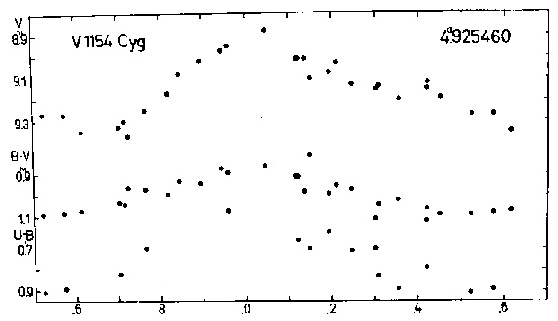 Figure 69 V, B-V and U-B curves of V 1154 Cyg
Figure 69 V, B-V and U-B curves of V 1154 Cyg
 Figure 70 O-C diagram of V 1154 Cyg
Table 41 O-C residuals for V 1154 Cyg
Obs.Max.J.D. E O-C Type w Source
2416044.647 -5167 +0.57d phg 0.5 Strohmeier et al. (1968)
2419265.632 -4513 -0.209 phg 0.5 Strohmeier et al. (1968)
2419349.471 -4496 -0.103 phg 0.5 Strohmeier et al. (1968)
2419595.739 -4446 -0.108 phg 0.5 Strohmeier et al. (1968)
2420009.616 -4362 +0.031 phg 0.5 Strohmeier et al. (1968)
2420423.492 -4278 +0.168 phg 0.5 Strohmeier et al. (1968)
Table 41 (cont.)
Obs.Max.J.D. E O-C Type w Source
2420852.283 -4191 +0.440d phg 0.5 Strohmeier et al. (1968)
2421846.916 -3989 +0.134 phg 0.5 Strohmeier et al. (1968)
2422230.609 -3911 -0.359 phg 0.5 Strohmeier et al. (1968)
2422895.733 -3776 -0.172 phg 0.5 Strohmeier et al. (1968)
2423984.587 -3555 +0.156 phg 0.5 Strohmeier et al. (1968)
2426427.558 -3059 +0.098 phg 0.5 Ott (1966)
2426531.072 -3038 +0.178 phg 0.5 Strohmeier et al. (1968)
2426846.198 -2974 +0.074 phg 0.5 Strohmeier et al. (1968)
2426880.322 -2967 -0.280 phg 0.5 Ott (1966)
2427260.218 -2890 +0.356 phg 0.5 Strohmeier et al. (1968)
2427303.838 -2881 -0.353 phg 0.5 Ott (1966)
2427530.835 -2835 +0.072 phg 0.5 Strohmeier et al. (1968)
2427919.762 -2756 -0.112 phg 0.5 Strohmeier et al. (1968)
2428067.411 -2726 -0.227 phg 0.5 Ott (1966)
2428777.082 -2582 +0.178 phg 0.5 Strohmeier et al. (1968)
2429077.290 -2521 -0.067 phg 0.5 Ott (1966)
2429456.525 -2444 -0.093 phg 0.5 Strohmeier et al. (1968)
2429825.703 -2369 -0.325 phg 0.5 Strohmeier et al. (1968)
2430535.260 -2225 -0.033 phg 0.5 Strohmeier et al. (1968)
2430673.244 -2197 +0.036 phg 0.5 Nikulina (1970)
2431717.643 -1985. +0.239 phg 0.5 Nikulina (1970)
2432776.449 -1770 +0.071 phg 0.5 Nikulina (1970)
2433406.659 -1642 -0.177 phg 0.5 Nikulina (1970)
2433790.836 -1564 -0.186 phg 0.5 Strohmeier et al. (1968)
2434248.806 -1471 -0.284 phg 0.5 Strohmeier et al. (1968)
2434480.757 -1424 +0.170 phg 0.5 Nikulina (1970)
2434983.354 -1322 +0.370 phg 0.5 Nikulina (1970)
2435445.884 -1228 -0.093 phg 0.5 Nikulina (1970)
2436495.184 -1015 +0.084 phg 0.5 Nikulina (1970)
2436780.793 -957 +0.013 phg 0.5 Ott^1 (1966)
2437199.479 -872 +0.038 phg 0.5 Ott^2 (1966)
2437332.550 -845 +0.122 phg 0.5 Nikulina (1970)
2437583.294 -794 -0.332 phg 0.5 Ott (1966)
2437706.869 -769 +0.106 phg 0.5 Busch, Haussler (1966)
2437918.353 -726 -0.205 phg 0.5 Ott (1966)
2438287.920 -651 -0.047 phg 0.5 Ott^2 (1966)
2438425.857 -623 -0.023 phg 0.5 Nikulina (1970)
2438662.447 -575 +0.145 phg 0.5 Ott^2 (1966)
2439031.788 -500 +0.076 phg 0.5 Ott^2 (1966)
2441006.788 -99 -0.033 phel 3 Wachmann (1976)
2441494.482 0 +0.040 phel 3 present paper
Remarks: 1 Observer: Weber; 2 Obs.: Haussler.
AS Persei
The light and colour curves of this star based on the observations made
between 1972-1974 are shown in Fig. 71. It is highly interesting that the amplitude of
the light variation is decreasing. In 1959 the amplitudes were 1.361m and 0.957m in B
and V, respectively (Schaltenbrand and Tammann 1971). In 1972-1974 the
Figure 70 O-C diagram of V 1154 Cyg
Table 41 O-C residuals for V 1154 Cyg
Obs.Max.J.D. E O-C Type w Source
2416044.647 -5167 +0.57d phg 0.5 Strohmeier et al. (1968)
2419265.632 -4513 -0.209 phg 0.5 Strohmeier et al. (1968)
2419349.471 -4496 -0.103 phg 0.5 Strohmeier et al. (1968)
2419595.739 -4446 -0.108 phg 0.5 Strohmeier et al. (1968)
2420009.616 -4362 +0.031 phg 0.5 Strohmeier et al. (1968)
2420423.492 -4278 +0.168 phg 0.5 Strohmeier et al. (1968)
Table 41 (cont.)
Obs.Max.J.D. E O-C Type w Source
2420852.283 -4191 +0.440d phg 0.5 Strohmeier et al. (1968)
2421846.916 -3989 +0.134 phg 0.5 Strohmeier et al. (1968)
2422230.609 -3911 -0.359 phg 0.5 Strohmeier et al. (1968)
2422895.733 -3776 -0.172 phg 0.5 Strohmeier et al. (1968)
2423984.587 -3555 +0.156 phg 0.5 Strohmeier et al. (1968)
2426427.558 -3059 +0.098 phg 0.5 Ott (1966)
2426531.072 -3038 +0.178 phg 0.5 Strohmeier et al. (1968)
2426846.198 -2974 +0.074 phg 0.5 Strohmeier et al. (1968)
2426880.322 -2967 -0.280 phg 0.5 Ott (1966)
2427260.218 -2890 +0.356 phg 0.5 Strohmeier et al. (1968)
2427303.838 -2881 -0.353 phg 0.5 Ott (1966)
2427530.835 -2835 +0.072 phg 0.5 Strohmeier et al. (1968)
2427919.762 -2756 -0.112 phg 0.5 Strohmeier et al. (1968)
2428067.411 -2726 -0.227 phg 0.5 Ott (1966)
2428777.082 -2582 +0.178 phg 0.5 Strohmeier et al. (1968)
2429077.290 -2521 -0.067 phg 0.5 Ott (1966)
2429456.525 -2444 -0.093 phg 0.5 Strohmeier et al. (1968)
2429825.703 -2369 -0.325 phg 0.5 Strohmeier et al. (1968)
2430535.260 -2225 -0.033 phg 0.5 Strohmeier et al. (1968)
2430673.244 -2197 +0.036 phg 0.5 Nikulina (1970)
2431717.643 -1985. +0.239 phg 0.5 Nikulina (1970)
2432776.449 -1770 +0.071 phg 0.5 Nikulina (1970)
2433406.659 -1642 -0.177 phg 0.5 Nikulina (1970)
2433790.836 -1564 -0.186 phg 0.5 Strohmeier et al. (1968)
2434248.806 -1471 -0.284 phg 0.5 Strohmeier et al. (1968)
2434480.757 -1424 +0.170 phg 0.5 Nikulina (1970)
2434983.354 -1322 +0.370 phg 0.5 Nikulina (1970)
2435445.884 -1228 -0.093 phg 0.5 Nikulina (1970)
2436495.184 -1015 +0.084 phg 0.5 Nikulina (1970)
2436780.793 -957 +0.013 phg 0.5 Ott^1 (1966)
2437199.479 -872 +0.038 phg 0.5 Ott^2 (1966)
2437332.550 -845 +0.122 phg 0.5 Nikulina (1970)
2437583.294 -794 -0.332 phg 0.5 Ott (1966)
2437706.869 -769 +0.106 phg 0.5 Busch, Haussler (1966)
2437918.353 -726 -0.205 phg 0.5 Ott (1966)
2438287.920 -651 -0.047 phg 0.5 Ott^2 (1966)
2438425.857 -623 -0.023 phg 0.5 Nikulina (1970)
2438662.447 -575 +0.145 phg 0.5 Ott^2 (1966)
2439031.788 -500 +0.076 phg 0.5 Ott^2 (1966)
2441006.788 -99 -0.033 phel 3 Wachmann (1976)
2441494.482 0 +0.040 phel 3 present paper
Remarks: 1 Observer: Weber; 2 Obs.: Haussler.
AS Persei
The light and colour curves of this star based on the observations made
between 1972-1974 are shown in Fig. 71. It is highly interesting that the amplitude of
the light variation is decreasing. In 1959 the amplitudes were 1.361m and 0.957m in B
and V, respectively (Schaltenbrand and Tammann 1971). In 1972-1974 the
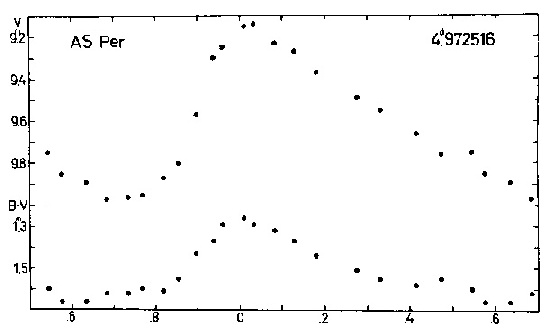 Figure 71 V and B-V curves of AS Per
Figure 71 V and B-V curves of AS Per
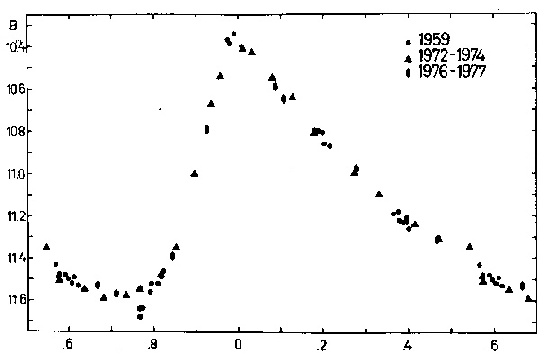 Figure 72 The composite B light curve of AS Per
Figure 72 The composite B light curve of AS Per
 Figure 73 O-C diagram of AS Per
amplitudes were smaller: 1.20m in B and 0.83m in V. In order to check the reality of
this unique behaviour AS Per was reobserved in 1976-1977. The amplitudes were even
smaller in this season. The composite B light curve is shown in Fig. 72. The decrease
of the amplitude is about 0.01m/year in B light. Unfortunately, the unfavourable period
prevents getting a complete light curve during one observational season. Further
continuous photometry is needed to study this interesting phenomenon.
The O-C residuals have been computed with the formula:
C = 2441723.934 + 4.972516d*E .
The O-C diagram (Fig. 73) shows the constancy of the period.
Table 42 O-C residuals for AS Per
Obs.Max.J.D. E O-C Type w Source
2417522.706 -4867 +0.007d phg 0.5 Kukarkin (1949)
2418258.80 -4719 +0.17 phg 0.5 Oosterhoff (1935)
2418676.14 -4635 -0.18 phg 0.5 Oosterhoff (1935)
2419009.72 -4568 +0.24 phg 0.5 Oosterhoff (1935)
2420546.56 -4259 +0.57 phg 0 Oosterhoff (1935)
2421585.66 -4050 +0.42 phg 0 Oosterhoff (1935)
2423399.77 -3685 -0.44 phg 0 Oosterhoff (1935)
2423783.63 -3608 +0.53 phg 0 Oosterhoff (1935)
2425155.87 -3332 +0.26 phg 0.5 Oosterhoff (1935)
2425528.46 -3257 +0.01 vis 0.5 Guthnick (1928)
2425936.190 -3175 -0.006 vis 1 Beyer (1934b)
2425985.840 -3165 -0.081 vis 0.5 Rugemer (1933)
2426001.08 -3162 +0.24 phg 0.5 Oosterhoff (1935)
2426239.433 -3114 -0.086 vis 1 Beyer (1934b)
2426284.50 -3105 +0.23 phg 0.5 Oosterhoff (1935)
2426565.02 -3049 +2.29 vis 0 Lange (1931)
2426691.869 -3023 -0.149 vis 1 Rugemer (1933)
2426761.57 -3009 -0.06 phg 0.5 Oosterhoff (1935)
2426786.424 -3004 -0.072 vis 1 Beyer (1934b)
2426995.241 -2962 -0.101 vis 1 Rugemer (1933)
2427034.78 -2954 -0.34 phg 0 Oosterhoff (1935)
2428094.332 -2741 +0.064 vis 0.5 Ahnert (1947)
2428611.322 -2637 -0.081 phg 1 Kukarkin (1949)
2428631.23 -2633 -0.07 vis 0.5 Kukarkin (1949)
2436816.019 -987 -0.042 phel 2 Weaver et al. (1960)
2436821.041 -986 +0.008 phel 2 Oosterhoff (1960)
2439252.614 -497 +0.020 phel 2 Takase (1969)
2441723.922 0 -0.012 phel 3 present paper
V Lacertae
According to Oosterhoff (1960) there is a photometric companion at V Lac.
Miller and Preston (1964) contradicted this statement. The ratios of light amplitudes
in different colours do not confirm the presence of a companion (see Fig. 74).
Figure 73 O-C diagram of AS Per
amplitudes were smaller: 1.20m in B and 0.83m in V. In order to check the reality of
this unique behaviour AS Per was reobserved in 1976-1977. The amplitudes were even
smaller in this season. The composite B light curve is shown in Fig. 72. The decrease
of the amplitude is about 0.01m/year in B light. Unfortunately, the unfavourable period
prevents getting a complete light curve during one observational season. Further
continuous photometry is needed to study this interesting phenomenon.
The O-C residuals have been computed with the formula:
C = 2441723.934 + 4.972516d*E .
The O-C diagram (Fig. 73) shows the constancy of the period.
Table 42 O-C residuals for AS Per
Obs.Max.J.D. E O-C Type w Source
2417522.706 -4867 +0.007d phg 0.5 Kukarkin (1949)
2418258.80 -4719 +0.17 phg 0.5 Oosterhoff (1935)
2418676.14 -4635 -0.18 phg 0.5 Oosterhoff (1935)
2419009.72 -4568 +0.24 phg 0.5 Oosterhoff (1935)
2420546.56 -4259 +0.57 phg 0 Oosterhoff (1935)
2421585.66 -4050 +0.42 phg 0 Oosterhoff (1935)
2423399.77 -3685 -0.44 phg 0 Oosterhoff (1935)
2423783.63 -3608 +0.53 phg 0 Oosterhoff (1935)
2425155.87 -3332 +0.26 phg 0.5 Oosterhoff (1935)
2425528.46 -3257 +0.01 vis 0.5 Guthnick (1928)
2425936.190 -3175 -0.006 vis 1 Beyer (1934b)
2425985.840 -3165 -0.081 vis 0.5 Rugemer (1933)
2426001.08 -3162 +0.24 phg 0.5 Oosterhoff (1935)
2426239.433 -3114 -0.086 vis 1 Beyer (1934b)
2426284.50 -3105 +0.23 phg 0.5 Oosterhoff (1935)
2426565.02 -3049 +2.29 vis 0 Lange (1931)
2426691.869 -3023 -0.149 vis 1 Rugemer (1933)
2426761.57 -3009 -0.06 phg 0.5 Oosterhoff (1935)
2426786.424 -3004 -0.072 vis 1 Beyer (1934b)
2426995.241 -2962 -0.101 vis 1 Rugemer (1933)
2427034.78 -2954 -0.34 phg 0 Oosterhoff (1935)
2428094.332 -2741 +0.064 vis 0.5 Ahnert (1947)
2428611.322 -2637 -0.081 phg 1 Kukarkin (1949)
2428631.23 -2633 -0.07 vis 0.5 Kukarkin (1949)
2436816.019 -987 -0.042 phel 2 Weaver et al. (1960)
2436821.041 -986 +0.008 phel 2 Oosterhoff (1960)
2439252.614 -497 +0.020 phel 2 Takase (1969)
2441723.922 0 -0.012 phel 3 present paper
V Lacertae
According to Oosterhoff (1960) there is a photometric companion at V Lac.
Miller and Preston (1964) contradicted this statement. The ratios of light amplitudes
in different colours do not confirm the presence of a companion (see Fig. 74).
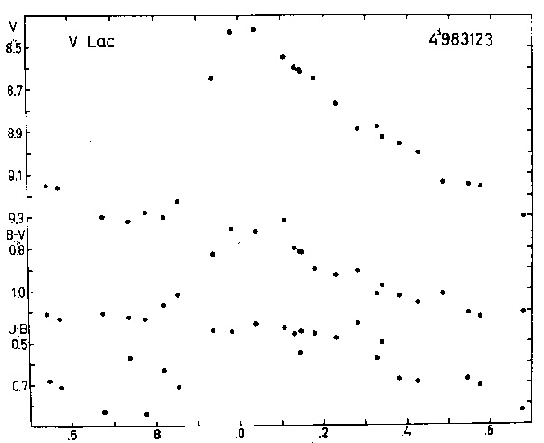 Figure 74 V, B-V and U-B curves of V Lac
Figure 74 V, B-V and U-B curves of V Lac
 Figure 75 O-C diagram of V Lac
Table 43 O-C residuals for V Lac
Obs.Max.J.D. E O-C Type w Source
2416716.392 -2445 -0.314d vis 0.5 Seares (1907b)
2417065.259 -2375 -0.289 vis 0.5 Seares (1907b)
2417353.6 -2317 -1.0 vis 0 Blazhko (1907a)
2417399.097 -2308 -0.344 vis 0.5 Seares (1907b)
2417613.341 -2265 -0.389 vis 0.5 Seares (1907b)
2417782.809 -2231 -0.359 vis 0.5 Zeipel (1908)
2417783.5 -2231 +0.3 vis 0 Muller, Hartwig^1 (1920)
2418031.919 -2181 -0.424 phg 0.5 Robinson (1931b)
2419716.574 -1843 -0.179 phg 1 Martin, Plummer (1916)
2420070.390 -1772 -0.189 phg 2 Martin, Plummer (1916)
2420578.848 -1670 -0.045 vis 0.5 Doberck (1920b)
2420633.512 -1659 -0.199 phg 2 Martin, Plummer (1916)
Table 43 (cont.)
Obs.Max.J.D. E O-C Type w Source
2420817.920 -1622 -0.181d phg 2 Hertzsprung (1922)
2421266.507 -1532 -0.106 vis 0.5 Doberck (1920b)
2421844.515 -1416 -0.180 phg 2 Jordan (1929)
2421884.427 -1408 -0.136 vis 0.5 Doberck (1920b)
2422203.529 -1344 +0.024 vis 0.5 Doberck (1920b)
2423334.721 -1117 -0.031 vis 0.5 Doberck (1924b)
2423698.370 -1044 -0.175 vis 0.5 Doberck (1924b)
2425836.327 -615 -0.126 vis 0.5 Parenago (1938)
2426324.847 -517 +0.014 vis 0.5 Terkan (1935)
2426529.094 -476 -0.061 vis 0.5 Kukarkin (1940)
2426558.980 -470 -0.076 phg 1 Zonn (1933)
2426758.428 -430 +0.033 vis 0.5 Dziewulski^2 (1947)
2426818.224 -418 +0.028 vis 0.5 Dziewulski (1947)
2427092.226 -363 -0.061 phg 1 Zonn (1933)
2427281.593 -325 -0.066 vis 0.5 Florya, Kukarkina (1953)
2428173.748 -146 +0.048 vis 0.5 Gur'yev (1938)
2428283.296 -124 -0.040 phg 0.5 Dziewulski et al. (1946)
2428353.125 -110 +0.020 phg 0.5 Dziewulski et al. (1946)
2428423.09 -96 +0.22 phg 0.5 Fu (1964)
2428557.460 -69 +0.033 phg 0.5 Dziewulski et al. (1946)
2429045.74 +29 -0.07 phg 0.5 Kurochkin (1946)
2433635.445 +950 -0.136 phg 1 Solov'yov (1952b)
2434393.169 +1102 +0.101 phg 0.5 Nikulina (1970)
2436794.894 +1584 -0.205 phel 3 Weaver et al. (1960)
2436809.829 +1587 -0.221 phel 2 Oosterhoff (1960)
2436834.777 +1592 -0.191 phel 2 Bahner et al. (1962)
2437348.104 +1695 -0.160 phel 2 Mitchell et al. (1964)
2437422.781 +1710 -0.235 phg 1 Golovatyj (1964)
2437487.567 +1723 -0.234 phg 0.5 Nikulina (1970)
2438070.607 +1840 -0.260 phg 1 Golovatyj (1964)
2438474.068 +1921 -0.460 phg 0.5 Nikulina (1970)
2439754.969 +2178 -0.310 phel 2 present paper^3
2441907.688 +2610 -0.449 phel 3 present paper
Remarks: 1 Observer: Hartwig; 2 Obs.: Iwanowska; 3 Obs.: Abaffy.
The O-C residuals have been computed with the formula:
C = 2428901.286 + 4.983468d*E .
The O-C diagram (Fig. 75) can be represented by a negative parabola:
C_{par} = 2428901.286 + 4.983468d*E - 6.7d*10^{-8}*E^2
This representation of O-C residuals contradicts Parenago's (1956) statement that only
sudden period changes can exist at the cepheids.
GENERAL REMARKS
Period changes
The investigation of period changes of cepheids is of a great importance
because an observational test of the cepheid evolution theory becomes possible by means
of such investigations. The larger the number of epochs during which the observations
have been made the more probable the detection of some evolutionary features on the
basis of the observed period changes.
Parenago (1956) investigated period changes of 42 cepheids selected arbitrarily.
His sample contains only 7 cepheids with periods less than 5 days, and, the O-C
diagrams published by him are not correct in the case of BL Her, SW Tau, BY Cas, SU Cyg
and XY Cas.
Since 1956 many cepheids have changed their period. As photoelectric photometry
has become general in the last decades, it has been possible to determine the recent
period changes more accurately. The present study on the period changes of cepheids
based on uniformly constructed O-C diagrams has therefore uncovered a number of
previously unnoticed phenomena. However, Parenago's statements concerning the
statistics of period changes are correct (cf. page 110).
Parenago found that the period changes were always sudden, i.e. the O-C diagram
for a cepheid variable consists of straight lines. Detre (1970) distinguished three
kinds of O-C diagrams for cepheids:
1. Those showing an evolutionary characteristic (parabolic curve), assuming that a
cepheid changes its period while crossing the instability strip. Among cepheids with a
period of less than 5 days there is only one star with an obviously parabolic O-C graph,
viz. V Lac (see Fig. 75);
2. Those showing constant period. The number of cepheids with constant period
diminishes continuously because each cepheid will change its period within a certain
time;
3. Those showing irregular fluctuations of the period. Detre did not state that only
sudden period changes could exist. The O-C diagrams presented in the previous section
have shown that the period changes are sudden in the overwhelming majority of cases.
As a matter of fact the straight lines may be distorted because of the period noise.
Moreover, the velocity of the period change is unknown, i.e. we do not know the real
shape of the O-C diagrams at the intersections of these straight lines. Therefore,
we only approximate the O-C diagrams with straight lines. Besides the parabolic O-C
curve of V Lac only AU Peg and possibly BL Her show an O-C graph which cannot be
represented by straight lines. However, these latter two stars are Population II cepheids.
Several cepheids which changed their period more than once have very
interesting gradual, "stepwise" O-C variations. The original value of the period
changed at a certain moment and in a short or somewhat longer time the period returned
to its original value. Such a rejump may take place so suddenly (e.g. SU Cyg in Fig. 44)
that the value of the intermediate period cannot be determined. If the rejump of the
period is slower (e.g. V 532 Cyg in Fig. 31) the two opposite period jumps are well
observable. In the case of SZ Tau there are two intermediate periods before returning
to the original value of the period. These stepwise period changes can best be seen in
DT Cyg (see Fig. 16). DT Cyg has changed its period and returned to the original period
at least four times.
This kind of period change may well have an important role in checking the
recent theory on the evolution of cepheids. Arp (1960) showed the path of cepheid
evolution between the blue giants and the red supergiants to be very close to a
period-equals-constant line for cepheids in Small Magellanic Cloud. Later, Efremov
(1968a) constructed the composite colour-magnitude diagram for the galactic groups of
stars containing cepheids. His composite diagram shows that the slope of the
evolutionary path is close to the slope of lines of constant period for the galactic
cepheids, as well.
The stepwise O-C diagram can be interpreted as a result of the evolution of
the cepheid along the line of a given (constant) period. The deviations from this
constant period are marks of small period fluctuations. The existence of this kind of
O-C diagram is observational evidence supporting the hypothesis on the evolution of
cepheids along the lines of constant period.
It is noteworthy that among RR Lyrae variables such kinds of period changes
are very rare. Among the 195 field RR Lyrae variables investigated by Tsessevitch
(1966), only two stars (UY Boo, AT Ser) showed a return to the earlier period. Among
117 investigated RR Lyrae stars in the globular cluster M3, three variables (V54, V81,
V110) showed rejump of the period (Szeidl 1965).
There is another phenomenon observable for SU Cyg (a cepheid with a rejumping
period), which leads us to treat secular variations of the light curves.
Secular variations of the light curves
The difference between the O-C values before the period jump and after the
rejump for maximum brightness (Delta(O-C)_{max}) differs remarkably from
Delta(O-C)_{med} for median brightness in the case of SU Cyg (see Fig. 44).
The time difference between the moments of a maximum and the preceding median
brightness were equal to about 0.43d until the period jump and after the rejump became
0.35d . This means that the ascending branch of the light curve became considerably
steeper than before the period jump.
Secular variation in the shape of the light curve can be observed in the case
of FF Aql as well. As is shown in Fig. 63, the moments of the median brightness either
repeat themselves with a period somewhat less than the period determined from the
maxima or they are repeated with the period valid for the maximum but with a period
jump and rejump at an unknown time between J.D. 2426000 and J.D. 2433000. In the case
of FF Aql the ascending branch of the light curve has become less steep either suddenly
or continuously.
The third case of the observed secular light curve variations is the amplitude
decrease of AS Per. This very slight decrease (about 0.01 mag/year in B) may not mean
that AS Per evolves out of the instability strip because the calculated decay time of
the pulsation is not more than several years (Christy 1966). Moreover, the period of
the light variation of AS Per is constant. This means that the star is in a quiet
stage of its evolution.
The physical causes of above-mentioned sudden period changes and secular light
curve variations are not yet known.
Cepheids with small amplitude
The first problem connected with these cepheids is the separation of cepheids with
apparently small amplitude (photometric effect because of a companion) from the group of
cepheids with really small amplitude. Cepheids with a nearly symmetrical light curve are
undoubtedly true members of the group containing cepheids with small amplitude, since
cepheids with large amplitude and nearly symmetrical light curve do not exist (except some
cepheids with a period of 9-10 days for which the symmetrical light curve is caused by the
presence of a bump). In order to decide whether a cepheid with small amplitude and light
curve consisting of a steep rising branch and a less steep descending branch belongs either
to large amplitude variables with apparently decreased amplitude or to small amplitude
variables, spectroscopic observations of good quality are necessary. Spectroscopic
observations are recommended in the cases of IR Cep and V 508 Mon.
The second and more important problem concerning the small amplitude cepheids is
their evolutionary status. According to Efremov (1968b) these stars have not yet reached
the red supergiant stage, they are just crossing the instability strip for the first time.
A great many arguments support this hypothesis. However, the theoretical calculations on
the crossing time predict far fewer small amplitude cepheids compared with the other
classical cepheids (Hofmeister 1967). If the first crossing were slower, the number of
observable small amplitude cepheids would be greater.
According to the theory of cepheid evolution the period of a cepheid must increase
during the first crossing of the instability strip. During a given time interval the
calculated change in the period is about a hundred times larger at the first crossing by
comparison with other crossings of larger serial numbers in the case of low and
intermediate cepheid masses (Hofmeister 1965). The cepheids with periods of less than five
days are not massive for cepheids.
The period changes determined from the O-C diagrams show much less difference
between the ratios of period variation for small amplitude cepheids (first crossing) and
large amplitude cepheids (second, third and other crossings). Let DeltaP be the
difference between the new and old values of the period at any period change. The relative
change of the period is |DeltaP|/P approx 0.00011 for small amplitude cepheids averaged
from 14 individual values. Seven variables showed no period changes. The three small
amplitude cepheids showing both period jump and rejump are considered as cepheids with
constant period, as well. The value |DeltaP|/P for large amplitude classical cepheids is
equal to 0.000007 (averaged from 17 values). Thus the relative period variation for small
amplitude cepheids is only 10-20 times larger compared with the relative period variation
for large amplitude classical cepheids. This can be explained in two different ways. Either
the small amplitude cepheids evolve more slowly than predicted by the theory or the period
variation does not mean the evolution of the cepheids - if these variables evolve along a
path close to the lines of constant period. The latter case is more probable on the basis
of O-C diagrams showing a rejumping period. Of course, in this case the rapid evolution
(i.e. the short crossing time) at the first crossing takes place without greater period
changes. However, the individual changes in period of small amplitude cepheids are usually
much larger than in the case of large amplitude ones.
The instability of the period
Parenago (1956) suggested a new quantity Delta E*|Delta P|/P , which is
characteristic of the instability of the period. Here Delta E is the number of epochs
during which the period remained constant. Table 44 gives a short summary on the
instability of the period for different groups of cepheids. The successive columns contain
the following data:
1. Name of the group
2. Average value of Delta E*|Delta P|/P
3. Average value of Delta E
4. Average value of period of cepheids on which basis the preceding parameters are derived
5. Number of investigated cepheids in this group
6. Abbreviation of the name of the group in Table 45.
Table 44
Group \overline{Delta E*|Delta P|/P} \overline{Delta E} \overline P n Abbrev.
Classical cepheids 0.03 4000 4.1d 17 I
with large amplitude
Classical cepheids 0.26 2400 3.1 14 Is
with small amplitude
W Vir type variables 0.15* 5500 2.6 6* II
The asterisks in Table 44 denote that AU Peg is omitted from among W Vir stars
because its extremely large period changes would distort the statistics.
Parenago derived 3-4 times larger values for Delta E*|Delta P|/P. He obtained
0.10 and 0.54 for the I and II groups, respectively. This systematic difference between
his results and mine can be understood easily. The average period of cepheids investigated
by Parenago is longer than 10 days (for both I and II groups), and it is well known that
the longer the period, the greater its instability.
Summary of the observations
The fundamental parameters of the light variation of the observed cepheids are
summarized in Table 45. The successive columns contain the following data:
1. Name of the cepheid
2. Period of light variation
3-4. The moments of the normal maximum and normal median brightnesses derived from the
observations listed in Table 3
5-7. The maximum and minimum magnitudes and the amplitude in V
8-10. The corresponding quantities for B as under 5-7
11-13. The corresponding quantities for U as under 5-7
14. Type of cepheid
Acknowledgements
I am indebted to Dr. Bela Szeidl, Director of the Konkoly Observatory, for
suggesting this investigation, for many valuable discussions and for his continuous
interest. I should like to thank the night assistants of the Konkoly Observatory for
helping in the observations. My special thanks are extended to Drs
Table 45 Summary of the observations
Name Period Norm.Max. Norm.Med. V_{max} V_{min} A_V B_{max} B_{min} A_B U_{max} U_{min} A_U Type
Hel.J.D.2440000+
DQ And 3.200557d 1994.943 1994.620 11.27m 12.03m 0.76m 11.76m 12.84m 1.08m II
FF Aql 4.470916 1576.428 1575.542 5.21 5.57 0.36 5.89 6.36 0.47 6.33m 6.91m 0.58m Is
V 572 Aql 3.767697 1921.259 1920.415 11.01 11.42 0.41 11.87 12.50 0.63 II
Y Aur 3.859502 1715.364 1715.010 9.17 9.99 0.82 9.87 11.04 1.17 I
RT Aur 3.728190 1723.675 1723.247 5.01 5.82 0.81 5.43 6.60 1.17 5.72 7.08 1.36 I
SU Cas 1.949322 1645.910 1645.532 5.76 6.13 0.37 6.32 6.88 0.56 6.79 7.42 0.63 Is
SY Cas 4.071098 1682.236 1681.792 9.42 10.18 0.76 10.20 11.31 1.11 I
XY Cas 4.501697 2006.786 2006.239 9.61 10.19 0.58 10.58 11.40 0.82 I
BD Cas 3.650900 1932.032 1931.225 10.84 11.16 0.32 12.34 12.79 0.45 II
BY Cas 3.223316 1774.189 1773.395 10.18 10.58 0.40 11.32 11.86 0.54 Is
DF Cas 3.832472 1719.659 1719.230 10.53 11.12 0.59 11.49 12.36 0.87 I
V 395 Cas 4.037728 1949.427 1949.027 10.39 10.95 0.56 11.39 12.20 0.81 I
IR Cep 2.114124 1696.580 1696.248 7.58 7.98 0.40 8.28 8.86 0.58 8.70 9.39 0.69 Is*
BD+56—2806 2.80591 2676.397 2675.735 9.26 9.56 0.30 10.07 10.53 0.46 Is
SU Cyg 3.845492 1778.935 1778.589 6.45 7.17 0.72 6.83 7.86 1.03 7.17 8.34 1.17 I
VZ Cyg 4.864453 1705.698 1705.089 8.60 9.24 0.64 9.32 10.29 0.97 9.74 11.00 1.26 I
DT Cyg 2.499082 1737.798 1737.238 5.62 5.93 0.31 6.04 6.49 0.45 6.27 6.76 0.49 Is
V 402 Cyg 4.364836 1698.635 1698.050 9.54 10.18 0.62 10.47 11.27 0.80 I
V 532 Cyg 3.283612 1706.559 1705.882 8.97 9.31 0.33 9.90 10.41 0.49 Is
V 1154 Cyg 4.925460 1494.442 1493.555 8.95 9.36 0.41 9.72 10.34 0.62 10.35: 11.26 0.91: Is
Table 45 (cont.)
Name Period Norm.Max. Norm.Med. V_{max} V_{min} A_V B_{max} B_{min} A_B U_{max} U_{min} A_U Type
Hel.J.D.2440000+
V 1334 Cyg 3.333020d 1760.900 1760.240 5.78m 5.95m 0.17m 6.31m 6.52m 0.21m 6.48m 6.69m 0.21m Is
AD Gem 3.787980 1694.911 1694.555 9.59 10.23 0.64 10.08 10.99 0.91 I
BB Gem 2.308207 1839.700 1839.520 10.75 11.74 0.99 11.28 12.55 1.27 II
DX Gem 3.137486 1866.668 1866.047 10.53 10.89 0.36 11.39 11.86 0.47 Is
BL Her 1.3074502 1841.293 1841.180 9.78 10.60 0.82 10.02 11.13 1.11 II
V Lac 4.983123 1907.688 1907.204 8.41 9.32 0.91 9.09 10.45 1.36 9.53 11.23 1.70 I
Y Lac 4.323776 1746.745 1746.278 8.74 9.44 0.70 9.27 10.28 1.01 9.78 10.94 1.16 I
BE Mon 2.705510 1880.240 1879.932 10.25 10.84 0.59 11.17 11.98 0.81 I
V 465 Mon 2.713176 1698.687 1698.131 10.20 10.56 0.36 10.80 11.36 0.56 Is
V 508 Mon 4.133608 1732.070 1731.528 10.32 10.74 0.42 11.05 11.68 0.63 Is*
AU Peg 2.40142 1739.439 1738.920 9.11 9.46 0.35 9.78 10.29 0.51 10.11 10.80 0.69 II
SX Per 4.289967 1847.979 1847.601 10.68 11.43 0.75 11.60 12.77 1.17 I
AS Per 4.972516 1723.934 1723.397 9.14 9.97 0.83 10.39 11.59 1.20 I
ST Tau 4.034299 1761.963 1761.507 7.79 8.55 0.76 8.47 9.58 1.11 8.95 10.23 1.28 I
SW Tau 1.583584 1687.773 1687.418 9.37 10.16 0.79 9.82 10.88 1.06 10.05 11.26 1.21 II
SZ Tau 3.148380 1659.194 1658.491 6.35 6.71 0.36 7.10 7.62 0.52 7.52 8.13 0.61 Is
EU Tau 2.10248 1704.785 1704.360 7.94 8.28 0.34 8.57 9.03 0.46 9.02 9.60 0.58 Is
T Vul 4.435462 1705.121 1704.584 5.40 6.06 0.66 5.90 6.83 0.93 6.14 7.30 1.16 I
* Small amplitude, but non-sinusoidal light curve
Katalin Barlai, Katalin Olah and Sandor Kanyo for useful discussions, and to Mrs. E. Toth,
Mrs. I. Kalman and Mr. H. Shenker for helping in preparing the manuscript.
Figure 75 O-C diagram of V Lac
Table 43 O-C residuals for V Lac
Obs.Max.J.D. E O-C Type w Source
2416716.392 -2445 -0.314d vis 0.5 Seares (1907b)
2417065.259 -2375 -0.289 vis 0.5 Seares (1907b)
2417353.6 -2317 -1.0 vis 0 Blazhko (1907a)
2417399.097 -2308 -0.344 vis 0.5 Seares (1907b)
2417613.341 -2265 -0.389 vis 0.5 Seares (1907b)
2417782.809 -2231 -0.359 vis 0.5 Zeipel (1908)
2417783.5 -2231 +0.3 vis 0 Muller, Hartwig^1 (1920)
2418031.919 -2181 -0.424 phg 0.5 Robinson (1931b)
2419716.574 -1843 -0.179 phg 1 Martin, Plummer (1916)
2420070.390 -1772 -0.189 phg 2 Martin, Plummer (1916)
2420578.848 -1670 -0.045 vis 0.5 Doberck (1920b)
2420633.512 -1659 -0.199 phg 2 Martin, Plummer (1916)
Table 43 (cont.)
Obs.Max.J.D. E O-C Type w Source
2420817.920 -1622 -0.181d phg 2 Hertzsprung (1922)
2421266.507 -1532 -0.106 vis 0.5 Doberck (1920b)
2421844.515 -1416 -0.180 phg 2 Jordan (1929)
2421884.427 -1408 -0.136 vis 0.5 Doberck (1920b)
2422203.529 -1344 +0.024 vis 0.5 Doberck (1920b)
2423334.721 -1117 -0.031 vis 0.5 Doberck (1924b)
2423698.370 -1044 -0.175 vis 0.5 Doberck (1924b)
2425836.327 -615 -0.126 vis 0.5 Parenago (1938)
2426324.847 -517 +0.014 vis 0.5 Terkan (1935)
2426529.094 -476 -0.061 vis 0.5 Kukarkin (1940)
2426558.980 -470 -0.076 phg 1 Zonn (1933)
2426758.428 -430 +0.033 vis 0.5 Dziewulski^2 (1947)
2426818.224 -418 +0.028 vis 0.5 Dziewulski (1947)
2427092.226 -363 -0.061 phg 1 Zonn (1933)
2427281.593 -325 -0.066 vis 0.5 Florya, Kukarkina (1953)
2428173.748 -146 +0.048 vis 0.5 Gur'yev (1938)
2428283.296 -124 -0.040 phg 0.5 Dziewulski et al. (1946)
2428353.125 -110 +0.020 phg 0.5 Dziewulski et al. (1946)
2428423.09 -96 +0.22 phg 0.5 Fu (1964)
2428557.460 -69 +0.033 phg 0.5 Dziewulski et al. (1946)
2429045.74 +29 -0.07 phg 0.5 Kurochkin (1946)
2433635.445 +950 -0.136 phg 1 Solov'yov (1952b)
2434393.169 +1102 +0.101 phg 0.5 Nikulina (1970)
2436794.894 +1584 -0.205 phel 3 Weaver et al. (1960)
2436809.829 +1587 -0.221 phel 2 Oosterhoff (1960)
2436834.777 +1592 -0.191 phel 2 Bahner et al. (1962)
2437348.104 +1695 -0.160 phel 2 Mitchell et al. (1964)
2437422.781 +1710 -0.235 phg 1 Golovatyj (1964)
2437487.567 +1723 -0.234 phg 0.5 Nikulina (1970)
2438070.607 +1840 -0.260 phg 1 Golovatyj (1964)
2438474.068 +1921 -0.460 phg 0.5 Nikulina (1970)
2439754.969 +2178 -0.310 phel 2 present paper^3
2441907.688 +2610 -0.449 phel 3 present paper
Remarks: 1 Observer: Hartwig; 2 Obs.: Iwanowska; 3 Obs.: Abaffy.
The O-C residuals have been computed with the formula:
C = 2428901.286 + 4.983468d*E .
The O-C diagram (Fig. 75) can be represented by a negative parabola:
C_{par} = 2428901.286 + 4.983468d*E - 6.7d*10^{-8}*E^2
This representation of O-C residuals contradicts Parenago's (1956) statement that only
sudden period changes can exist at the cepheids.
GENERAL REMARKS
Period changes
The investigation of period changes of cepheids is of a great importance
because an observational test of the cepheid evolution theory becomes possible by means
of such investigations. The larger the number of epochs during which the observations
have been made the more probable the detection of some evolutionary features on the
basis of the observed period changes.
Parenago (1956) investigated period changes of 42 cepheids selected arbitrarily.
His sample contains only 7 cepheids with periods less than 5 days, and, the O-C
diagrams published by him are not correct in the case of BL Her, SW Tau, BY Cas, SU Cyg
and XY Cas.
Since 1956 many cepheids have changed their period. As photoelectric photometry
has become general in the last decades, it has been possible to determine the recent
period changes more accurately. The present study on the period changes of cepheids
based on uniformly constructed O-C diagrams has therefore uncovered a number of
previously unnoticed phenomena. However, Parenago's statements concerning the
statistics of period changes are correct (cf. page 110).
Parenago found that the period changes were always sudden, i.e. the O-C diagram
for a cepheid variable consists of straight lines. Detre (1970) distinguished three
kinds of O-C diagrams for cepheids:
1. Those showing an evolutionary characteristic (parabolic curve), assuming that a
cepheid changes its period while crossing the instability strip. Among cepheids with a
period of less than 5 days there is only one star with an obviously parabolic O-C graph,
viz. V Lac (see Fig. 75);
2. Those showing constant period. The number of cepheids with constant period
diminishes continuously because each cepheid will change its period within a certain
time;
3. Those showing irregular fluctuations of the period. Detre did not state that only
sudden period changes could exist. The O-C diagrams presented in the previous section
have shown that the period changes are sudden in the overwhelming majority of cases.
As a matter of fact the straight lines may be distorted because of the period noise.
Moreover, the velocity of the period change is unknown, i.e. we do not know the real
shape of the O-C diagrams at the intersections of these straight lines. Therefore,
we only approximate the O-C diagrams with straight lines. Besides the parabolic O-C
curve of V Lac only AU Peg and possibly BL Her show an O-C graph which cannot be
represented by straight lines. However, these latter two stars are Population II cepheids.
Several cepheids which changed their period more than once have very
interesting gradual, "stepwise" O-C variations. The original value of the period
changed at a certain moment and in a short or somewhat longer time the period returned
to its original value. Such a rejump may take place so suddenly (e.g. SU Cyg in Fig. 44)
that the value of the intermediate period cannot be determined. If the rejump of the
period is slower (e.g. V 532 Cyg in Fig. 31) the two opposite period jumps are well
observable. In the case of SZ Tau there are two intermediate periods before returning
to the original value of the period. These stepwise period changes can best be seen in
DT Cyg (see Fig. 16). DT Cyg has changed its period and returned to the original period
at least four times.
This kind of period change may well have an important role in checking the
recent theory on the evolution of cepheids. Arp (1960) showed the path of cepheid
evolution between the blue giants and the red supergiants to be very close to a
period-equals-constant line for cepheids in Small Magellanic Cloud. Later, Efremov
(1968a) constructed the composite colour-magnitude diagram for the galactic groups of
stars containing cepheids. His composite diagram shows that the slope of the
evolutionary path is close to the slope of lines of constant period for the galactic
cepheids, as well.
The stepwise O-C diagram can be interpreted as a result of the evolution of
the cepheid along the line of a given (constant) period. The deviations from this
constant period are marks of small period fluctuations. The existence of this kind of
O-C diagram is observational evidence supporting the hypothesis on the evolution of
cepheids along the lines of constant period.
It is noteworthy that among RR Lyrae variables such kinds of period changes
are very rare. Among the 195 field RR Lyrae variables investigated by Tsessevitch
(1966), only two stars (UY Boo, AT Ser) showed a return to the earlier period. Among
117 investigated RR Lyrae stars in the globular cluster M3, three variables (V54, V81,
V110) showed rejump of the period (Szeidl 1965).
There is another phenomenon observable for SU Cyg (a cepheid with a rejumping
period), which leads us to treat secular variations of the light curves.
Secular variations of the light curves
The difference between the O-C values before the period jump and after the
rejump for maximum brightness (Delta(O-C)_{max}) differs remarkably from
Delta(O-C)_{med} for median brightness in the case of SU Cyg (see Fig. 44).
The time difference between the moments of a maximum and the preceding median
brightness were equal to about 0.43d until the period jump and after the rejump became
0.35d . This means that the ascending branch of the light curve became considerably
steeper than before the period jump.
Secular variation in the shape of the light curve can be observed in the case
of FF Aql as well. As is shown in Fig. 63, the moments of the median brightness either
repeat themselves with a period somewhat less than the period determined from the
maxima or they are repeated with the period valid for the maximum but with a period
jump and rejump at an unknown time between J.D. 2426000 and J.D. 2433000. In the case
of FF Aql the ascending branch of the light curve has become less steep either suddenly
or continuously.
The third case of the observed secular light curve variations is the amplitude
decrease of AS Per. This very slight decrease (about 0.01 mag/year in B) may not mean
that AS Per evolves out of the instability strip because the calculated decay time of
the pulsation is not more than several years (Christy 1966). Moreover, the period of
the light variation of AS Per is constant. This means that the star is in a quiet
stage of its evolution.
The physical causes of above-mentioned sudden period changes and secular light
curve variations are not yet known.
Cepheids with small amplitude
The first problem connected with these cepheids is the separation of cepheids with
apparently small amplitude (photometric effect because of a companion) from the group of
cepheids with really small amplitude. Cepheids with a nearly symmetrical light curve are
undoubtedly true members of the group containing cepheids with small amplitude, since
cepheids with large amplitude and nearly symmetrical light curve do not exist (except some
cepheids with a period of 9-10 days for which the symmetrical light curve is caused by the
presence of a bump). In order to decide whether a cepheid with small amplitude and light
curve consisting of a steep rising branch and a less steep descending branch belongs either
to large amplitude variables with apparently decreased amplitude or to small amplitude
variables, spectroscopic observations of good quality are necessary. Spectroscopic
observations are recommended in the cases of IR Cep and V 508 Mon.
The second and more important problem concerning the small amplitude cepheids is
their evolutionary status. According to Efremov (1968b) these stars have not yet reached
the red supergiant stage, they are just crossing the instability strip for the first time.
A great many arguments support this hypothesis. However, the theoretical calculations on
the crossing time predict far fewer small amplitude cepheids compared with the other
classical cepheids (Hofmeister 1967). If the first crossing were slower, the number of
observable small amplitude cepheids would be greater.
According to the theory of cepheid evolution the period of a cepheid must increase
during the first crossing of the instability strip. During a given time interval the
calculated change in the period is about a hundred times larger at the first crossing by
comparison with other crossings of larger serial numbers in the case of low and
intermediate cepheid masses (Hofmeister 1965). The cepheids with periods of less than five
days are not massive for cepheids.
The period changes determined from the O-C diagrams show much less difference
between the ratios of period variation for small amplitude cepheids (first crossing) and
large amplitude cepheids (second, third and other crossings). Let DeltaP be the
difference between the new and old values of the period at any period change. The relative
change of the period is |DeltaP|/P approx 0.00011 for small amplitude cepheids averaged
from 14 individual values. Seven variables showed no period changes. The three small
amplitude cepheids showing both period jump and rejump are considered as cepheids with
constant period, as well. The value |DeltaP|/P for large amplitude classical cepheids is
equal to 0.000007 (averaged from 17 values). Thus the relative period variation for small
amplitude cepheids is only 10-20 times larger compared with the relative period variation
for large amplitude classical cepheids. This can be explained in two different ways. Either
the small amplitude cepheids evolve more slowly than predicted by the theory or the period
variation does not mean the evolution of the cepheids - if these variables evolve along a
path close to the lines of constant period. The latter case is more probable on the basis
of O-C diagrams showing a rejumping period. Of course, in this case the rapid evolution
(i.e. the short crossing time) at the first crossing takes place without greater period
changes. However, the individual changes in period of small amplitude cepheids are usually
much larger than in the case of large amplitude ones.
The instability of the period
Parenago (1956) suggested a new quantity Delta E*|Delta P|/P , which is
characteristic of the instability of the period. Here Delta E is the number of epochs
during which the period remained constant. Table 44 gives a short summary on the
instability of the period for different groups of cepheids. The successive columns contain
the following data:
1. Name of the group
2. Average value of Delta E*|Delta P|/P
3. Average value of Delta E
4. Average value of period of cepheids on which basis the preceding parameters are derived
5. Number of investigated cepheids in this group
6. Abbreviation of the name of the group in Table 45.
Table 44
Group \overline{Delta E*|Delta P|/P} \overline{Delta E} \overline P n Abbrev.
Classical cepheids 0.03 4000 4.1d 17 I
with large amplitude
Classical cepheids 0.26 2400 3.1 14 Is
with small amplitude
W Vir type variables 0.15* 5500 2.6 6* II
The asterisks in Table 44 denote that AU Peg is omitted from among W Vir stars
because its extremely large period changes would distort the statistics.
Parenago derived 3-4 times larger values for Delta E*|Delta P|/P. He obtained
0.10 and 0.54 for the I and II groups, respectively. This systematic difference between
his results and mine can be understood easily. The average period of cepheids investigated
by Parenago is longer than 10 days (for both I and II groups), and it is well known that
the longer the period, the greater its instability.
Summary of the observations
The fundamental parameters of the light variation of the observed cepheids are
summarized in Table 45. The successive columns contain the following data:
1. Name of the cepheid
2. Period of light variation
3-4. The moments of the normal maximum and normal median brightnesses derived from the
observations listed in Table 3
5-7. The maximum and minimum magnitudes and the amplitude in V
8-10. The corresponding quantities for B as under 5-7
11-13. The corresponding quantities for U as under 5-7
14. Type of cepheid
Acknowledgements
I am indebted to Dr. Bela Szeidl, Director of the Konkoly Observatory, for
suggesting this investigation, for many valuable discussions and for his continuous
interest. I should like to thank the night assistants of the Konkoly Observatory for
helping in the observations. My special thanks are extended to Drs
Table 45 Summary of the observations
Name Period Norm.Max. Norm.Med. V_{max} V_{min} A_V B_{max} B_{min} A_B U_{max} U_{min} A_U Type
Hel.J.D.2440000+
DQ And 3.200557d 1994.943 1994.620 11.27m 12.03m 0.76m 11.76m 12.84m 1.08m II
FF Aql 4.470916 1576.428 1575.542 5.21 5.57 0.36 5.89 6.36 0.47 6.33m 6.91m 0.58m Is
V 572 Aql 3.767697 1921.259 1920.415 11.01 11.42 0.41 11.87 12.50 0.63 II
Y Aur 3.859502 1715.364 1715.010 9.17 9.99 0.82 9.87 11.04 1.17 I
RT Aur 3.728190 1723.675 1723.247 5.01 5.82 0.81 5.43 6.60 1.17 5.72 7.08 1.36 I
SU Cas 1.949322 1645.910 1645.532 5.76 6.13 0.37 6.32 6.88 0.56 6.79 7.42 0.63 Is
SY Cas 4.071098 1682.236 1681.792 9.42 10.18 0.76 10.20 11.31 1.11 I
XY Cas 4.501697 2006.786 2006.239 9.61 10.19 0.58 10.58 11.40 0.82 I
BD Cas 3.650900 1932.032 1931.225 10.84 11.16 0.32 12.34 12.79 0.45 II
BY Cas 3.223316 1774.189 1773.395 10.18 10.58 0.40 11.32 11.86 0.54 Is
DF Cas 3.832472 1719.659 1719.230 10.53 11.12 0.59 11.49 12.36 0.87 I
V 395 Cas 4.037728 1949.427 1949.027 10.39 10.95 0.56 11.39 12.20 0.81 I
IR Cep 2.114124 1696.580 1696.248 7.58 7.98 0.40 8.28 8.86 0.58 8.70 9.39 0.69 Is*
BD+56—2806 2.80591 2676.397 2675.735 9.26 9.56 0.30 10.07 10.53 0.46 Is
SU Cyg 3.845492 1778.935 1778.589 6.45 7.17 0.72 6.83 7.86 1.03 7.17 8.34 1.17 I
VZ Cyg 4.864453 1705.698 1705.089 8.60 9.24 0.64 9.32 10.29 0.97 9.74 11.00 1.26 I
DT Cyg 2.499082 1737.798 1737.238 5.62 5.93 0.31 6.04 6.49 0.45 6.27 6.76 0.49 Is
V 402 Cyg 4.364836 1698.635 1698.050 9.54 10.18 0.62 10.47 11.27 0.80 I
V 532 Cyg 3.283612 1706.559 1705.882 8.97 9.31 0.33 9.90 10.41 0.49 Is
V 1154 Cyg 4.925460 1494.442 1493.555 8.95 9.36 0.41 9.72 10.34 0.62 10.35: 11.26 0.91: Is
Table 45 (cont.)
Name Period Norm.Max. Norm.Med. V_{max} V_{min} A_V B_{max} B_{min} A_B U_{max} U_{min} A_U Type
Hel.J.D.2440000+
V 1334 Cyg 3.333020d 1760.900 1760.240 5.78m 5.95m 0.17m 6.31m 6.52m 0.21m 6.48m 6.69m 0.21m Is
AD Gem 3.787980 1694.911 1694.555 9.59 10.23 0.64 10.08 10.99 0.91 I
BB Gem 2.308207 1839.700 1839.520 10.75 11.74 0.99 11.28 12.55 1.27 II
DX Gem 3.137486 1866.668 1866.047 10.53 10.89 0.36 11.39 11.86 0.47 Is
BL Her 1.3074502 1841.293 1841.180 9.78 10.60 0.82 10.02 11.13 1.11 II
V Lac 4.983123 1907.688 1907.204 8.41 9.32 0.91 9.09 10.45 1.36 9.53 11.23 1.70 I
Y Lac 4.323776 1746.745 1746.278 8.74 9.44 0.70 9.27 10.28 1.01 9.78 10.94 1.16 I
BE Mon 2.705510 1880.240 1879.932 10.25 10.84 0.59 11.17 11.98 0.81 I
V 465 Mon 2.713176 1698.687 1698.131 10.20 10.56 0.36 10.80 11.36 0.56 Is
V 508 Mon 4.133608 1732.070 1731.528 10.32 10.74 0.42 11.05 11.68 0.63 Is*
AU Peg 2.40142 1739.439 1738.920 9.11 9.46 0.35 9.78 10.29 0.51 10.11 10.80 0.69 II
SX Per 4.289967 1847.979 1847.601 10.68 11.43 0.75 11.60 12.77 1.17 I
AS Per 4.972516 1723.934 1723.397 9.14 9.97 0.83 10.39 11.59 1.20 I
ST Tau 4.034299 1761.963 1761.507 7.79 8.55 0.76 8.47 9.58 1.11 8.95 10.23 1.28 I
SW Tau 1.583584 1687.773 1687.418 9.37 10.16 0.79 9.82 10.88 1.06 10.05 11.26 1.21 II
SZ Tau 3.148380 1659.194 1658.491 6.35 6.71 0.36 7.10 7.62 0.52 7.52 8.13 0.61 Is
EU Tau 2.10248 1704.785 1704.360 7.94 8.28 0.34 8.57 9.03 0.46 9.02 9.60 0.58 Is
T Vul 4.435462 1705.121 1704.584 5.40 6.06 0.66 5.90 6.83 0.93 6.14 7.30 1.16 I
* Small amplitude, but non-sinusoidal light curve
Katalin Barlai, Katalin Olah and Sandor Kanyo for useful discussions, and to Mrs. E. Toth,
Mrs. I. Kalman and Mr. H. Shenker for helping in preparing the manuscript.